EXOTIC SILVER DOLLARS (CROWNS) OF THE WORLD
In numismatics, the term "crown" refers to the largest circulation silver coins such as the British crown (five shillings or 5/-), the U.S. silver dollar, or the nineteenth century French five Francs, German five Mark, Italian five Lira coins. Generally they are coins with diameters of around 35mm or so and they weigh 25 or so grams (around 0.7 troy oz.). Some countries lowered the silver content of their coins to as low as 0.500 fineness. This trend started in the UK in 1920 where previous silver coins were sterling (0.925 fineness). Other Commonwealth countries followed in later years.
Whilst many countries issued these coins even into the 20th century, there are many from the 19th and earlier centuries from very exotic countries or colonies that do not exist today in the same form they did then. Other interesting ones are included from countries you have no doubt heard of . These coins were coins of the realm up to the mid-1960s when world inflationary economic trends and government spending forced countries to adopt fiat money. Fiat money is that which has no intrinsic value. It is solely reliant on the faith of the issuing government. History is replete with instances where strong countries debased their currency and the citizens paid the piper. This page displays a few of them for numismatists' interest.
Today many countries and bare entities are issuing silver coins, mostly bullion in one ounce size. These coins are minted by various entrepreneurs that contract with the issuing authority to strike the coins. The coins never see the country or locale where they were issued for. Often they commemorate events that have absolutely no connection to the issuing authority. These are called NON CIRCULATING LEGAL TENDER and as such are not considered true coins by real numismatists. Bullion is bullion, so pay bullion prices if you want these but do not pay the sometimes heavy mark-ups applied to these so-called coins! Here is a great example, an one troy ounce silver slug supposedly from Gabon , a small country in central equatorial Africa. Gabon is a former French colony and the official language is French. Note the reverse is in ENGLISH. What does Gabon have relative to a Chinese Panda? Nothing! The seller is asking US$200 for it, the silver content is US$18. Enough said:

Thank you to Krause Publications for use of their Standard Catalogs of World Coins for much of the historical information included below.
AFGHANISTAN
The Islamic State of Afghanistan occupies a mountainous region of Southwest Asia. Presently, about a fifth of the total population lives in exile as refugees, (mostly in Pakistan). It is bordered by Iran, Pakistan, Turkmenistan, Uzbekistan, Tajikistan, and China's Sinkiang Province. On 11 September 2001, a terrorist attack on the United States, supported by the Taliban, led to retaliatory strikes by the U.S. Military in coalition with Afghans of a Northern Alliance. The Taliban regime was deposed. During a UN-sponsored conference on Afghanistan that was held in Bonn, Germany, in early November 2001, an agreement was reached for an Interim Authority, under the leadership of Hamid Karzai, to be installed in Afghanistan on 22 December 2001 and to hold power for the following four to six months. A 'loya jirga" (Grand Council) then established a Transitional Authority with Hamid Karzai as president to prepare for general elections and a new constitution. The national symbol on most coins of the kingdom is a stylized mosque, within which is seen the mihrab, a niche indicating the direction of Mecca, and the minbar, the pulpit, with a flight of steps leading up to it. Inscriptions in Pashtu were first used under the rebel Habibullah, but did not become standard until 1950. Until 1919, coins were dated by the lunar Islamic Hejira calendar (AH), often with the king's regnal year as a second date. The solar Hejira (SH) calendar was introduced in 1919 (1337 AH, 1298 SH). The rebel Habibullah reinstated lunar Hejira dating (AH 1347-50), but the solar calendar was used thereafter. The solar Hejira year begins on the first day of spring, about 21 March. Adding 621 to the SH year yields the AD year in which it begins.
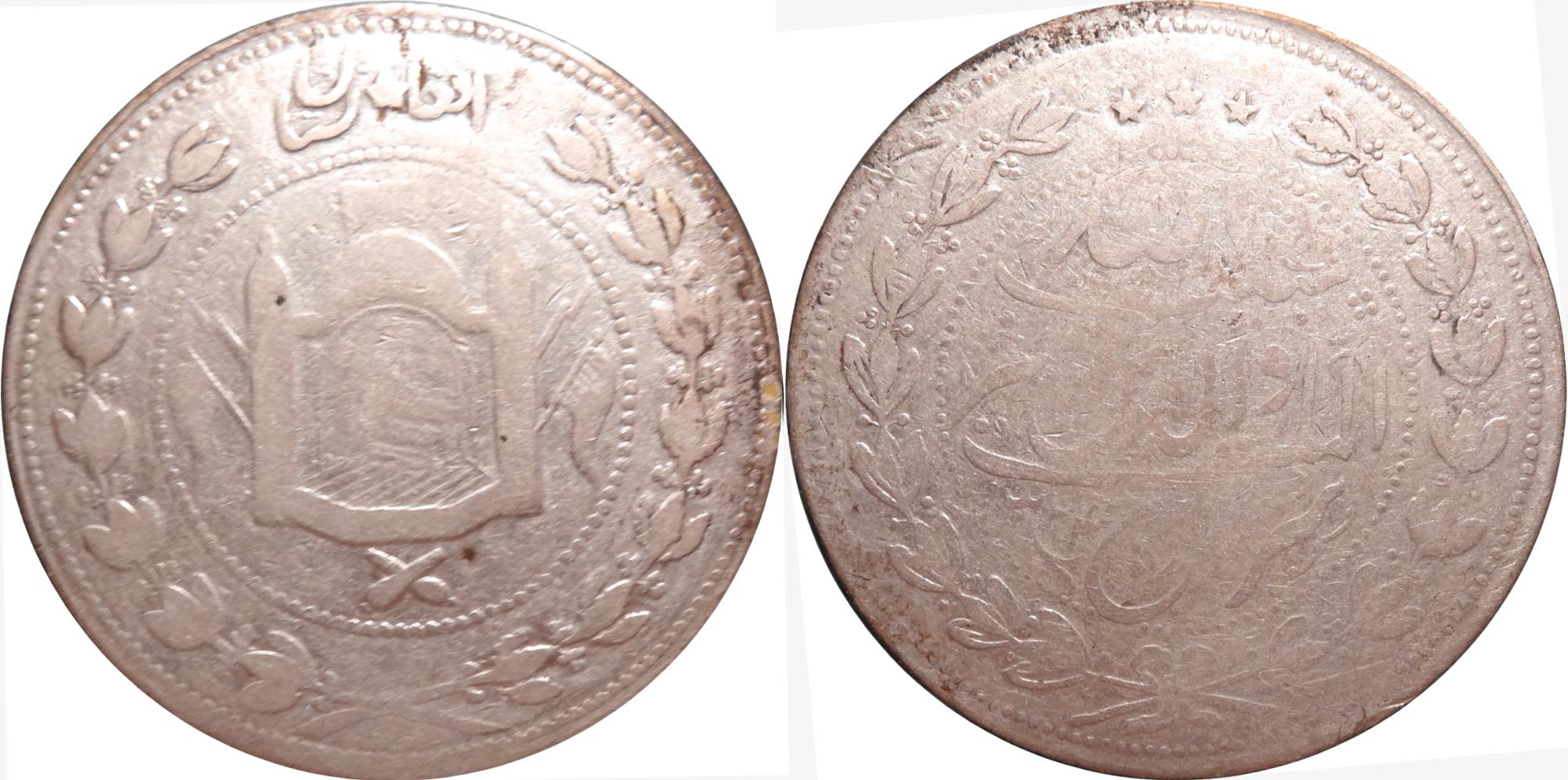
This is a five Rupee coin minted in 1326 AH (1908 AD). This is a rather large coin weighing 45.6 grams with 0.900 fineness.
ALBANIA
The Republic of Albania, a Balkan republic bounded
by Macedonia, Greece, Montenegro, and the Adriatic Sea. Independence from the
Ottomans was re-established
by revolt in 1912, and the present borders established in 1913 by a conference of
European powers, which, in 1914, placed Prince William of Wied on the throne; popular
discontent forced his abdication within months. In 1920, following World War I occupancy
by several nations, a republic was set up. Ahmed Zogu seized the presidency in 1925,
and in 1928 he proclaimed himself king with the title of Zog I. King Zog fled when
Italy occupied Albania in 1939 and enthroned King Victor Emanuel of Italy. Upon
the surrender of Italy to the Allies in 1943, German troops occupied the country.
They withdrew in 1944, and communist partisans seized power, naming Gen. Enver Hoxha
provisional president. In 1946, following a victory by the communist front in the
1945 elections, a new constitution modeled on that of the USSR was adopted. In accordance
with the constitution of 28 Dec. 1976, the official name of Albania was changed
from the Peoples Republic of Albania to the Peoples Socialist Republic of Albania.
Albania's former communists were routed in elections, March 1992, amid economic
collapse and social unrest, Sali Berisha was elected as the first non-communist
president since World War II. Rexhep Mejdani, elected president in 1997, succeeded
him.
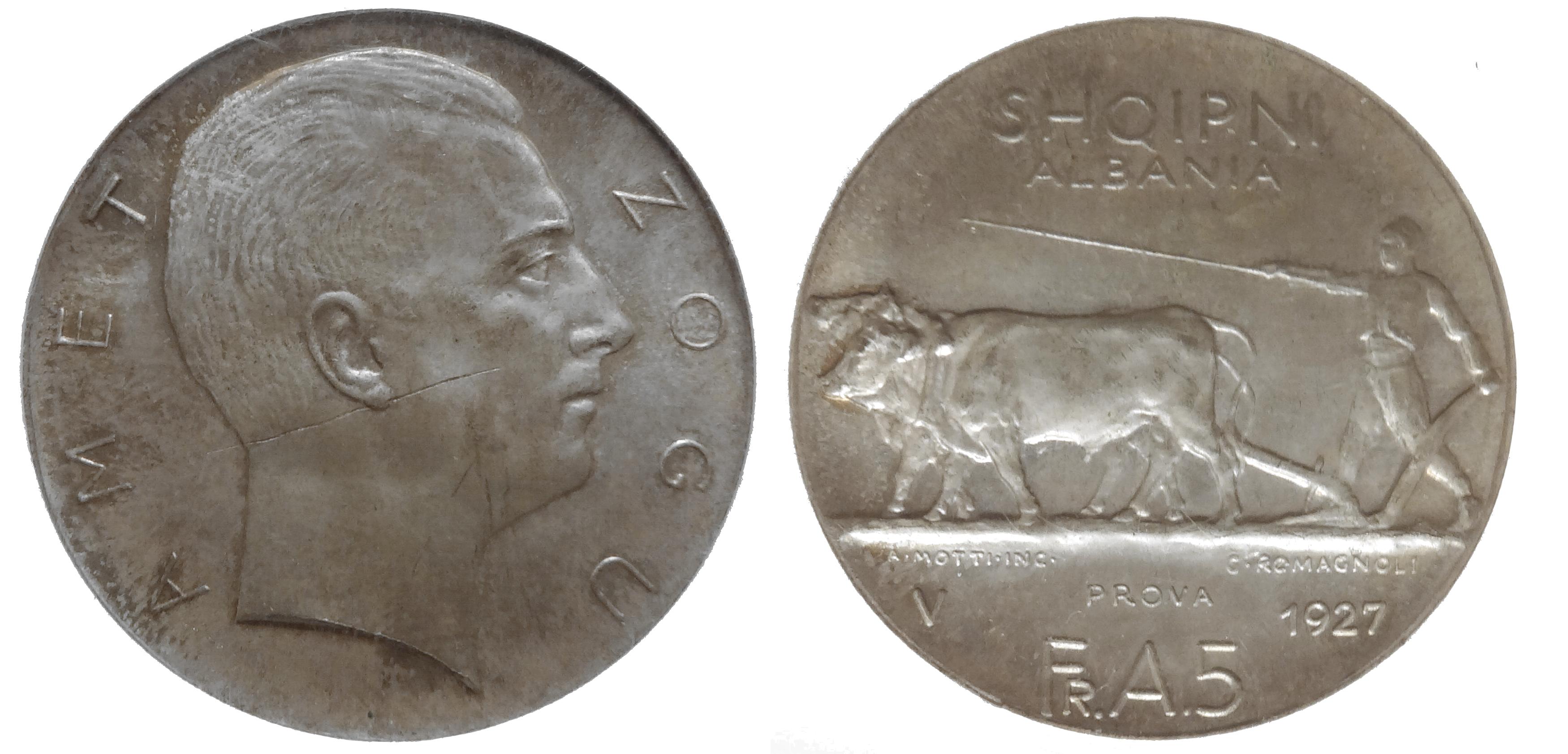
This coin was issued by Pres. Ahmed Zogu in 1927. It was minted at the Venice Mint in Italy. The denomination is 5 Frangs Ar. The obverse has the bust and name of Amet Zogu. The reverse has the country's name in Albanian and Italian. It features a farmer with a team of oxen and a plow. The designers names are below the field. The V denotes the Venice Mint, PROVA means proof coin, and the date and denomination. The coin weighs 25 grams and is of 0.900 fineness.
ARGENTINA
Argentina was discovered In 1516 by the Spanish navigator Juan Díaz de Solís. A permanent Spanish colony was established at Buenos Aires In 1580, but the colony developed slowly. When Napoleon conquered Spain, the Argentines set up their own government on 25 May 1810. Independence was formally declared on 9 July 1816. A strong tendency toward local autonomy, fostered by difficult transportation, resulted in a federalized union with much authority left to the states or provinces. Internal conflict through the first halt century of Argentine Independence resulted in a provisional national coinage, chiefly of crown-sized silver. Provincial Issues mainly of minor denominations supplemented this.
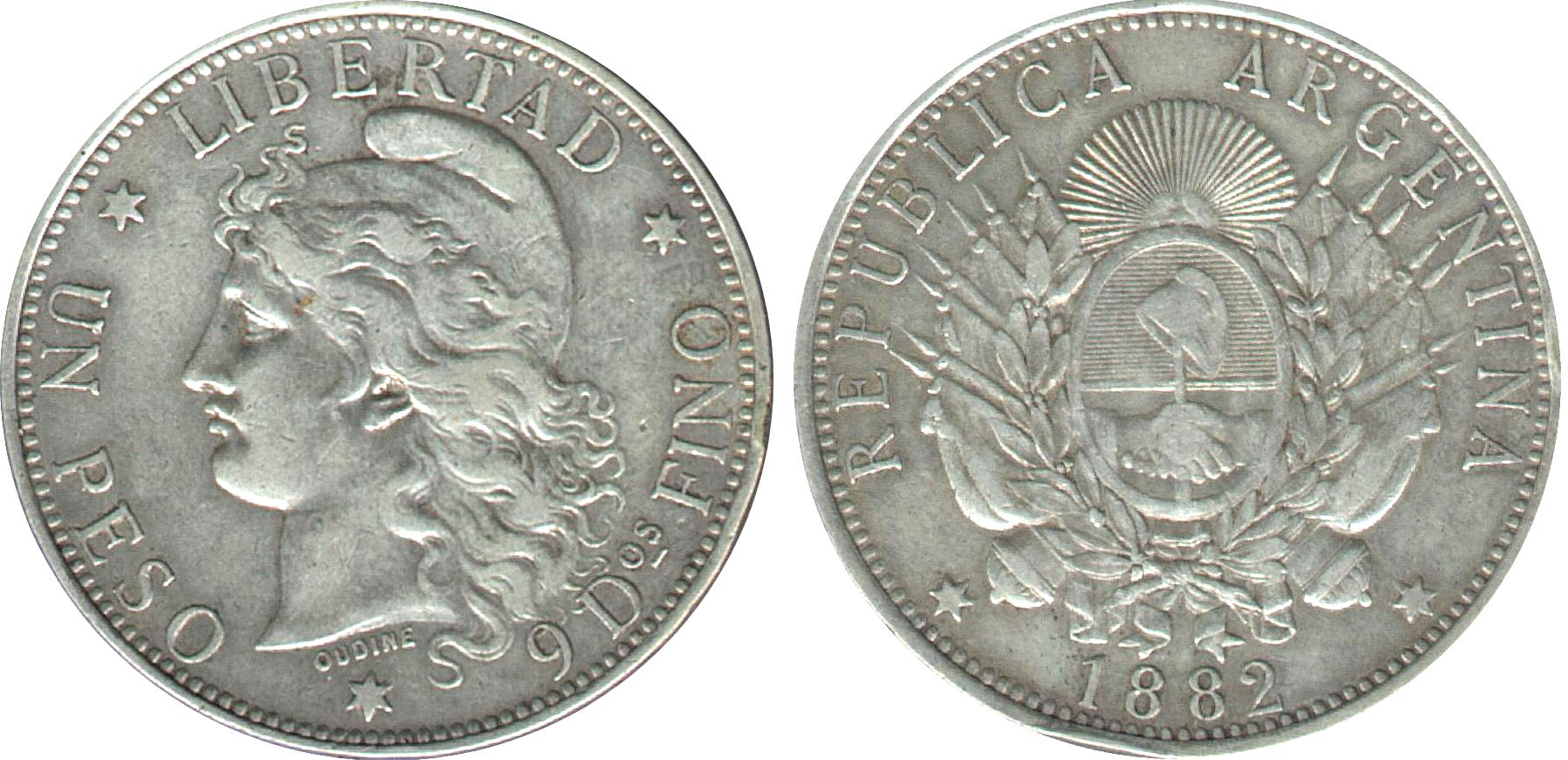
This is a one Peso coin minted in 1882. The obverse features Liberty, the denomination, and the fineness ( 9 decimos = 0.900). The designer's name is below the bust. The reverse has the country's name, the national arms, and the date. Weight is 25 grams of 0.900 fineness..
AUSTRALIA
The Commonwealth of Australia the smallest continent in the world, is located south of Indonesia between the Indian and Pacific oceans. The first Caucasians to see Australia probably were Portuguese and Spanish navigators of the late 16th century. In 1770, Captain James Cook explored the east coast and annexed it for Great Britain. New South Wales was founded as a penal colony, following the loss of British North America, by Captain Arthur Phillip on 26 January 1788, a date now celebrated as Australia Day. Dates of creation of the six colonies that now comprise the states of the Australian Commonwealth are: New South Wales, 1823; Tasmania, 1825; Western Australia, 1838; South Australia, 1842; Victoria, 1851; Queensland, 1859. The British Parliament approved a constitution providing for the federation of the colonies in 1900. The Commonwealth of Australia came into being in 1901. Australia passed the Statute of Westminster Adoption Act on 9 October 1942, which officially established Australia's complete autonomy in external and Internal affairs, thereby formalizing a situation that had existed for years. Australia is a member of the Commonwealth of Nations. Elizabeth II is head of State as Queen of Australia. Australia's currency system was changed from Pounds-Shillings-Pence to a decimal system of Dollars and Cents on 14 Feb. 1966.
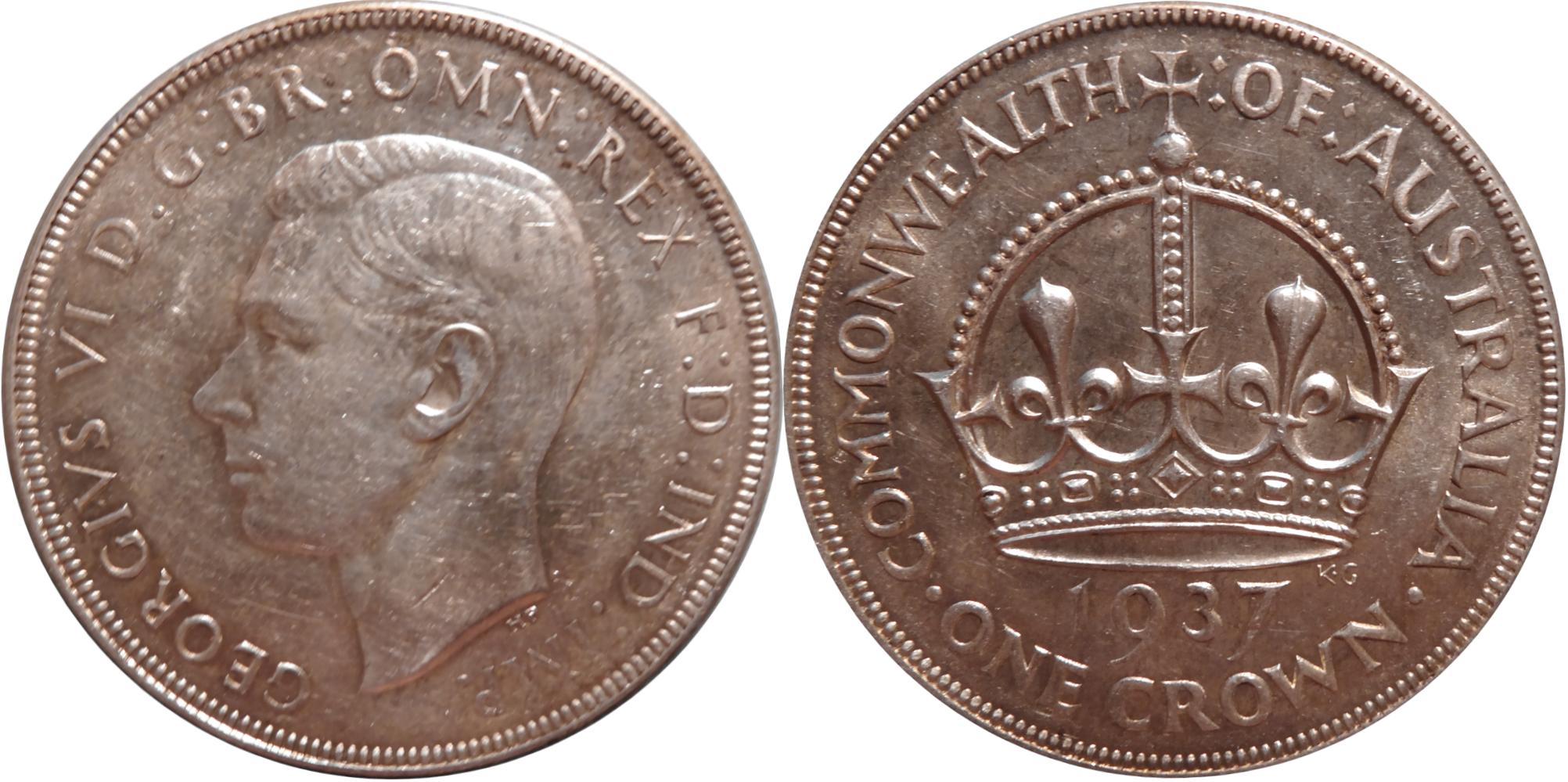
This is a five Shilling coin minted in 1937. It weighs 28.28 grams of 0,925 fineness.
AUSTRIA
The territories later to be known as Austria were overrun in pre-Roman times by various tribes, including the Celts. Upon the fall of the Roman Empire, the country became a margraviate of Charlemagne’s Empire. Přemysl Otakar II, King of Bohemia, gained possession in 1252, only to lose the territory to Rudolf of Habsburg in 1276. Thereafter, until World War I, the story of Austria was conducted by the ruling Habsburgs. During the 17th century, Austrian coinage reflected the geo-political strife of three wars. From 1618-1648, the Thirty Years’ War between northern Protestants and southern Catholics produced low quality, “kipperwhipper” strikes of 12, 24, 30, 60, 75 and 150 Kreuzer. Later, during the Austrian-Turkish War, 1660-1664, coinages used to maintain soldier’s salaries also reported the steady division of Hungarian territories. Finally, between 1683 and 1699, during the second Austrian-Turkish conflict, new issues of 3, 6 and 15 kreuzers were struck, being necessary to help defray mounting expenses of the war effort. During World War I, the Austro-Hungarian Empire was one of the Central Powers with Germany, Bulgaria and Turkey. At the end of the war, the Empire was dismembered and Austria established as an independent republic. In March 1938, Austria was incorporated into Hitler’s short-lived Greater German Reich. Allied forces of both East and West occupied Austria in April 1945, and subsequently divided it into 4 zones of military occupation. On 15 May 1955, the 4 powers formally recognized Austria as a sovereign independent democratic state.
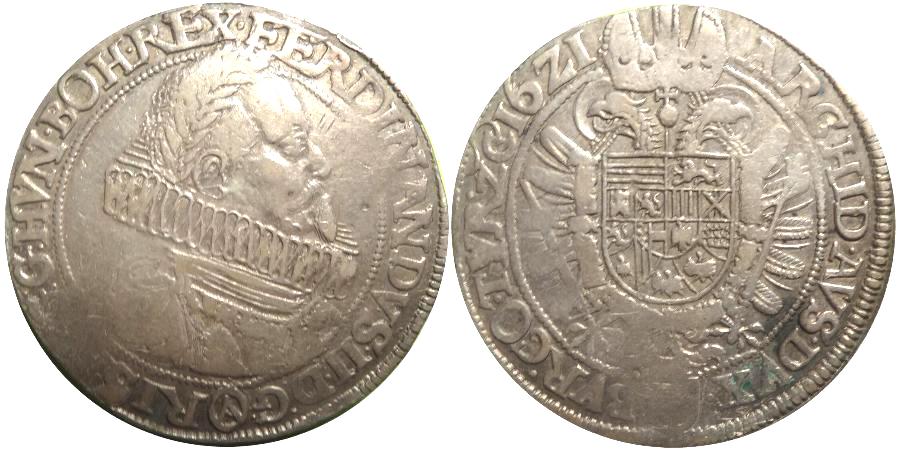
This is an one Thaler piece minted in 1621. The obverse has Emperor Franz II encircled by the legend FERDINANDVS II D G ( Λ ) R I S AVG G HVN BO REX. The reverse has the Austrian arms with the legend ARCHID AVS DVX // BVR CO TYR zC 16Z1. Weighs 28.28 grams of 0.833 fineness.
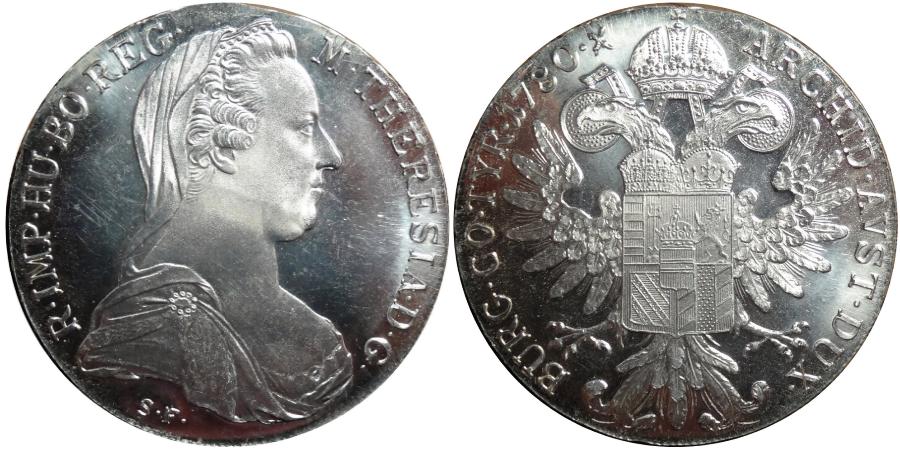
This is an one Thaler piece dated 1780 but is still being minted. It is known as the Maria Theresia Thaler and originally was a trade coin used in northern Africa and the Middle East. The obverse has Empress Maria Theresia's bust encircled by the legend M·THERESIA·D·G· R·IMP·HU·BO·REG·, The reverse has the Austrian arms with the legend ARCHID·AVST·DUX· BURG·CO·TYR·1780·X. Weighs 28.07 grams of 0.833 fineness.
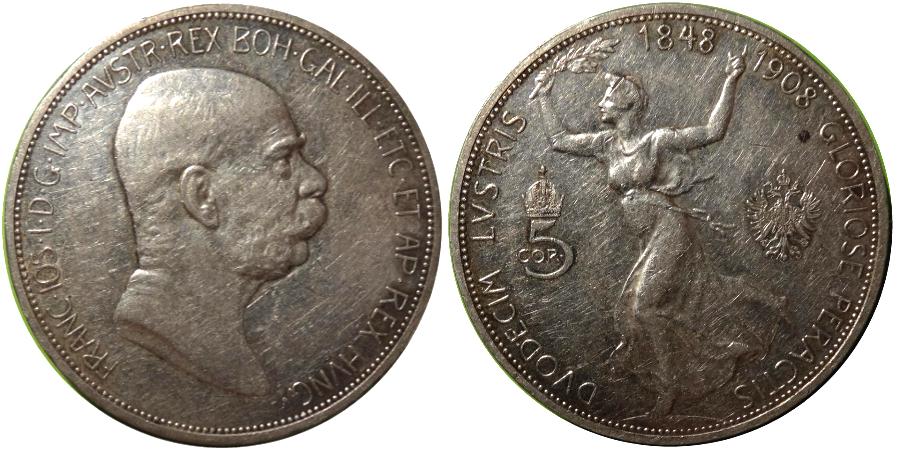
This is a five corona coin minted in 1908 to celebrate the 60th anniversary of the reign of Emperor Franz Josef I who is pictured on the obverse with the legend FRANC.IOS.I.D.G.IMP.AUST.REX BOH.GAL.ILL.ETC.ET AP.REX HVNG.. The reverse has a representation of Fame running left with the legend DVODECIM LVSTRIS 1848 1908 GLORIOSE PERACTIS. Weighs 24 grams of 0.900 fineness.
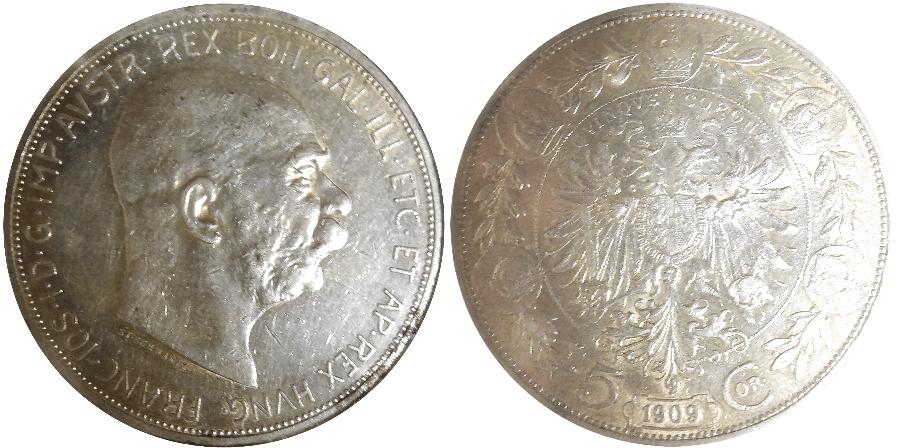
This is a five corona coin minted in 1909. The obverse has the bust of Franz Josef I with the legend FRANC.IOS.I.D.G.IMP.AUST.REX BOH.GAL.ILL.ETC.ET AP.REX HVNG. The reverse has the Austro-Hungarian arms within a wreath. Weighs 24 grams of 0.900 fineness.
SALZBURG
A town on the Austro-Bavarian frontier which grew up around a monastery and bishopric that was founded circa 700. It was raised to the rank of archbishopric in 798. In 1803 Salzburg was secularized and given to an archduke of Austria. In 1803 it was annexed to Austria but years later passed to Bavaria, returning to Austria in 1813. It became a crown land in 1849, remaining so until becoming part of the Austrian Republic in 1918.
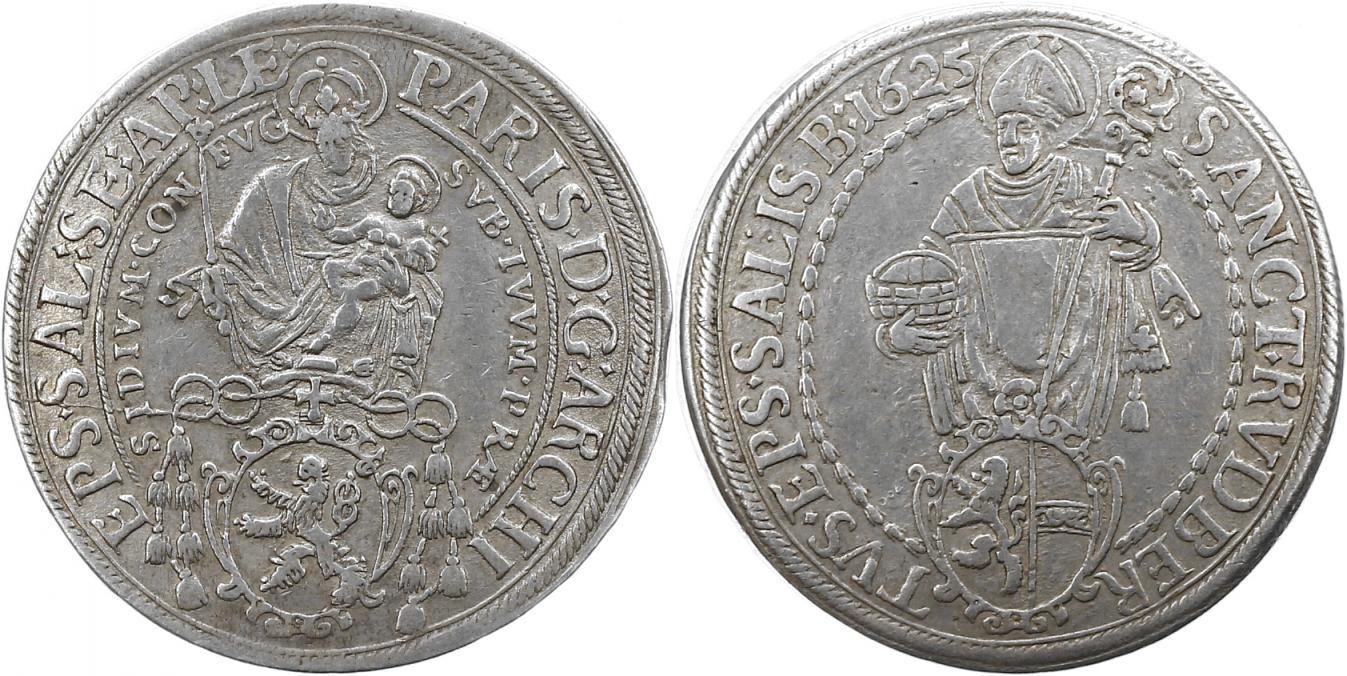
This is a one thaler coin issued by the Archbishop of Salzburg. The term dollar is derived from the German world thaler. This coin was struck in 1625 under Archbishop Paris von Lodron. The obverse has the Madonna holding the Christ child above the coat-of-arms. The legend PARIS-D:G:ARCHI EPS-SAL:SE:APL refers to the Archbishop. The reverse has an image of St. Rudpert with the legend SANCT-RVDPER TVS-EPIS:SALISB and the date of issue 1625. St. Rudpert was an early bishop of Salzburg. The coin weighs 27.8 grams of 0.889 fineness.
BADEN
The earliest rulers of Baden, in the southwestern
part of Germany along the Rhine, descended from the dukes of Zahringen in the late
11th century. The first division of the territory occurred in 1190, when separate
lines of margraves were established in Baden and in Hachberg. Immediately prior
to its extinction in 1418, Hachberg was sold back to Baden, which underwent several
minor divisions itself during the next century. Baden acquired most of the Countship
of Sponheim from Electoral Pfalz near the end of the 15th century. In 1515, the
most significant division of the patrimony took place, in which the Baden-Baden
and Baden-(Pforzheim) Durlach lines were established.
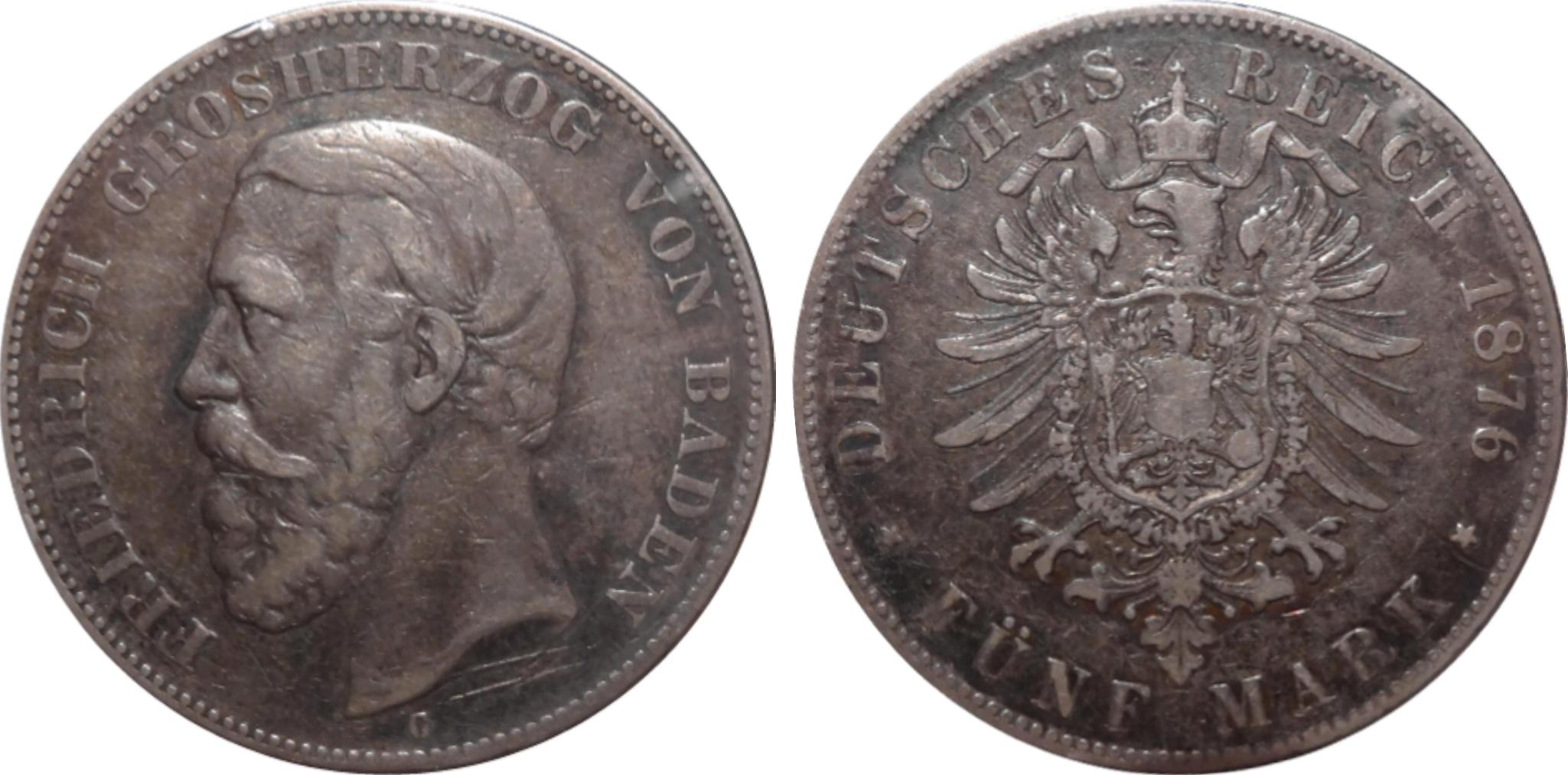
This is an 1876 five mark piece minted at Karlsruhe (mintmark G). It features the Grand duke Friedrich with the legend FRIEDRICH GROSHERZOG VON BADEN. The reverse has the German arms. The coin weighs 27.78 grams at 0.900 fineness.
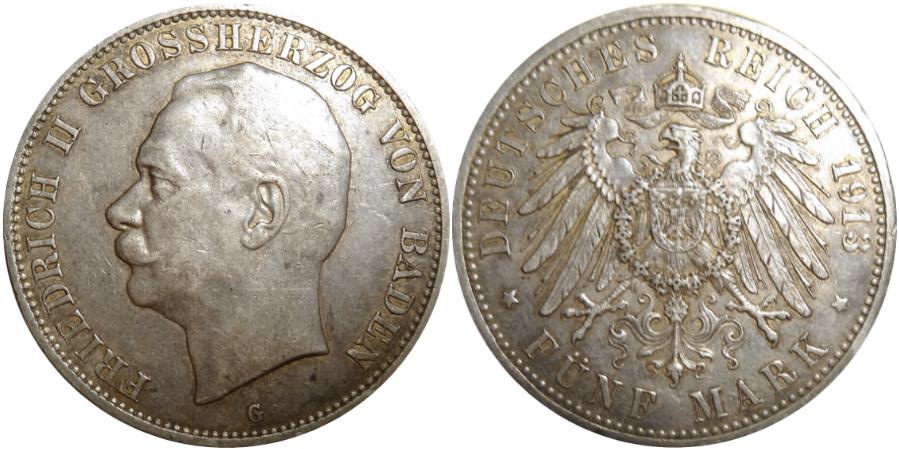 ;
;
This is an 1913 five mark piece minted at Karlsruhe (mintmark G). The obverse has Grand Duke Friedrich II with the legend FRIEDRICH II GROSHERZOG VON BADEN. The reverse has the German arms. The coin weighs 27.78 grams at 0.900 fineness.
BAHAMAS
The Commonwealth of the Bahamas is an archipelago of about 3,000 islands, cays and rocks located in the Atlantic Ocean east of Florida and north of Cuba. The Bahamas were discovered by Columbus October, 1492, upon his sighting of the island of San Salvador, but Spain made no attempt to settle then. British influence began in 1626 when Charles I granted them to the lord proprietors of Carolina, with settlements in 1629 at New Providence by colonists from the northern territory. Although the Bahamas were temporarily under Spanish control in 1641 and 1703, they continued under British proprietors until 1717, when, as the result of political and economic mismanagement, the civil and military governments were surrendered to the King and the islands designated a British Crown Colony. Full international agreement on British possession of the islands resulted from the Treaty of Versailles in 1783. The Bahamas obtained complete internal self-government under the constitution of 7 Jan. 1964. Full independence was achieved on 10 July 1973. The Bahamas is a member of the Commonwealth of Nations. Elizabeth II is Head of State as Queen of The Bahamas.
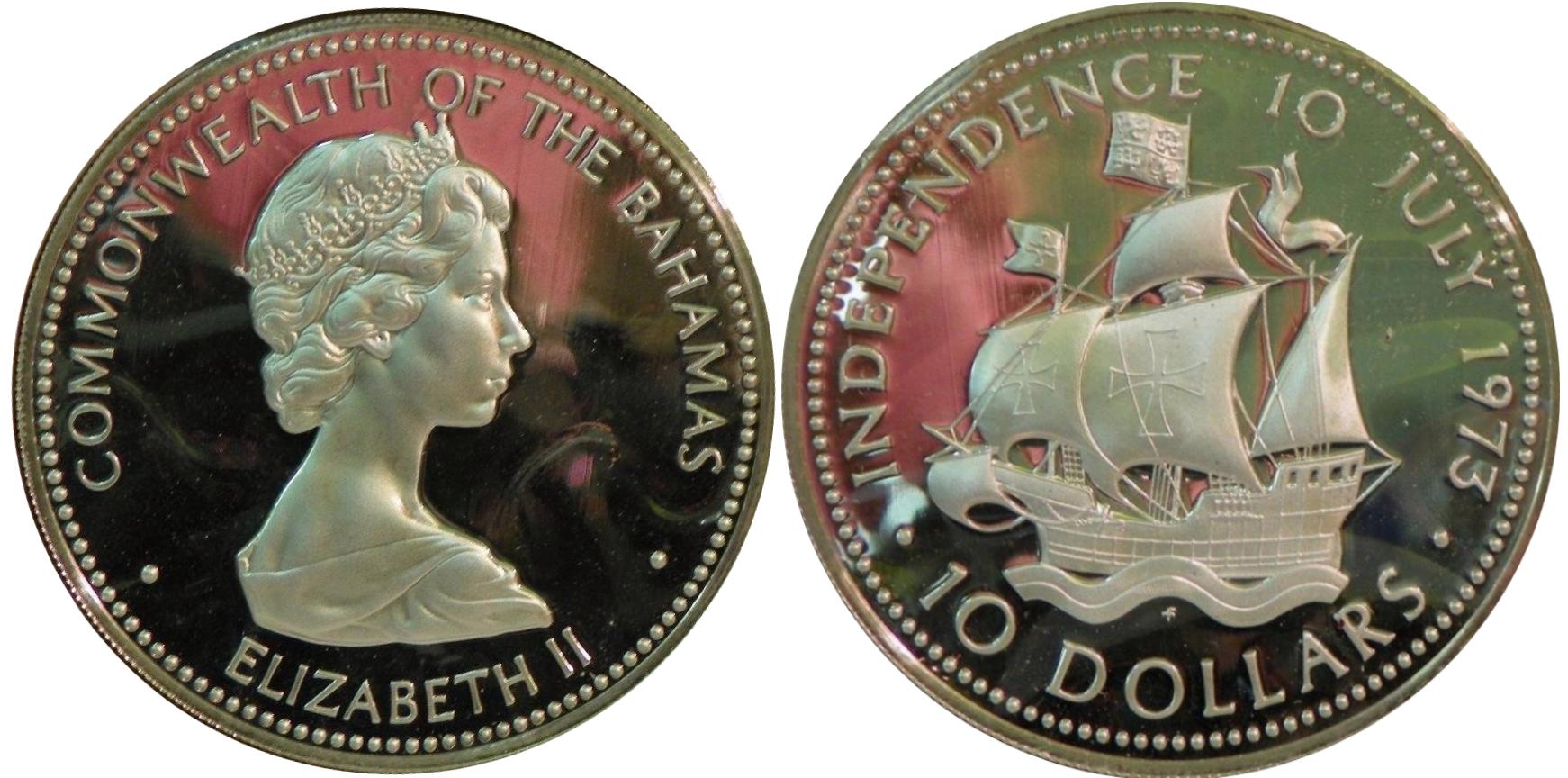
This is a ten Dollar coin minted in 1973 to celebrate independence. The obverse has Queen Elizabeth II. The reverse has Columbus' ship the Santa Maria. It is a rather large coin weighing 49.75 grams of 0.925 fineness.
BALEARIC ISLANDS
The Balearic Islands, an archipelago located in the Mediterranean Sea off the east coast of Spain including Mallorca, Minorca, Cabrera, Ibiza, Formentera and a number of islets. Majorca, largest of the Balearic Islands is famous for its 1,000-year-old olive trees. The islands were an important trading post in ancient times, being under Greek, Carthaginian, and Roman control at various times. In recent times they are under Spanish authority.
This coin was an emergency issue from the island of Mallorca. The obverse has the date of issue, 1821, the ruler's identity, FRo VII, Fernando VII, and the denomination, 30.SOUS. The reverse has a diamond shaped rendering of the Spanish coat-of-arms with SALUS POPULI (Saviour of the People) below. The coin weighs 26.8 grams at 0.903 fineness.
BAVARIA
One of the largest states in Germany, Bavaria was
a duchy from earliest times, ruled by the
Agilolfing dynasty from 553 until it
was suppressed by Charlemagne in 788. Bavaria remained a territory of the Carolingian
Empire from that time until 911, when the son of the Count of Scheyern was made
duke and began a new line of rulers there. A number of dukes during the next century
and a halt were elected emperor, but when the male line became extinct, Empress
Agnes gave Bavaria to the Counts of Nordheim in 1061. His descendant, Heinrich XII
the Lion, fell out of favor with the emperor and was deposed. The duchy was then
entrusted to Otto VI von Wittelsbach, Count of Scheyem and descendant of the counts
who had ruled from the early 10th century. Duke Otto I, as he was known from 1180
on, was the ancestor of the dynasty which ruled in Bavaria until 1918 and, from
the late 13th century, in the Rhine Palatinate as well. The first of several divisions
took place in 1255 when lines In Upper and Lower Bavaria were established. The line
in Lower Bavaria became extinct in 1340 and the territory reverted to Upper Bavaria.
Meanwhile, the division of Upper Bavaria and the Palatinate took place and was confirmed
by treaty in 1329, although the electoral vote residing with the Wittelsbachs was
to be held jointly by the two branches. In 1347, Bavaria and all other holdings
of the family in Brandenburg, the Tyrol and Holland were divided among six brothers.
Munich had become the chief city of the duchy by this time. In 1475, Duke Stephen
I, who had reunited most of the family's holdings in Bavaria, died and left three
sons who promptly divided their patrimony once again. The lines of lngolstadt, Landshut
and Munich were founded, but as the other lines died out, the one seated in Munich
regained control of all of Bavaria. Duke Albrecht IV Instituted primogeniture in
1506 and from that time on, Bavaria remained united. When Elector Friedrich V of
the Palatinate (Pfalz) was elected King of Bohemia In 1618, an event which helped
precipitate the Thirty Years' War, Duke Maximilian I of Bavaria sided with the emperor
against his kinsman. The electoral dignity had been given to the Pfalz branch of
the Wittelsbachs by the Golden Bull of 1356, a fact which was a source of contention
with the Bavarian branch of the family. With the ouster of Friedrich V, Maximilian
I obtained the electoral right and control of the Palatinate in 1623, then also
ruled over the Upper Palatinate (Oberpfalz) from 1628 until the conclusion of the
war and the Peace of Westphalia. The Bavarian Wittelsbachs became extinct in 1777
and the line in Electoral Pfalz acquired Bavaria, thus uniting the two main territories
of the dynasty under a single ruler for the first time since the early 14th century.
When Napoleon abolished the Holy Roman Empire in 1806, bringing an end to the electoral
system, the ruler of Bavaria was raised to the rank of king. The 19th century saw
tragedy upon tragedy visit the royal family. Because of his opposition to the parliamentary
reform movement, Ludwig I was forced to abdicate in 1848. His grandson, Ludwig
II,
inspired by his upbringing to spend his fortune building the fairytale castle of
Neuschwanstein, was forcibly removed by court nobles and died under mysterious circumstances
in 1886. His younger brother, Otto, was declared insane and the kingdom was ruled
by his uncle, the beloved Prince Luitpold, as prince regent. Ludwig II, the last
King of Bavaria, was forced to abdicate at the end of World War I.
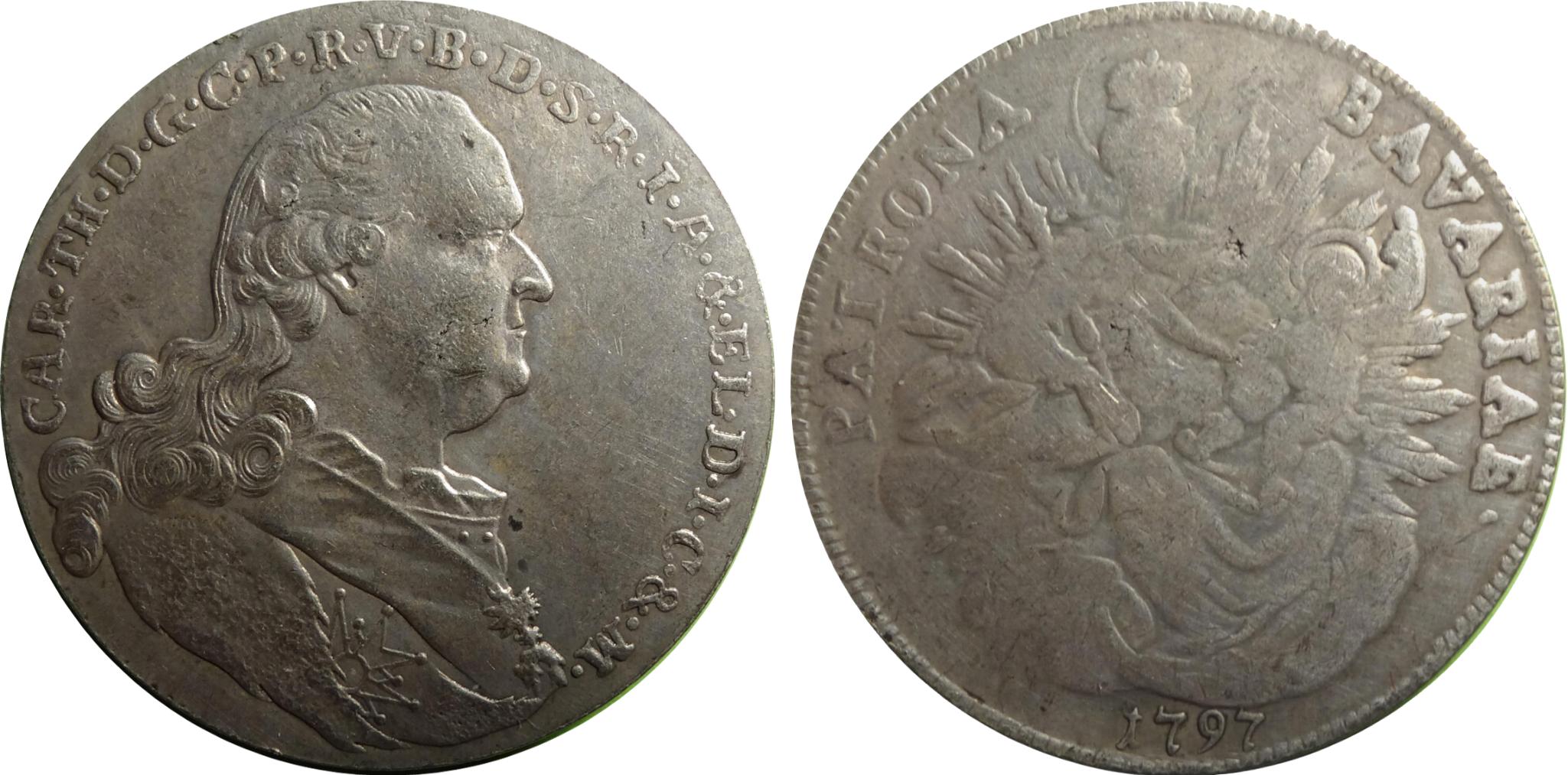
This is an one Thaler piece minted in 1797. The obverse has Elector Karl Theodore with is titles CAR. TH. D. G. C. P. R. V. B. D. S. R. I. A. &. EL. D. I. C. &. M. The reverse has the Virgin Mary and baby Jesus with the Latin legend PATRONA BAVARIAE with the date 1797. Weighs 38 grams of 0.833 fineness.
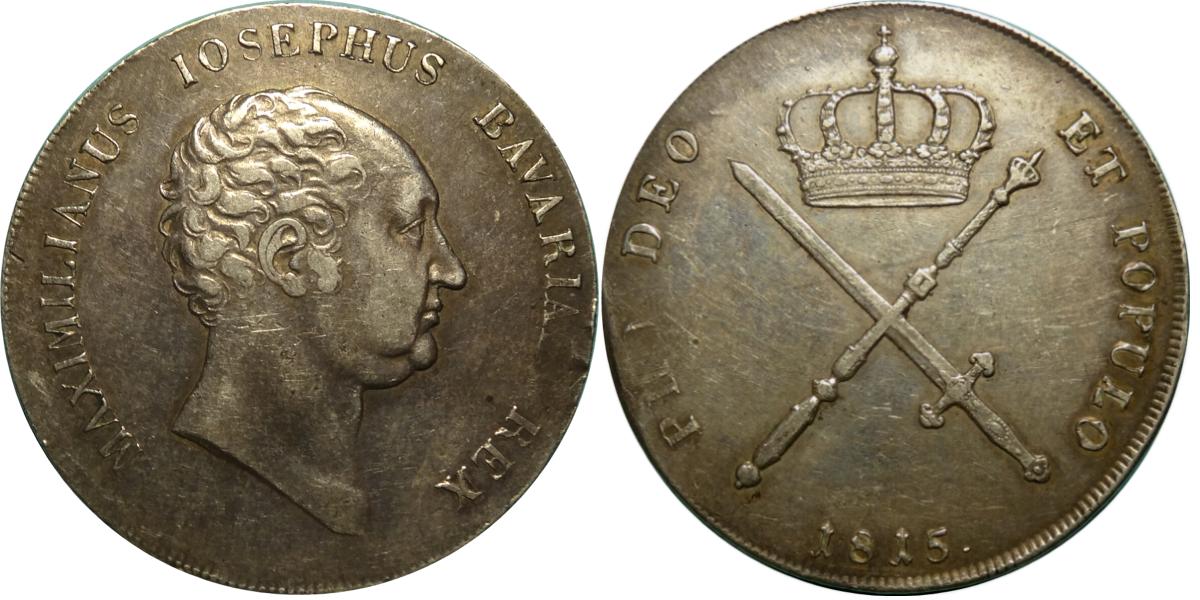
This is an one Krone coin minted in 1815. The obverse has King Maximilian Joseph I with the Latin legend MAXIMILIANUS JOSEPHUS BAVARIAE REX. The reverse has a crowned crossed sword and scepter with the Latin legend PRO DEO ET POPULO and the date 1815. Weighs 29.34 grams of 0.868 fineness.
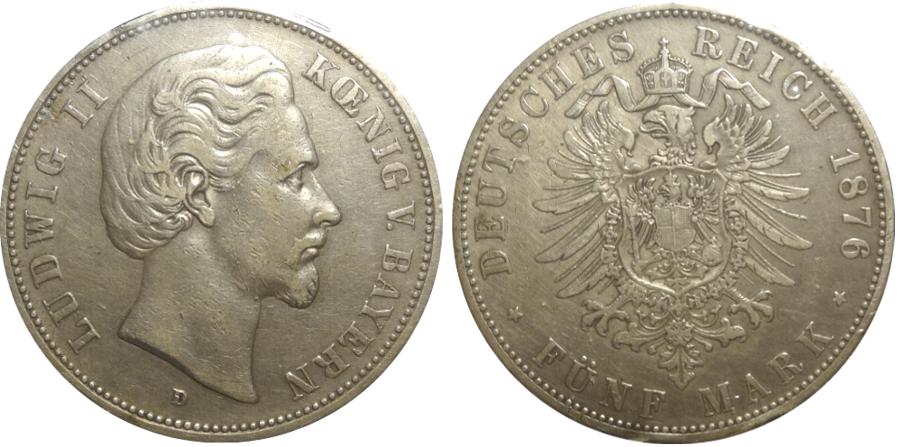
This is an 1876 five mark piece minted at Munich ( mintmark D). It features King Ludwig II with the legend LUDWIG II KŒNIG V. BAYERN. The reverse has the German arms. The coin weighs 27.78 grams at 0.900 fineness.
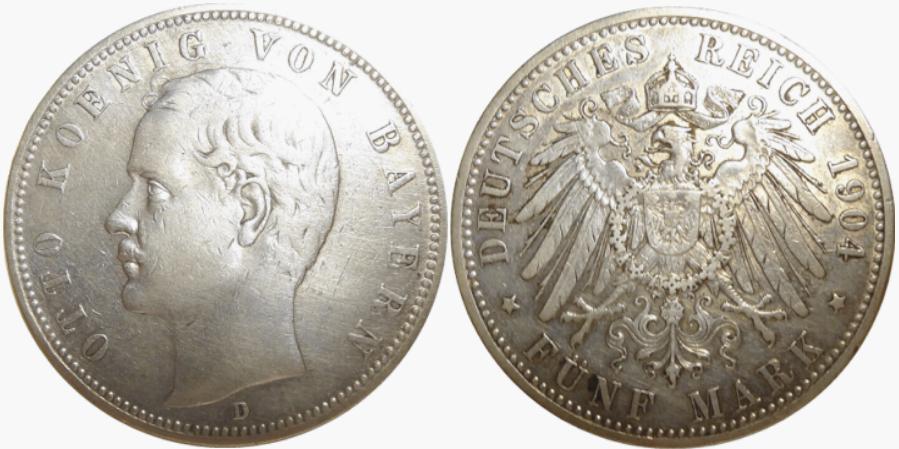
This is an 1904 five mark piece minted at Munich ( mintmark D). It features King Otto .with the legend OTTO KOENIG V. BAYERN The reverse has the German arms. The coin weighs 27.78 grams at 0.900 fineness.
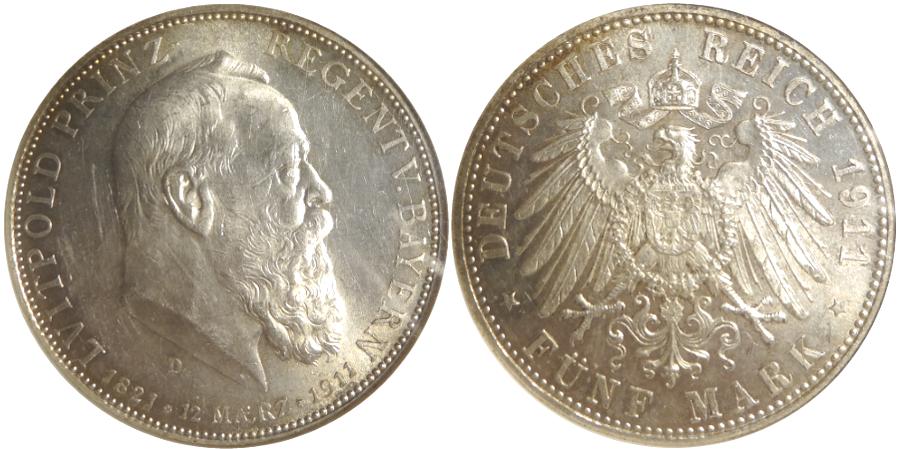
This is an 1911 five mark piece minted at Munich ( mintmark D). It features Prince Luitpold, Regent with the legend LVITPOLD PRINZ- REGENT V. BAYERN The reverse has the German arms. The coin weighs 27.78 grams at 0.900 fineness.
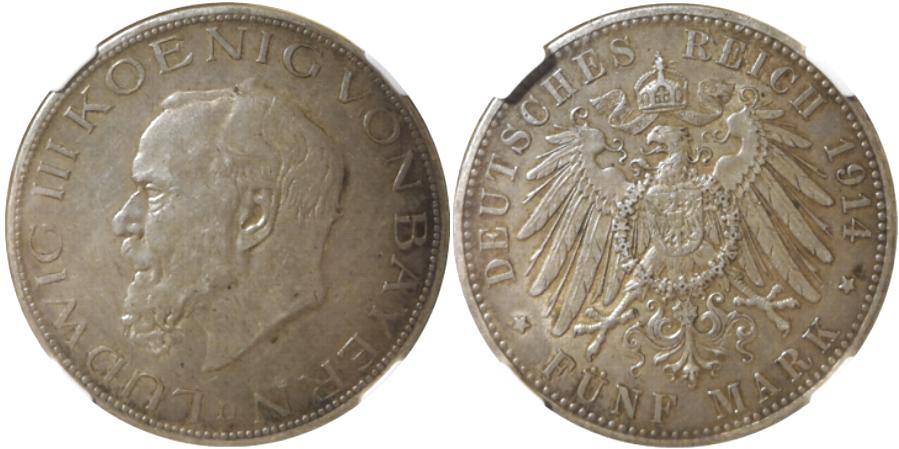
This is an 1914 five mark piece minted at Munich (mintmark D). It features King Ludwig III LUDWIG III KOENIG V. BAYERN. The reverse has the German arms. The coin weighs 27.78 grams at 0.900 fineness.
BELGIUM
The Kingdom of Belgium is a constitutional monarchy in northwest Europe. The Celtic tribe called Belgae from which Belgium derived its name, was described by Caesar as the most courageous of all the tribes of Gaul. The Belgae eventually capitulated to Rome and the area remained for centuries as a part of the Roman Empire known as Belgica. The eastern part of today's Belgium lies in the Duchy of Lower Lorraine while much of the western parts eventually became the County of Flanders. After further divisions the area came under the control of the Duke of Burgundy from whence it passed under Habsburg control. Charles and Ferdinand, sons of Philip and Johanna, began the separate Spanish and Austrian lines of the Habsburg family. The Burgundian lands, along with the northern provinces that make up present day Netherlands, became the Spanish Netherlands. The northern provinces successfully rebelled and broke away from Habsburg rule in the late 16th century and early 17th century. The southern provinces along with the Duchy of Luxembourg remained under the influence of Spain until the year 1700 when Charles II, last of the Spanish Habsburg line, died without leaving an heir and the Spanish crown went to the Bourbon family of France. The Spanish Netherlands then reverted to the control of the Austrian line of Habsburgs and became the Austrian Netherlands. The Austrian Netherlands along with the Bishopric of Liege fall to the French Republic in 1794. At the Congress of Vienna in 1815 the area was reunited with the Netherlands, but in 1830 independence was gained and the constitutional monarchy of Belgium was established. A large part of the Duchy of Luxembourg was incorporated into Belgium and the first king was Leopold I of Saxe-Coburg-Gotha.
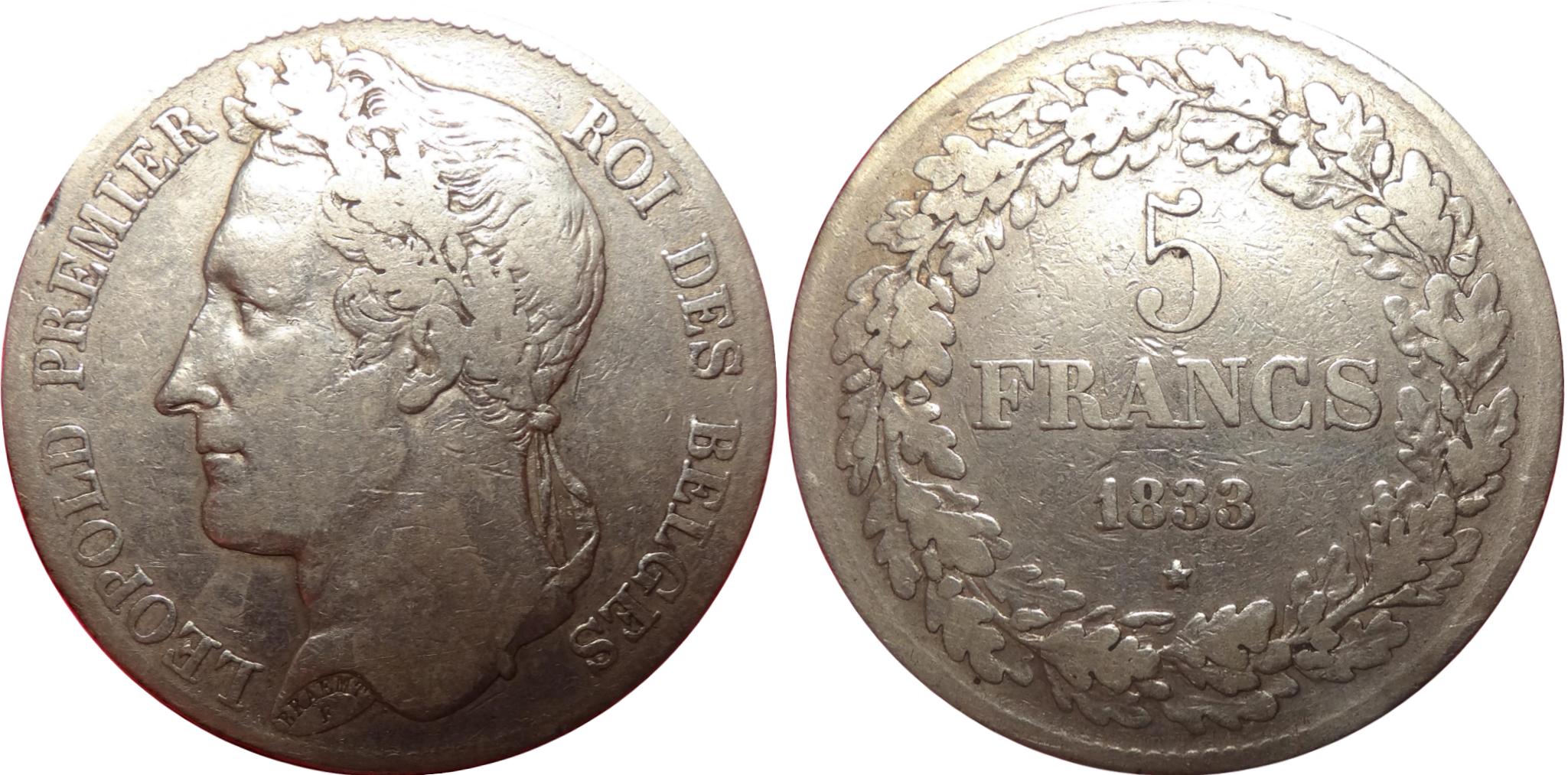
This is a five Francs coin minted in 1833 . The obverse depicts King Leopold I with the legend LEOPOLD PREMIER ROI DES BELGES . Reverse has the denomination and year. It weighs 25 grams with 0.900 fineness.
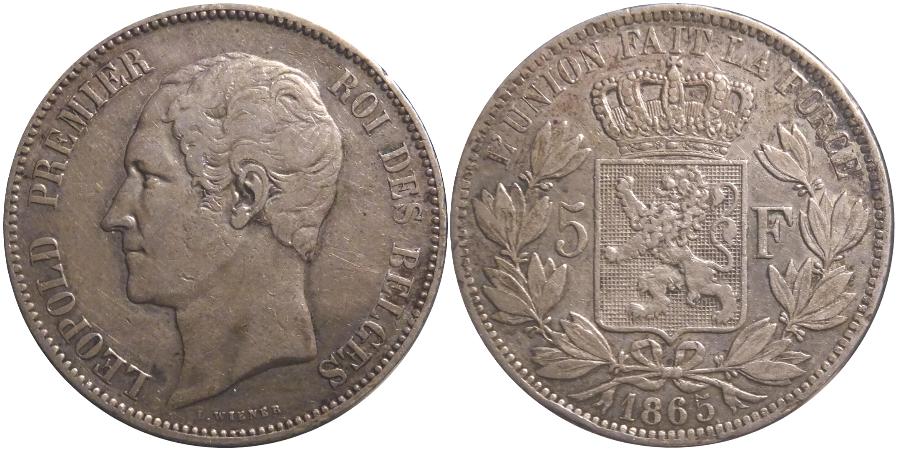
This is a five Francs coin minted in 1865 . The obverse depicts King Leopold I with the legend LEOPOLD PREMIER ROI DES BELGES . Reverse has the crowned arms the denomination, the motto L'UNION FAIT LA FORCE, and date. It weighs 25 grams with 0.900 fineness.
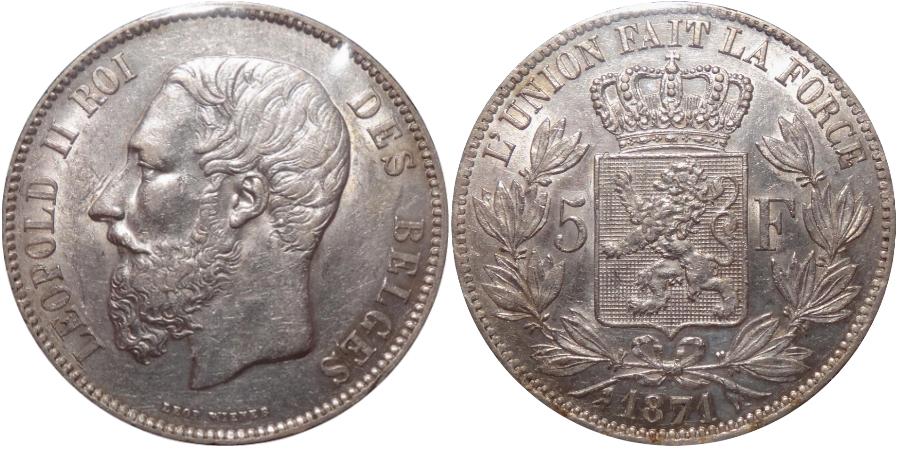
This is a five Francs coin minted in 1871 . The coin depicts King Leopold II .with the legend LEOPOLD II ROI DES BELGES . Reverse has the crowned arms the denomination, the motto L'UNION FAIT LA FORCE, and date. It weighs 25 grams with 0.900 fineness.
BERMUDA
The Parliamentary British Colony of Bermuda is situated in the western Atlantic Ocean 660 miles (1,062 km.) east of North Carolina. The British monarch is the head of state and is represented by a governor. Bermuda was discovered by Juan de Bermudez, a Spanish navigator, in about 1503. British influence dates from 1609 when a group of Virginia-bound British colonists under the command of Sir George Somers was shipwrecked on the islands for 10 months. The islands were settled in 1612 by 60 British colonists from the Virginia Colony and became a crown colony in 1684. The earliest coins issued for the island were the "Hogge Money" series of 2,3,6 and 12 pence, the name derived from the pig in the obverse design, a recognition of the quantity of such animals then found there. The next issue for Bermuda was the Birmingham coppers of 1793; all locally circulating coinage was demonetized in 1842, when the currency of the United Kingdom became standard. Internal autonomy was obtained by the constitution of 8 June 1968.
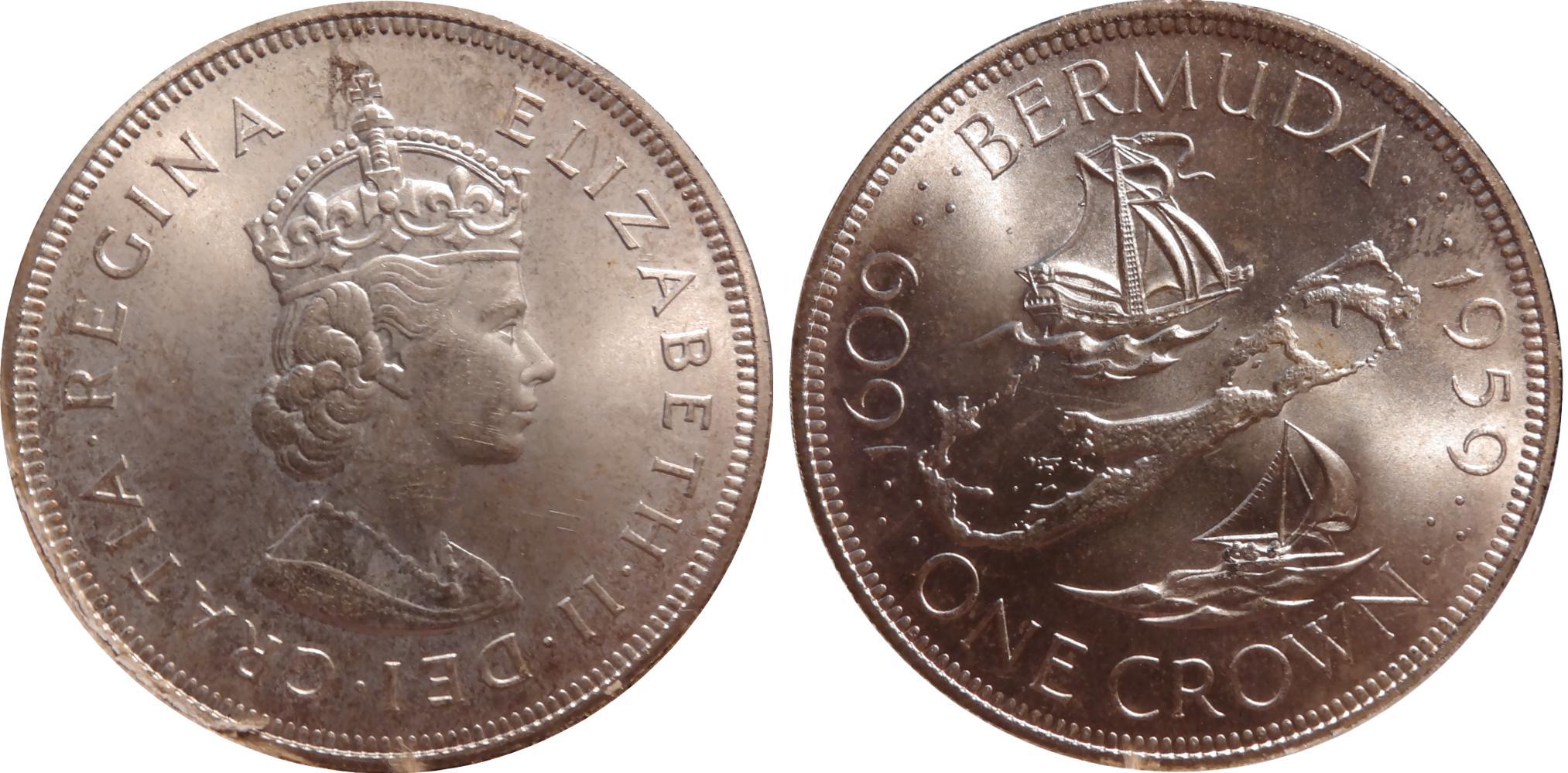
This is an one Crown (five shillings) piece minted in 1959 to celebrate the 350th anniversary of discovery. The obverse has Queen Elizabeth II. The reverse has a map of the island with a the ships Deliverance and Patience. The coin weighs 28.28 grams at 0.925 fineness.
BOLIVIA
Bolivia is a landlocked country in west central South America. Much of present day Bolivia was first dominated by the Tiahuanaco Culture ca400 BC. It had in turn been incorporated into the Inca Empire by 1440 AD prior to the arrival of the Spanish, in 1535, who reduced the Indian population to virtual slavery. When Joseph Napoleon was placed upon the throne of occupied Spain in 1809, a fervor of revolutionary activity quickened throughout Alto Peru - culminating in the 1809 Proclamation of Liberty. Sixteen bloody years of struggle ensued before the republic, named for the famed liberator Simon Bolivar, was established on 6 August 1825. Since then Bolivia has survived more than 16 constitutions, 78 Presidents, 3 military juntas and over 160 revolutions.
The Imperial City of Potosi, founded by Villarroel in 1546, was established in the midst of what is estimated to have been the world's richest silver mines (having produced in excess of 2 billion dollars worth of silver). The first mint, early in 1574, used equipment brought over from Lima. Before that it had been used at La Plata where the operation failed. The oldest type was a cob ("cob" is the simplification of the Spanish phrase "cabo de barra," meaning "end of the bar." with the Habsburg arms on the obverse and cross with quartered castles and lions on the reverse. To the heraldic right of the shield (at the left as one faces it) is a "V" and, under it, the assayers initial, although in some early examples the "P" and assayer can appear to the right of the shield. While production at the "Casa de Moneda" was enormous, the quality of the coinage was at times so poor that some 50 were condemned to death by their superiors.
Therefore, by royal decree of 17 Feb. 1651, the design was changed to the quartered castles and lions for the obverse and two crowned pillars of Hercules floating above the sea for the reverse. A new transitional series was introduced in 1651-1652 followed by a new standard design in 1652 and as the last cob type continued on for several years along with the milled pillars and bust pieces from 1767 through 1773. In the final years under Charles Ill the planchet is compact and dumpy, very irregular and of poor style, contrasting sharply with their counterpart denominations of the pillar and bust types. Most pre-decimal coinage of independent Bolivia carries the assayers' initials on the reverse near the rim to the left of the date, in 4 to 5 o'clock position. The mint mark or name appears in the 7 to 8 o'clock area.
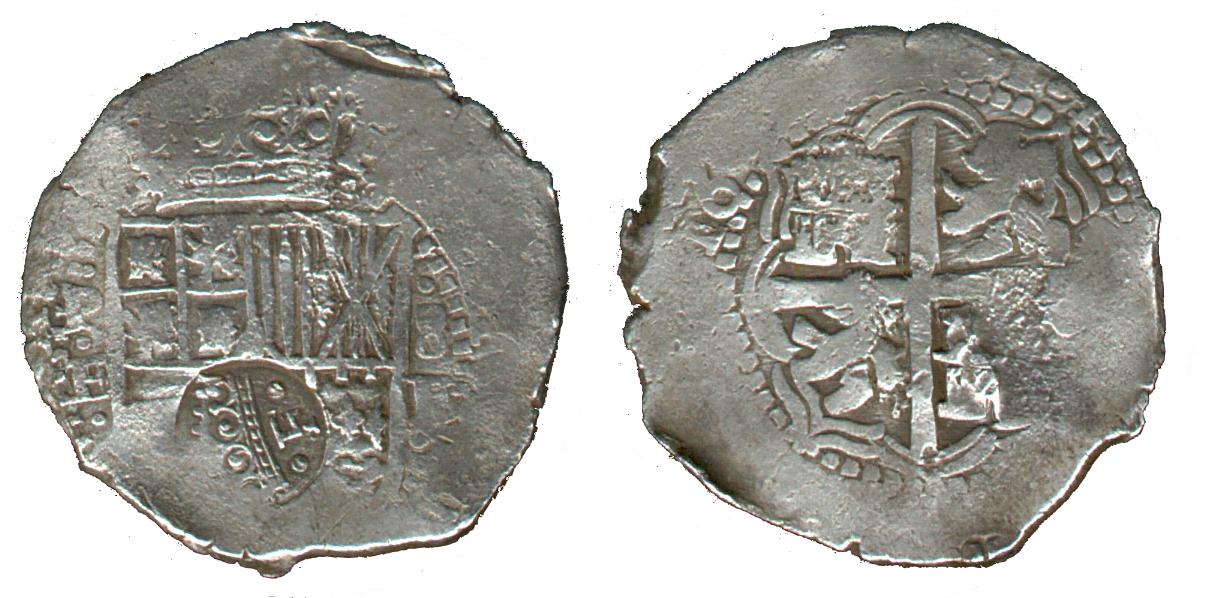
This is a Spanish 8 reales cob issued from Potosi under mint assayer E (Antonio de Ergueta) in 1651. The coin is counterstamped with a crowned F in a beaded circle to revalue the coin to 7½ reales. This coin was recovered from the wreck of the Jesus Maria de la Concepcion from Chantilly Reef, Ecuador in 1654. Problems with debasement of the coinage struck at Potosi in the 1620s-1640s prompted a visit by the Royal Inspector Don Francisco de Nestares Marin, under orders by King Philip IV of Spain, at the end of 1648. Upon completion of the investigation, the order was given in October of 1650 to recall all coinage minted at Potosi since 1625 and prior to the accession of Juan Rodriguez de Rodas (assayer O with dot in middle) to the post of assayer in 1649. All half, 1, and 2 reales, as well as any 4 and 8 reales that were found to be heavily debased, were ordered to be melted, with all 4 reales devalued to 3 reales and 8 reales devalued to 6 reales. To differentiate the good new coinage from 1649 until a completely new design could be implemented in 1652, various countermarks were applied on the 4 and 8 reales to reflect their higher net values of 3¾ reales and 7½ reales respectively. Most of these countermarks bear a crown at the top, with either an initial or monogram or symbol below, all contained within a beaded circle (most common) or simple circle (single line, no beads) or beaded pentagon (rare) or no border (rarest). It is believed that each different countermark was applied in a different location within the Spanish colonies, but it is not known which countermark corresponds to which locale. The coin weighs 27 grams of 0.859 fineness (normal fineness was 0.931).
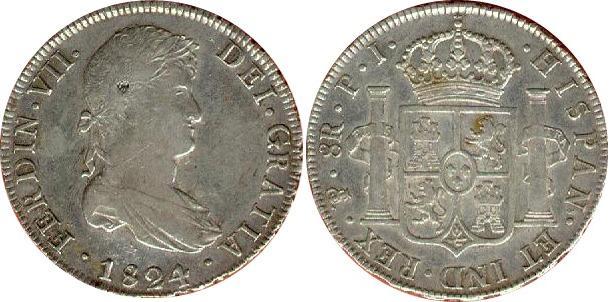
This is an 1824 eight reales coin minted at San Luis Potosi. It was the second to the last year of coinage under Spain. The obverse has Fredinand VII with the legend FERDIN . VII . DEI . GRATIA . The reverse has the Spanish arms with the legend HISPAN . ET IND . REX . PTS . 8R . P . J (the assayers' initials P J for Pedro Martin de Albizu and Juan Palomo y Sierra). It weighs 27 grams of 0.896 fineness.
This is a Bolivian post-independence eight soles coin minted at San Luis Potosi in 1829. The obverse has Gen. Simon Bolivar, for whom the country was named with the legend LIBRE POR LA CONSTITUCION. The reverse has two llamas reclining under a tree with the assayers' initials J.M for Juan Palomo y Sierra and Diego Miguel Lopez. It weighs 27 grams of 0.903 fineness.
BRAZIL
Pope Alexander VI issued a decree in 1494 that divided the New World between Spain and Portugal generally based on 270 leagues (932 miles) west of the Azores or Cape Verde islands. Brazil was a Portuguese colony until 1822. Brazil was discovered and claimed for Portugal by Admiral Pedro Alvares Cabral in 1500. Portugal established a settlement in 1532 and proclaimed the area a royal colony in 1549. During the Napoleonic Wars, Dom Joao VI established the seat of Portuguese government in Rio de Janeiro. When he returned to Portugal, his son Dom Pedro I declared Brazil's independence on 7 Sept. 1822, and became emperor of Brazil. The Empire of Brazil was maintained until 1889 when the federal republic was established.
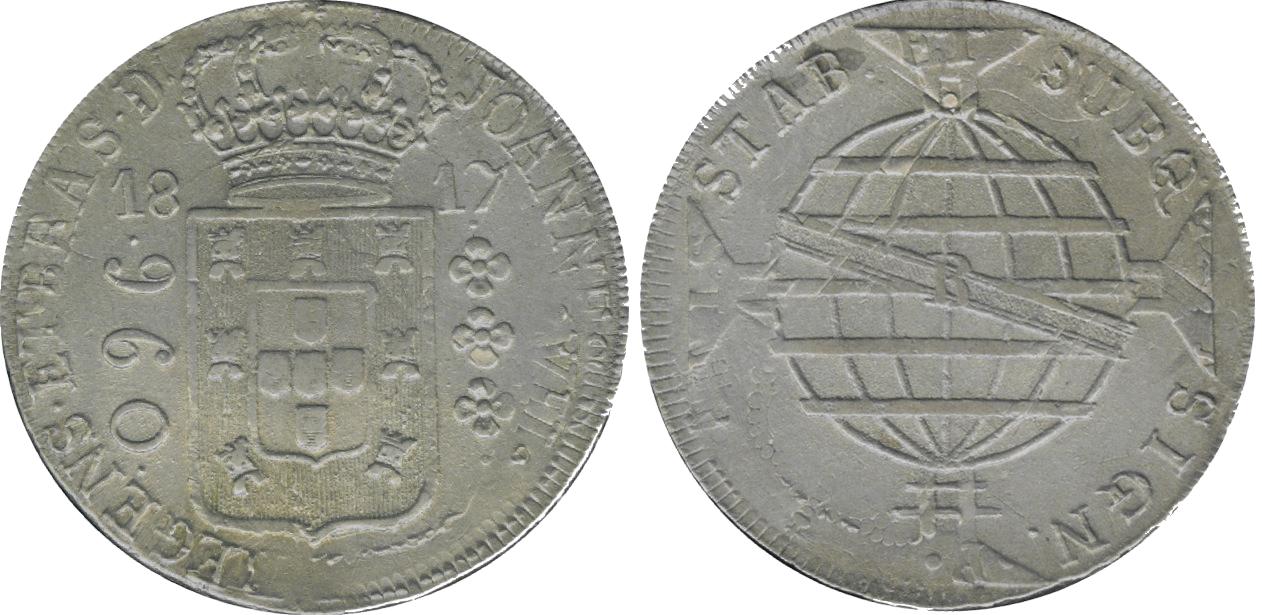
This Brazilian 960 reis coin was struck over a Spanish 8 reales piece originally minted in Lima Peru in 1816. Most of these pieces were struck over Spanish colonial and domestic minted coins as well as ex-colonies after their independence. This one was minted in Bahia in 1817. You will note that the reverse shows much detail from the original coin, particularly in the triangles off the orb. The silver value of the Spanish coin was 750-800 reis so the authorities made a good profit with this mintage. The obverse legend reads JOANNES DG PORT REGENS ET BRAS D. The reverse legend has SUBQ SIGN NATA STAB. It weighs 27 grams of 0.896 fineness.
This is Spanish colonial 8 reales piece that was minted in 1804 in San Luis Potosi in then Peru but in today's Bolivia. These coins were officially counterstamped in the state of Minas Gerais with dies having the arms and 960 on the obverse and the Brazilian orb on the reverse. It weighs 27 grams of 0.896 fineness.
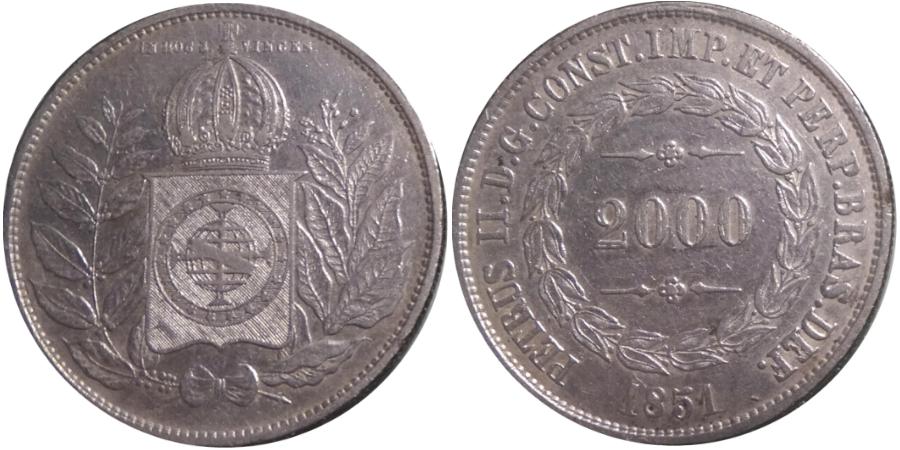
This is a 2000 reis coin minted in 1851. The obverse has the large royal arms with the Latin legend IN HOC S. VINCES and the reverse has the denomination 2000 within a leaved wreath encircled by the legend PETRUS II.D.G.CONST.IMP.ET PERP.BRAS.DEF. It weighs 25.5 grams of 0.917 fineness.
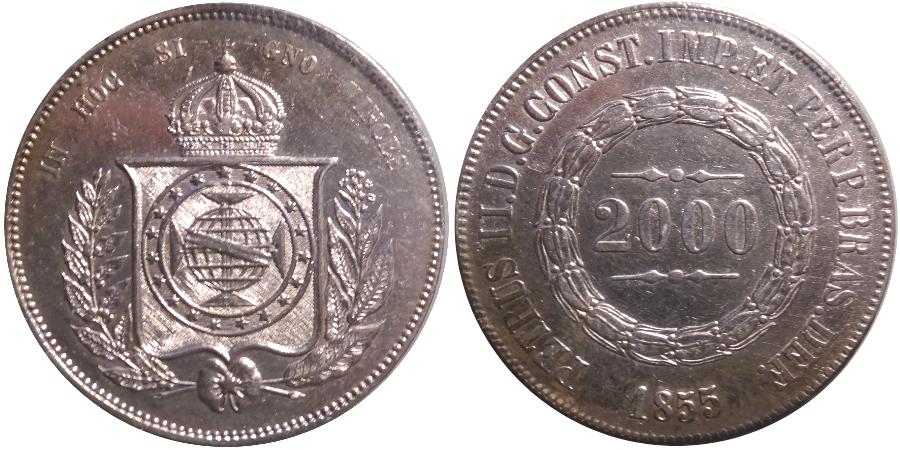
This is a 2000 reis coin minted in 1855. The obverse has the small royal arms with the Latin legend IN HOC SIGNO VINCES and the reverse has the denomination 2000 within a leaved wreath encircled by the legend PETRUS II.D.G.CONST.IMP.ET PERP.BRAS.DEF. It weighs 25.5 grams of 0.917 fineness.
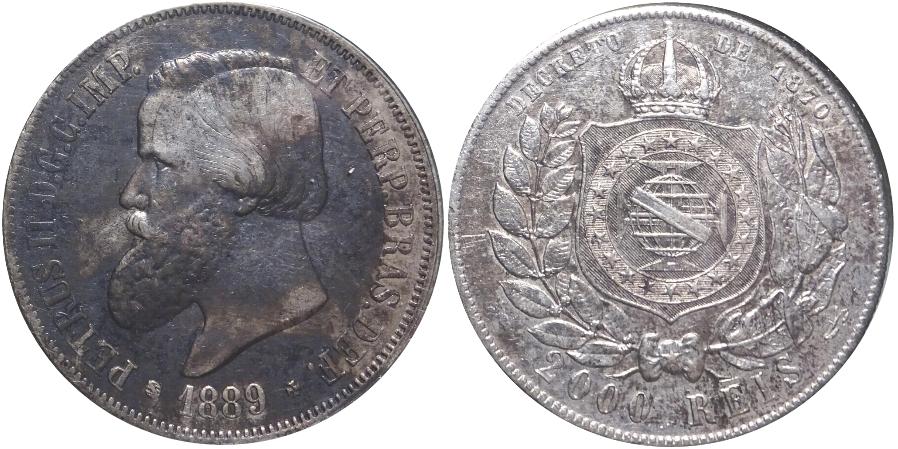
This is a 2000 reis coin minted in 1889, the last year of the Empire. The obverse has a bust of Emperor Dom Pedro II PETRUS II.D.G.CONST.IMP.ET PERP.BRAS.DEF. with the date below and the reverse has the royal arms in a leaved wreath with DECRETO DE 1870 at the top and 2000 REIS at the bottom. Weighs 25.5 grams of 0.917 fineness.
BREMEN REPUBLIC
Established at about the same time as the bishopric in 787, Bremen was under the control of the bishops and archbishops until Joining the Hanseatic League in 1276. Archbishop Albrecht II granted the mint right to the city in 1369, but this was not formalized by imperial decree until 1541. In 1646, Bremen was raised to free imperial status and continued to strike its own coins into the early 20th century. The city lost its free imperial status in 1803 and was controlled by France from 1806 until 1813. Regaining it independence in 1815, Bremen joined the North German Confederation in 1867 and the German Empire in 1871. Since 1369, there was practically continuous coinage until 1907.
A bishopric was established at the present site of
Bremen by St. Wilhad in 787. When the Norse destroyed Hamburg in 848, the archbishop
of that city transferred his see to Bremen. Eventually, the connection between the
two waned and Bremen remained an archbishopic, which obtained the mint right
as early as 888. During the 11th century, this right was extended to allow mints
to be established in various towns under Bremen's control. The Protestant Reformation
overtook Bremen in 1522, although Catholic episcopal princes attempted to maintain
Rome's influence there. At the start of the Thirty Years' War in 1618, however,
Protestantism was firmly entrenched in Bremen. The last archbishop was driven from
his see by the Swedes in 1644 and Bremen was joined to Verden as a secular duchy.
This arrangement was confirmed by the Peace of Westphalia in 1648.
Bremen like most other German States retained their hereditary royal families as
rulers and issued separate silver and gold coinage in denomination of 2, 3, 5, 10,
and 20 Marks until the end of World War I.
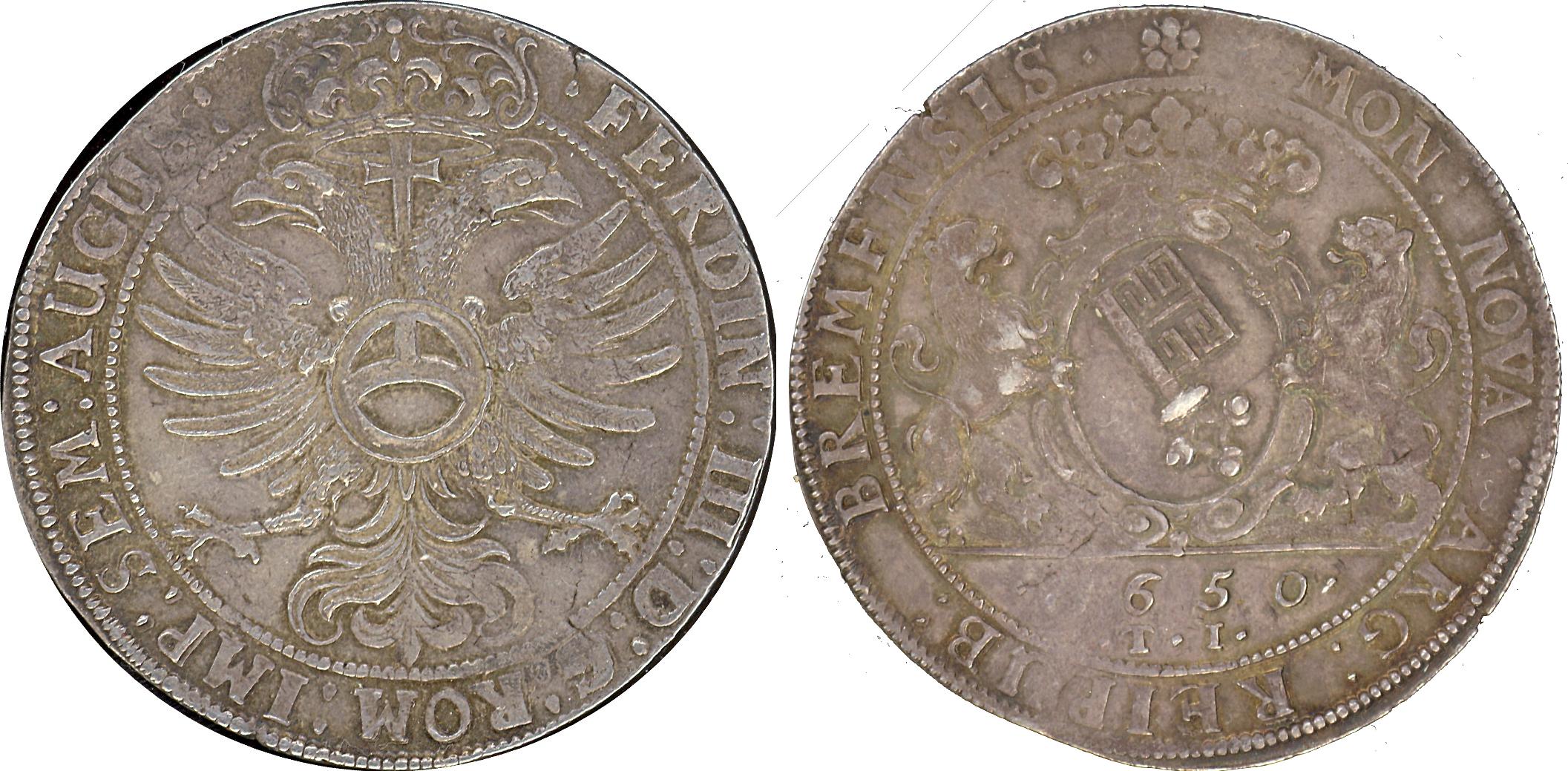
This is a Thaler coin minted by the independent republic of Bremen in 1650. The obverse has the imperial crowned eagle with FERDIN:III:D:G:ROM:IMP:SEM:AUGUS: (Ferdinand III by Grace of God Holy Roman Emperor). Mintage was a mere 1627. The reverse has the coat-of-arms of the city with the date 1650 and T.I. (denoting Mintmaster Thomas Isenbein) within the inner circle. The outer ring has MON: NOVA: ARG: REIPUB: BREMENISIS (new silver money of the Bremen Republic). It weighs 29 grams of 0.889 fineness
BURMA
Burma, a country of Southeast Asia fronting on the Bay of Bengal and the Andaman Sea. The first European to reach Burma, in about 1435, was Nicolo Di Conti, a Venetian merchant. During the beginning of the reign of Bodawpaya (1781-1819 AD) the kingdom comprised most of the same area as it does today including Arakan which was taken over in 1784-85. The British East India Company, while unsuccessful in its 1612 effort to establish posts along the Bay of Bengal, was enabled by the Anglo-Burmese Wars of 1824-86 to expand to the whole of Burma and to secure its annexation to British India.
The coins issued by kings Mindon and Thibaw between 1852 and 1885 circulated in Upper Burma. Indian coins were current in Lower Burma, which was annexed in 1852. Burmese coins are frequently known by the equivalent Indian denominations, although their values are inscribed in Burmese units. Upper Burma was annexed in 1885 and the Burmese coinage remained in circulation until 1889, when Indian coins became current throughout Burma. Coins were again issued in the old Burmese denominations after independence in 1948, but these were replaced by decimal issues in 1952. The Chula-Sakarat (CS) dating is sometimes referred to as BE-Burmese Era and began in 638 AD.
Later years it became a recluse nation under dictatorships but recently has opened up.
This is a 1 Kyat piece (equal to 1 Indian Rupee). It is dated 1214 CE (Chula-Sakarat). It is not technically a crown in that it only weighs 11 grams of 0.917 fineness but it is the largest denomination of an early Burmese silver coin.
CANADA
Jacques Cartier, a French explorer, took
possession of Canada for France in 1534, and for more than a century the history
of Canada was that of a French colony. Samuel de Champlain helped to establish
the first permanent colony in North America, in 1604 at Port Royal, Acadia
– now Annapolis Royal, Nova Scotia. Four years later he founded the settlement
in Quebec. The British settled along the coast to the south while the French,
motivated by a grand design, pushed into the interior. France’s plan for a great
American empire was to occupy the Mississippi heartland of the country, and from
there to press in upon the narrow strip of English coastal settlements from the
west. Inevitably, armed conflict erupted between the French and the British;
consequently, Britain acquired Hudson Bay, Newfoundland and Nova Scotia from the
French in 1713. British control of the rest of New France was secured in 1763,
largely because of James Wolfe’s great victory over Montcalm near Quebec in
1759. During the American Revolution, Canada became a refuge for great numbers
of American Royalists, most of whom settled in Ontario, thereby creating an
English majority west of the Ottawa River. The ethnic imbalance contravened the
effectiveness of the prevailing French type of government, and in 1791 the
Constitutional act was passed by the British parliament, dividing Canada at the
Ottawa River into two parts, each with its own government: Upper Canada, chiefly
English and consisting of the southern section of what is now Ontario; and Lower
Canada, chiefly French and consisting principally of the southern section of
Quebec. Subsequent revolt by
dissidents in both sections caused the British government to pass the Union Act,
July 23, 1840, which united Lower and Upper Canada (as Canada East and Canada
West) to form the Province of Canada, with one council and one assembly in which
the two sections had equal numbers. The union of the two provinces did not
encourage political stability; the equal strength of the French and British made
the task of government all but impossible. A further change was made with the
passage of the British North American Act, which took effect on 1 July 1867, and
established Canada as the first federal union in the British Empire. Four
provinces entered the union at first: Upper Canada as Ontario, Lower Canada as
Quebec, Nova Scotia and New Brunswick. The Hudson Bay Company’s territories were
acquired in 1869 out of which were formed the provinces of Manitoba,
Saskatchewan and Alberta. British Columbia joined in 1871 and Prince Edward
Island in 1873. Canada took over the Arctic Archipelago in 1895. In 1949
Newfoundland came into the confederation. In the early years, Canada’s coins
were struck in England at the Royal Mint in London or at the Heaton Mint in
Birmingham. Issues struck at the Royal Mint do not bear a mint mark, but those
produced by Heaton carry an “H”. All Canadian coins have been struck since
2 January 1908, atthe Royal Canadian Mints at Ottawa and recently at Winnipeg
except for some 1968 pure nickel dimes struck at the U.S. Mint in Philadelphia,
and do not bear mint marks. Ottawa’s mint mark (C) does not appear on some 20th
Century Newfoundland issues, however, as it does on English type
sovereigns struck there from 1908 through 1918. Canada is a member of the
Commonwealth of Nations. Elizabeth II is Head of State as Queen of Canada.
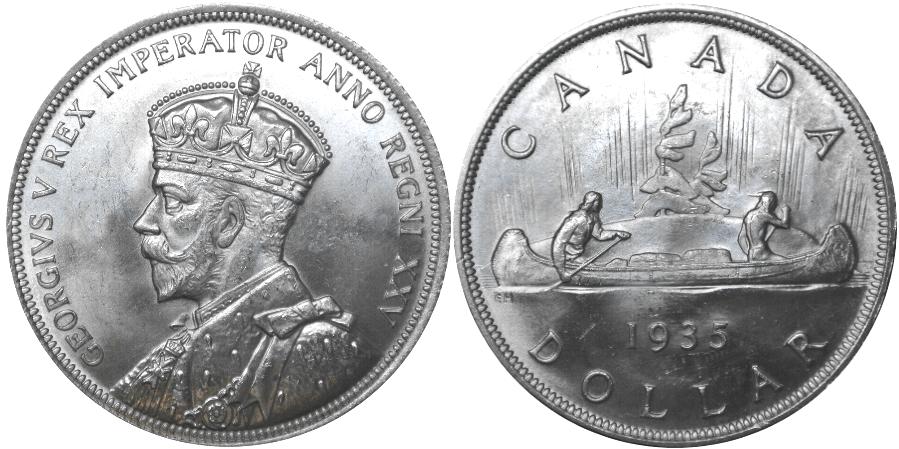
This is a one Dollar coin minted in 1935. It celebrates the 25th anniversary of the reign. The obverse has the image of King George V with the legend GEORGIVS V REX IMPERATOR ANNO REGNI XXV. The reverse has the voyageur and an aboriginal traveling by canoe, carrying bundles of which one bears the initials "H.B." for Hudson's Bay Company with the country's name, date, and denomination. Weighs 23.3 grams of 0.800 fineness.
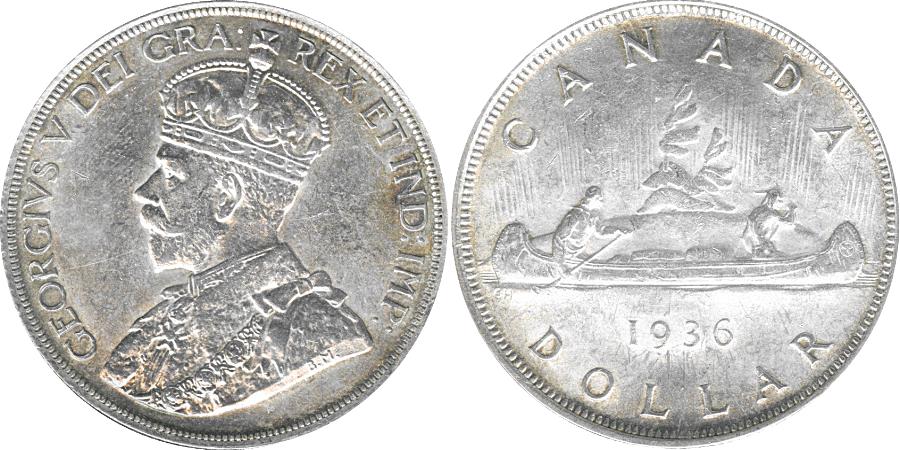
This is a one Dollar coin minted in 1936. The obverse has the image of King George V with the legend GEORGIVS V DEI GRA: REX ET IND:IMP:. The reverse has the voyageur and an aboriginal traveling by canoe, carrying bundles of which one bears the initials "H.B." for Hudson's Bay Company with the country's name, date, and denomination. Weighs 23.3 grams of 0.800 fineness.
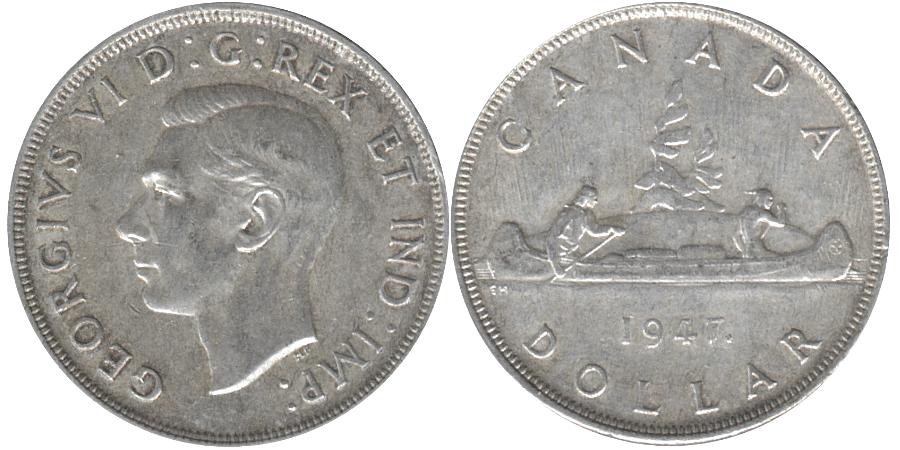
This is a one Dollar coin minted in 1947. The obverse has the image of King George VI with the legend GEORGIVS VI D: GRA: REX ET IND:IMP:. The reverse has the voyageur and an aboriginal traveling by canoe, carrying bundles of which one bears the initials "H.B." for Hudson's Bay Company with the country's name, date, and denomination. Weighs 23.3 grams of 0.800 fineness.
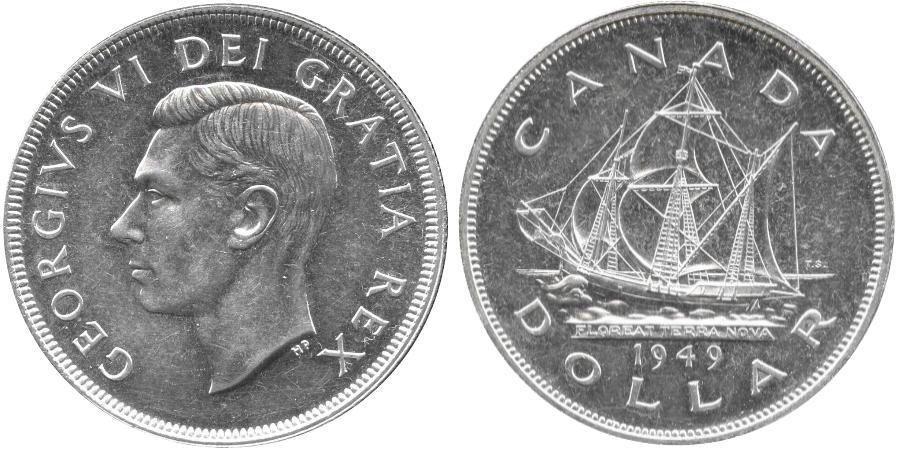
This is a one Dollar coin minted in 1949 to commemorate the joining of Newfoundland to the Confederation. The obverse has the image of King George VI with the legend GEORGIVS VI DEI GRATIA REX. The reverse has The Matthew, the ship historians believe John Cabot was sailing when he discovered Newfoundland, below which reads the Latin inscription "FLOREAT TERRA NOVA" (may the New Found Land flourish), with the country's name, date, and denomination. Weighs 23.3 grams of 0.800 fineness.
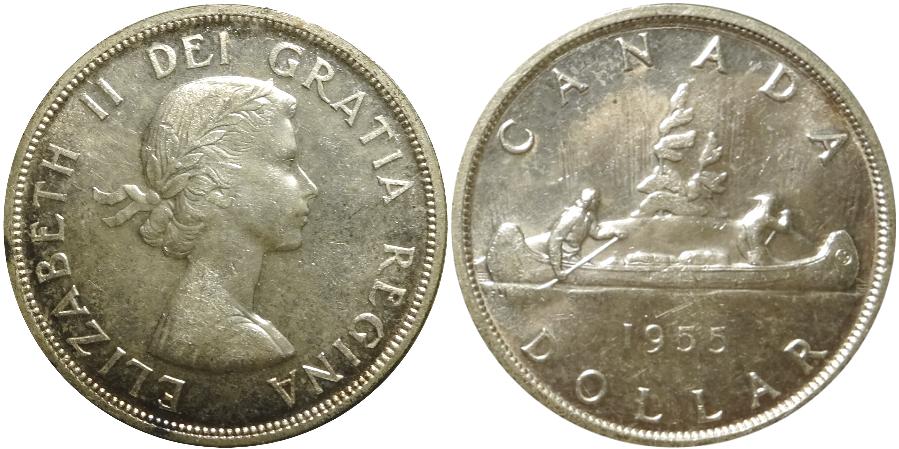
This is a one Dollar coin minted in 1955. The obverse has the image of Queen Elizabeth II with the legend ELIZABETH II DEI GRATIA REGINA. The reverse has the voyageur and an aboriginal traveling by canoe, carrying bundles of which one bears the initials "H.B." for Hudson's Bay Company with the country's name, date, and denomination. Weighs 23.3 grams of 0.800 fineness.
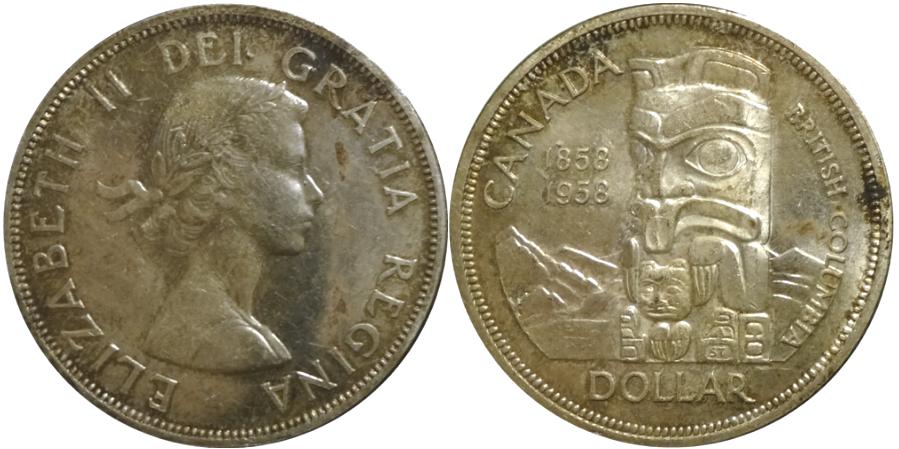
This is a one Dollar coin minted in 1958 to commemorate the centenary of British Columbia. The obverse has the image of Queen Elizabeth II with the legend ELIZABETH II DEI GRATIA REGINA. The reverse has a totem with the country's name, dates 1858-1958, BRITISH COLUMBIA, and denomination. Weighs 23.3 grams of 0.800 fineness.
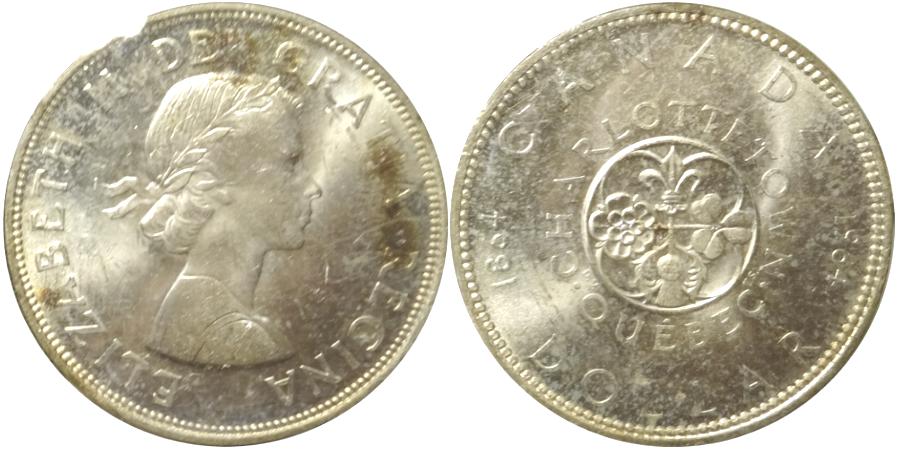
This is a one Dollar coin minted in 1964 to commemorate the centenary of Charlottetown Quebec. The obverse has the image of Queen Elizabeth II with the legend ELIZABETH II DEI GRATIA REGINA. The reverse has the French fleur-de-lis, the Irish shamrock, the Scottish thistle, and the English rose in a unique design is surrounded with the legend "CHARLOTTETOWN • QUÉBEC", the dates "1864" and "1964", and denomination. Weighs 23.3 grams of 0.800 fineness.
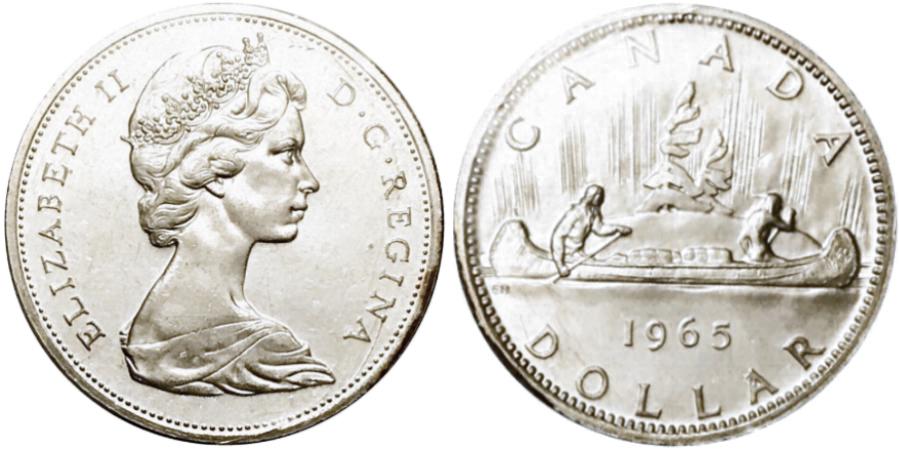
This is a one Dollar coin minted in 1965. The obverse has the image of Queen Elizabeth II with the legend ELIZABETH II D - G - REGINA. The reverse has the voyageur and an aboriginal traveling by canoe, carrying bundles of which one bears the initials "H.B." for Hudson's Bay Company with the country's name, date, and denomination. Weighs 23.3 grams of 0.800 fineness.
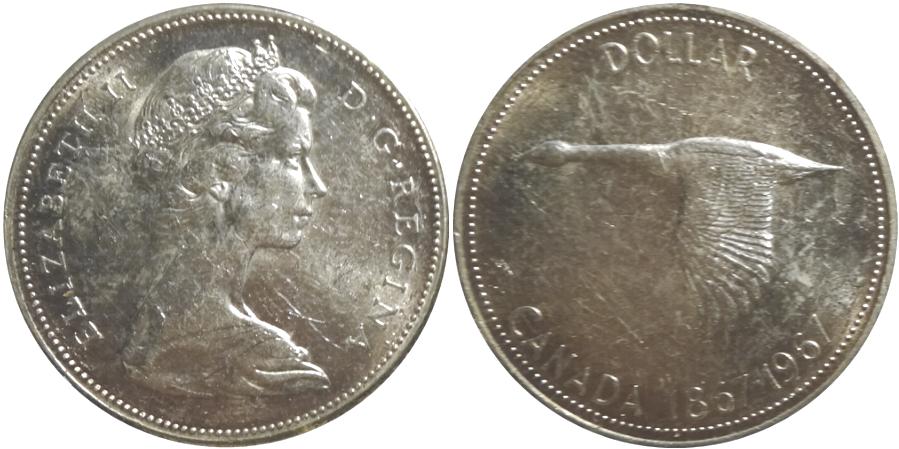
This is a one Dollar coin minted in 1967 to commemorate the centenary of the Canadian Confederation. The obverse has the image of Queen Elizabeth II with the legend ELIZABETH II D - G - REGINA. The reverse has Canadian geese, the denomination, the country's nam, and the dates 1867-1967. Weighs 23.3 grams of 0.800 fineness.
CENTRAL AMERICAN REPUBLIC
The Central American Republic (Provincias Unidas del Centro de America, Republic of the United States of Central America, Central American Confederation) was an 1823-39 confederation of the former provinces of the Captaincy General of Guatemala - Guatemala, Honduras, El Salvador, Nicaragua and Costa Rica - formed from the southernmost provinces of the short-lived Mexican empire of Augustin de Iturbide. The confederation, which included all Central America between Mexico and Panama, had a population of fewer than 1.5 million.
On 15 Sept. 1821, the leaders of the Captaincy General that governed the five provinces of Central America for Spain, declared Central America independent. The following year, Iturbide crowned himself Augustin I of Mexico and invited the Central Americans to join his empire. Guatemala, Honduras, Nicaragua and Costa Rica did so. El Salvador, which desired to become a part of the United States, refused and was invaded and conquered for Mexico by Vicente Filisola, the military governor Iturbide had sent to Guatemala. But almost before El Salvador had been forced into the Mexican empire, Iturbide was ousted. Filisola then reconvened the National Constituent Assembly that had been established by the Central American declaration of independence of 1821. On 1 July 1823, the Assembly issued a second declaration of independence, from Mexico as well as Spain, and established the Central American Republic. Historically the confederation, which lasted 15 years, was an anomaly for a government: It had neither permanent capital, army nor treasury and was all but powerless to raise funds. Its written constitution, was as unsatisfactory as the first constitution of the United States, the Articles of Confederation.
Divided by geography as well as religious and class animosity the citizens of the Republic had no sense of nationhood. By 1827 the entire Republic was embroiled in civil war. By 1839 every state but El Salvador had seceded from the union. Interestingly, Costa Rica, Guatemala and Honduras continued to strike coins in the confederation style - until 1850, 1851 and 1861, respectively. Costa Rica then countermarked many coins of this series for continued circulation within its boundaries.
This is an 8 reales piece minted in Guatemala in 1836. The obverse has the logo of the republic with the legend REPUBLICA DEL CENTRO DE AMERICA 1836. The reverse has a tree flanked by the denomination 8 . R. surrounded by the legend LIBRA CRESCA BEGUNDO - NG - M -10Ds20 Gs. The NG denotes the Guatemala City Mint and the M the mintmaster's name (Manuel Eusabio Sanchez). The coin weighs 27 grams of 0.903 fineness.
CEYLON
The earliest known inhabitants of Ceylon. the Veddahs,
were subjugated by the Sinhalese from northern India in the 6th century BC. Sinhalese
rule was maintained until 1408, alter which the island was controlled by China for
30 years. The Portuguese came to Ceylon in 1505 and maintained control of the coastal
area for 150 years. The Dutch supplanted them In 1658, which were in turn supplanted
by the British who seized the Dutch colonies in 1796, and made them a Crown Colony
in 1802. In 1815, the British conquered the independent Kingdom of Kandy in the
central part of the island. Constitutional changes in 1931 and 1946 granted the
Ceylonese a measure of autonomy and a parliamentary form of government. Britain
granted Ceylon independence as a self-governing state within the British Commonwealth
on 4 Feb. 1948. On 22 May 1972, the Ceylonese adopted a new Constitution, which
declared Ceylon to be the Republic of Sri Lanka —'Resplendent Island'
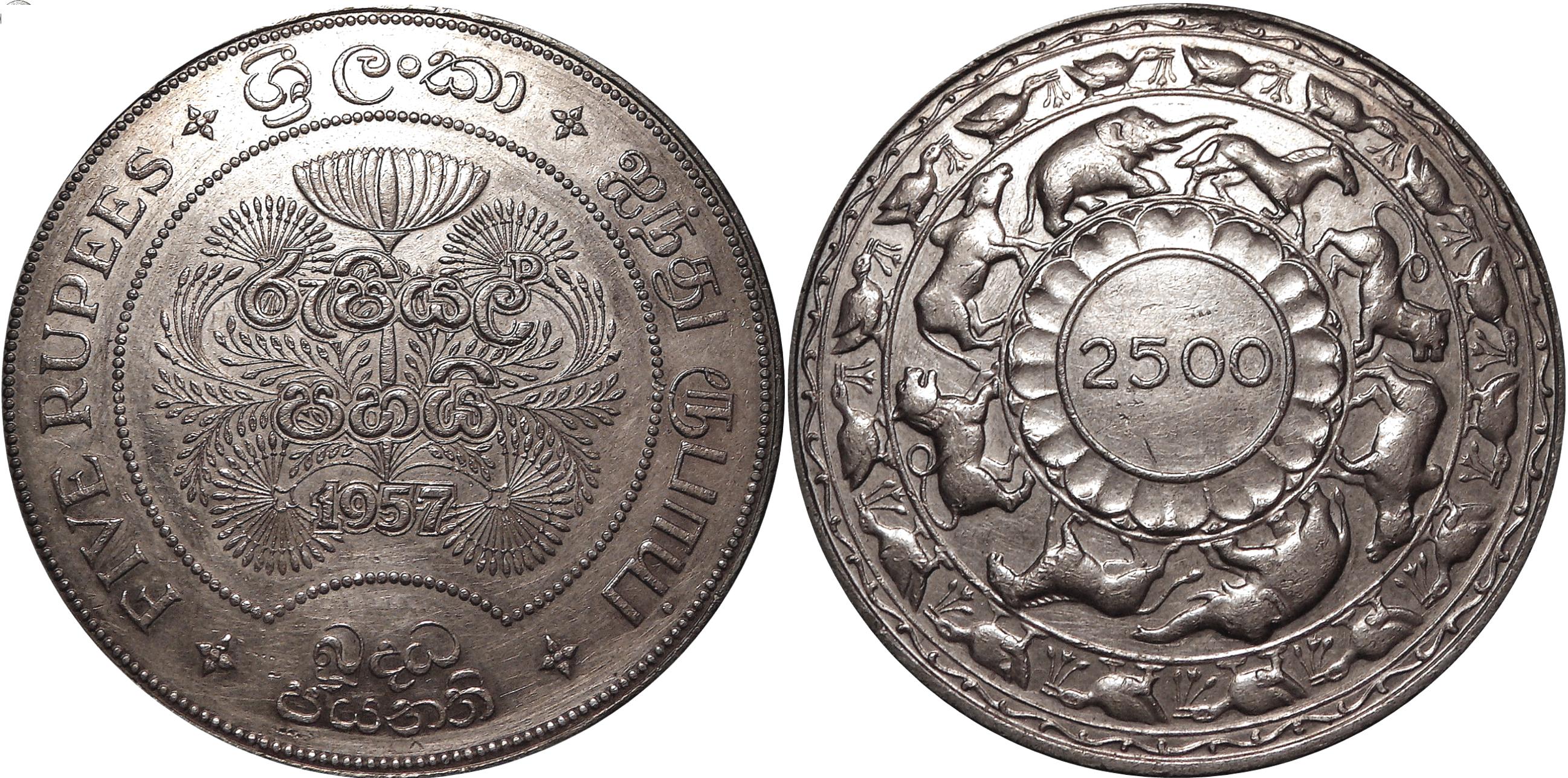
This is a 5 Rupee coin minted in 1957. It celebrates the 3500th anniversary of Buddhism. The coin weighs 28 grams of 0.925 finesness.
CHILE
The Republic of Chile is a ribbon-like country on the Pacific coast of southern South America. Diego de Almargo was the first Spaniard to attempt to wrest Chile from the Incas and Araucanian tribes in 1536. He failed, and was followed by Pedro de Valdivia, a favorite of Pizarro, who founded Santiago in 1541. When the Napoleonic Wars involved Spain, leaving the constituent parts of the Spanish Empire to their own devices, Chilean patriots formed a national government and proclaimed the country's independence on 18 Sept. 1810. Independence however, was not secured until 12 Feb. 1818, after a bitter struggle led by Bernardo O'Higgins and San Martin. Despite a long steady history of monetary devaluation, reflected in declining weight and fineness in its currency, Chile developed a strong democracy. This was displaced when rampant inflation characterized chaotic and subsequently repressive governments in the mid to late 20th century.
This is an emergency 1 Peso coin struck in Copiapo during the 1859 revolution, The coin is simple, an inverted Chilean coat-of-arms with the denomination I.P below. They were struck by Don Pedro Leon Gallo. Weight is 22 grams of 0.970 fineness.
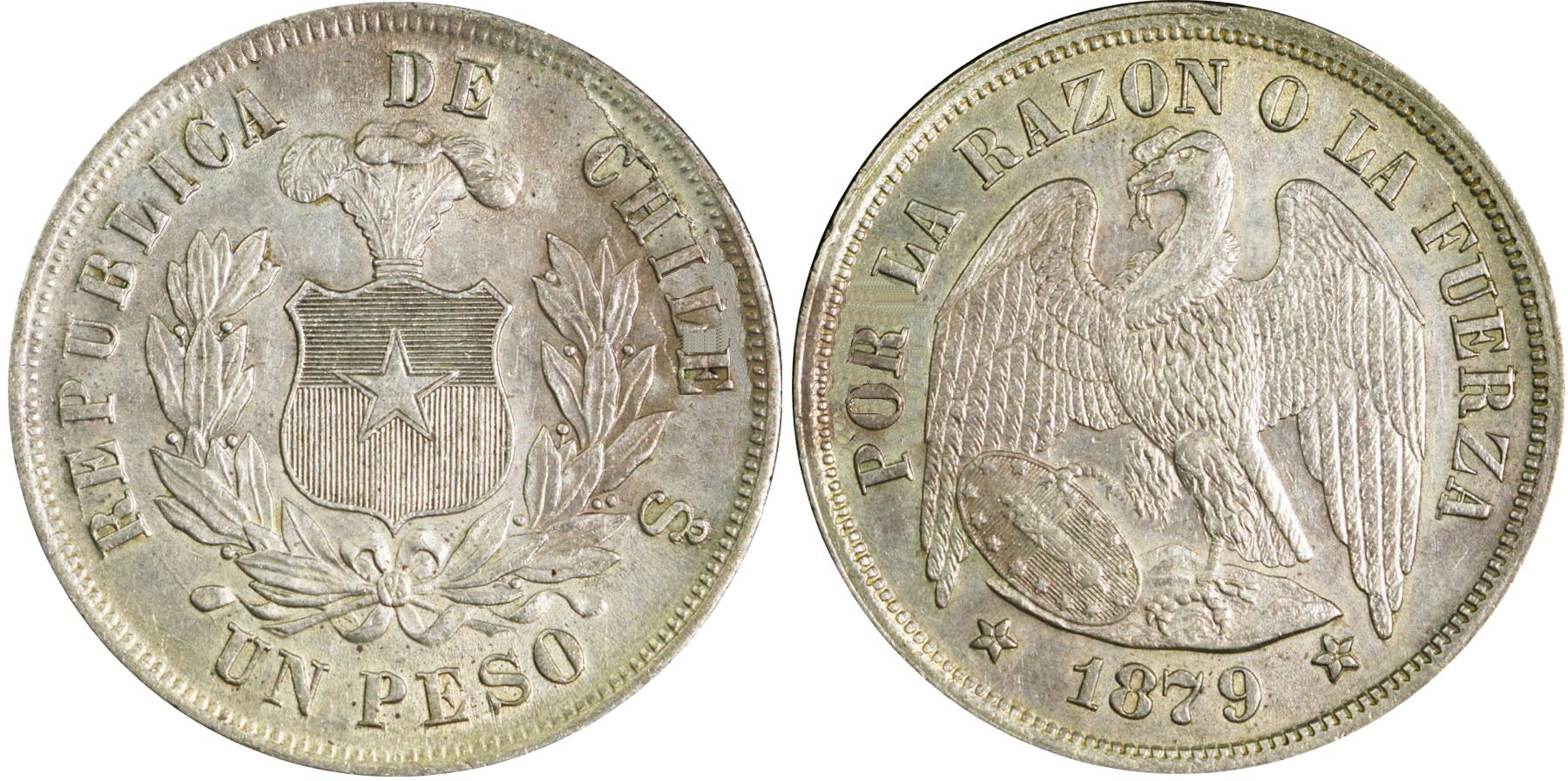
This is an one Peso coin minted in 1879 at Santiago. The obverse has Chile's arms. The reverse has an eagle with the motto POR LA RAZON O LA FUERZA. The coin weighs 25 grams at 0.900 fineness.
CHINA
Before 1912, China was ruled by an imperial government. The republican administration which replaced it in 1910 was itself supplanted on the Chinese mainland by a communist government in 1949, but a Nationalist government has remained in control of Taiwan and other offshore islands in the China Sea.
Cast coins in base metals were used in China many centuries before the Christian era, but locally struck coinages of the western type in gold, silver, copper and other metals did not appear until 1888. In spite of the relatively short time that modern coins have been in use, the number of varieties is exceptionally large.
Both Nationalist and Communist China, as well as the prerevolutionary Imperial government and numerous provincial or other agencies, including some foreign-administered agencies and governments, have issued coins in China. Most of these have been in dollar (yuan) or dollar-fraction denominations, based on the internationally used dollar system, but coins in tael denominations were issued in the 1920's and earlier. The striking of coins nearly ceased in the late 1930's through the 1940's due to the war effort and a period of uncontrollable inflation while vast amounts of paper currency were issued by the Nationalist, Communist and Japanese occupation institutions.
Imperial silver coins normally bore no denomination, but were inscribed with their weights as follows:
1 Dollar = 7 Mace and 2 Candareens, 26.869
50 Cents = 3 Mace and 6 Candareens, 13.439
20 Cents = I Mace and 4.4 Candareens, 5.37 9
10 Cents = 7.2 Candareens, 2.68 g
5 Cents = 3.6 Candareens, 1.34 g
Republic coinage is generally in Yuan (dollar), though Sinkiang Province used Sar (which was a Tael or 1.124 troy oz).
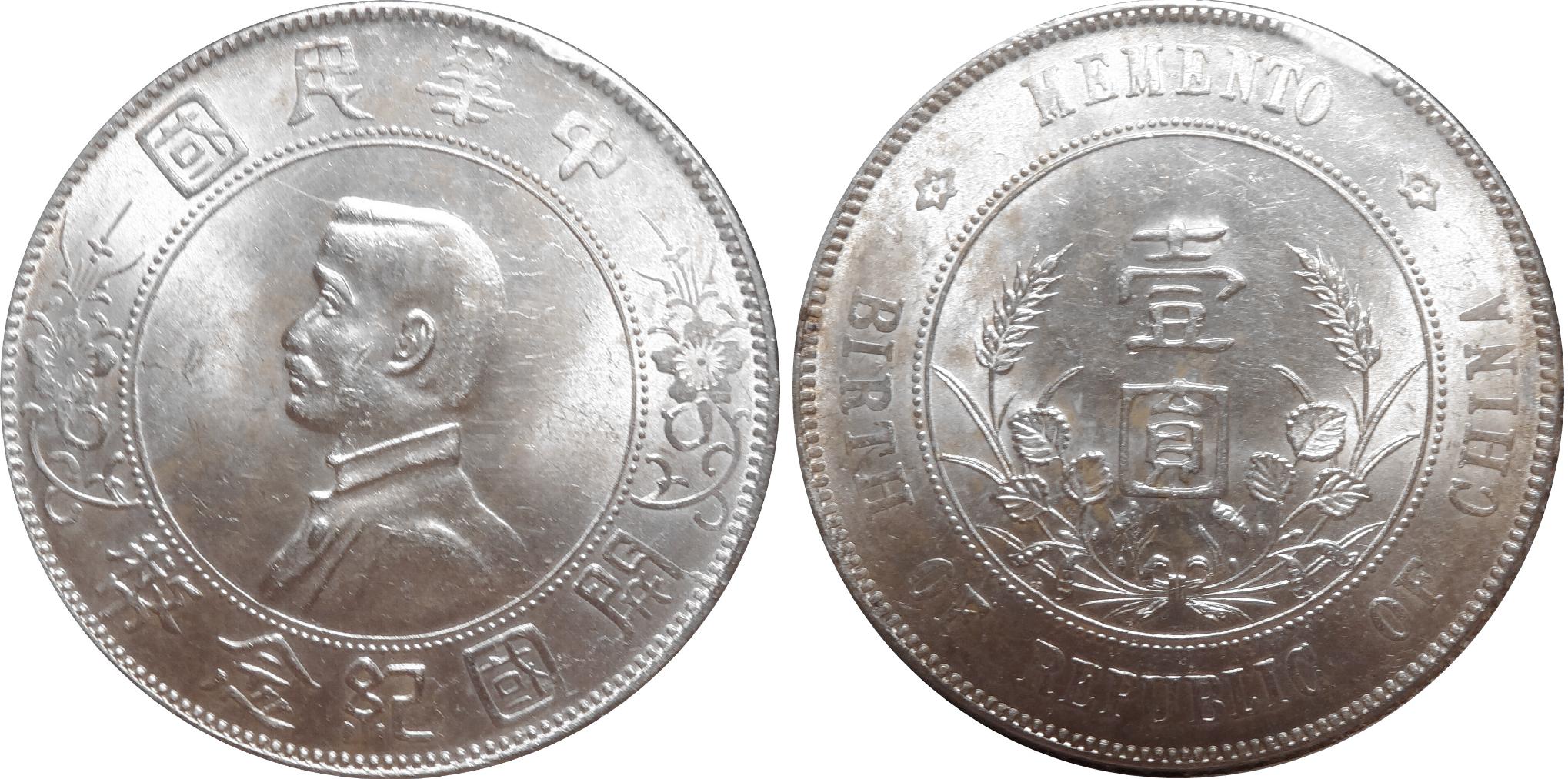
This is a one Dollar coin issued in 1927 in commemoration of the founding of the Chinese Republic. The obverse features Dr. Sun Yat Sen, credited as the founder of the Republic. Weighs 25.7 grams of 0.900 fineness.

This is an example of foreign silver coinage that saw circulation in Imperial China. It is called a Spanish Milled Dollar and was minted in Mexico City in 1762 These coins were exported to the Far East. The Chinese characters stamped on the coin are individual merchants' chops to attest that the coin met the fineness and weight standards. Many different foreign silver crowns were used and marked this way though most are Spanish colonial pieces from the American mints. Weighs 27 grams of 0.917 fineness.
Provincial Coinage
The Empire central authority did not issue crowns per se. Coinage was left to the individual provinces. These crowns for the most part were denominated in the weight counting system made of 7 Mace and 2 Candareens.
Chihli
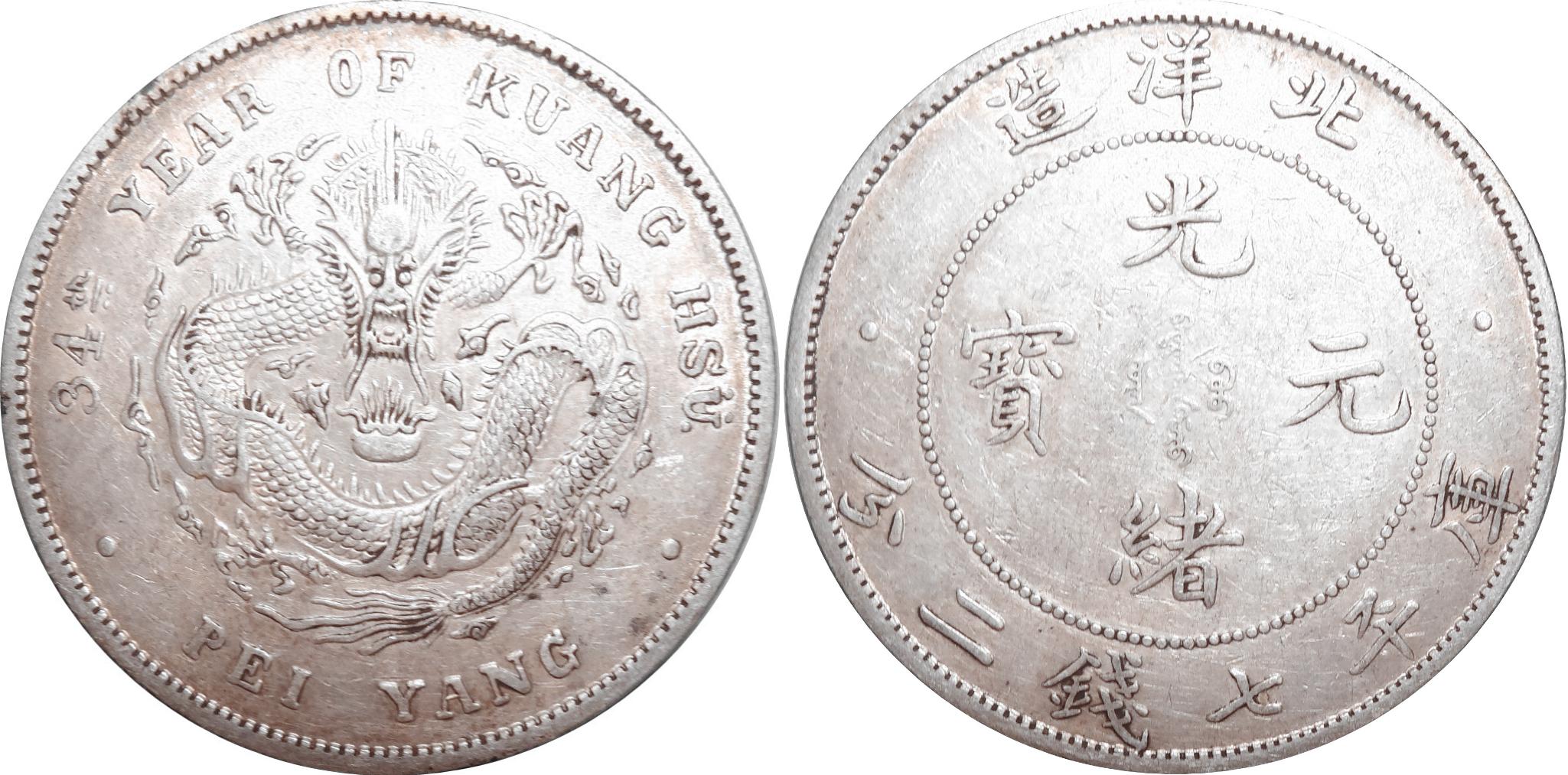
This coin was struck at the Pei Yang Arsenal in Tientsin in 1908. The coin was minted in the 34th year of the reign of Emperor Kuang Hsu. Chihli (or Hopei) province is now known in Pinyan as Hebei province and is in northeast China. Weighs 26.7 grams of 0.900 fineness.
Hupeh
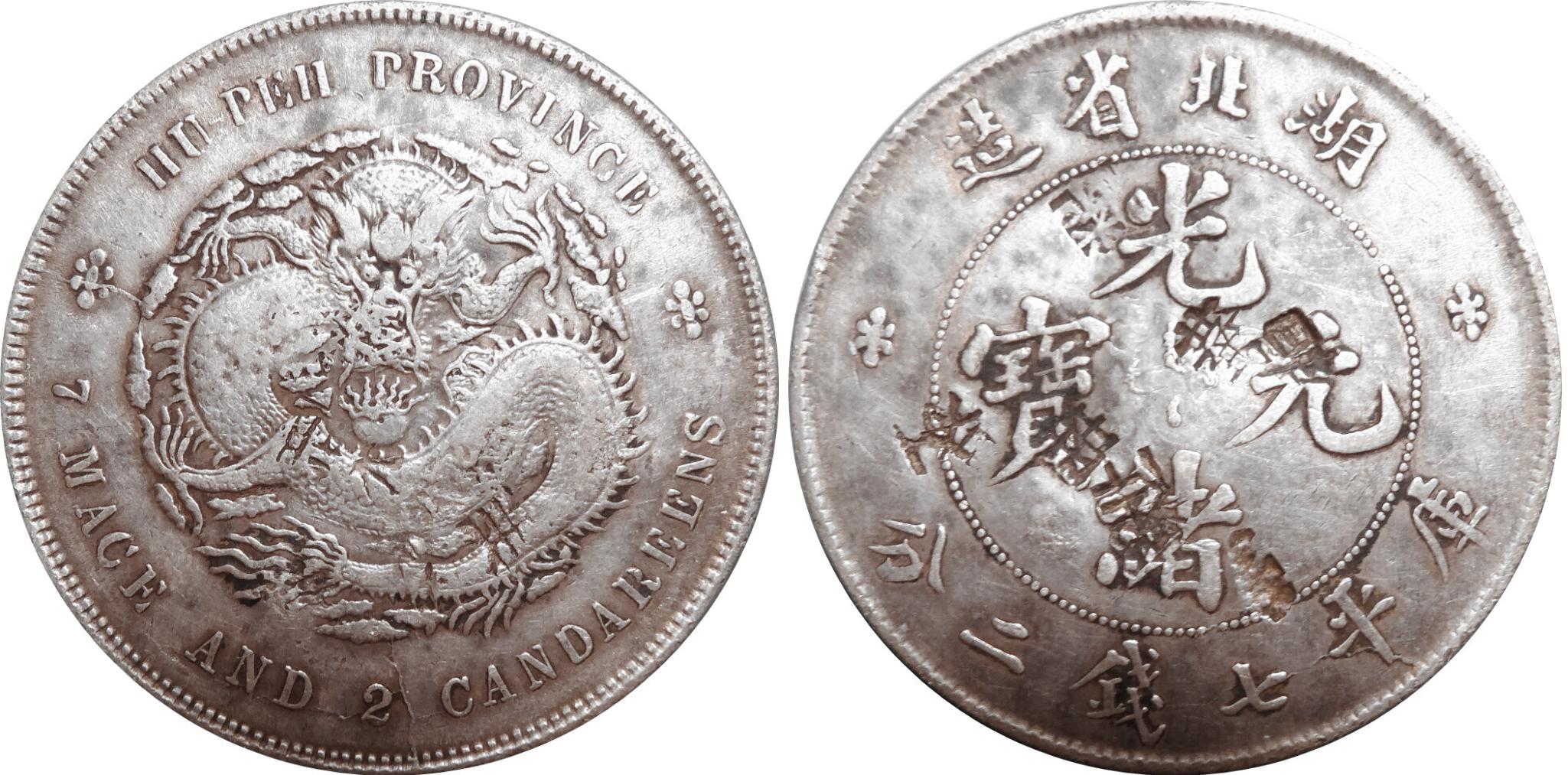
This coin was minted in 1900. The coin has merchant chop marks on both sides signifying the value of the coin. Hupeh Province is now known as Hubei Province and is located in central China. Weighs 26.7 grams of 0.900 fineness.
Kiangnan
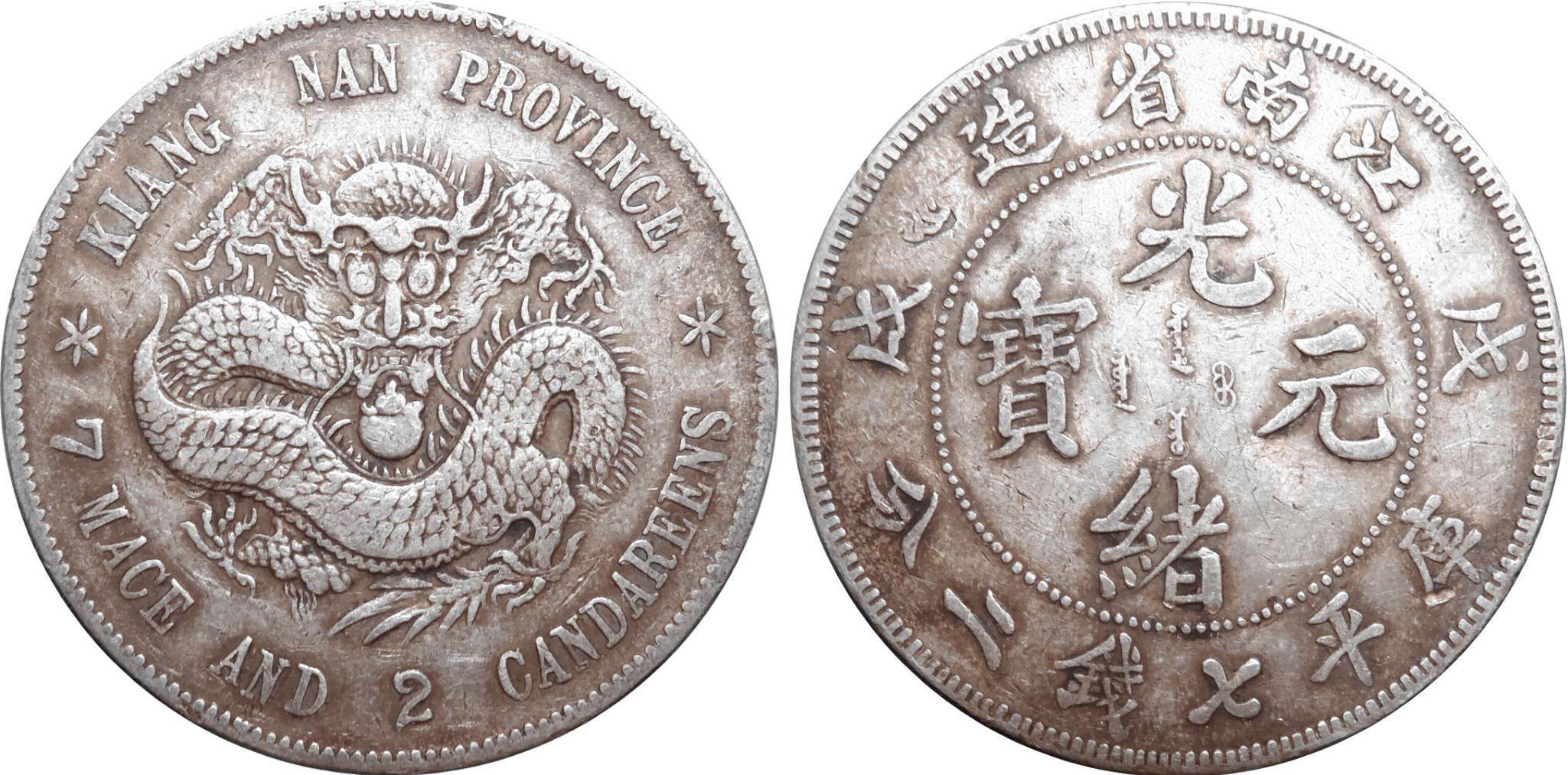
This coin was minted in 1898 in Kiangnan Province is now known as Jiangnan district and is located in east central China. Weighs 26.7 grams of 0.900 fineness.
Kwangtung
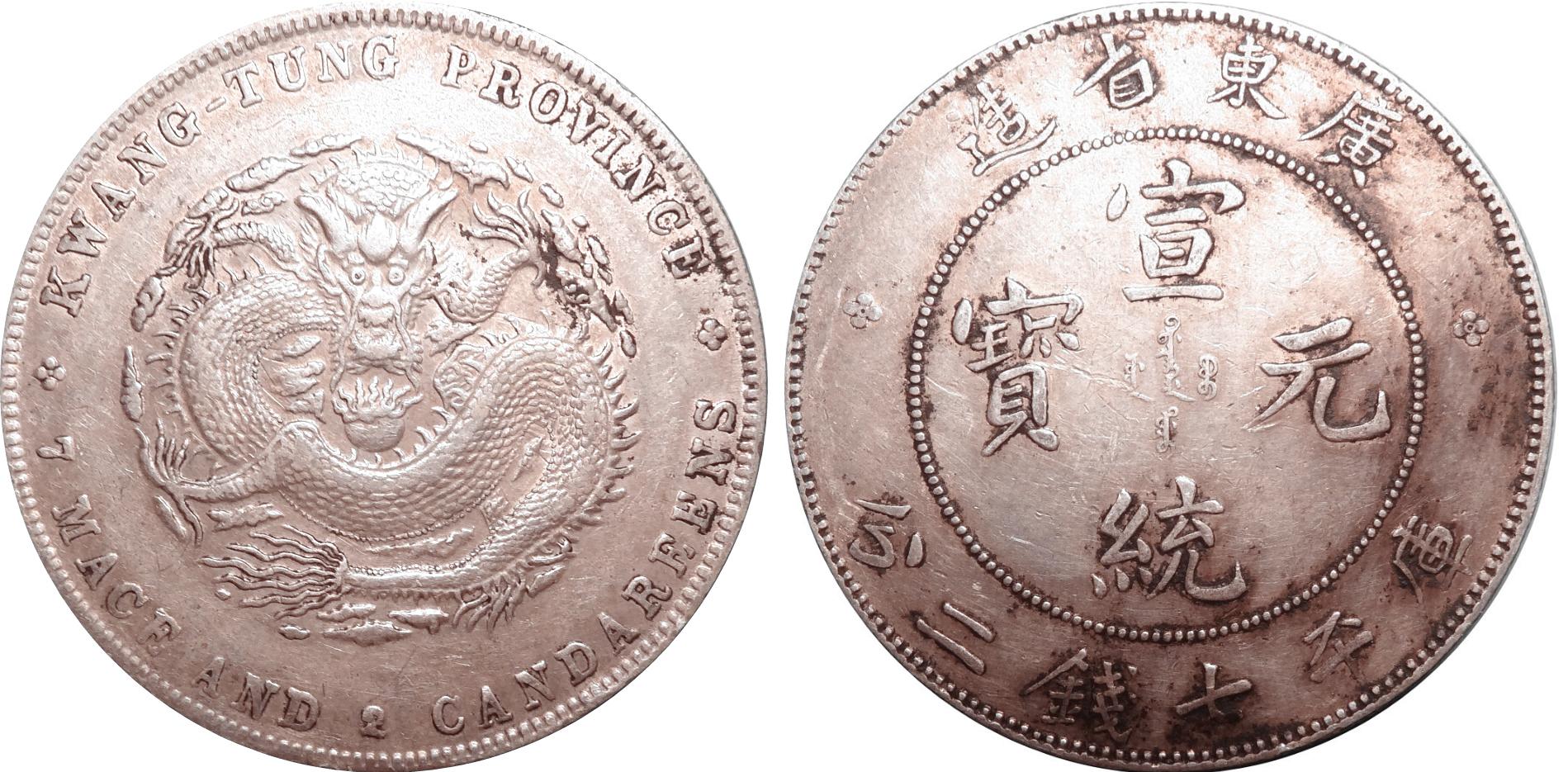
This coin was struck in the province of Kwangtung around 1890. Kwangtung is now known as Guangdong Province and is in southeast China. Weighs 26.7 grams of 0.900 fineness.
Sinkiang
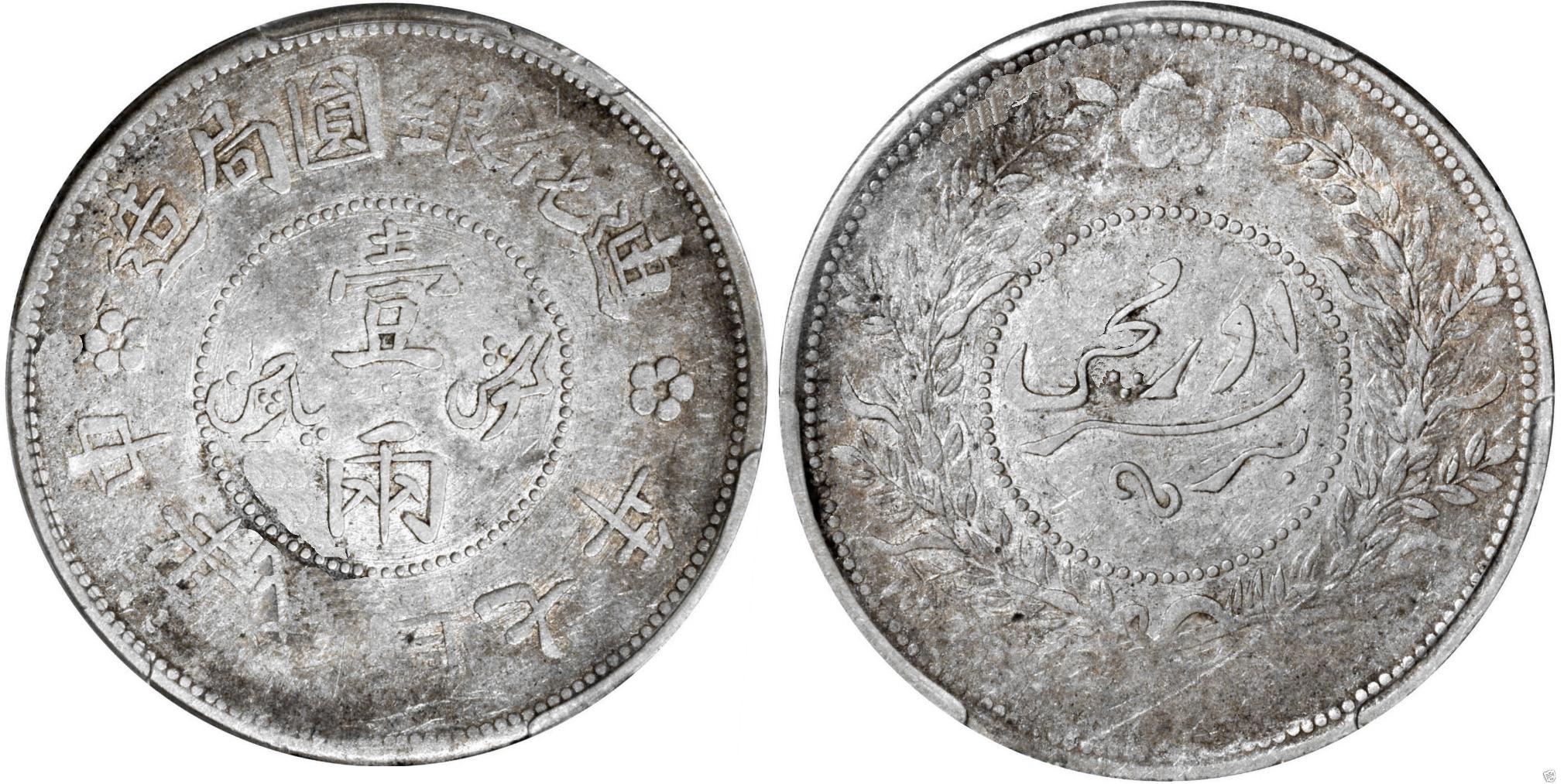
This is an one Sar coin minted in 1918. The reverse has an Arabic legend as the area is heavily Uighar Mohammedan. Sinkiang province is now known as Xinjiang-Uygur Province is located in extreme west central China. Weighs 35.5 grams of 0.900 fineness.
Szechuan
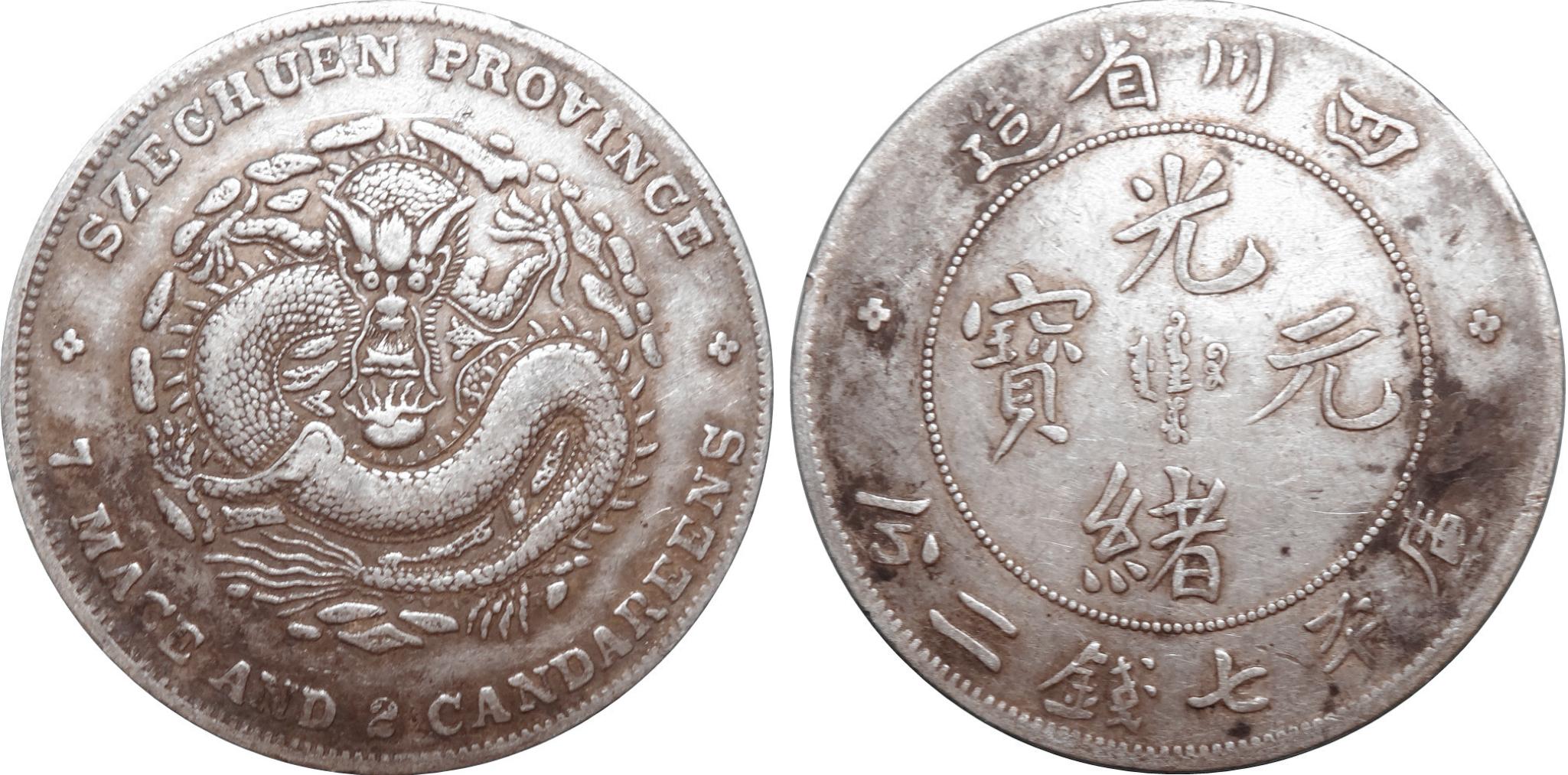
This coin was an imperial issue minted in the c1901-1908 period. Szechuan Province is now known as Sichuan Province and is located in south central China. Weighs 26.7 grams of 0.900 fineness.
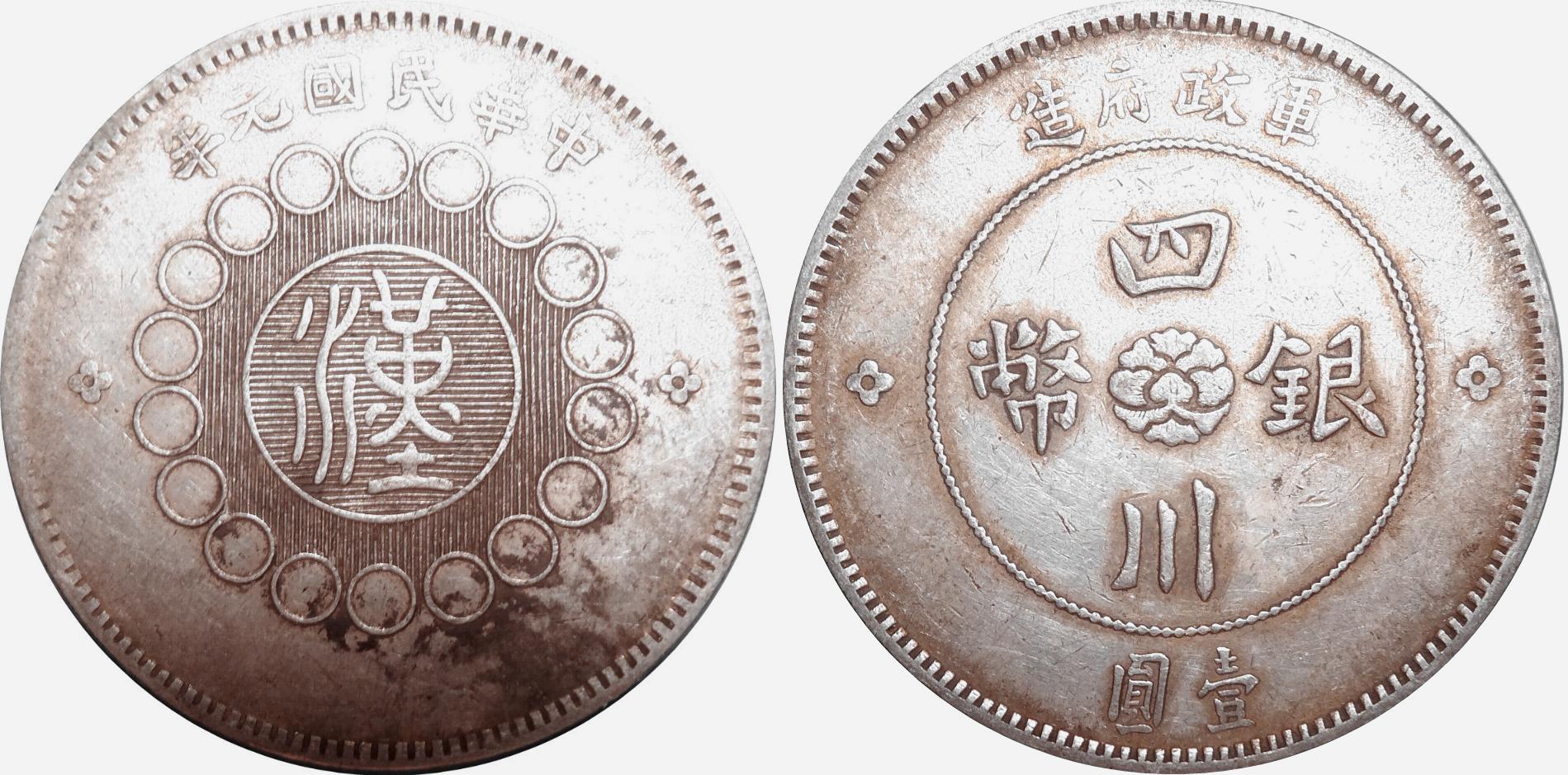
This is a Chinese one dollar coin minted for Szechuan province by the Republic authorities in 1912. Weighs 26.7 grams of 0.900 fineness.
Yunnan

This coin was struck in the province of Yunnan by the Empire authorities around 1909. Yunnan Province is in extreme south central China. Weighs 26.7 grams of 0.900 fineness.
COLOMBIA
The Republic of Colombia is in the northwestern corner of South America. The northern coast of present Colombia was one of the first parts of the American continent to be visited by Spanish navigators. Darien in Panama is the site of the first permanent European settlement on the American mainland in 1510. New Granada, as Colombia was known until 1861, stemmed from the settlement of Santa Marta in 1525. New Granada was established as a Spanish colony in 1549. Independence was declared in 1810, and secured in 1819 when Simon Bolivar united Colombia, Venezuela, Panama, and Ecuador as the Republic of Gran Colombia. Venezuela withdrew from the Republic in 1829; Ecuador in 1830; and Panama in 1903.
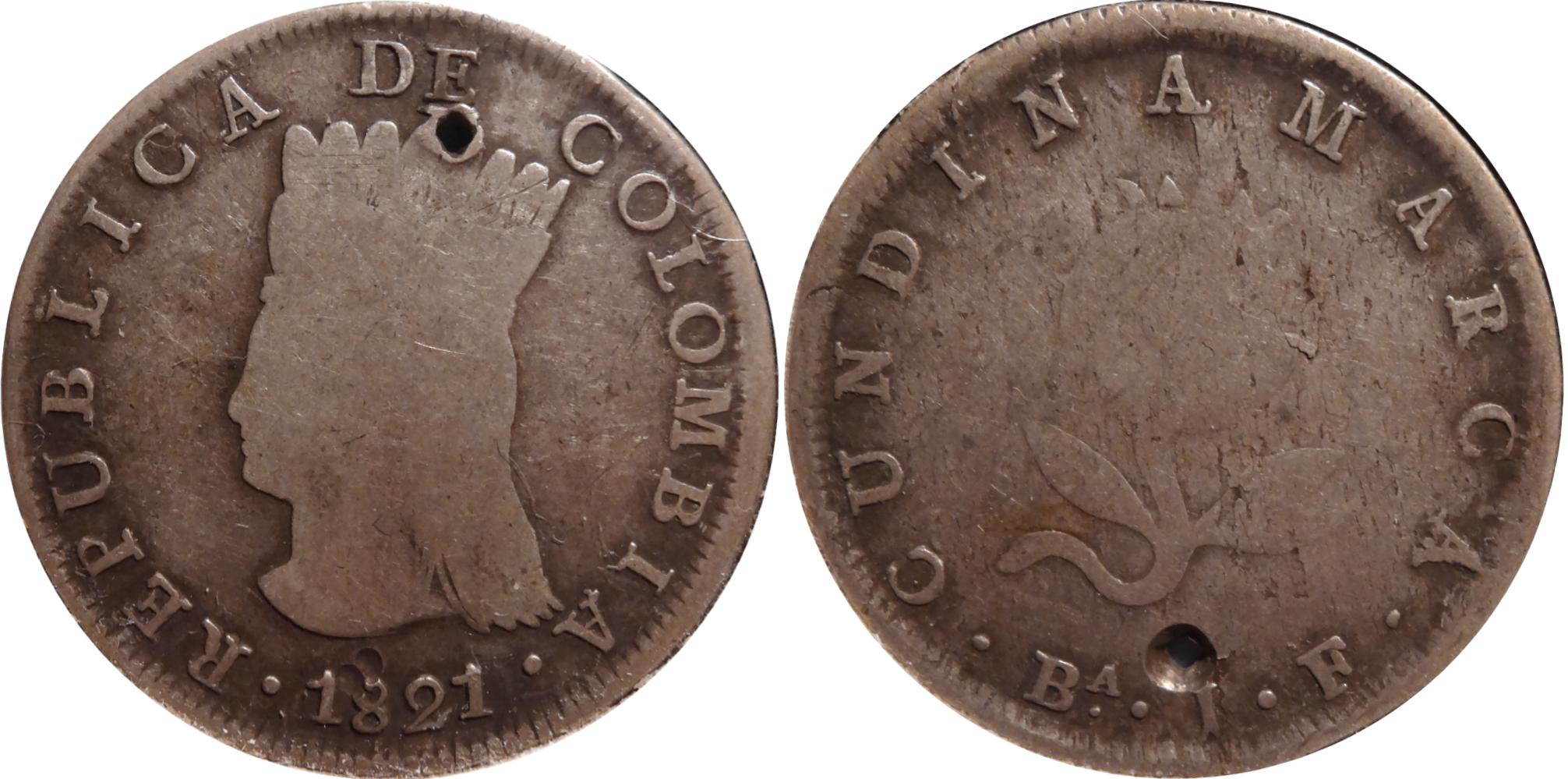
This is an eight reales coin dated 1821 was minted for the province of Cundimarca. The obverse has an Indian's head. The reverse has a pomegranate. Weighs 23 grams of 0.666 fineness.
COMORO ISLANDS
Comoros, a volcanic archipelago located in the Mozambique Channel of the Indian Ocean 200 miles (482 km.) northwest of Madagascar. Ancient Phoenician traders were probably the first visitors to the Comoro Islands, but the first detailed knowledge of the area was gathered by Arab sailors. Arab dominion and culture were firmly established when the Portuguese, Dutch, and French arrived in the 16th century. In 1842 a Malagasy ruler ceded the island of Mayotte to France; the other three principal islands of the archipelago-Anjouan. Moheli. and Grand Comore came under French, protection in 1886. The islands were joined administratively with Madagascar in 1912.The Comoros became partially autonomous, with the status of a French overseas territory, in 1946, and achieved complete internal autonomy in 1961. On 21 Dec. 1976, after 133 years of French association. the Comoro Islands became the independent Republic of the Comoros.
Mayotte retained the option of determining its future ties and in 1976 voted to remain French. Its present status is that of a French Territorial Collectivity. French currency now circulates there.
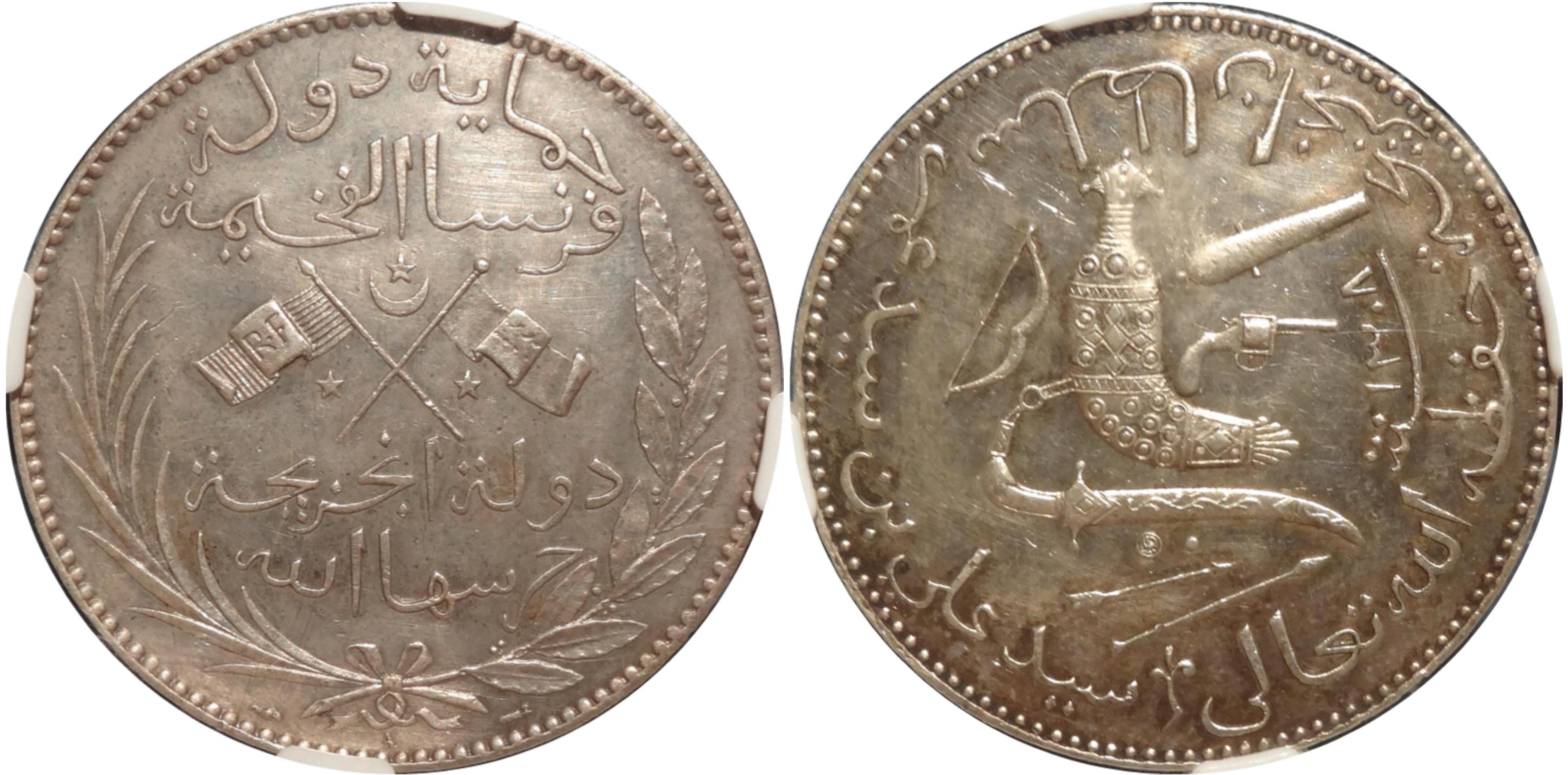
This is a 5 Francs coin struck in Paris for the Comoro Islands.
The obverse has the crossed flags of France and the Sultanate of the Comoros
with the legend
حماية دولة - فرنسا الفخيمة
دولة انجزيجة -حرسها اللة (.State
protection
Luxury France State of congruence Guarded by God).
The reverse has weapons with the legend
سيد علي بن سيد عمر سلطان انجزيجة حفظه اللة تعالي
(Sayed
Ali bin Sayyid Omar Sultan).
The
legends are all in Arabic. The coin is dated 1308 AH (1890 AD). Mintage was 2050.
Weighs 25 grams of 0.900 fineness.
INDEPENDENT STATE OF THE CONGO
This entity is now known as the Democratic Republic of the Congo. In ancient times the territory was occupied by Negrito peoples (Pygmies) pushed into the mountains by Bantu and Nilotic invaders. The interior was first explored by the American correspondent Henry Stanley, who was subsequently commissioned by King Leopold ii of Belgium to conclude development treaties with the local chiefs. The Berlin conference of 1885 awarded the area to Leopold, who administered and exploited it as his private property until it was annexed to Belgium in 1908.
In November of 1877 Leopold formed the Committee for Studies of the Upper Congo (Comité d’Études du Haut Congo, later renamed Association Internationale du Congo) to open up the African interior to European trade along the Congo River. Between 1879 and 1882, under the committee’s auspices, Stanley established stations on the upper Congo and opened negotiations with local rulers. By 1884 the Association Internationale du Congo had signed treaties with 450 independent African entities and, on that basis, asserted its right to govern all the territory concerned as an independent state. At the Berlin West Africa Conference of 1884–85, its name became the Congo Free State, and European powers recognized Leopold as its sovereign.
From 1908 to 1960, the year of independence, it was known as the colony of the Belgian Congo. After 1960 it was wracked by violence from the Congolese leader Patrice Lumumba, a communist, who tried to ally it with the Soviets. Katanga was a breakaway province led by a pro-Western leader Moises Tshombe who was killed in an aircraft "accident."
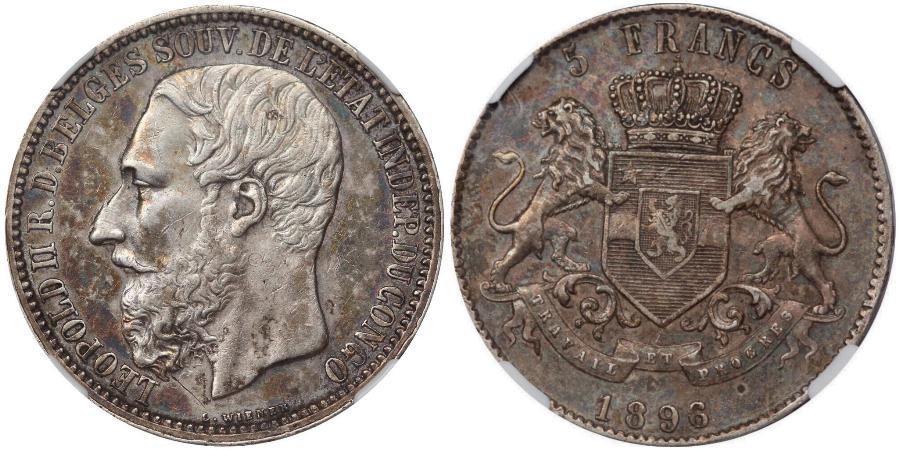
The State struck coinage from 1887 to 1896 encompassing the denominations from 1 centime to 5 Francs. The 5 Franc crowns were struck from 1887 to 1896 in limited numbers. This particular coin is an 1896 struck from a die that had been used in 1894 and was recut with the last digit in the date. It is the rarest of the State's coins. The obverse has Leopold's bust facing left with his titles LEOPOLD II R.D.BELGES SOUV.DE LA'ETAT INDEP. DU CONGO (Leopold II, King of the Belgians Sovereign of the Independent State of Congo) and the designer's name L. WEINER below the bust. The reverse has the State's seal with the denomination 5 FRANCS at the top and the date 1896 at the bottom. Weighs 25 grams of 0.900 fineness.
COOK ISLANDS
Cook Islands is a self-governing dependency of New Zealand consisting of 15 islands, is located in the South Pacific Ocean about 2,000 miles (3,218 km.) northeast of New Zealand. Spanish navigator Alvaro de Mendada first sighted the islands in 1595. Portuguese navigator Pedro Fernandes de Quieis landed on Rakahanga in 1606. English navigator Capt. James Cook sailed to the islands on three occasions: 1773, 1774 and 1777. He named them Hervey Islands, in honor of Augustus John Hervey, a lord of the Admiralty. The islands were declared a British protectorate in 1888, and were annexed to New Zealand in 1901. They were granted internal self-government in 1965. New Zealand provides an annual subsidy and retains responsibility for defense and foreign affairs.
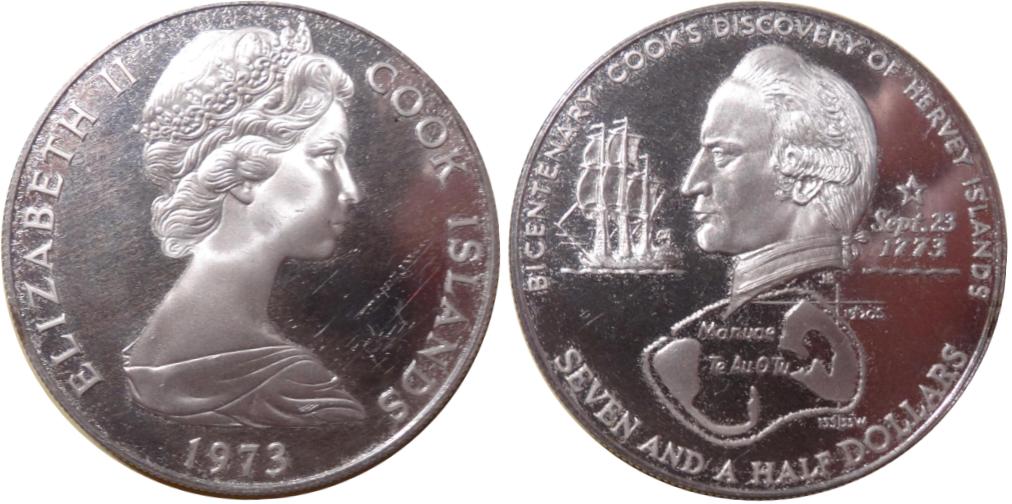
This is an unusual denomination coin, seven and one half Dollars. It was minted in 1973 to honor the bicentenary of Capt. Cook's naming of Hervey Islands. Weighs 33.8 grams of 0.925 fineness.
CRETE
The Island of Crete located 60 miles southeast of the Peloponnesus, was the center of a brilliant Minoan civilization that flourished before the advent of Greek culture. Alter being conquered by the Romans, Byzantines, Moslems, and Venetians, Crete became part of the Turkish Empire In 1669. As a consequence of the Greek Revolution of the1820s, It was ceded to Egypt. Egypt returned the Island to the Turks In 1840. After a brief period of independence (1897–1913) under a provisional Cretan government, it joined the Kingdom of Greece.
This is 5 Drachma piece issued for Crete by the Greeks in 1901 (the special coinage was only minted in 1900 and 1901). The obverse pictures Greek King George with the legend ΠΡΙΓΚΗΨ ΓΕΩΡΓΙΟΣ ΤΗΣ ΕΛΛΑΔΟΣ ΥΠΑΤΟΣ ΑΡΜΟΣΤΗΣ ΕΝ ΚΡΗΤΗ Α ΒΟΡΡΕΛ (Prince George of Greece, high commissioner of Crete). The reverse has the Cretan coat-of-arms and the legend ΚPΗΤΙΚΗ ΠΟΛΙΤΕΙΑ (Crete State). Weighs 25 grams of 0.900 fineness.
CUBA
Discovered by Columbus in 1492 and settled by Diego Velasquez in the early 1500s, Cuba remained a Spanish possession until 1898, except for a brief British occupancy of Havana in 1762-63. Cuban attempts to gain freedom were crushed, even while Spain was granting independence to its other American possessions. Ten years of warfare, 1868-78, between Spanish troops and Cuban rebels exacted guarantees of rights which were never implemented. The final revolt, begun in 1895, evoked American sympathy, and with the aid of U.S. troops independence was proclaimed on 20 May 1902. Fulgencio Batista seized the government in 1952 and established a dictatorship. Opposition to Batista, led by Fidel Castro, drove him into exile on 1 Jan. 1959. A communist-type, 25-member collective leadership headed by Castro was inaugurated in March 1962.
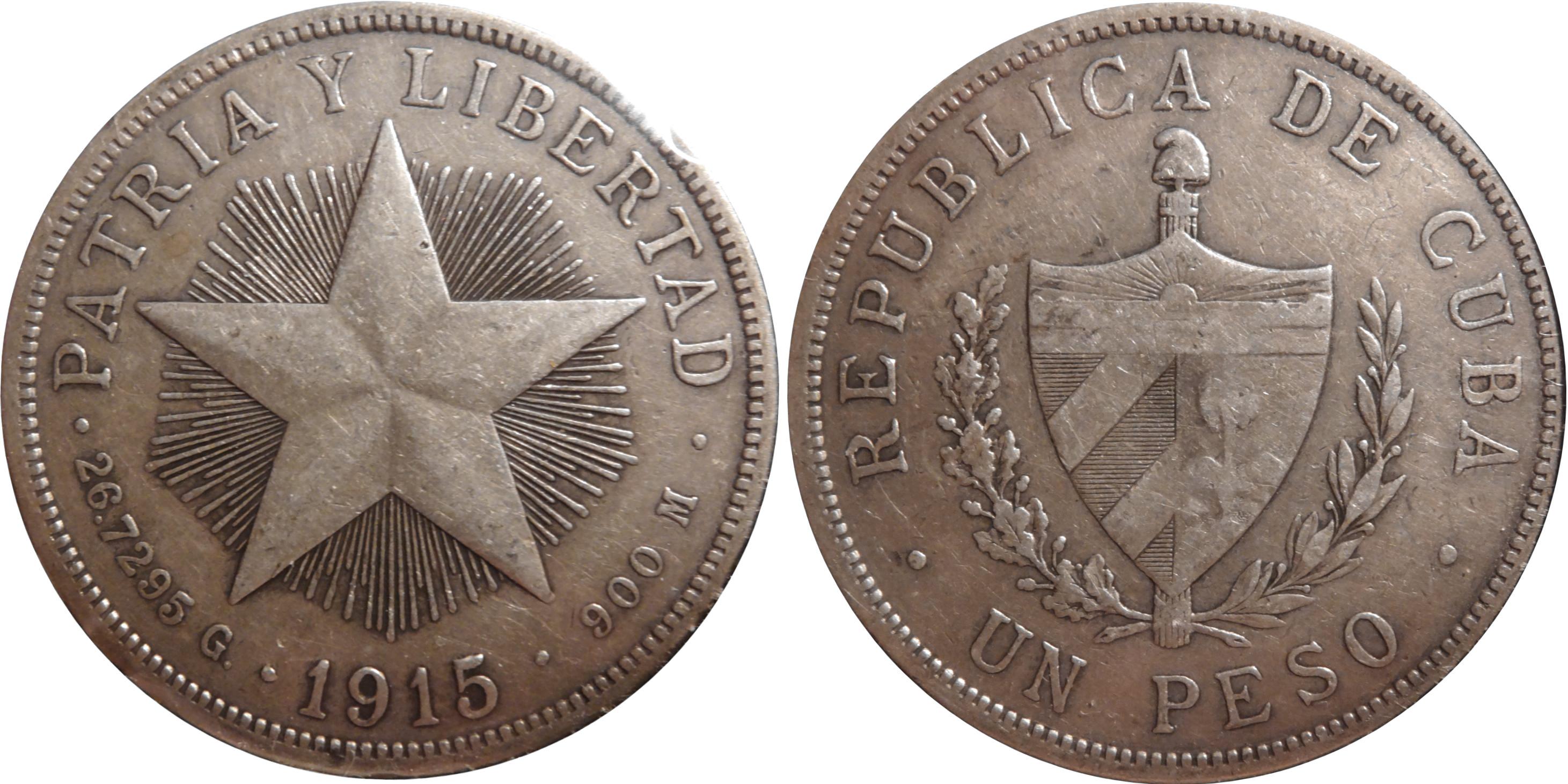
This is a one Peso coin minted in Philadelphia in 1915. It was the first year if Cuban coinage. The reverse has the Cuban arms. Weighs 26.7 grams of 0.900 fineness.
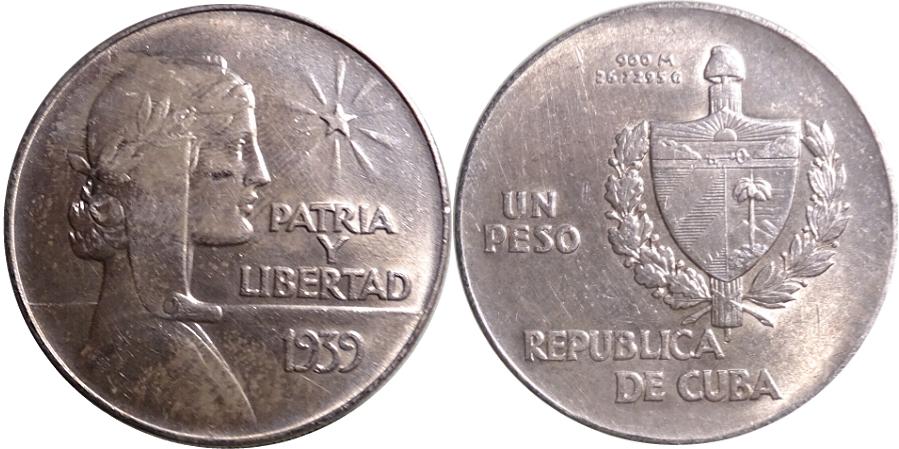
This is a one Peso coin minted in Philadelphia in 1939. It is called the ABC Peso. They are named for a clandestine, revolutionary protest group titled the "ABC". Members were primarily from the University of Havana, and young professionals who used terror to combat the corrupt and dictatorial rule of Gerardo Machado, President of Cuba from 1925-1933. Weighs 26.7 grams of 0.900 fineness.
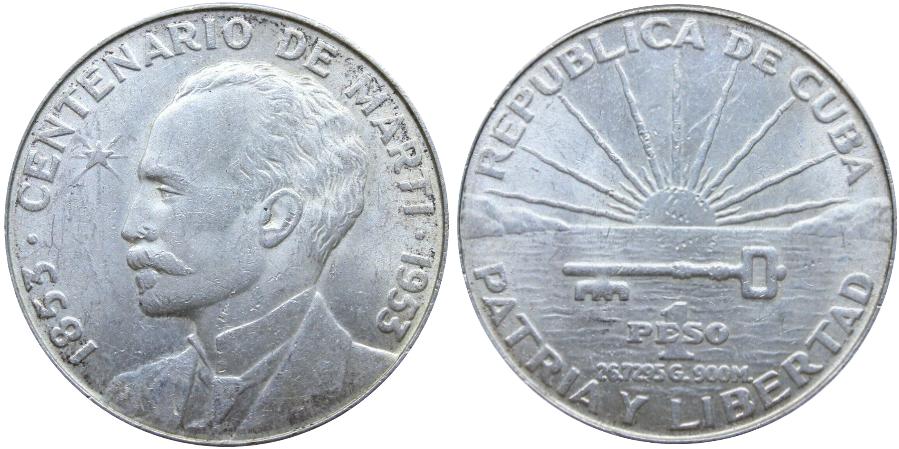
This is a one Peso coin minted in Philadelphia in 1953 to celebrate the 100th anniversary of José Martí's birth. He is depicted on the obverse. The reverse has the upper central portion of the Cuban coat of arms: radiant sun rising over sea with key in foreground. Weighs 26.7 grams of 0.900 fineness.
CURAÇAO
The island of Curaçao, the largest of the six islands that made up the Netherlands Antilles, is a country within the Kingdom of the Netherlands located in the Caribbean Sea 40 miles off the coast of Venezuela. Curaçao was discovered by Spanish navigator Alonsode Ojeda in 1499 and was settled by Spain in 1527. The Dutch West India Company took the Island from Spain in 1634 and administered it until 1787 when it was surrendered to the United Netherlands. The Dutch held it thereafter except for two periods during the Napoleonic Wars, 1800-1803 and 1807-16, when it was occupied by the British. During World War II, Curaçao refined 60 percent of the oil used by the Allies; the refineries were protected by U.S. troops after Germany invaded the Netherlands in 1940.
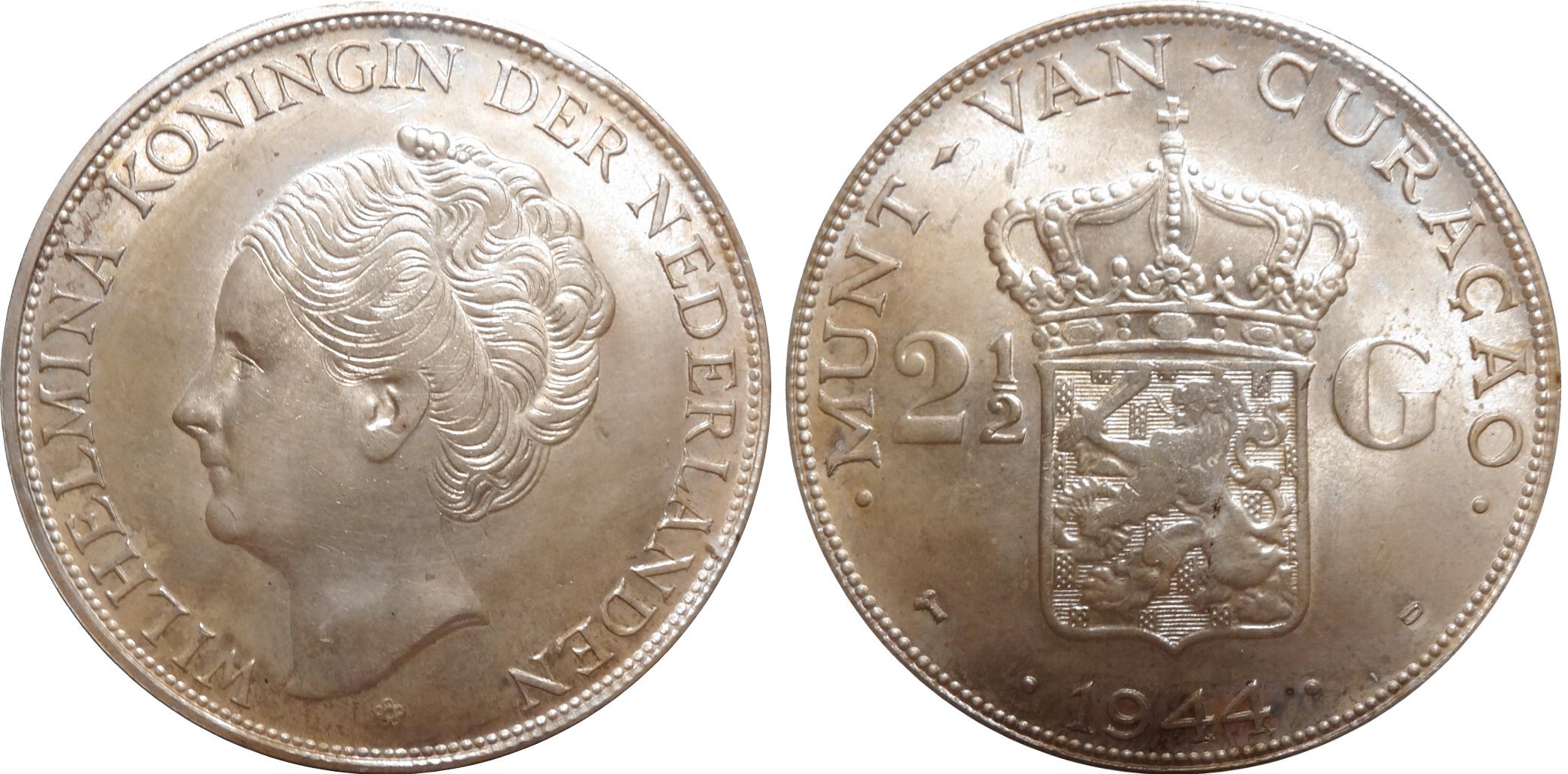
This is a 2½ Guilder (or Florin) coin minted at the U.S. Denver Mint in 1944 while The Netherlands were occupied by he Germans during World War II. Obverse has Queen Wilhelmina and reverse has the Dutch arms. Weighs 25 grams of 0.720 fineness.
CYPRUS
The island of Cyprus lies in the eastern Mediterranean Sea 44 miles (71 km.) south of Turkey and 60 miles (97 km.) off the Syrian coast. It is the third largest island in the Mediterranean Sea. The importance of Cyprus dates from the Bronze Age when it was desired as a principal source of copper (from which the Island derived its name) and as a strategic trading center. it was during this period that large numbers of Greeks settled on the Island and gave it the predominantly Greek character. Its role as an international marketplace made it a prime disseminator of the then prevalent cultures, a role that still influences the civilization of Western man. Because of its fortuitous position and influential role, Cyprus was conquered by a succession of empires: the Assyrian, Egyptian, Persian, Macedonian, Ptolemaic, Roman, and Byzantine. it was taken from Isaac Comnenus by Richard the Lion-Heart in 1191, sold to the Templar Knights and for the following 7 centuries was ruled by the Franks, the Venetians and the Ottomans. During the Ottoman period, Cyprus acquired its Turkish community (18 percent of its population). In 1878 the Island fell to the British.
This coin has an unusual denomination, 45 Piastres (45 piastres being equal to 5 shillings, or crown). Obverse has King George V and reverse two rampant lions. Weighs 28.28 grams of 0.925 fineness.
DANZIG
Danzig is an important seaport on the northern coast of Poland with access to the Baltic Sea. It has at different times belonged to the Teutonic Knights, Pomerania, Russia, and Prussia. It was part of the Polish Kingdom from 1587-1772. Danzig (Gdansk) was a free city from 1919 to 1939 during which most of its modern coinage was made.
Today it is part of Poland, the city is Gdansk, and it was the home of the Solidarity Movement which toppled communist rule of Poland.
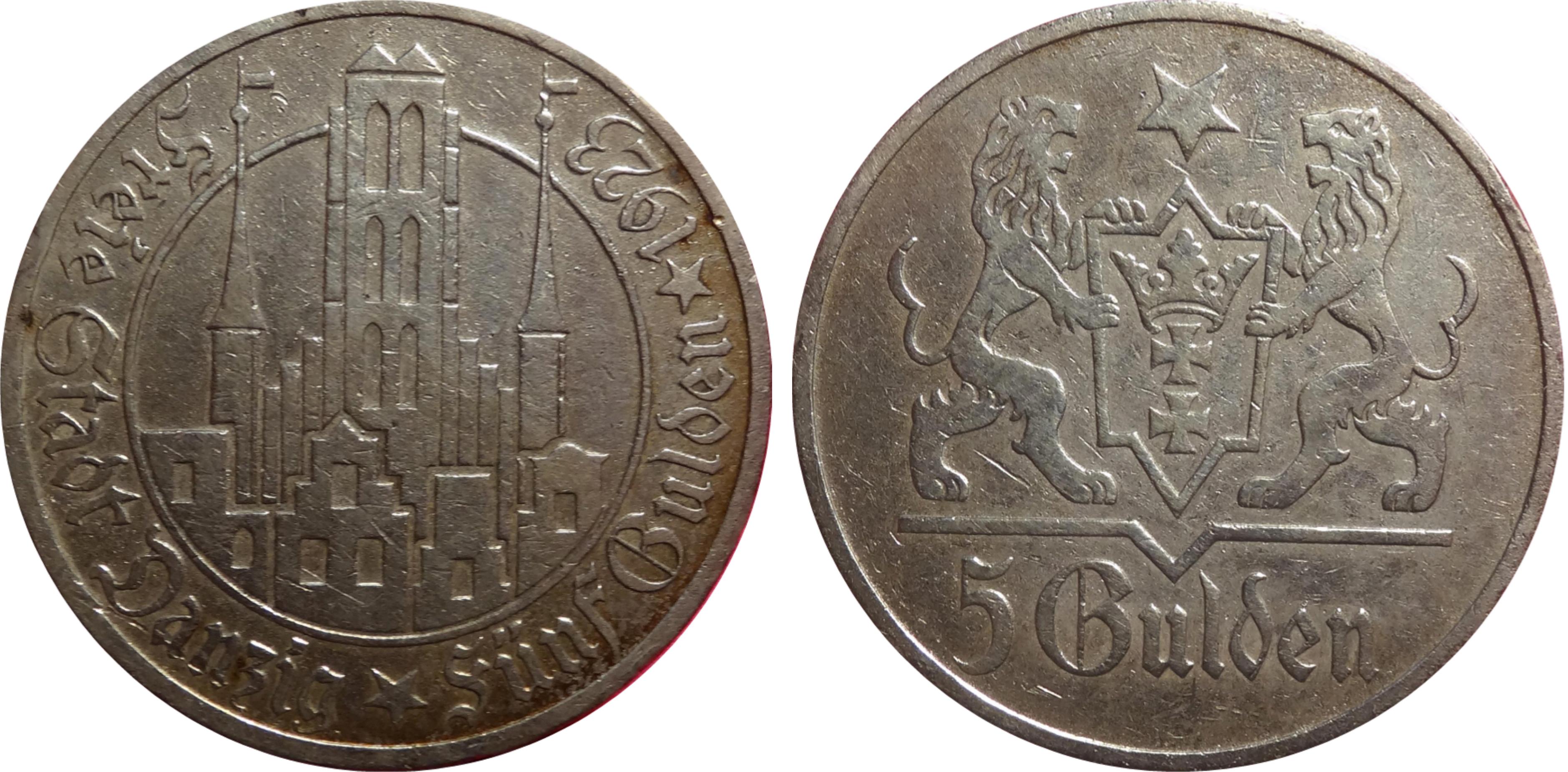
This is the 5 Gulden piece minted in 1823 in silver. Later in 1935 it was struck in nickel. The obverse has FREI STADT DANZIG * FÜNF GULDEN * 1923. The reverse has the city's arms. Weighs 25 grams of 0.750 fineness.
DENMARK
The southernmost and smallest of the Nordic countries,
it is south-west of Sweden and south of Norway, and bordered to the south by Germany.
The Kingdom of Denmark is a sovereign state that comprises Denmark proper and two
autonomous constituent countries in the North Atlantic Ocean: the Faroe Islands
and Greenland. The country consists of a peninsula, Jutland, and
an archipelago of 443 named islands, of which around 70 are inhabited, with Zealand,
the largest and featuring the capital and largest city Copenhagen. The islands are
characterized by flat, arable land and sandy coasts, low elevation and a temperate
climate.
The unified kingdom of Denmark emerged in the 10th century as a proficient seafaring
nation in the struggle for control of the Baltic Sea. Denmark, Sweden and Norway
were ruled together under the Kalmar Union, established in 1397 and ending with
Swedish secession in 1523. Denmark and Norway remained under the same monarch until
outside forces dissolved the union in 1814. The deterioration of the Kingdom of
Norway, caused by the Black Death, made it possible for Denmark to inherit an expansive
colonial empire from this union—of which the Faroe Islands and Greenland are remnants.
Beginning in the 17th century, there were several cessions of territory; these culminated
in the 1830s with a surge of nationalist movements, which were defeated in the 1864
Second Schleswig War. Denmark remained neutral during World War I. In April 1940,
a German invasion saw brief military skirmishes while the Danish resistance movement
was active from 1943 until the German surrender in May 1945.
The Constitution of Denmark was signed on 5 June 1849, ending the absolute monarchy
which had begun in 1660. It established a constitutional monarchy—the current monarch
is Queen Margrethe II—organized as a parliamentary democracy. The government and
national parliament are seated in Copenhagen, the nation's capital, largest city
and main commercial centre. Denmark exercises hegemonic influence in the Danish
Realm, devolving powers to handle internal affairs. Home rule was established in
the Faroe Islands in 1948; in Greenland home rule was established in 1979 and further
autonomy in 2009.
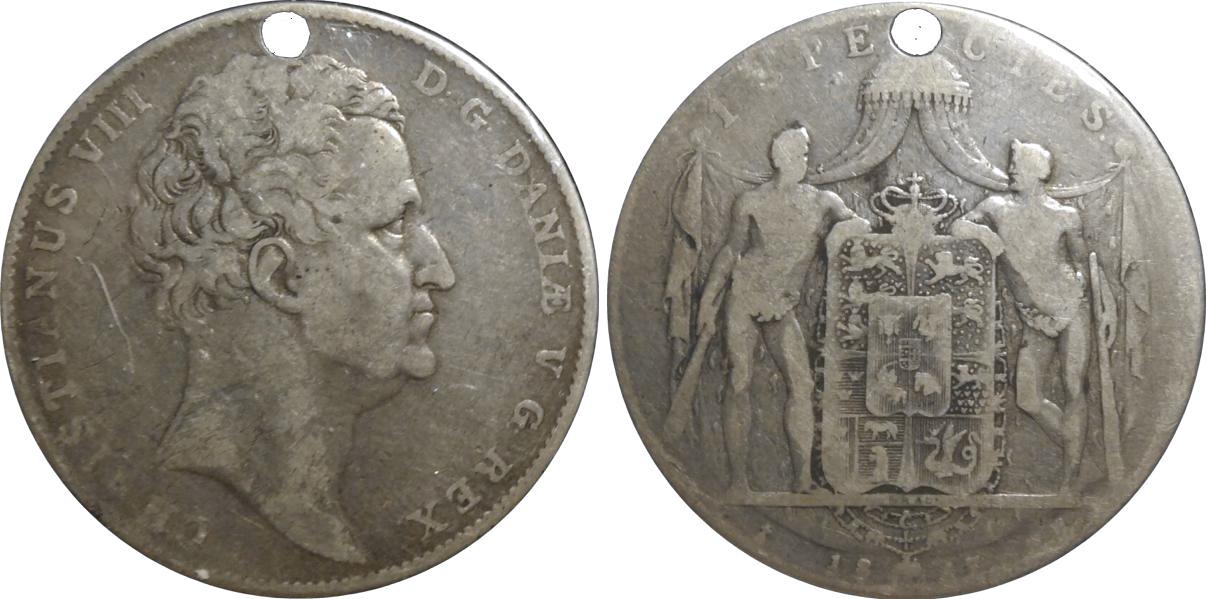
This is a Danish one Species Dalar minted at the Altona mint in 1847. The obverse has King Christian VIII with the legend CHRISTIANUS VIII D:G:DANIÆ V:G:REX. The reverse has the arms of Denmark with the denomination above and the date 1847 with the mintmark (orb) at the left and the mintmaster's initials FF (Johan Friedrich Freund) at the right. Weighs 28.8 grams of 0.875 fineness.
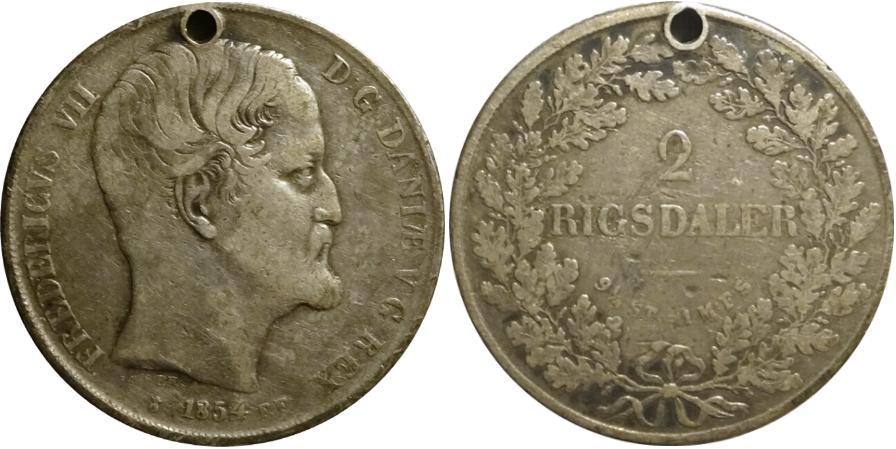
This is a Danish two rigsdalar minted atr the Altona mint in 1854. The obverse has King Frederick VII with the legend FREDERICVS VII D:G:DANIÆ V:G:REXwith the date and .orb mintmark and mintmaster's (Johan Friedrich Freund) initials FF. The reverse has the denomination 2 RIGSDALER 9¼ ST : = 1 M:F:S within an oak leaf wreath. By law the rigsdaler was defined by the Cologne Mark which was a unit of weight equivalent to 233.856 grams equal to 18½ rigsdaler, thus 2 rigsdaler = 25.28 grams of pure silver. Weighs 28.8 grams of 0.875 fineness.
DOMINICAN REPUBLIC
The Dominican Republic occupies the eastern two-thirds of the island of Hispaniola. Columbus discovered Hispaniola in 1492, and named It La Isla Española - the Spanish Island! Santo Domingo, the oldest white settlement in the Western Hemisphere, was the base from which Spain conducted its exploration of the New World. Later, French buccaneers settled the western third of Hispaniola, naming the colony St. Dominique, which in 1697, was ceded to France by Spain. In 1804, following a bloody revolt by former slaves, the French colony became the Republic of Haiti - mountainous country. The Spanish called their part of Hispaniola Santo Domingo. In 1822, the Haitians conquered the entire island and held it until 1844, when Juan Pablo Duarte, the national hero of the Dominican Republic, drove them out of Santo Domingo and established an independent Dominican Republic. The republic returned voluntarily to Spanish dominion from 1861 to 1865, alter being rejected by France, Britain, and the United States. Independence was reclaimed in 1866.
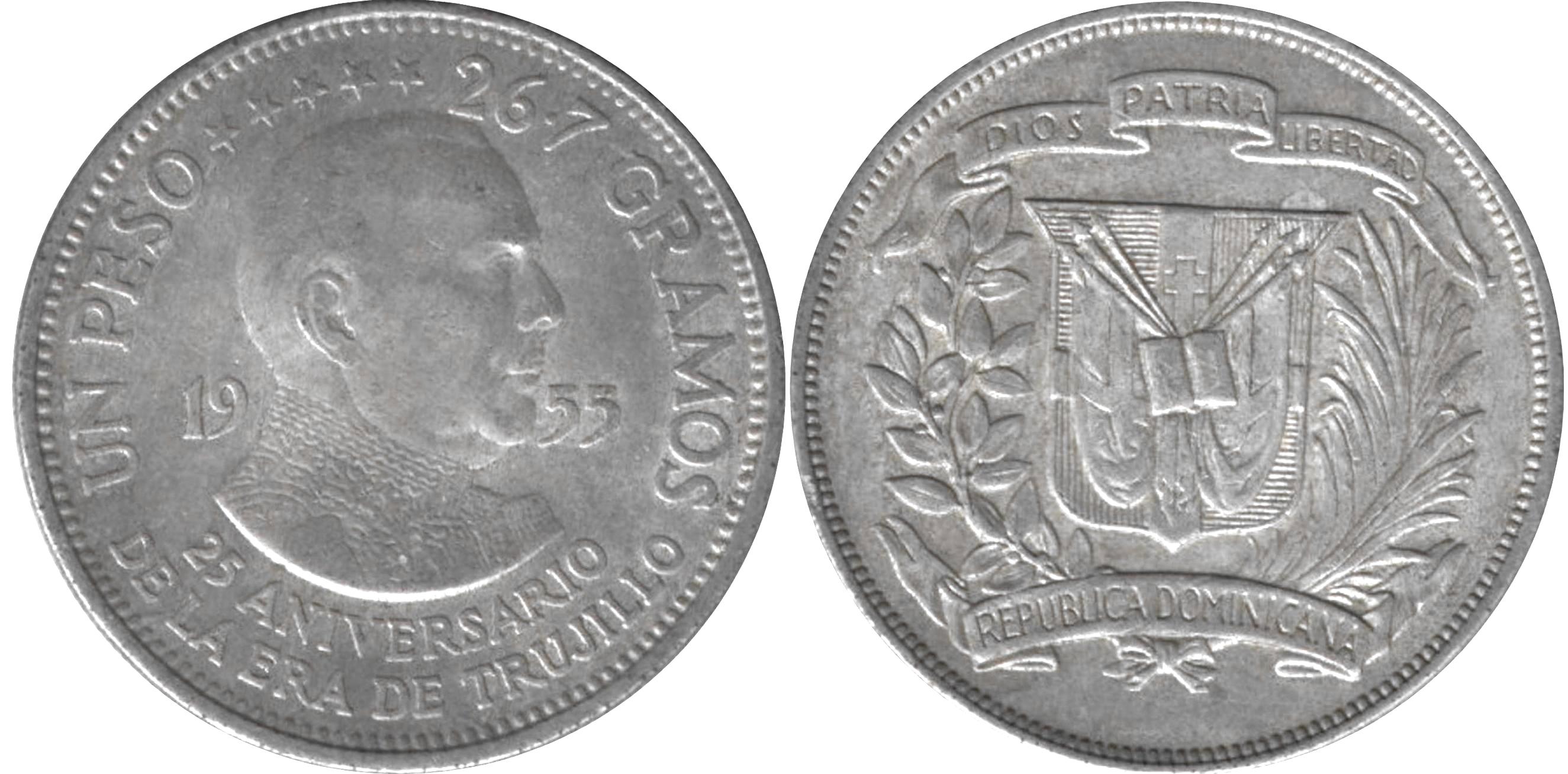
This is a one Peso coin minted in 1955. It was issued to commemorate the 25th anniversary of the era of Trujillo. Gen. Rafael Trujillo was dictator from 1940. He renamed Santo Domingo as Cuidad Trujillo - Trujillo City. He was assassinated in 1961. Weighs 26.7 grams of 0.900 fineness.
ECUADOR
Ecuador was first sighted in 1526 by Francisco Pizarro. Conquest was undertaken by Sebastian do Benaicazar, who founded Quito in 1534. Ecuador was part of the Viceroyalty of New Granada through the 16th and 17th centuries. After previous attempts to attain independence were crushed, Antonio Sucre, the able lieutenant of Bolivar, secured Ecuador freedom in the Battle of Pinchincha, 24 May 1822. it then Joined Venezuela and Colombia in a confederation known as Gran Colombia, and became an independent republic when it left the confederacy In 1830.
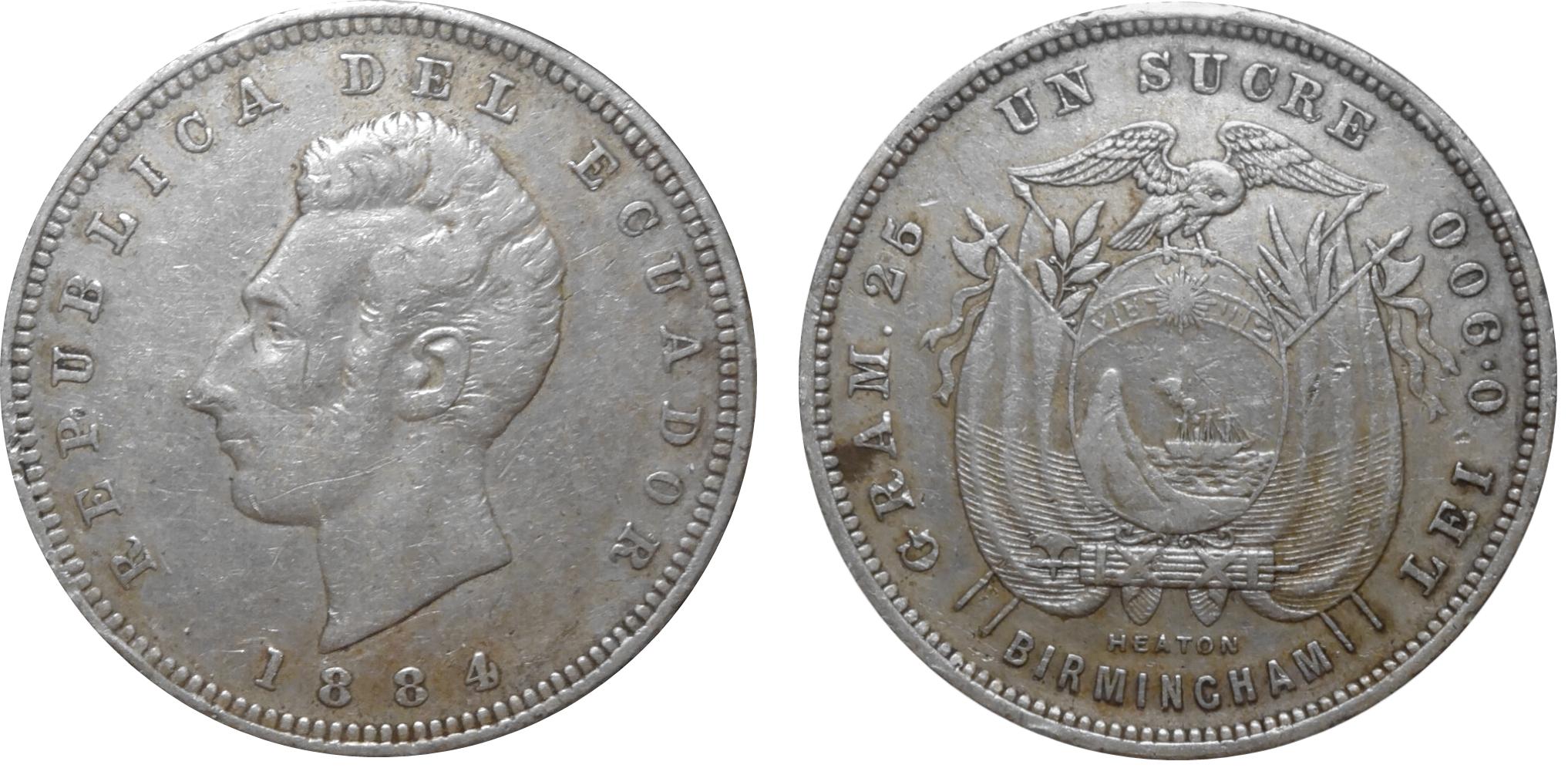
This is an one Sucre piece minted in 1884 at the Heaton Mint in Birmingham England. The overse has Antonio Sucre and the reverse, like many Ibero-American coins, has the nation's arms and coin's weight (25 grams) and the lawful fineness (in this case, 900/1000 fine). Weighs 25 grams of 0.900 fineness.
EGYPT
Egyptian history dates back to about 3000 BC when the empire was established by uniting the upper and lower kingdoms. Following its 'Golden Age' (16th to 13th centuries BC), Egypt was conquered by Persia (525 BC) and Alexander the Great (332 BC). The Ptolemies, descended from one of Alexander's generals, ruled until the suicide of Cleopatra (30 BC) when Egypt became the private domain of the Roman emperor, and subsequently part of the Byzantine world. Various Muslim dynasties ruled Egypt from 641 on, including Ayyubid Sultans to 1250 and Mamluks to 1517, when it was conquered by the Ottoman Turks, interrupted by the occupation of Napoleon (1798-1801). A semi-independent dynasty was founded by Muhammad Ali in 1805 which lasted until 1952. Turkish rule became increasingly casual, permitting Great Britain to inject Its influence by purchasing shares in the Suez Canal. British troops occupied Egypt in 1882, becoming the de facto rulers. On 14 Dec. 1914, Egypt was made a protectorate of Britain. British occupation ended on 28 Feb. 1922, when Egypt became a sovereign, independent kingdom. The monarchy was abolished and a republic proclaimed on 18 June 1953.
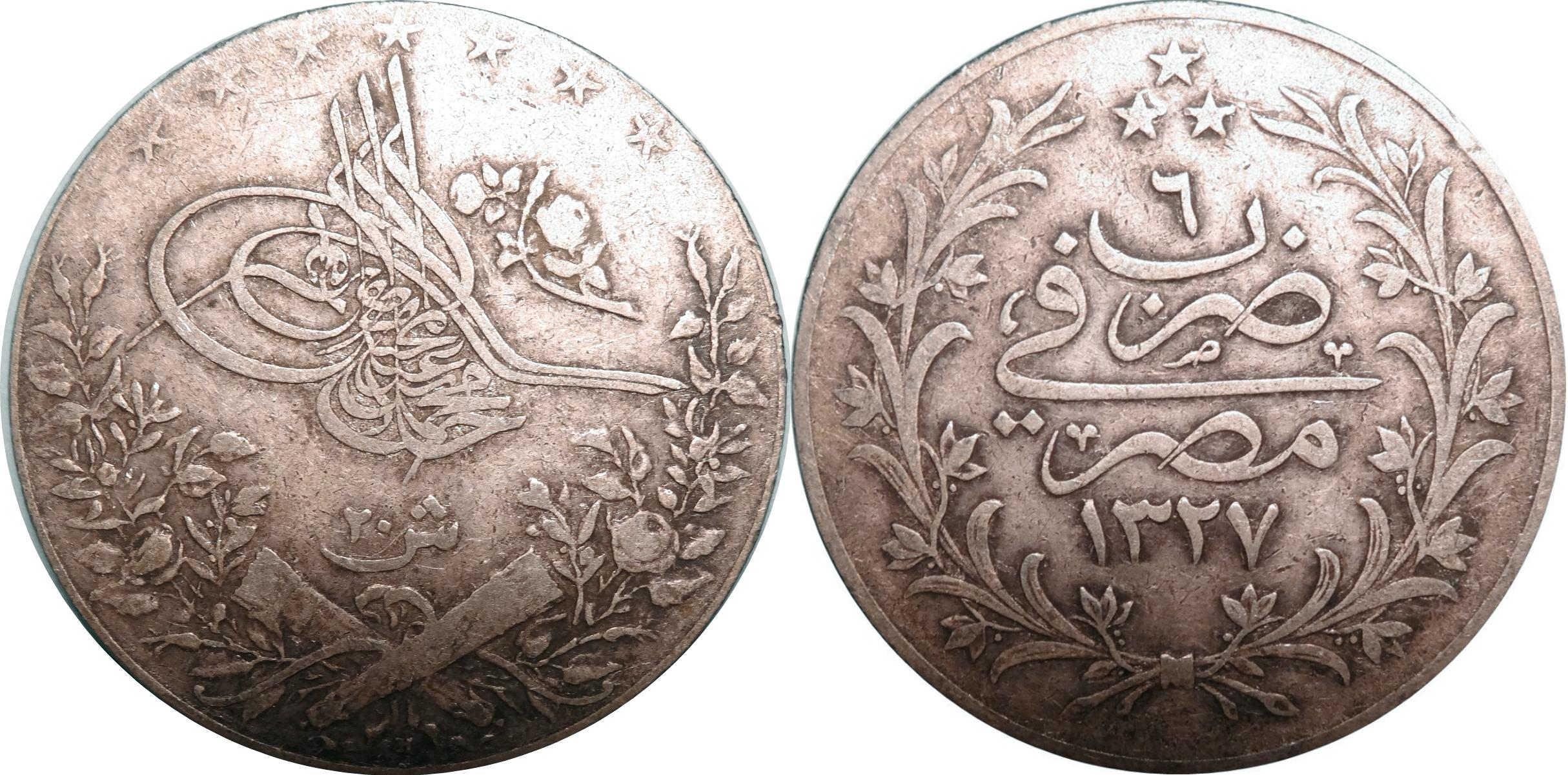
This is a 20 Qirsh issued under the authority of the Ottoman emperor Mohammed V. It is dated year 6 of the regnal date 1327 (1913 AD). The obverse has the toughra of Mohammed VI while the reverse has the regnal year, the accession date and the place of minting by the legend ضرب في - مصر (Struck in Misr). Weighs 28 grams of 0.833 fineness.
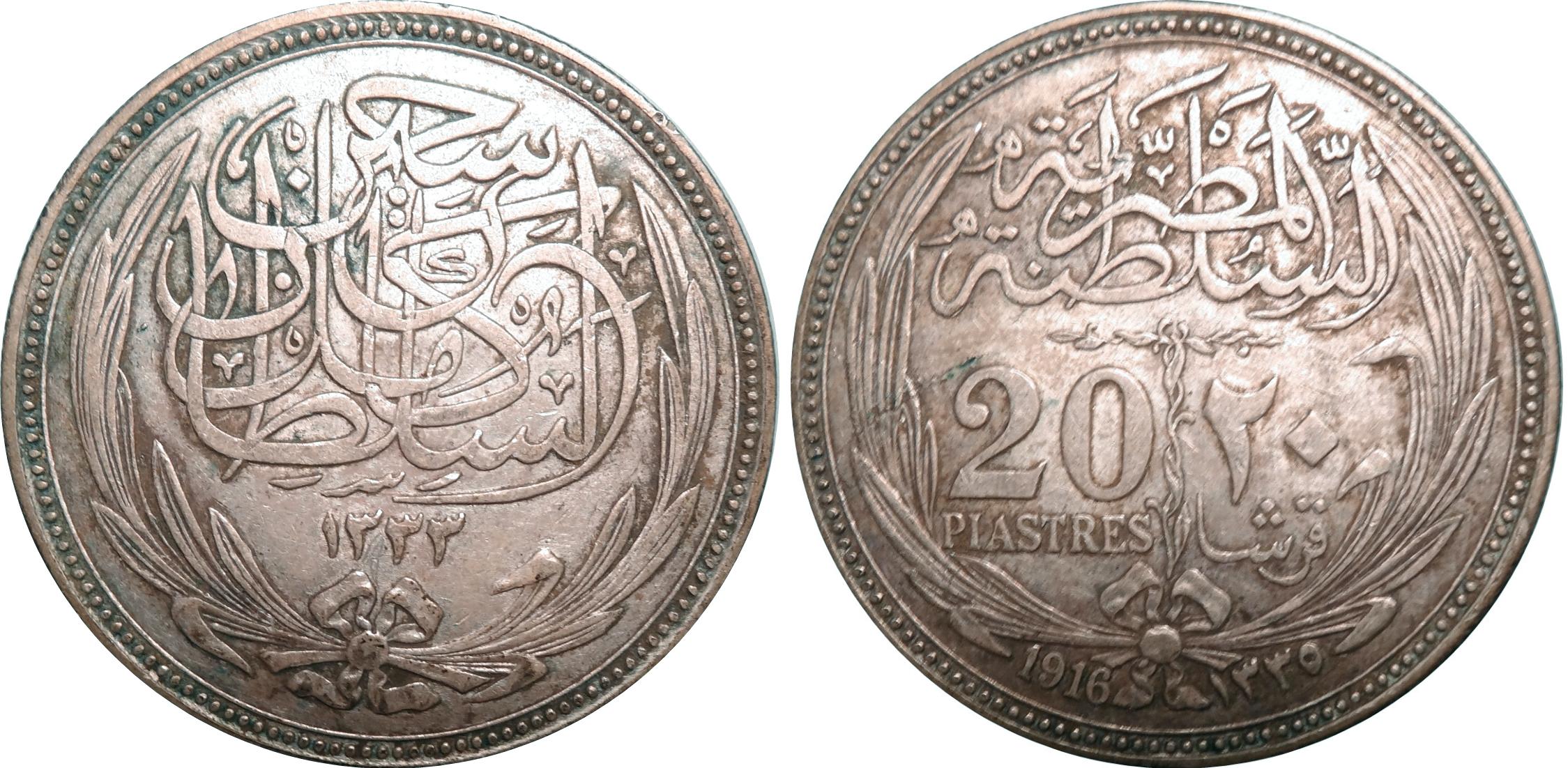
This is a 20 Piastres piece minted by the British occupation authorities in 1916. The obverse has the legend السلطان حسين كامل (Sultan Hussein Kamil). The reverse has the legend السلطانة المصرية (Egyptian Sultanate), the denomination, and the date. Weighs 28 grams of 0.833 fineness.
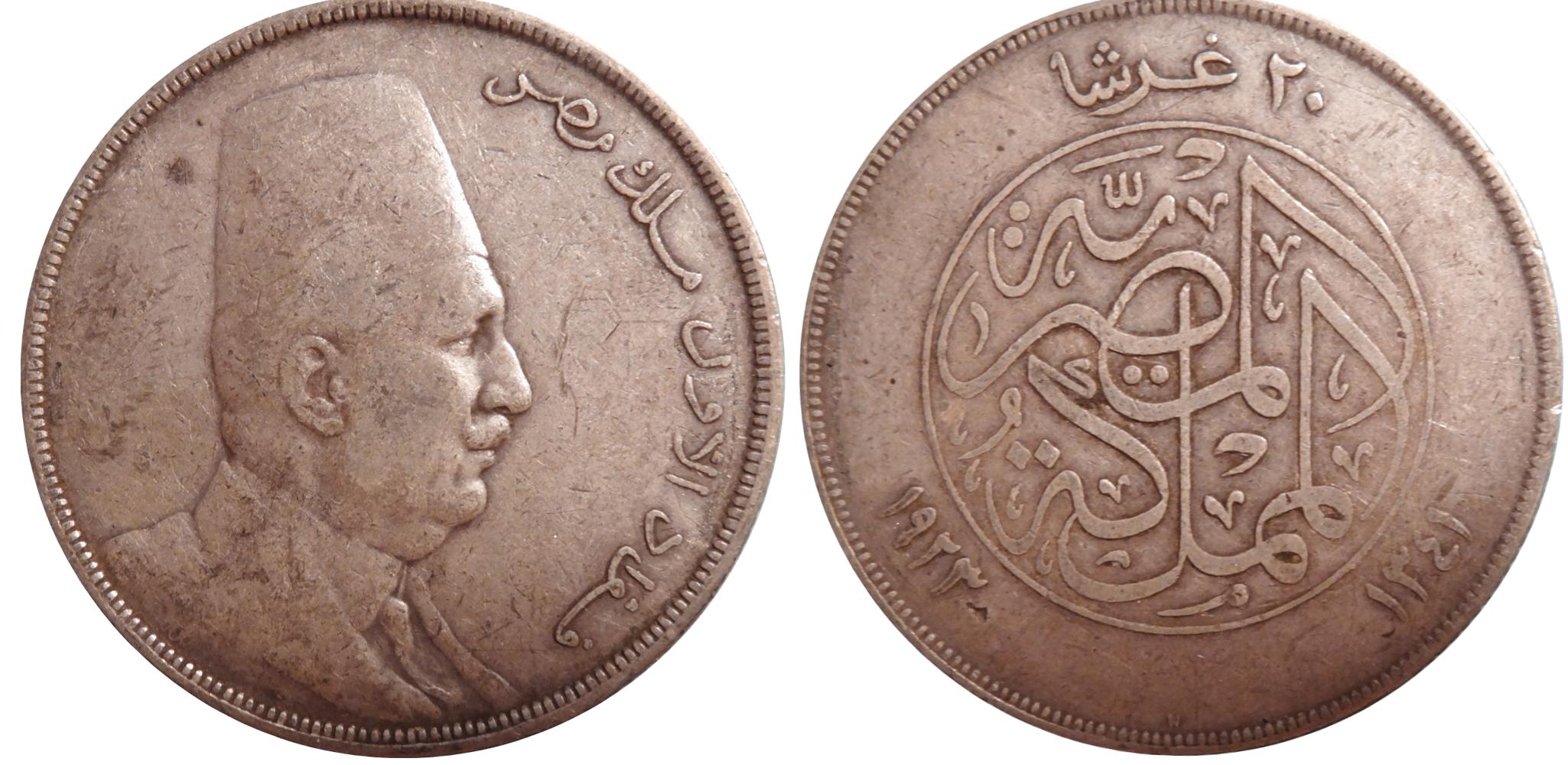
This is a twenty Piaster coin minted in 1923. The obverse features King Fuad with the legend فؤاد الأول ملك مصر (Fuad I, King of Egypt), The reverse has the denomination, the legend (المملكة المصرية (Egyptian Kingdom). Weighs 28 grams of 0.833 fineness.
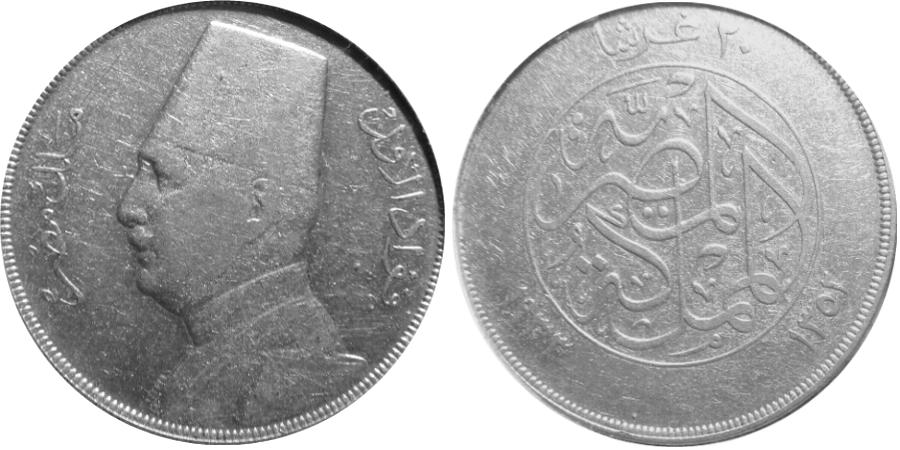
This is a twenty Piaster coin minted in 1933. The obverse features King Fuad with the legend فؤاد الأول ملك مصر (Fuad I, King of Egypt), The reverse has the denomination, the legend (المملكة المصرية (Egyptian Kingdom). Weighs 28 grams of 0.833 fineness.
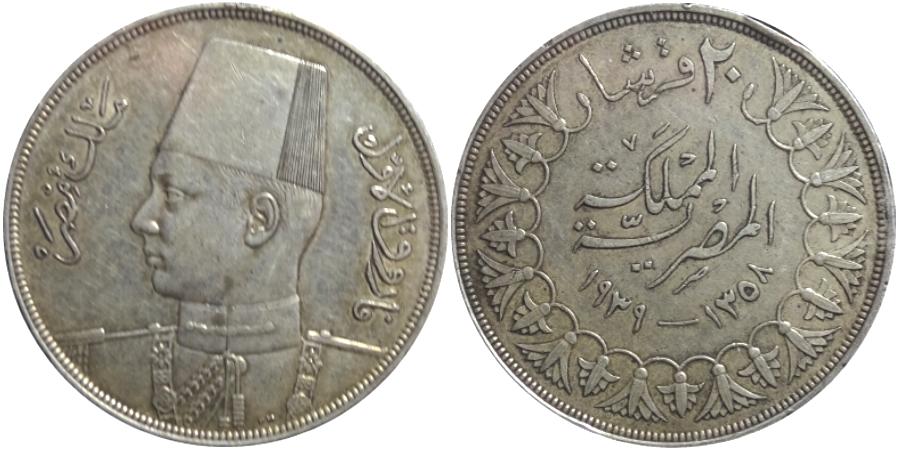
This is a twenty Piaster coin minted in 1939. The obverse features King Farouk with the legend ملك مصر فاروق الأوّل (Farouk I, King of Egypt), The reverse has the denomination, the legend (المملكة المصرية (Egyptian Kingdom). Weighs 28 grams of 0.833 fineness.
EL SALVADOR
The first Spanish attempt to subjugate the area was undertaken in 1523 by Pedro de Alvarado, Cortes' lieutenant. He was forced to retreat by Indian forces, but returned in 1525 and succeeded in bringing the region under control of the Captaincy General of Guatemala. In 1821 El Salvador and the other Central American provinces jointly declared independence from Spain. In 1823, the Republic of Central America was formed by the five Central American states; this federation dissolved in 1839. El Salvador then became an independent republic in 1841. During the 1980's El Salvador went through a 12 year Civil War that ended in 1992 with the signing of a United Nations-sponsored peace accord. Free elections, with full participation of all political parties, were held in 1994, 1997 and 1999.
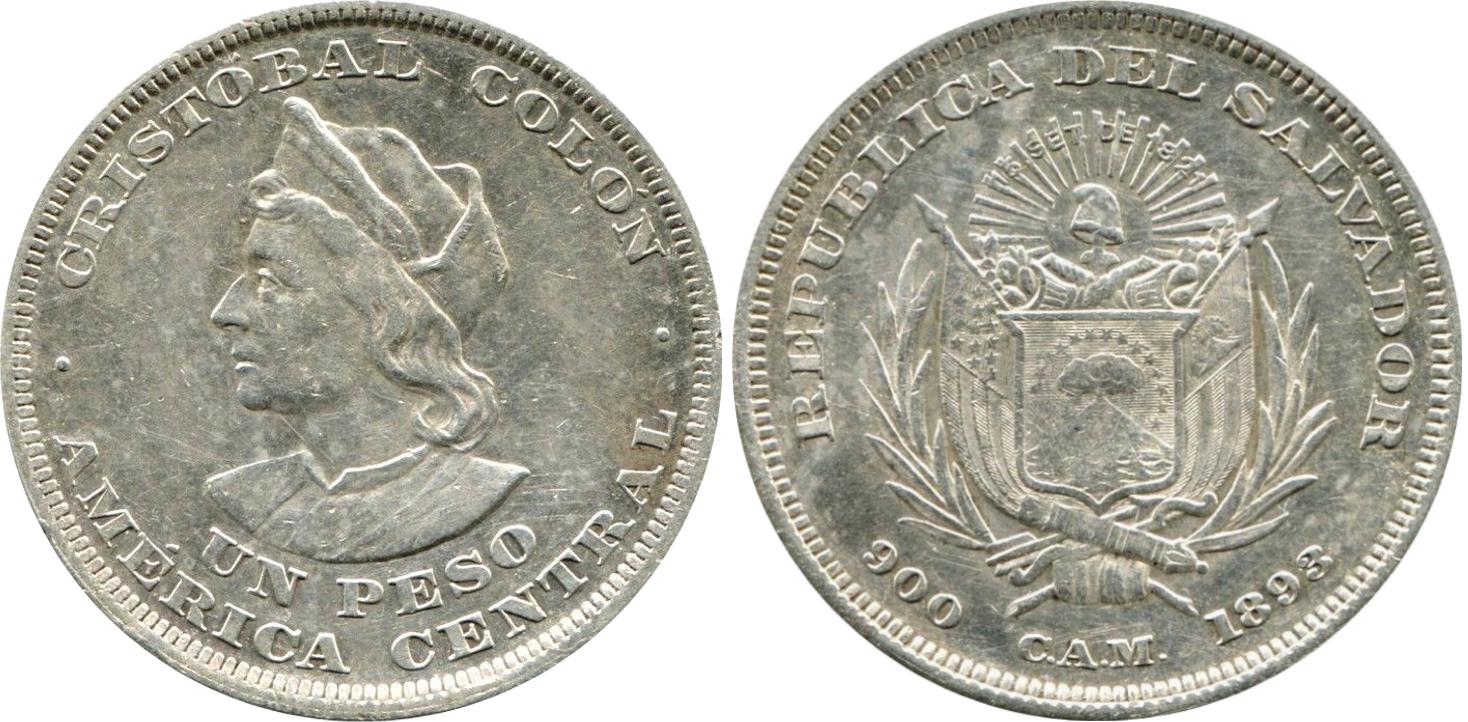
This is a one Peso coin minted in 1893 at the Central American Mint in San Salvador. The obverse has the bust of Cristobol Colon (Christopher Columbus), discover of the Americas. The reverse has the national arms the fineness, the mintmark C.A.M., and the date. Weighs 25 grams of 0.900 fineness.
ERITREA
The State of Eritrea is a former Ethiopian province fronting on the Red Sea. It was an Italian colony from 1889 until its incorporation Into Italian East Africa in 1936. it was under the British Military Administration from 1941 to 15 Sept. 1952, when the United Nations designated it an autonomous unit within the federation of Ethiopia and Eritrea. On 14 Nov. 1962, it was annexed by Ethiopia. In 1991 the Eritrean Peoples Liberation Front extended its control over the entire territory of Eritrea. Following 2 years of provisional government, Eritrea held a referendum on independence in May 1993. Overwhelming popular approval led to the proclamation of an independent Republic of Eritrea on 24 May 1993.
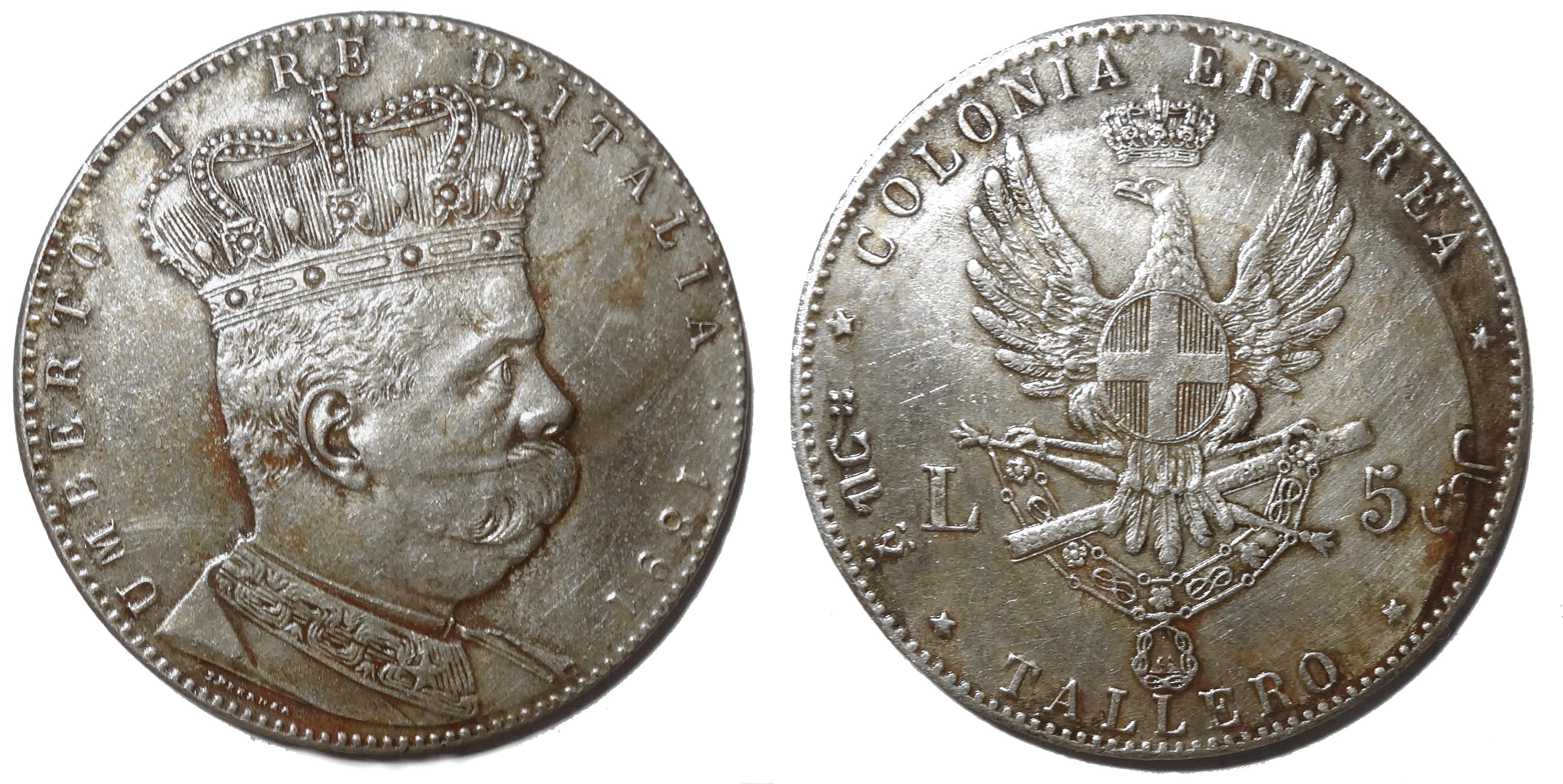
This is a 1 Tallero (Italian for Thaler) minted 1891. The Tallero was equal to 5 Lire Italian and is made to same specification. The obverse has King Umberto I with the legend UMBERTO 1 RE DE ITALIA The reverse interestingly has the denomination i both Amharic and Arabic as well as COLONIA ERITREA TALLERO. Weighs 28.13 grams of 0.800 fineness.
This is a 1 Tallero (Italian for Thaler) minted 1918. The obverse has a female similar to Maria Theresia with the legend REGNUM ITALICOM * 1918. The reverse has the Italian arms with the legend AD.NEGOT.ERYTHR.COMMOD.ARG.SIGN (interestingly this means "Silver for the facilitation of commerce in Eritrea". Weighs 28.07 grams of 0.835 fineness.
ETHIOPIA
Ethiopia is an ancient kingdom that was known as Axum. It is the oldest independent country on the continent. Legend claims that Menelik I, the son born to Solomon, King of Israel, by the Queen of Sheba, settled in Axum in North Ethiopia to establish the dynasty, which reigned with only brief interruptions until 1974. Modern Ethiopian history began with the reign of Emperor Menelik II (1889-1913) under whose guidance the country emerged from medieval isolation. Progress continued throughout the reigns of Meneiik's daughter, Empress Zauditu, and her successor Emperor Haile Selassie I who was coronated in 1930. Menelik II coins were struck during this period with dates frozen. Emperor Haile Selassie brought Ethiopia to the world's attention after the Italian invasion in 1936 when he pled his case before the League of Nations. Italy conquered it and incorporated it to Italian East Africa along with the colonies of Eritrea and Italian Somaliland. British troops helped to drive the Italians out. Haile was reinstalled on the throne until he was deposed by a military coup in 1974. Haile was the 225th successor in the Solomonic line in Ethiopia.
This is a 1 Birr coin from 1889 EE (Ethiopian Era) (1897). It was
struck at the Paris mint. The obverse has Menelik II with the Amharic legend
ዳግማዊ፡
FINLAND
The Finns, who probably originated in the Volga region of Russia, took Finland from
the Lapps late in the 7th century. They were conquered in the 12th century by Eric
IX of Sweden, and brought into contact with Western Christendom. In 1809, Sweden
was conquered by Alexander I of Russia, and the peace terms gave Finland to Russia
which became a grand duchy, with autonomy, within the Russian Empire until 6 Dec.
1917, when, shortly after the Bolshevik revolution it declared its independence.
After a brief but bitter civil war between the Russian communists and Finnish nationalists
in which the Whites (nationalists) were victorious, a new constitution was adopted,
and on 6 Dec. 1917 Finland was established as a republic. In 1939 Soviet troops
attacked Finland over disputed territorial concessions which were later granted
in the peace treaty of 1940. When the Germans invaded Russia, Finland became involved
and in the Armistice of 1944 lost the Petsamo area to the Soviets.
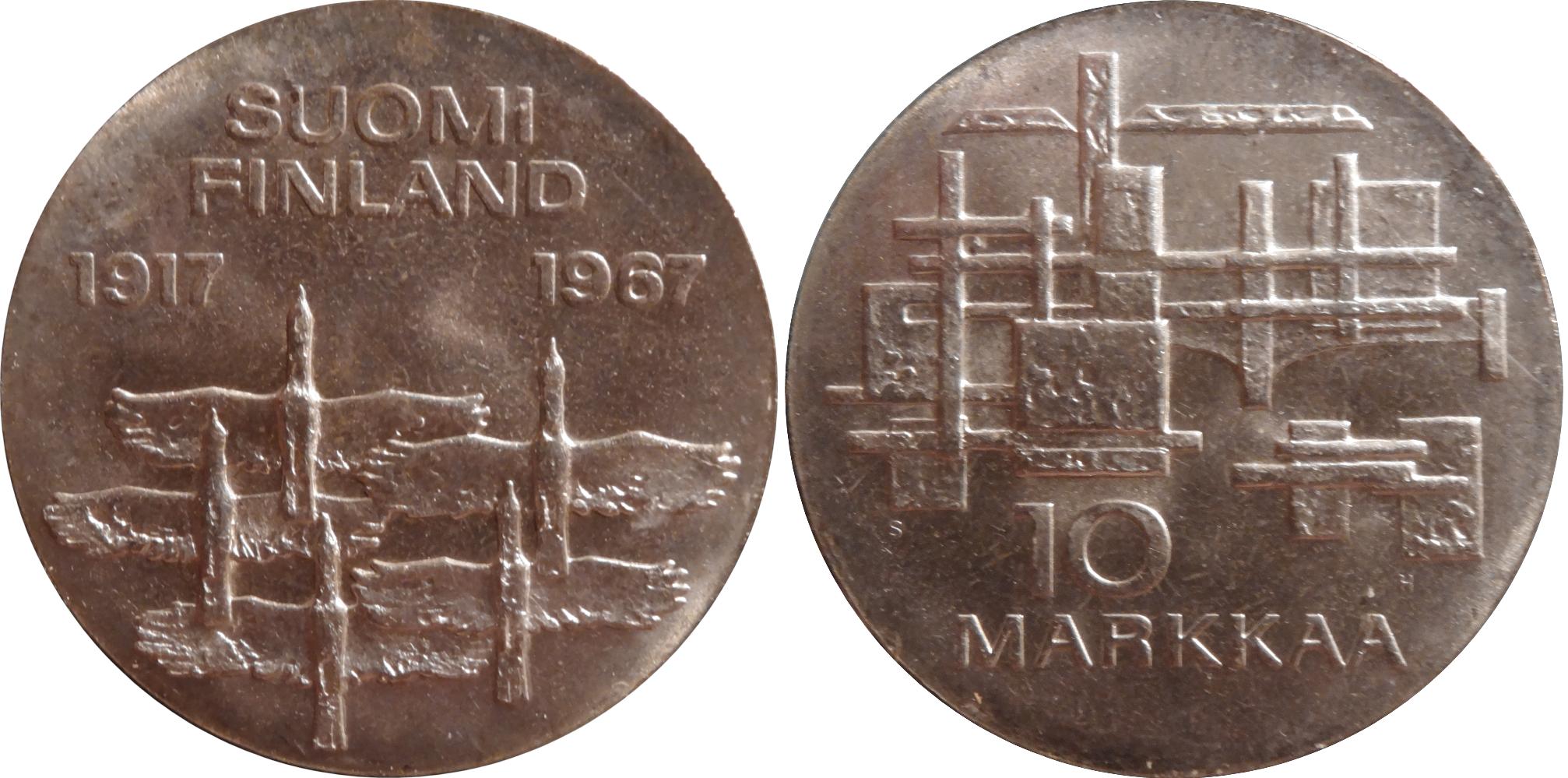
This is a ten Markka coin minted in 1967 to commemorate the 50th year of independence. Weighs 23.75 grams of 0.900 fineness.
FRANCE
France, the Gaul of ancient times, emerged from the Renaissance as a modern centralized national state which reached its zenith during the reign of Louis XIV (1643-1715) when it became an absolute monarchy and the foremost power in Europe. Although his reign marks the golden age of French culture, the domestic abuses and extravagance of Louis XIV plunged France into a series of costly wars. This, along with a system of special privileges granted the nobility and other favored groups, weakened the monarchy and brought France to bankruptcy. This laid the way for the French Revolution of 1789 that shook Europe and affected the whole world.
The monarchy was abolished and the First Republic formed in 1793.The new government fell in 1799 to a coup led by Napoleon Bonaparte who, after declaring himself First Consul for life, in 1804 had himself proclaimed Emperor of France and King of Italy. Napoleon's military victories made him master of much of Europe, but his disastrous Russian campaign of 1812 initiated a series of defeats that led to his abdication in 1814 and exile to the island of Elba. The monarchy was briefly restored under Louis XVIII. Napoleon returned to France in March 1815, but his efforts to uphold his power were totally crushed at the battle of Waterloo. He was exiled to the island of St. Helena where he died in 1821. The monarchy under Louis XVIII was again restored in 1815, but the ultra reactionary regime of Charles X (1824-30) was overthrown by a liberal revolution and Louis Philippe of Orleans replaced him as monarch. The monarchy was ousted by the Revolution of 1848 and the Second Republic proclaimed. Louis Napoleon Bonaparte (nephew of Napoleon I) was elected president of the Second Republic. He was proclaimed emperor in 1852. As Napoleon III, he gave France two decades of prosperity under a stable, autocratic regime, but led it to defeat in the Franco-Prussian War of 1870, after which the Third Republic was established. The Third Republic endured until 1940 and the capitulation of France to the swiftly maneuvering German forces. Marshal Philippe Petain formed a puppet government that sued for peace and ruled unoccupied France until 1942 from Vichy. Meanwhile, General Charles de Gaulle escaped to London where he formed a wartime government in exile and the Free French army. De Gaulle's provisional exile government was officially recognized by the Allies after the liberation of Pans in 1944, and De Gaulle, who had been serving as head of the provisional government, tacitly maintained that position. In October 1945, the people overwhelmingly rejected a return to the prewar government, thus paving the way for the formation of the Fourth Republic in 1947 just after the dismissal of De Gaulle, at grips with a coalition of rival parties, the Communists especially. In actual operation, the Fourth Republic was remarkably like the Third, with the National Assembly the focus of power causing a constant governmental instability. The later years of the Fourth Republic were marked by a burst of industrial expansion unmatched in modern French history. The growth rate, however, was marred by a two colonial wars, nagging inflationary trend that weakened the franc and undermined the betterment of the peoples buying power. This and the Algerian conflict led to the recall of De Gaulle to power, the adoption of a new constitution vesting strong powers in the executive, and the establishment in 1959 of the current Fifth Republic.
This is a one Ecu coin minted in 1704 at Paris (mintmark A). The obverse has King Louis XIV with the legend .LUD. XIIII. D. G. FR. ET. NAV. REX. The reverse has has the crowned double L’s in cruciform, fleur-de-lis in angles, arms of France in center the legend SIT NOMEN DOMINI BENEDICTVM. The coin was struck over an earlier piece dated 169? and 170a. One can see details of the earlier strikes. Weighs 29.4 grams of 0.917 fineness.
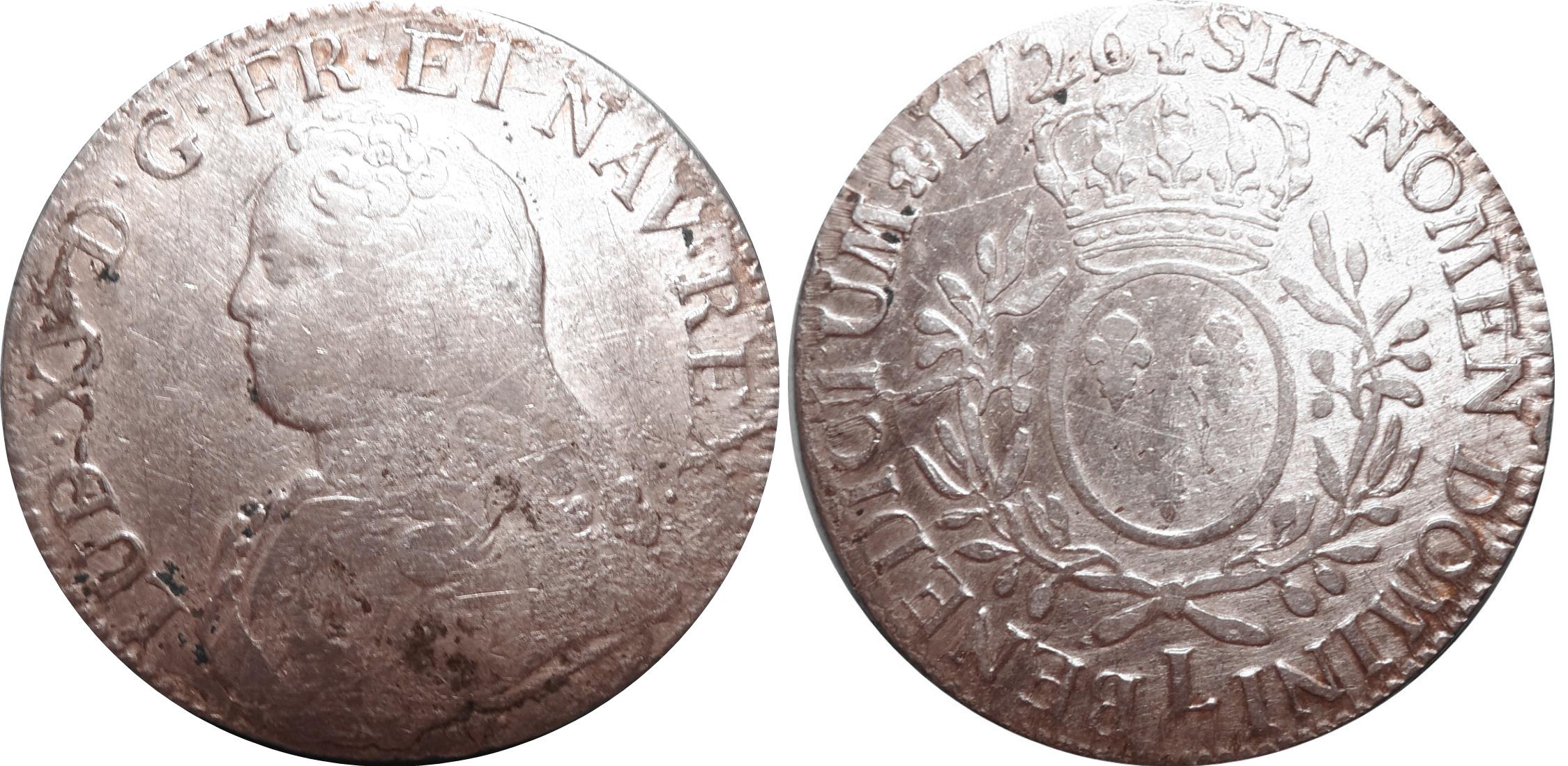
This is a 1728 Ecu minted in Bayonne (mintmark L) under King Louis XV. Weighs 29.4 grams of 0.917 fineness.
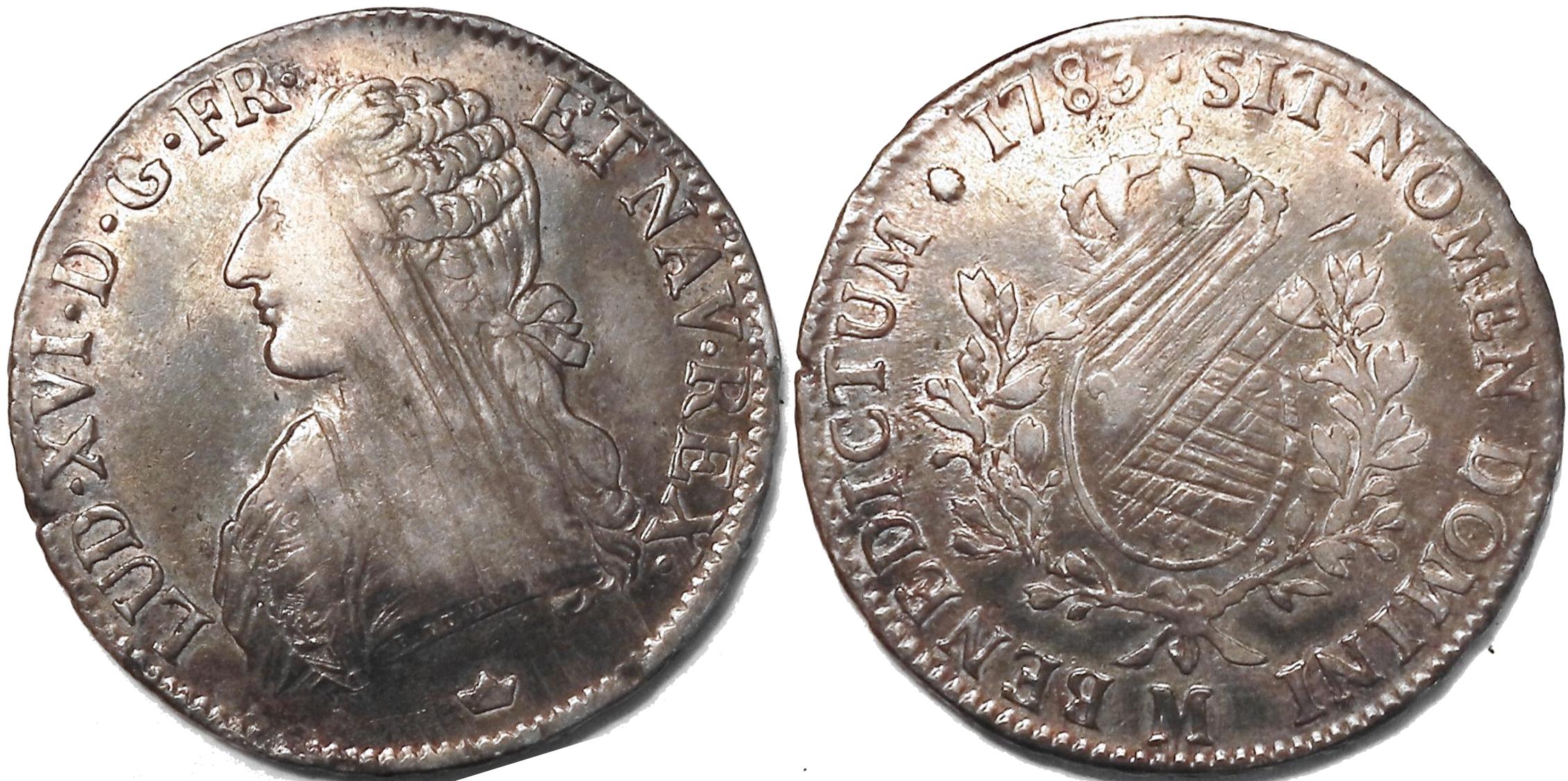
This is a 1783 Ecu minted in Toulouse (mintmark M) under King Louis XVI. The coin has adjustment marks on both sides. Weighs 29.4 grams of 0.917 fineness.
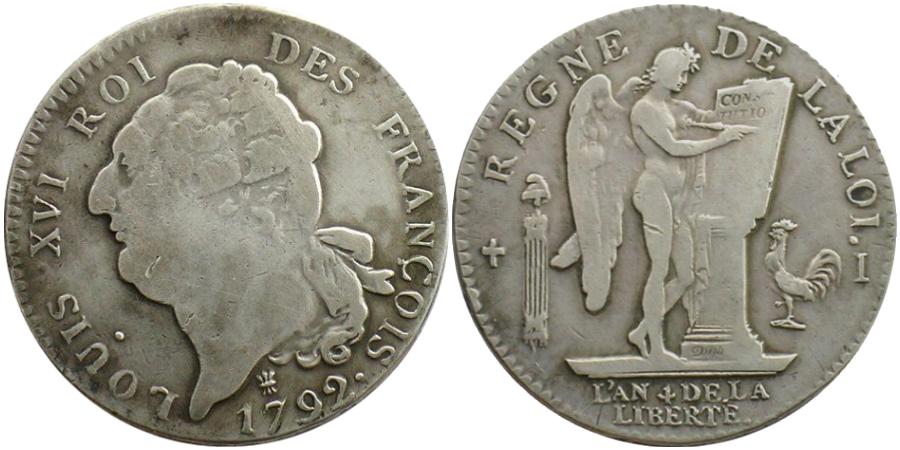
This is a 1792 Ecu minted in Limoges (mintmark I) under King Louis XVI as a Constitutional Ecu issued before the trial and execution of the King in 1793. The obverse portrays a bust of King Louis XVI with the lyre privy mark and date below the bust encircled by the royal legend LOUIS XVI ROI DES FRANÇOIS. The reverse has a standing Genius writing the constitution flanked by the cross privy mark of the engraver Jean Baptiste Daniel la Vallee, the fasces, the Gallic cock, and the mintmark. The legend REGNE DE LA LOI (Rule of the Law) is at the top with the date L'AN 4 DE LA LIBERTE. The rim is ironically inscribed DOMINE SALVUM FAC REGEM (Lord Save the King). Weighs 29.4 grams of 0.917 fineness.
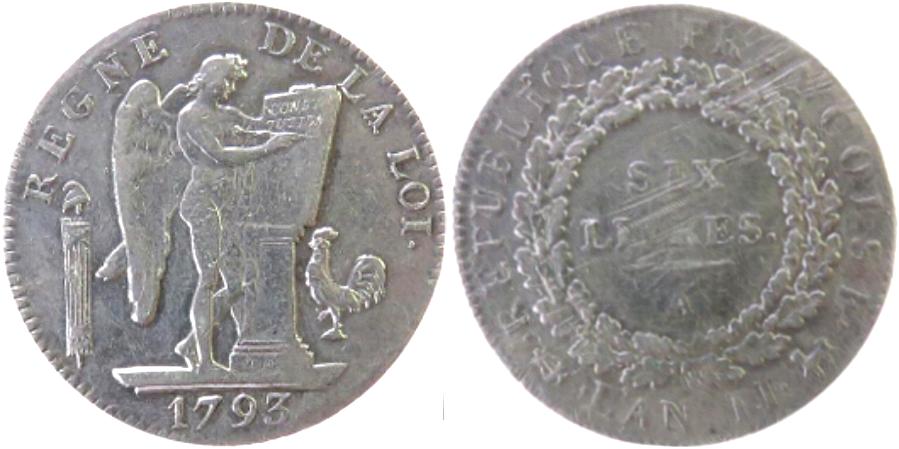
This is a 1793 Six Livres (Ecu) minted in Paris (mintmark A) under the revolutionary French Republic. The obverse has a standing Genius writing the constitution flanked the fasces and the Gallic cock. The legend REGNE DE LA LOI (Rule of the Law) is at the top with the date 1793 at the bottom. The reverse the legend REPUBLIQUE FRANÇOISE encircling a wreath with the denomination SIX LIVRES in the center. Below the wreath is the revolutionary date L'AN II flanked by the lyre for the engraver Francois Bernier and lion privy marks. The rim is inscribed LIBERTE, Phrygian cap, leaves, ÉGALITÉ, level, leaves. Weighs 29.4 grams of 0.917 fineness.
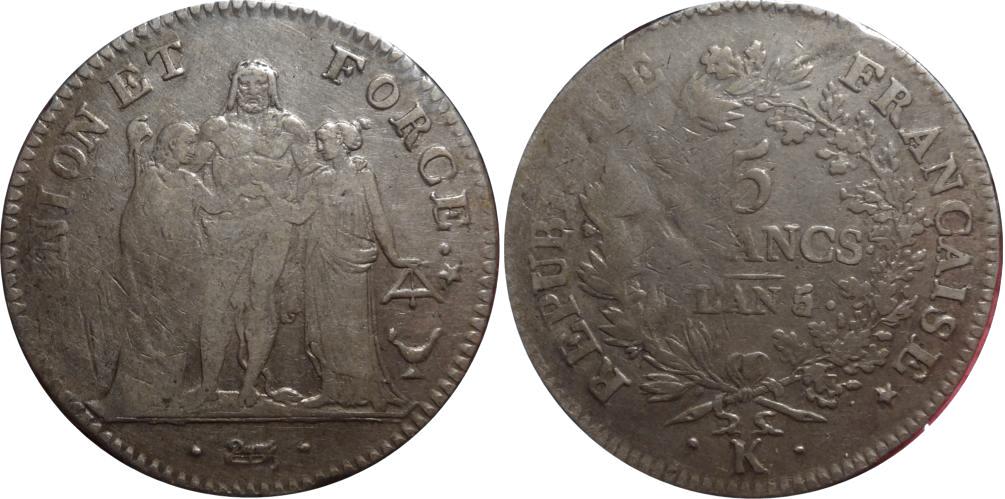
This five Francs piece was minted in 1795 in Bordeaux (mintmark K). This was issued under the Directorate which misgoverned France after the abolishing of the monarchy. The coins were dated using the revolutionary calendar (this being L'An 5, or fifth year). The edge reads GARANTIE NATIONALE. Weighs 25 grams of 0.900 fineness.
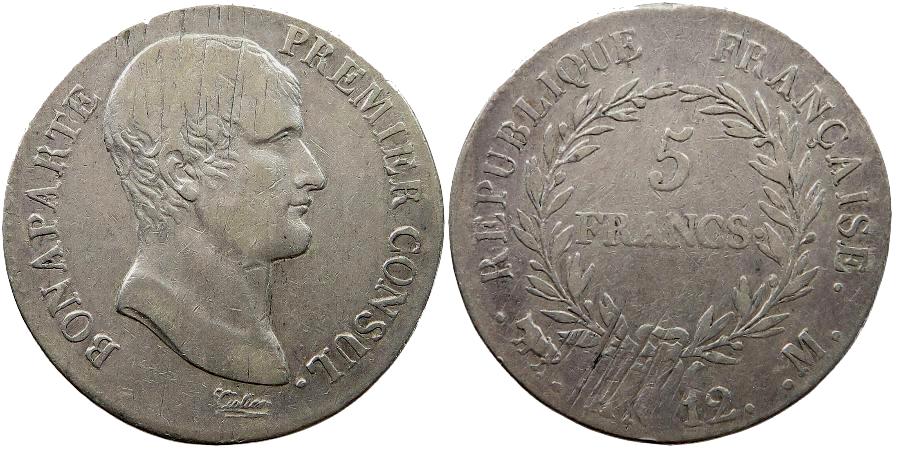
This is a five Francs piece minted in 1803 in Toulouse (mintmark M). Featured is Napoleon Bonaparte First Consul. Napoleon orchestrated a coup in November 1799 and became First Consul of the Republic. He became the first Emperor of the French in 1804. The reverse is inscribed RÉPUBLIQUE FRANÇAISE encircling a wreath with the denomination inside. Below the wreath is the revolutionary date L'An 12 flanked by the privy mark and the mintmark. The edge is lettered DIEU PROTEGE LA FRANCE. Weighs 25 grams of 0.900
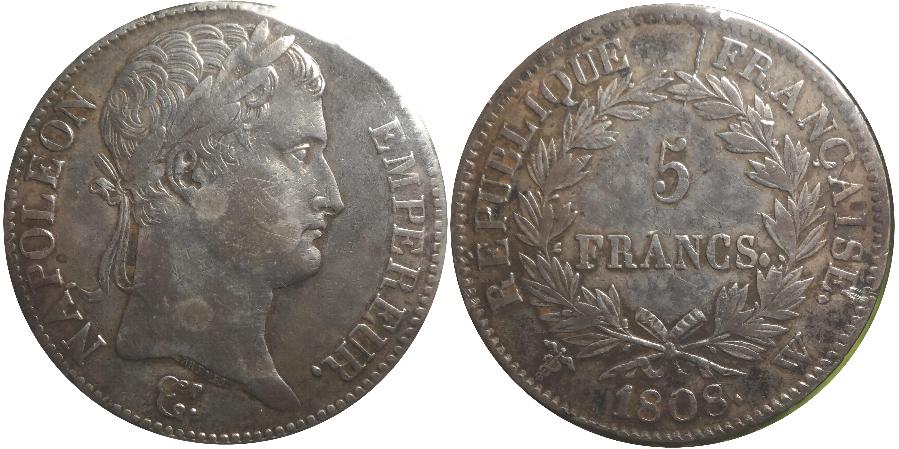
This is a five Francs piece minted in 1808 in Lille (mintmark W). Featured is Emperor Napoleon Bonaparte. The reverse is still inscribed RÉPUBLIQUE FRANÇAISE. The edge is lettered DIEU PROTEGE LA FRANCE. Weighs 25 grams of 0.900
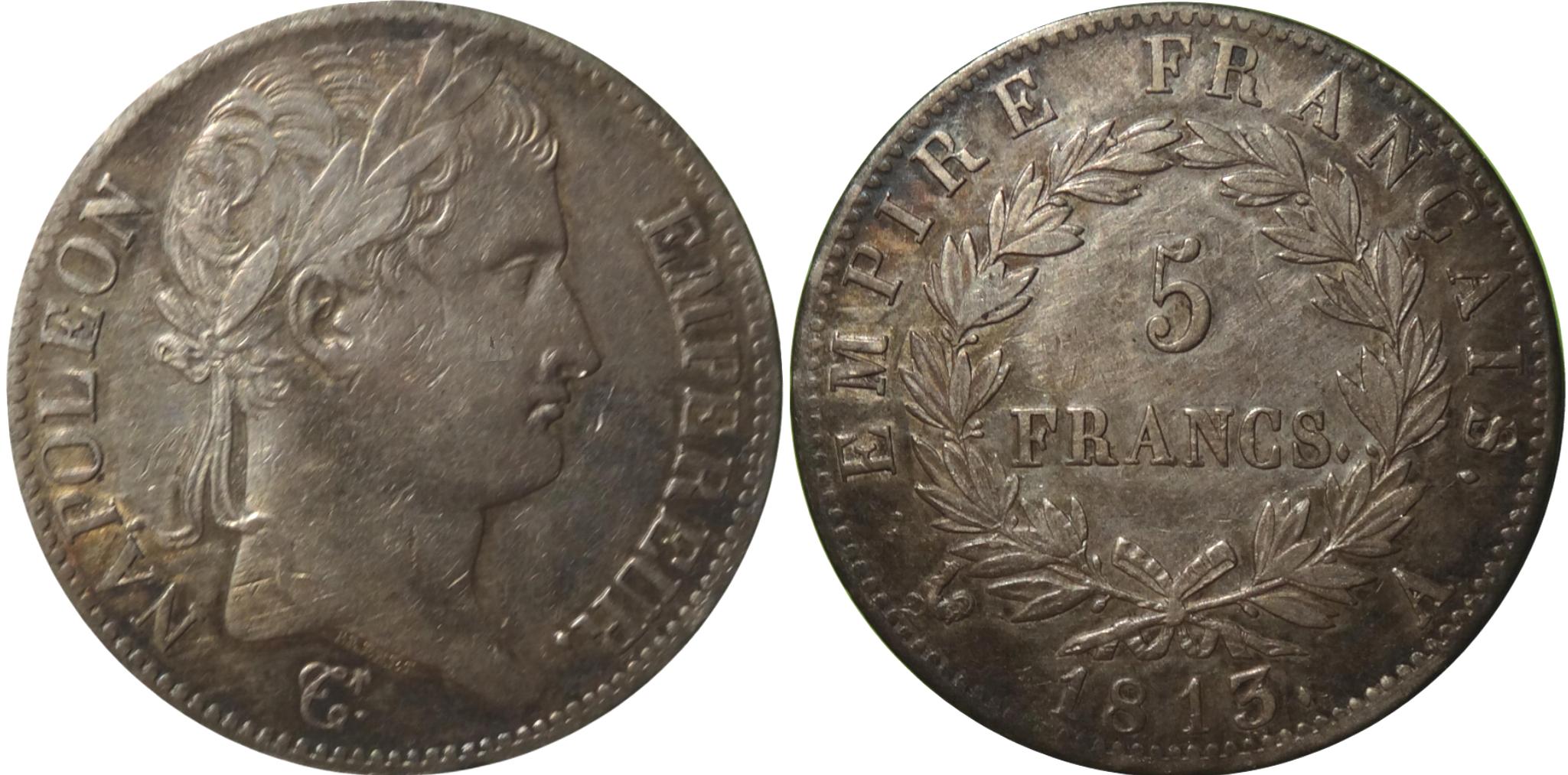
This is a five Francs piece minted in 1813 in Paris (mintmark A). Featured is Emperor Napoleon Bonaparte. The reverse is now inscribed EMPIRE FRANÇAIS. The edge is lettered DIEU PROTEGE LA FRANCE. Weighs 25 grams of 0.900 fin fineness.
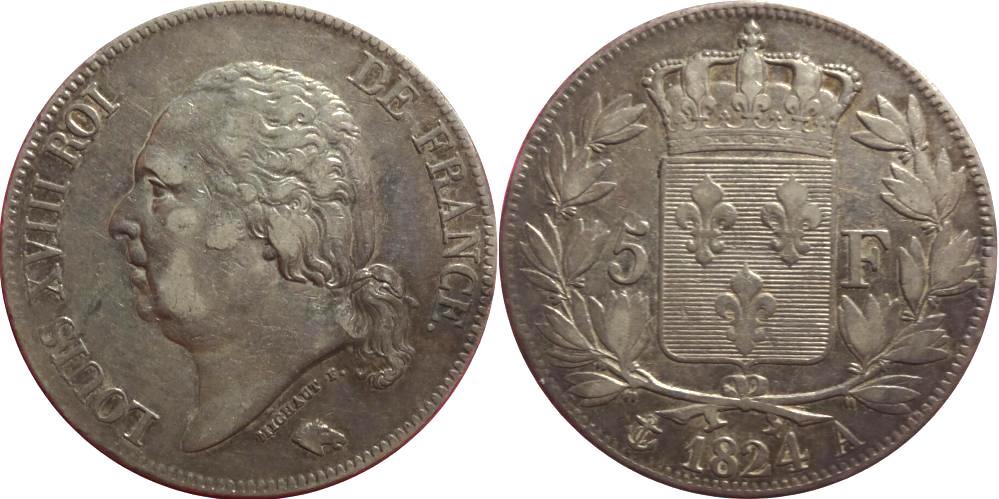
This is a five Francs piece minted in Paris (mintmark A) in 1824. The obverse has King Louis XVIII. Weighs 25 grams of 0.900
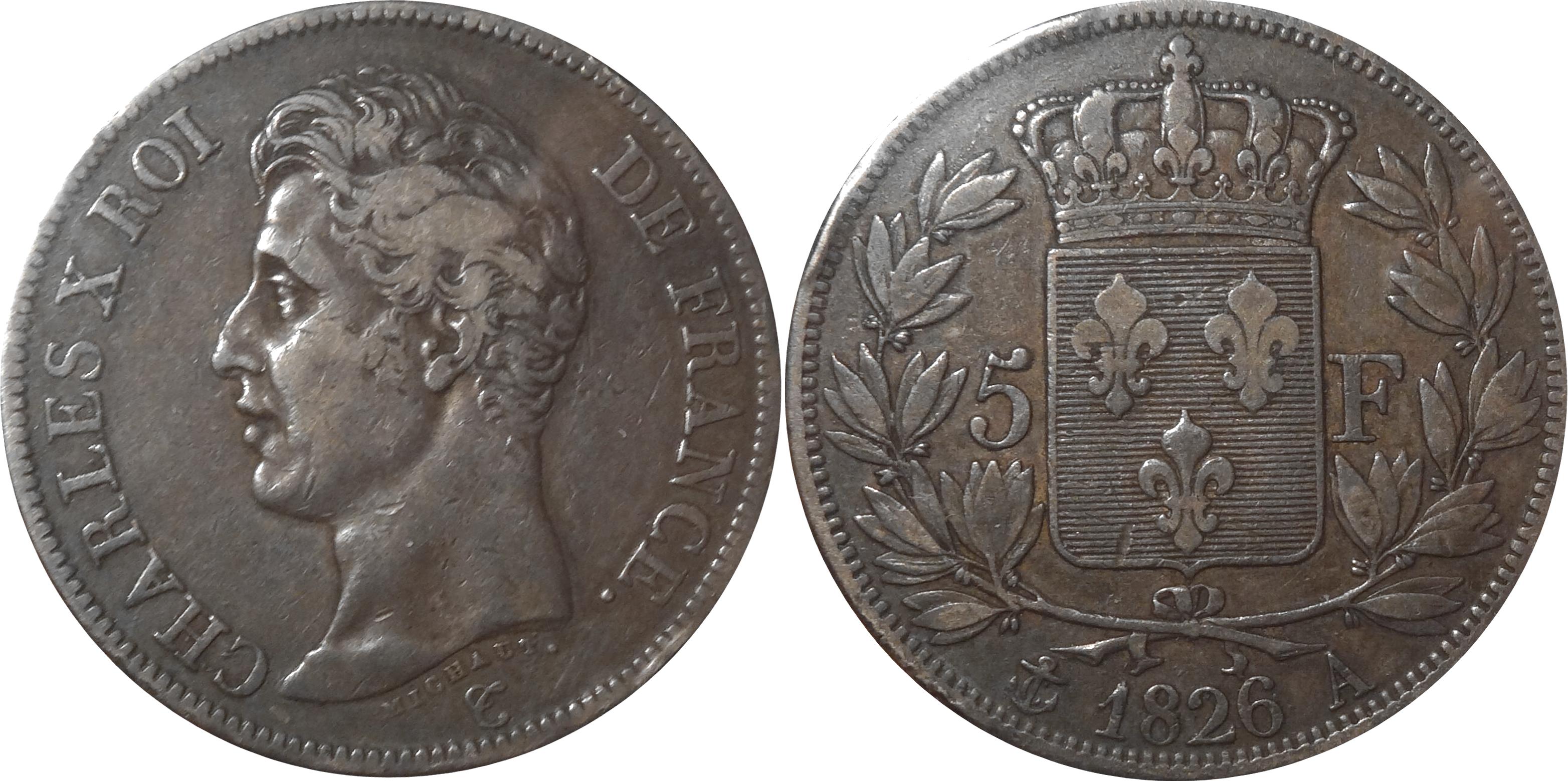
This is a five Francs piece minted in Paris (mintmark A) in 1826. The obverse has King Charles X. Weighs 25 grams of 0.900 fineness.
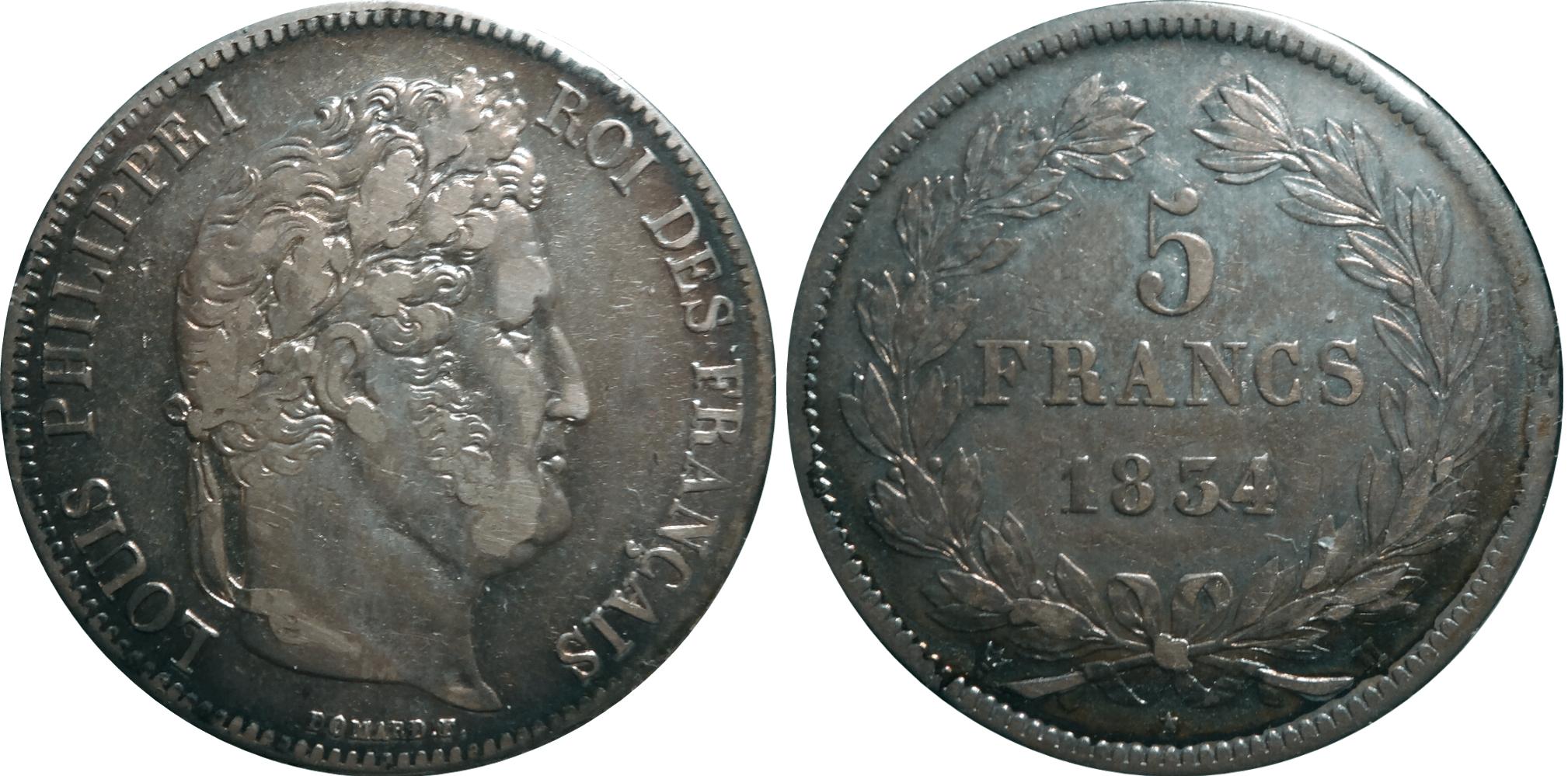
This is a five Francs piece minted in La Rochelle (mintmark H) in 1834. The obverse has King Louis Philippe I. Weighs 25 grams of 0.900 fineness.
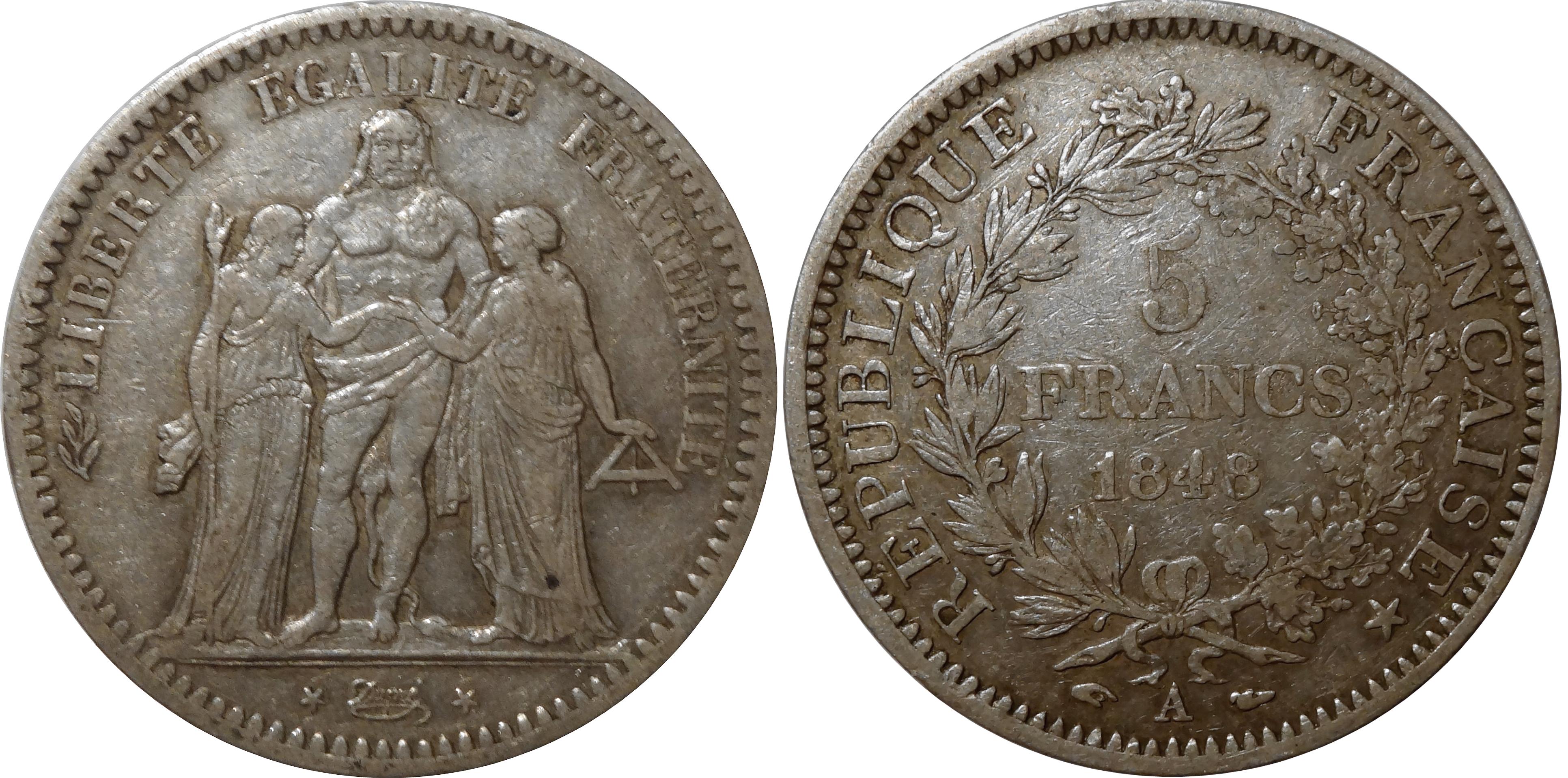
This is a five Francs piece minted in Paris (mintmark A) in 1848. The obverse of this republic issue has Hercules flanked by Muses. This type was first issued during the Directorate (1795) and was used on ten and fifty Francs pieces of the Fifth Republic. Weighs 25 grams of 0.900 fineness.
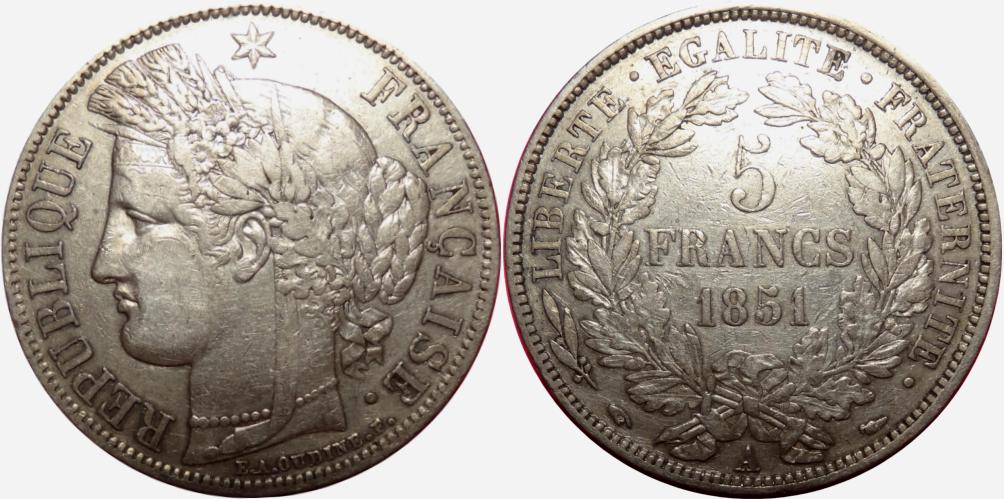
This is a five Francs piece minted in Paris (mintmark A) in 1851. The obverse has Ceres. Weighs 25 grams of 0.900 fineness.
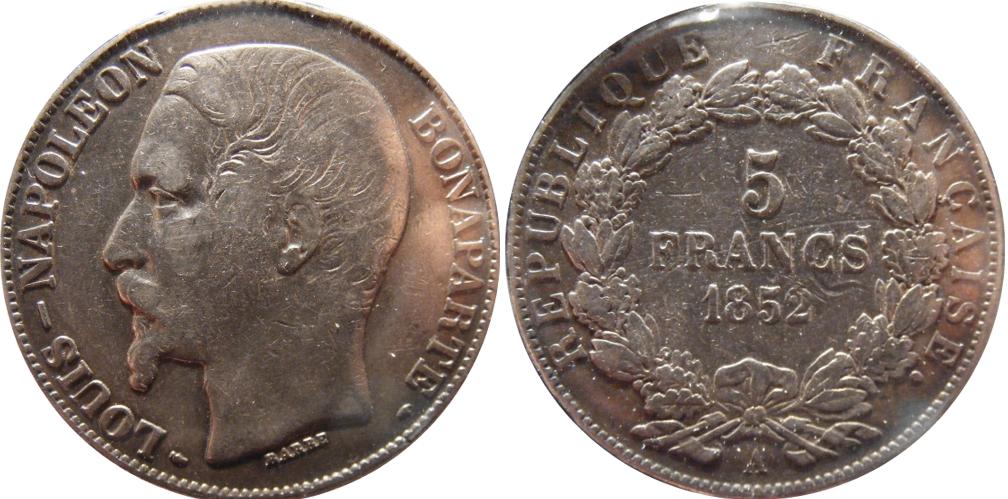
This is a five Francs piece minted in Paris (mintmark A) in 1852. The obverse has Louis-Napoleon Bonaparte as President of the Republic. Weighs 25 grams of 0.900 fineness.
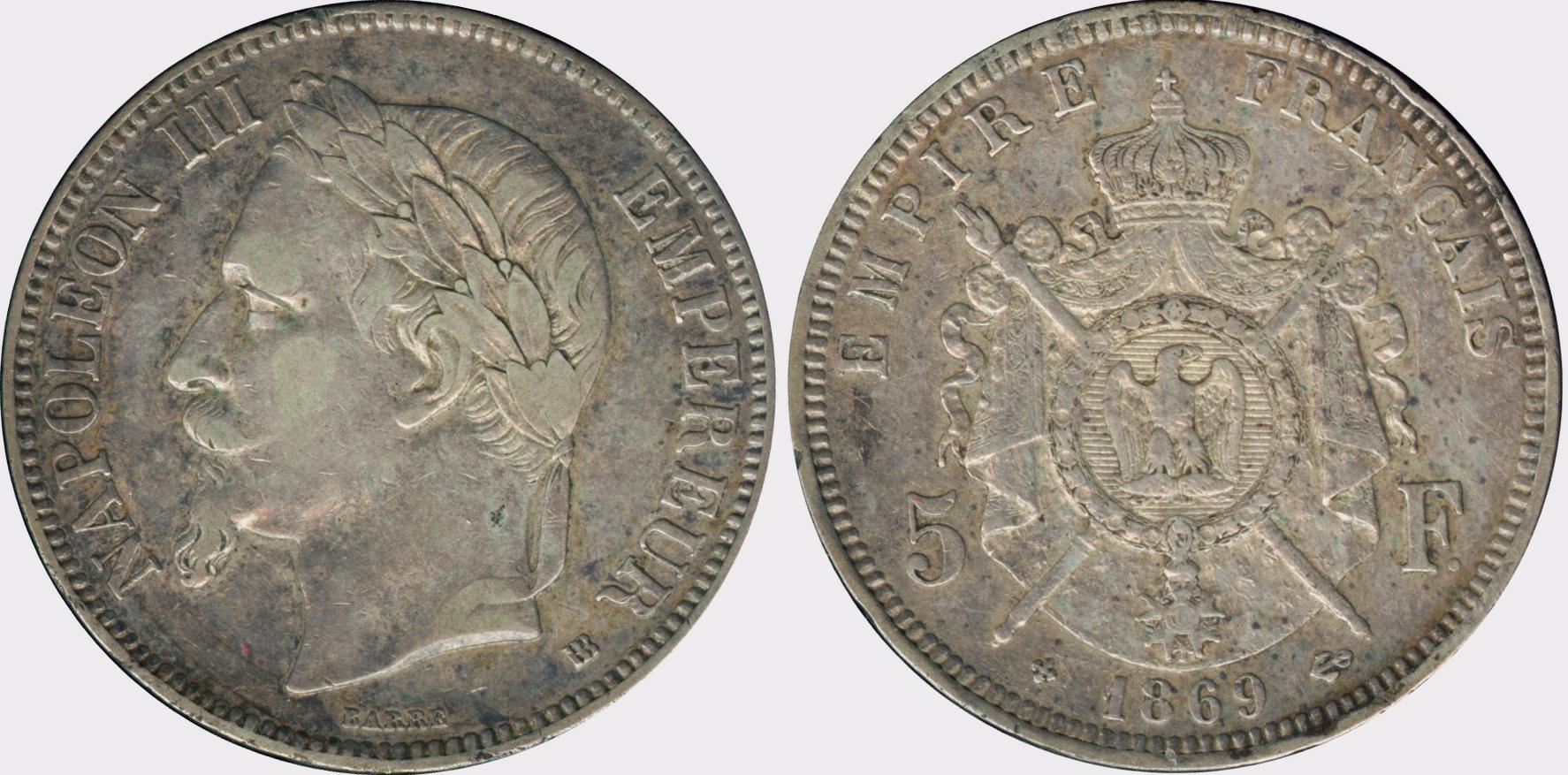
This is a five Francs piece minted in Paris (mintmark A) in 18521. The obverse has Emperor Napoleon III (he was the nephew of the real Napoleon). Weighs 25 grams of 0.900 fineness.
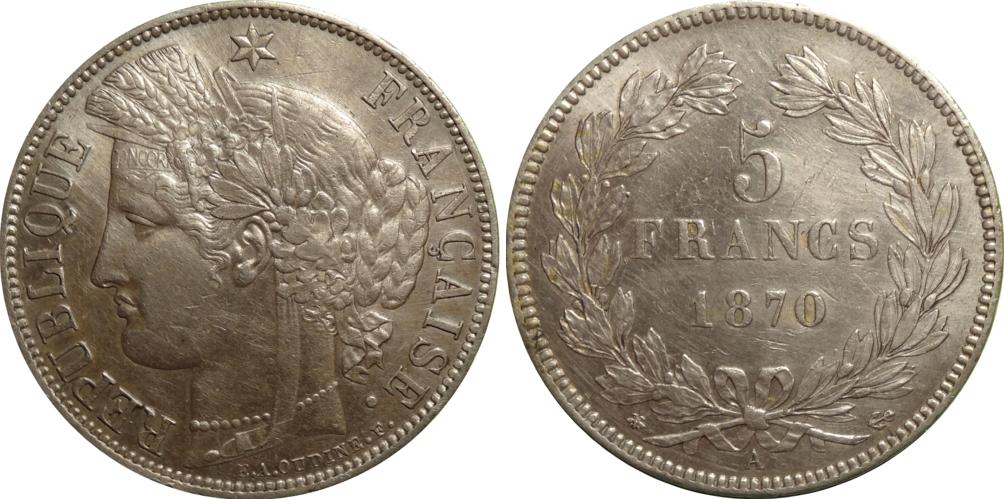
This is a five Francs piece minted in Paris (mintmark A) in 1870. The obverse has Ceres. This was the republic issue just after Napoleon III abdicated and moved to Germany. It has no motto on the reverse with a very low mintage of 64,000. Weighs 25 grams of 0.900 fineness.
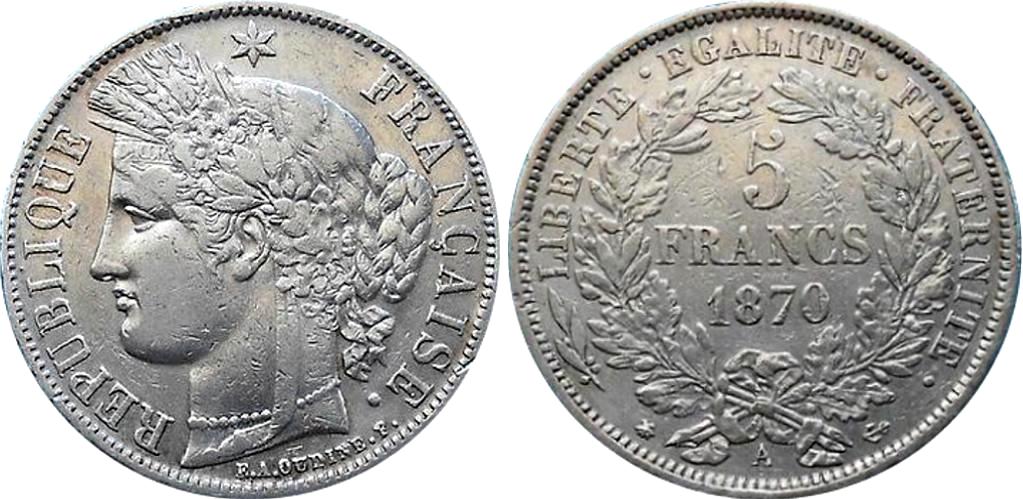
This is a five Francs piece minted in Paris (mintmark A) in 1870. The obverse has Ceres. This was the republic issue just after Napoleon III abdicated and moved to Germany. It has the motto on the reverse. Weighs 25 grams of 0.900 fineness.
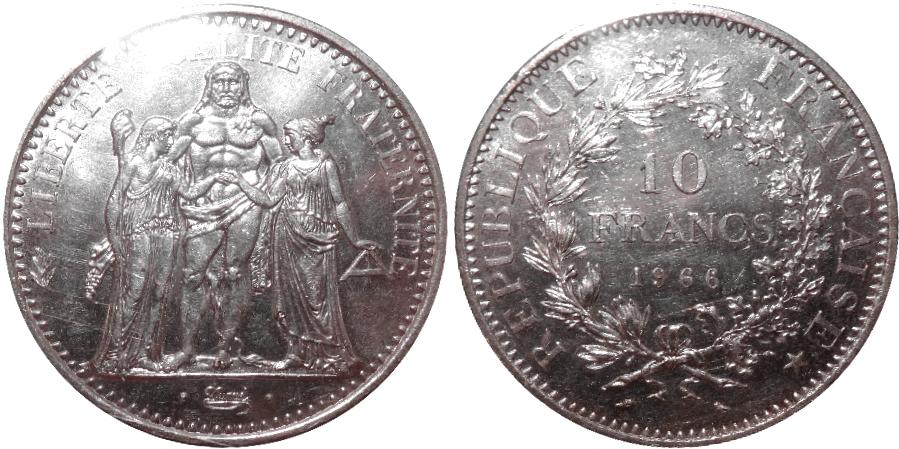
This ten Francs piece was minted in 1966. The obverse has the same image of Hercules used on the initial first republic's 5 Francs coins. Weighs 25 grams of 0.900 fineness.
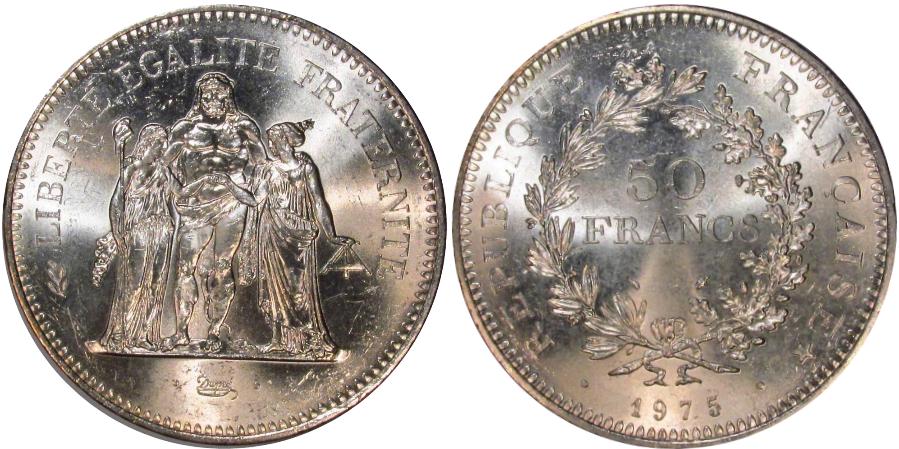
This fifty Francs piece was minted in 1975. The obverse has the same image of Hercules used on the initial first republic's 5 Francs coins. Weighs 30 grams of 0.900 fineness.
FRANKFURT
One of the largest cities in modern Germany, Frankfurt is located on the north bank of the Main River about 25 miles (42 kilometers) upstream from where it joins the Rhine at Mainz. it was the site of a Roman camp in the first century. Frankfurt was a commercial center from the early Middle Ages and became a favored location for imperial councils during the Carolingian period because of its central location. An imperial mint operated from early times and had a large production during the 12th to 14th centuries. Local issues were produced from at least the mid-14th century, but it was not until 1428 that the city was officially granted the right to coin its own money. In establishing the seven permanent electors of the Empire in 1356, the Golden Bull also made Frankfurt the site of those elections and increased the prestige of the city even further. Frankfurt remained a free city until 1806 and then was the capital of the Grand Duchy of Frankfurt from 1810 until 1814, only to regain its free status in 1815. The city chose the wrong side in the Austro-Prussian War of 1866 and thus was absorbed by victorious Prussia in the latter year.
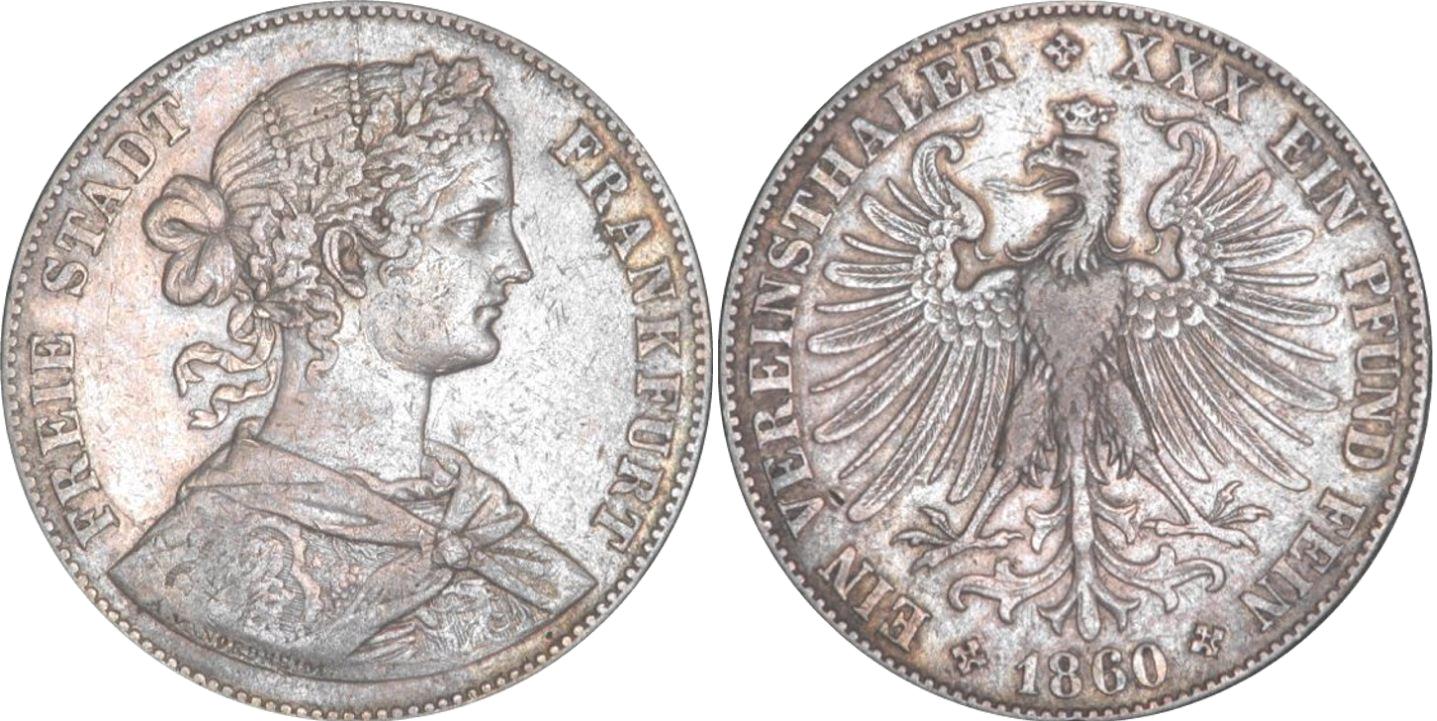
This is an one Thaler coin minted in 1860 i Frankfurt-am-Main. The obverse has Free City of Frankfurt. Weighs 18.5 grams of 0.900 fineness.
FRENCH INDOCHINA
French Indo-China, made up of the protectorates of Annam, Tonkin, Cambodia, and Laos and the colony of Cochin-China was located on the Indo-Chinese peninsula of Southeast Asia. The forebears of the modern Indo-Chinese people originated in the Yellow River Valley of Northern China. From there, they were driven into the Indo-Chinese peninsula by the Han Chinese. The Chinese followed southward in the second century BC, conquering the peninsula and ruling it until 938, leaving a lingering heritage of Chinese learning and culture. Indo-Chinese independence was basically maintained until the arrival of the French in the mid-19th century who established control over all of Vietnam, Laos, and Cambodia. Activities directed toward obtaining self-determination accelerated during the Japanese occupation of World War II. The dependencies were changed from colonies to territories within the French Union in 1946, and all the inhabitants were made French citizens. In August of 1945, an uprising erupted involving the French and Vietnamese communists, culminated in the French military disaster at Dien Bien Phu (May 1954) and the subsequent Geneva Conference that brought an end to French colonial rule In Indo-China.

This is a trade coin (Piaster de Commerce), minted in Paris in 1898. This style was issued from 1895 through 1922. The reverse has the weight (27 grams) and the fineness (0.900). In 1923 the piastre was devalued. Weighs 27 grams of 0.900 fineness.
GERMAN NEW GUINEA
German New Guinea occupied the eastern half of the Island of New Guinea. It lies north of Australia near the equator and borders on Indonesian West Irian (formerly Netherlands New Guinea). In 1884 Germany annexed the area known as German New Guinea (also Neu Guinea or Kaiser Wilhelmsland) comprising the northern section of eastern New Guinea, and granted its administration and development to the Neu-Guinea Compagnie. Administration reverted to Germany in 1899 following the failure of the company to exercise adequate administration. While a German protectorate, German New Guinea had an area of 92,159 sq. ml. (238,692 sq. km.) and a population of about 250,000. Capital: Herbertshohe, 1 of 4 capitals of German New Guinea. The seat of government was transferred to Rabaul in 1910.
Australian troops occupied German New Guinea in Aug. 1914, shortly after Great Britain declared war on Germany. It was mandated to Australia by the League of Nations in 1920, known as the Territory of New Guinea. The territory was invaded and most of it was occupied by Japan in 1942. Following the Japanese surrender, it came under U.N. trusteeship, 13 Dec. 1946, with Australia as the administering power.

This is the 5 Mark piece was only struck that year 1894 at the Berlin Mint. The figure on the obverse is the Bird of Paradise. In my opinion it is one of the prettiest crowns ever struck. Only 19000 were issued. Weighs 27.7 grams of 0.900 fineness.
GHANA
The state of Ghana, comprising the Gold Coast
and British Togoland, obtained independence on 6 March 1957, becoming the fist
Negro African colony to do so. On 1 July 1960, Ghana
adopted a republican constitution, changing from a ministerial to a presidential
form of government. The government was overthrown, the constitution suspended and
the National Assembly
dissolved by the Ghanaian army and police on 24 Feb. 1966. The government was returned
to civilian authority in Oct. 1969, but was again seized by military officers in
a bloodless coup on
13
Jan. 1972, but 3 further coups occurred in 1978, 1979 and 1981.
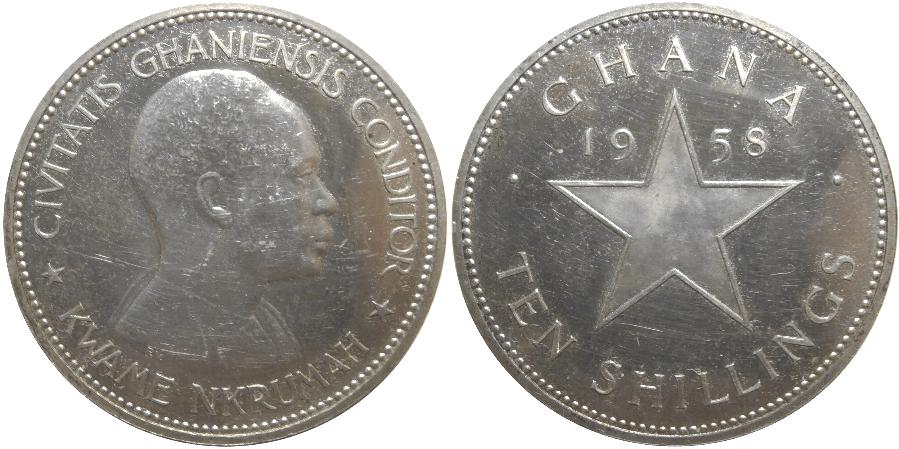
This is a ten shilling coin minted for Ghana in 1958. The obverse has Kwame Nkrumah, the nation's founder. The reverse has a star, the country's name, the date, and the denomination. Weighs 28.28 grams of 0.925 fineness.
GIBRALTAR
Gibraltar, rooted in Greek mythology as one of
the Pillars of Hercules, has long been a coveted stronghold. Moslems took it from
Spain and fortified it in 711. Spain retook it in 1309, lost it
again to the Moors in 1333 and retook it in 1462. After 1540 Spain strengthened
its defenses and held it until the War of the Spanish Succession when it was captured
by a combined British and
Dutch force in 1704. Britain held it against the Franco-Spanish attacks of 1704-05
and through the historic Great Siege of 1779-83.Recently Spain has attempted to
discourage British occupancy
by harassment and economic devices. In 1967, Gibraltar’s inhabitants voted 12,138
to 44 to remain under British rule.
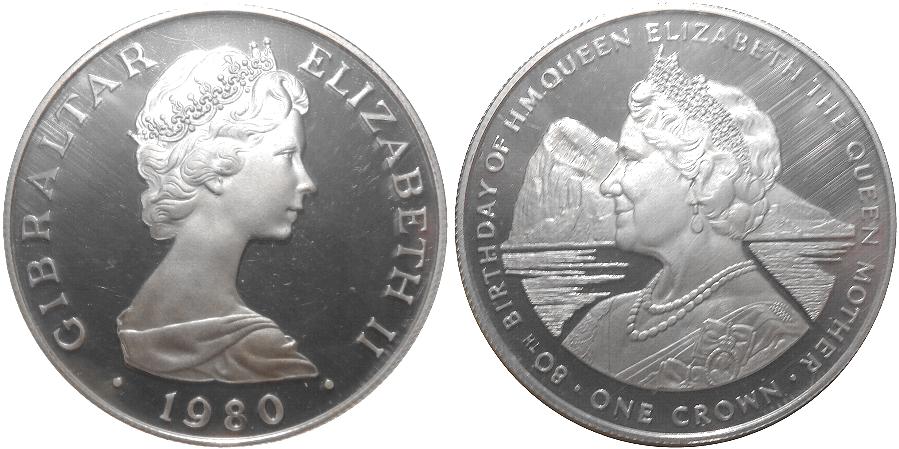
This is an one crown coin minted for Gibraltar in 1980. The obverse has Queen Elizabeth II. The reverse has a the Queen Mother with the Rock in the background.. Weighs 28.28 grams of 0.925 fineness.
GREAT BRITAIN
The United Kingdom of Great Britain and Northern Ireland is located off the northwest coast of the European continent. After the departure of the Romans, who brought Britain into a more active relationship with Europe, it fell prey to invaders from Scandinavia and the Low Countries who drove the original Britons into Scotland and Wales, and established a profusion of kingdoms that finally united in the 11th century under the Danish King Canute. Norman rule, following the conquest of 1066, stimulated the development of those institutions, which have since distinguished British life. Henry VIII (1509-47) turned Britain from continental adventuring and faced it to the sea - a decision that made Britain a world power from the reign of Elizabeth I (1558-1603). Strengthened by the Industrial Revolution and the defeat of Napoleon, 19th century Britain turned to the remote parts of the world and established a colonial empire of such extent and prosperity that the world has never seen its like.
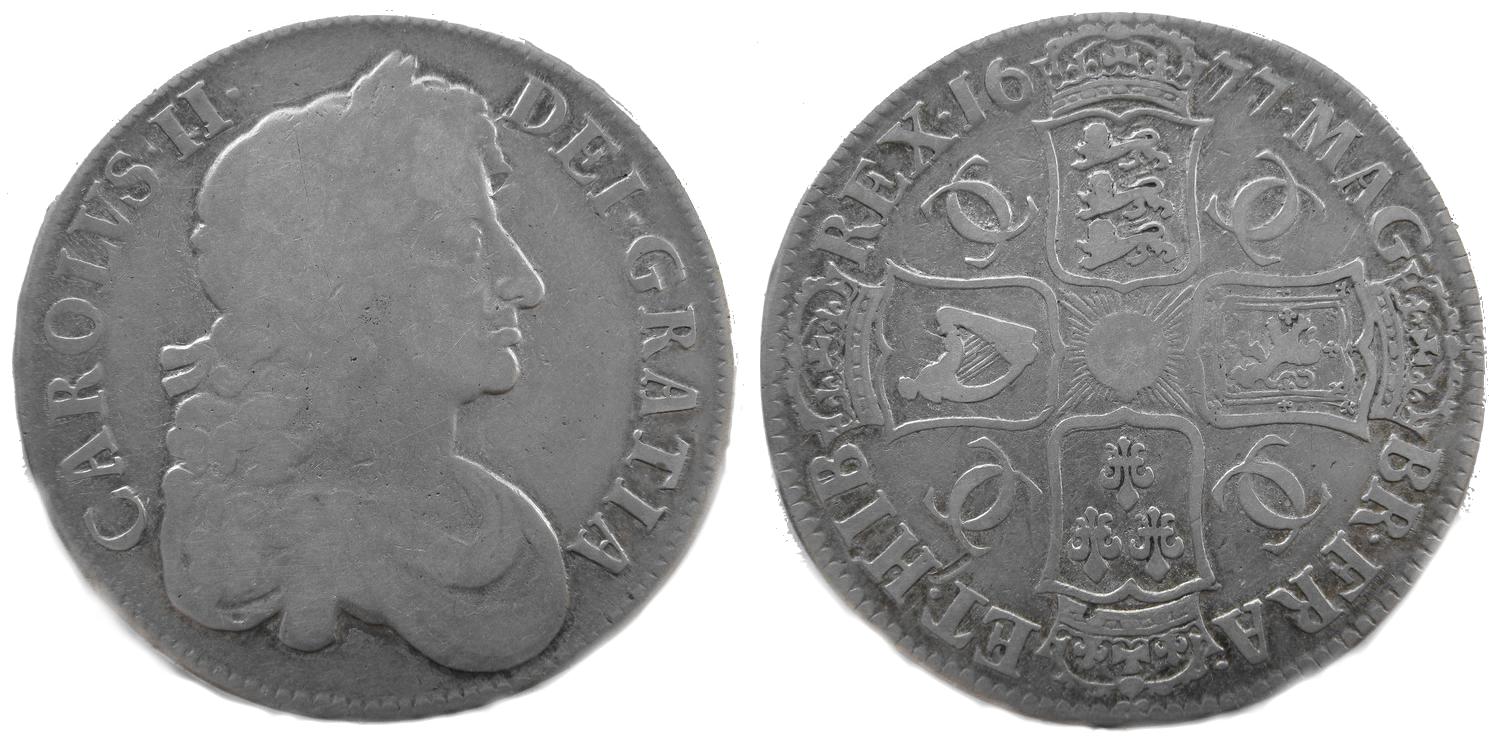
This is a five shilling (crown) minted in 1677. It features King Charles II on the obverse. The reverse has the shields of England, Scotland, France and Ireland with the date 1677 and the regnal legend MAG· BR·FRA· ET·HIB REX. Weighs 30 grams of 0.925 fineness.
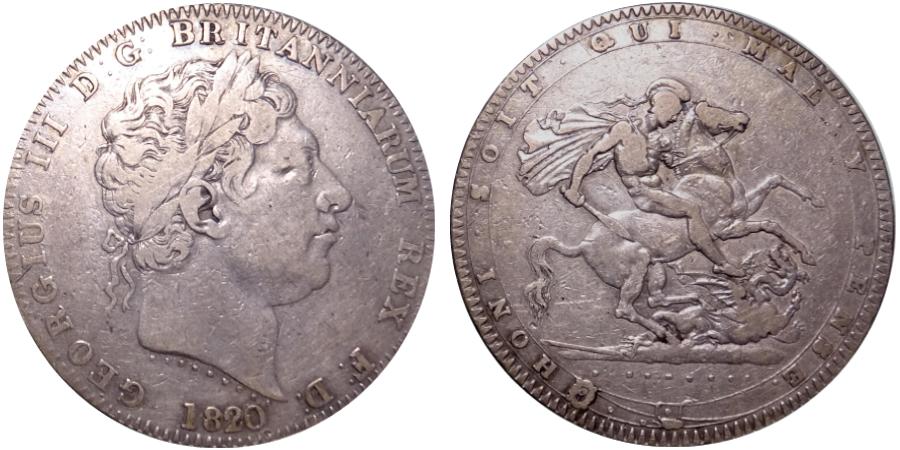
This is a five shilling (crown) minted in 1820. It features King George III on the obverse encircled by the legend GEORGIUS III D:G: BRITANNIARUM REX F: D:. The reverse has St. George slaying the dragon within the motto from the Order of the Garter .Weighs 30 grams of 0.925 fineness.
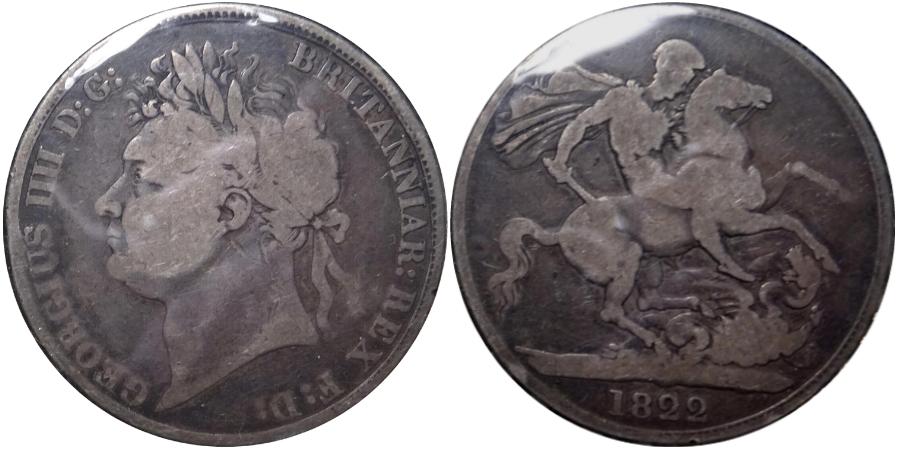
This is a five shilling (crown) minted in 1822. It features King George IIII on the obverse encircled by the lergend GEORGIUS IIII D:G: BRITANNIAR:REX F:D:B.P.. The reverse has St. George slaying the dragon. Weighs 30 grams of 0.925 fineness.
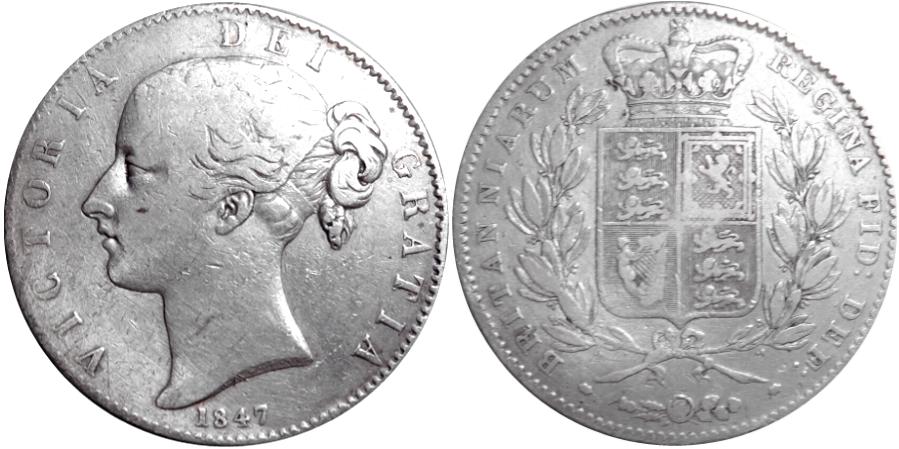
This is a five shilling (crown) minted in 1847. It features he young head Queen Victoria on the obverse. The reverse has the British arms within a wreath encircled by the legend BRITANNIARUM REGINA FID: DEF: Weighs 30 grams of 0.925 fineness.
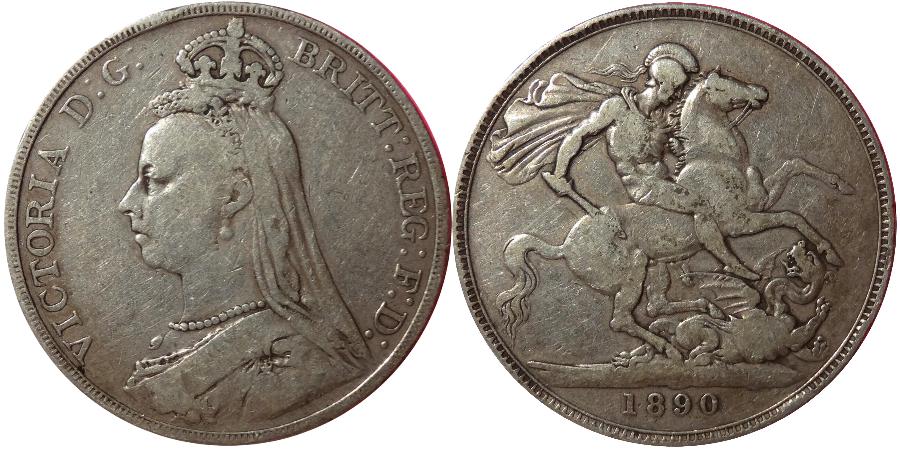
This is a five shilling (crown) minted in 1890. It features the jubilee head of Queen Victoria on the obverse encircled by the legend VICTORIA D:G: BRITT: REG: F:D:. The reverse has St. George slaying the dragon. Weighs 30 grams of 0.925 fineness.
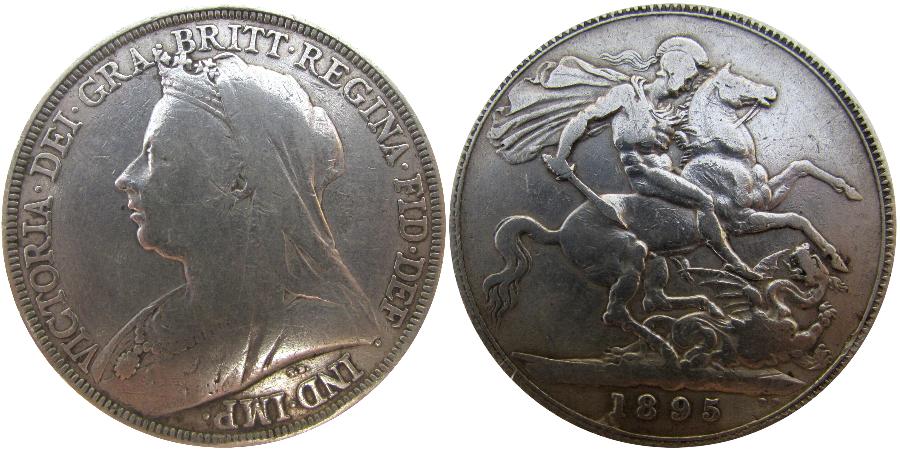
This is a five shilling (crown) minted in 1895. It features the mature bust of Queen Victoria on the obverse encircled by the legend VICTORIA·DEI·GRA·BRITT·REGINA·FID·DEF · IND·IMP·. The reverse has St. George slaying the dragon. Weighs 30 grams of 0.925 fineness.
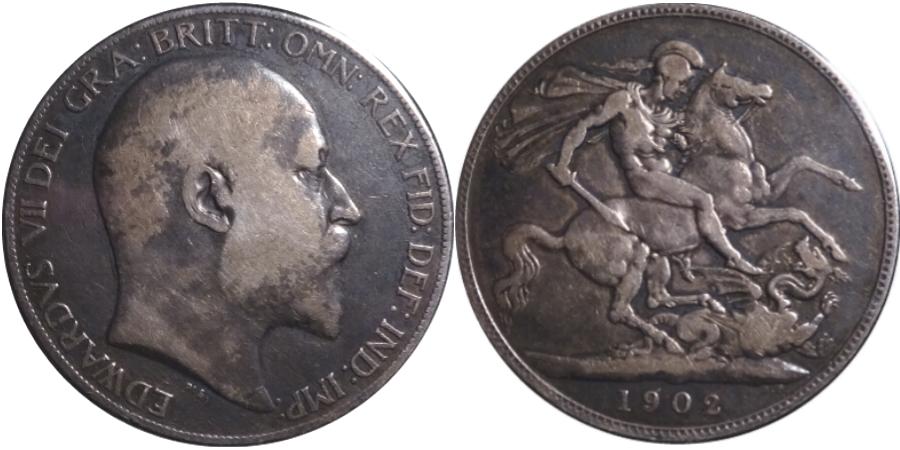
This is a five shilling (crown) minted in 1902. It features King Edward VII on the obverse encircled by the legend EDWARDVS VII DEI GRA: BRITT: OMN: REX FID: DEF: IND: IMP:. The reverse has St. George slaying the dragon. Weighs 30 grams of 0.925 fineness.
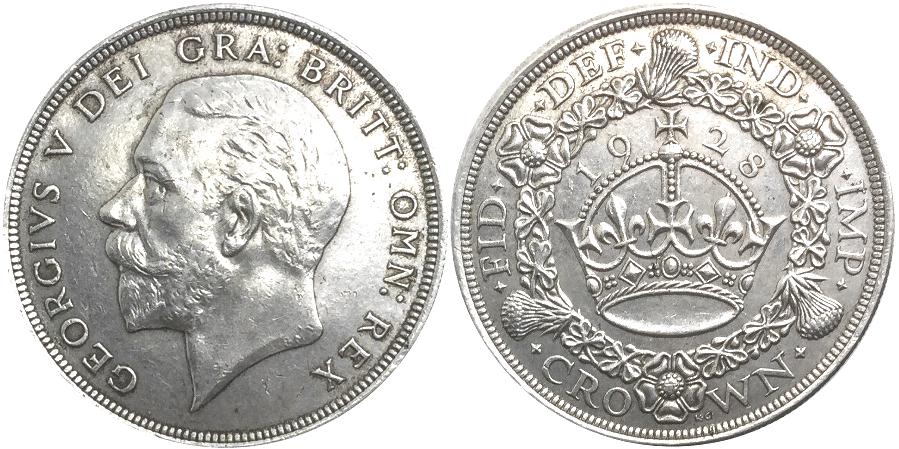
This is a five shilling (crown) minted in 1928. These were minted from 1927 to 1934 and 1936 in limited mintages late in the year for Christmas gifts (mintage in 1928 was 9034). The obverse features King George V with the legend GEORGIVS V DEI GRA: BRITT: OMN: REX. The reverse has a crown below thedate within wreath with national flower emblems, encircled by the legend ·FID· ·DEF· ·IND· ·IMP·. Weighs 28.28 grams of 0.500 fineness.
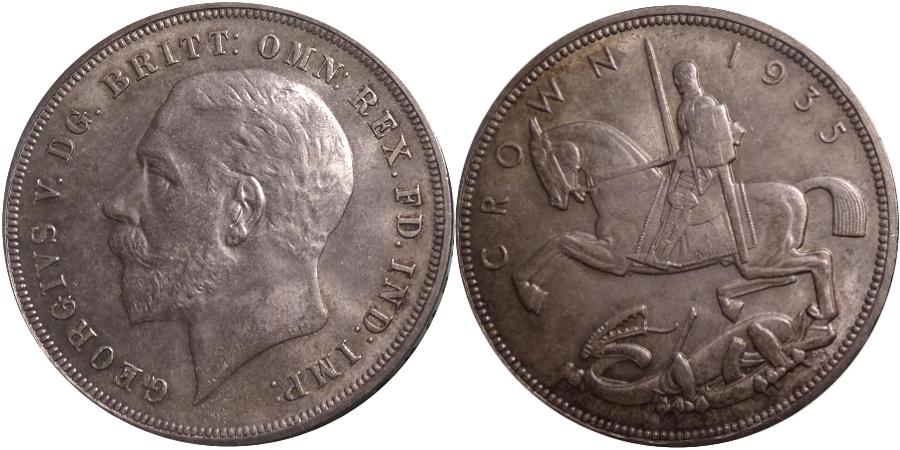
This is a five shilling (crown) minted in 1935 to celebrate the king's golden anniversary. It features King George V on the obverse. The reverse has a British knight slaying the dragon. Weighs 28.28 grams of 0.500 fineness.
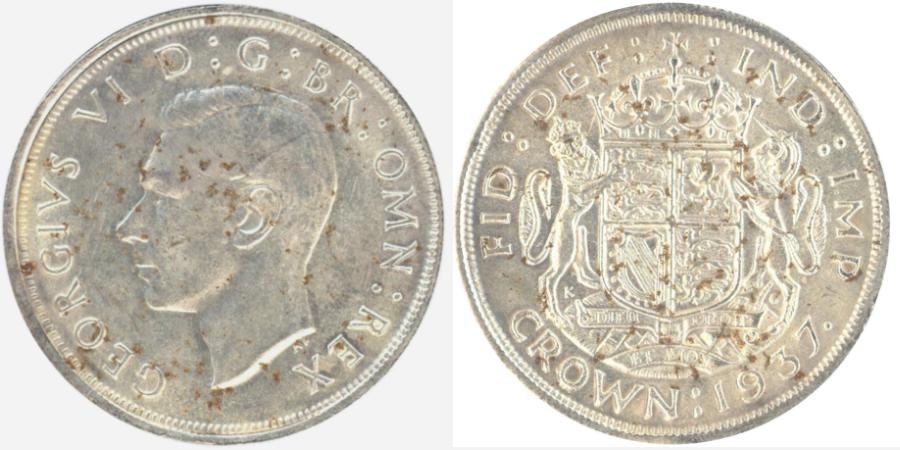
This is a five shilling (crown) minted in 1937 to celebrate the coronation of King George VI. It features the king on the obverse. The reverse has the British arms. Weighs 28.28 grams of 0.500 fineness.
This is an emergency issue of 1797 where this Spanish colonial 8 reales piece from Mexico was countermarked to pass for a crown (five shillings). The British at the time called it "the head of a fool on the head of an ass." Weighs 27 grams of 0.896 fineness.
This is another emergency issue this time by the Bank of England actually a dollar token in 1804. Often Spanish 8 reales pieces were overstruck with the British dies. Weighs 27 grams of 0.896 fineness.
This is an example of a British Trade Dollar struck for commerce in the Far East. The reverse has legends in Chinese and Malay denoting the denomination. The coins were minted in Bombay and Calcutta India from 1895 to 1935 except for 1925 and 1930 which were minted in London. Weighs 27 grams of 0.900 fineness.
GREECE
Greece, the Mother of Western civilization, attained the peak of its culture in the 5th century BC, when it contributed more to government, drama, art and architecture than any other people to this time. Greece fell under Roman domination in the 2nd and 1st centuries BC, becoming part of the Byzantine Empire until Constantinople tell to the Crusaders in 1202. With the fail of Constantinople to the Turks in 1453, Greece became part of the Ottoman Empire. Independence from Turkey was won with the revolution of 1821-27. In 1833, Greece was established as a monarchy, with sovereignty guaranteed by Britain, France, and Russia. After a lengthy power struggle between the monarchist forces and democratic factions, Greece was proclaimed a republic in 1925. The monarchy was restored In 1935 and reconfirmed by a plebiscite in 1946. The Italians invaded Greece via Albania on 28 Oct. 1940 but were driven back well within the Albanian border. Germany began their invasion in April 1941 and quickly overran the entire country and drove off a British Expeditionary force by the end of April. King George II and his new government went into exile. The German-Italian occupation of Greece lasted until Oct. 1944 after which only German troops remained until the end of the occupation. On 21 April 1967 a military Junta took control of the government and suspended the constitution. King Constantine II made an unsuccessful attempt against the Junta in the tall of 1968 and consequently fled to Italy. The monarchy was formally abolished by plebiscite, 8 Dec. 1974, and Greece was established as the Hellenic Republic, the third republic in Greek history.
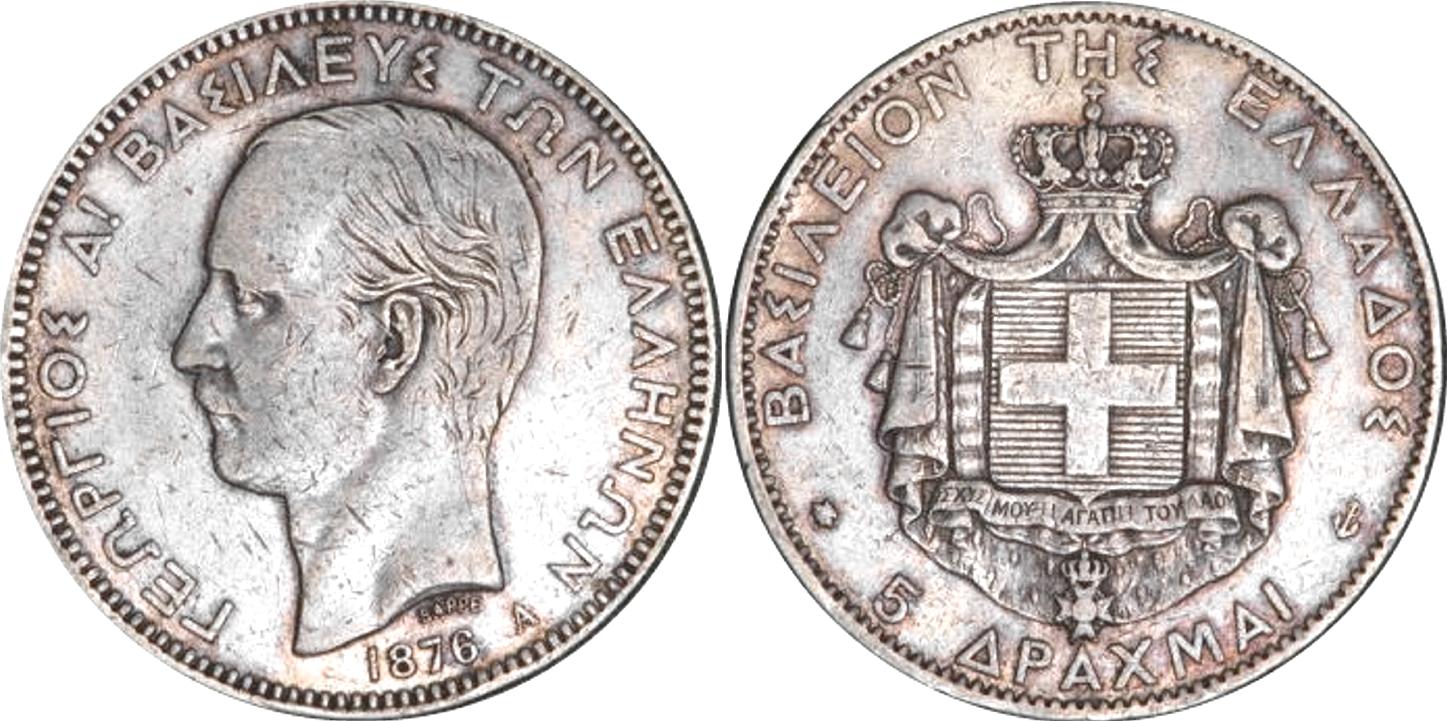
This is a five Drachma coin minted in 1876 in Paris. The obverse features King George with the legend .ΓΕΩΡΓΙΟΣ Α! ΒΑΣΙΛΕΥΣ ΤΩΝ ΕΛΛΗΝΩΝ (George I King of the Greeks). The reverse has the Greek arms with the legend ΒΑΣΙΛΕΙΟΝ ΤΗΣ ΕΛΛΑΔΟΣ (Kingdom of Greece). Weighs 25 grams of 0.900 fineness.
GUATEMALA
Guatemala, once the site of an ancient Mayan civilization, was conquered by Pedro de Alvarado, the resourceful lieutenant of Cortes who undertook the conquest from Mexico. Cruel but strategically skillful, he progressed rapidly along the Pacific coastal lowlands to the highland plain of Quetzaltenango where the decisive battle for Guatemala was fought. After routing the Indian forces, he established the city of Guatemala in 1524. The Spanish Captaincy-General of Guatemala included all Central America but Panama. Guatemala declared its independence of Spain in 1821 and was absorbed into the Mexican empire of Augustin Iturbide (1822-23). From 1823 to 1839 Guatemala was a constituent state of the Central American Republic. Upon dissolution of that confederation, Guatemala proclaimed itself an independent republic. Like El Salvador, Guatemala suffered from internal strife between the western backed military government and leftist communist indigenous peoples from ca1954 to 1997.
This is an 1821 eight reales piece minted in Guatemala City (mintmark NG) during the Spanish controlled era. The obverse has Ferdinand VII. Reverse has the Spanish arms and the assayer's initial M (Manuel Eusabio Sanchez)/ Weighs 27 grams of 0.896 fineness.
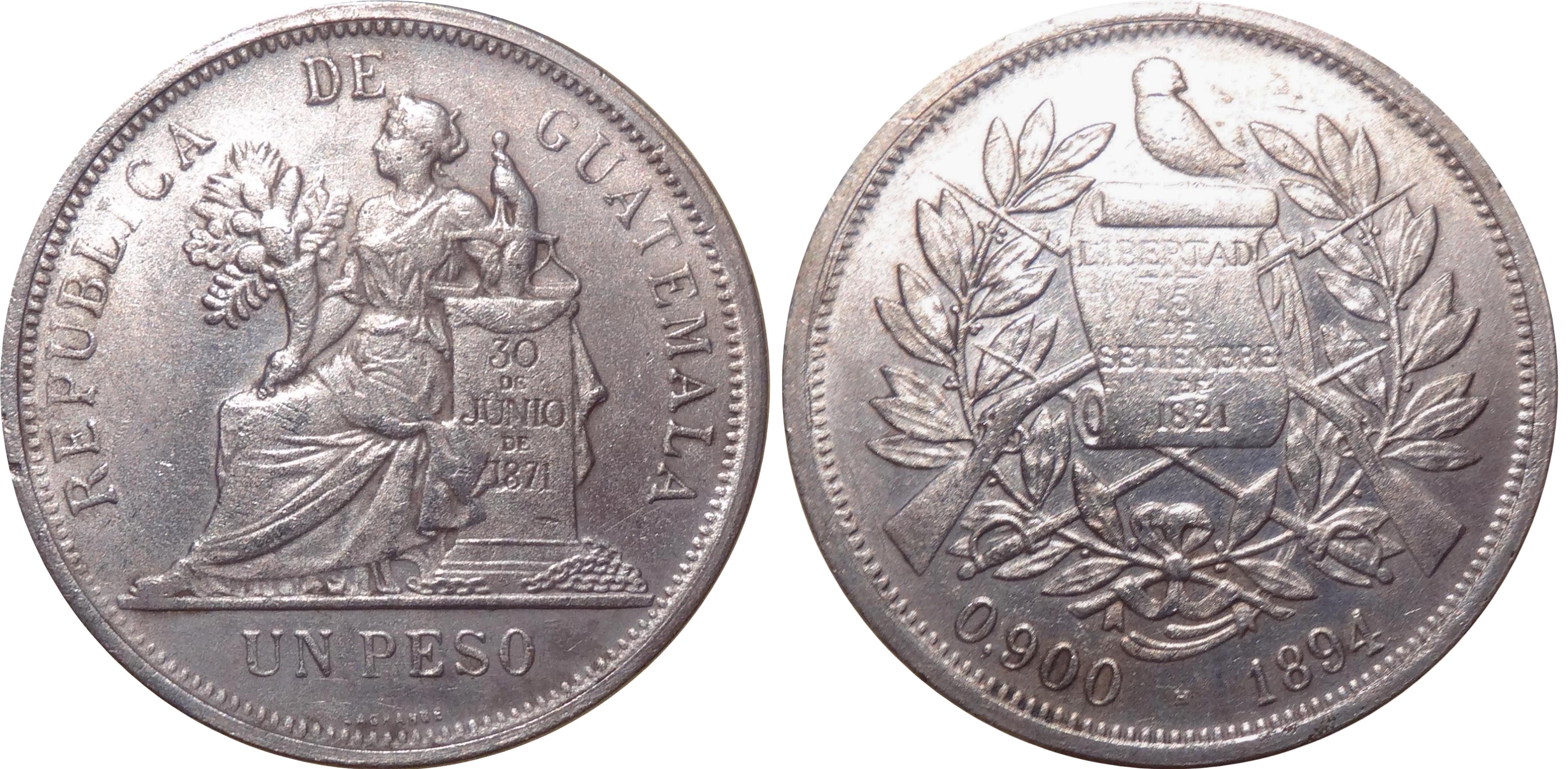
This is a one Peso coin minted in 1894. Obverse has Justice seated facing left. Reverse has the fineness, the date, and arms. Weighs 25 grams of 0.900 fineness.
HAITI
The Republic of Haiti occupies the western one-third of the Island of Hispaniola in the Caribbean Sea between Puerto Rico and Cuba. Columbus discovered Hispaniola in 1492. Spain colonized the Island, making Santo Domingo the base for exploration of the Western Hemisphere. The area that is now Haiti was ceded to France by Spain in 1697. Slaves brought from Africa to work the coffee and sugar cane plantations made it one of the richest colonies of the French Empire. A slave revolt in the 1790's led to the establishment of the Republic of Haiti in 1804, making it the oldest Black republic in the world and the second oldest republic (after the United States) in the Western Hemisphere. The French language is used on Haitian coins although it Is spoken by only about 10% of the populace. A form of Creole is the language of the Haitians.
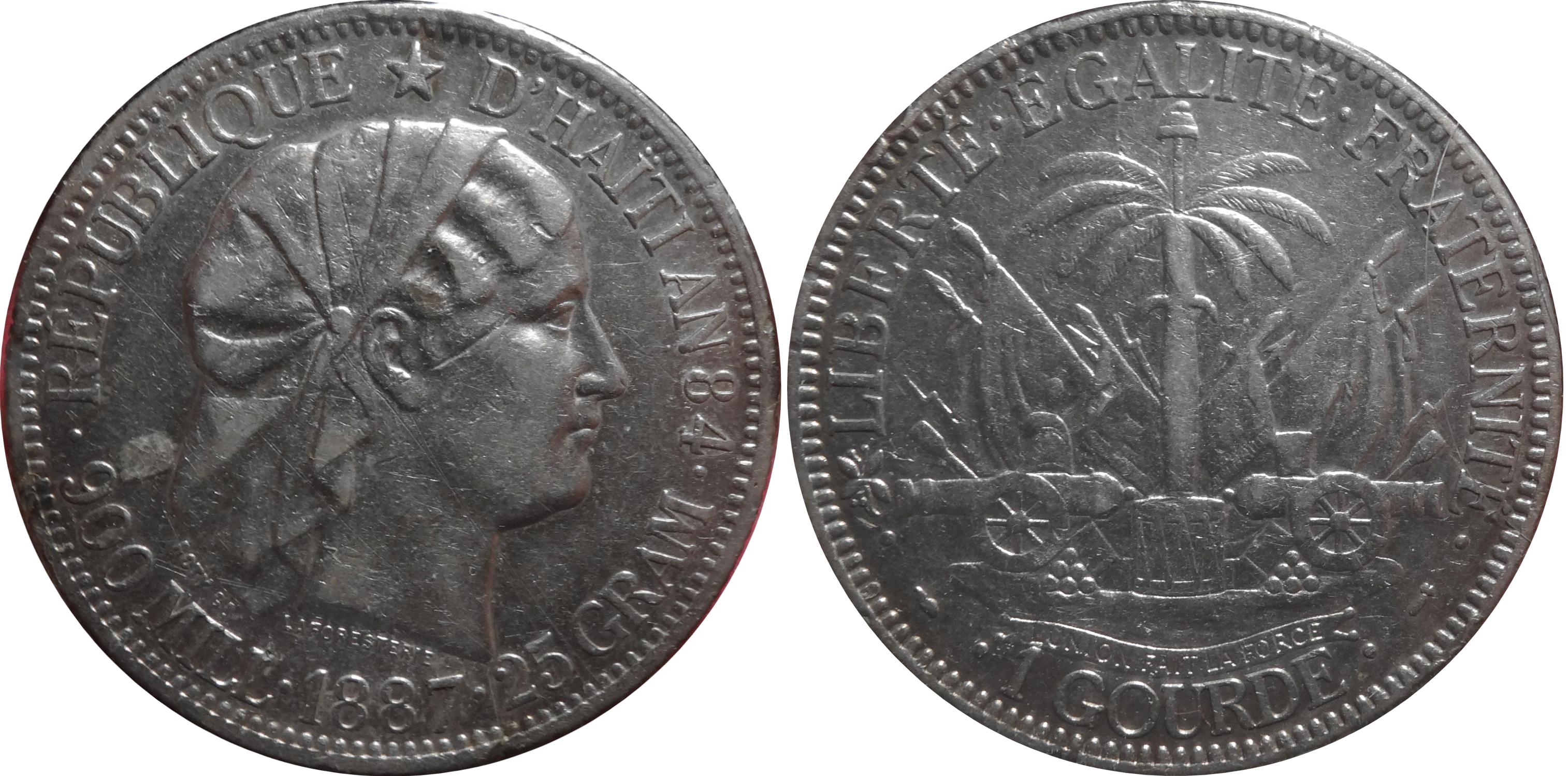
This is a one Gourde coin minted in 1887. Obverse has a Caucasian female with a bonnet. Reverse has the arms of Haiti. Weighs 25 grams of 0.900 fineness.
HAMBURG
The city of Hamburg is located on the Elbe River about 75 miles from the North Sea. it was founded by Charlemagne in the 9th century. In 1241 it joined Lubeck to form the Hanseatic League. The mint right was leased to the citizens in 1292. However, the first local halfpennies had been struck almost 50 years earlier. In 1510 Hamburg was formally made a Free City, though, in fact, it had been tree for about 250 years. it was occupied by the French during the Napoleonic period, In 1866 It Joined the North German Confederation and became a part of the German Empire in 1871. The Hamburg coinage is almost continuous up to the time of World War I.
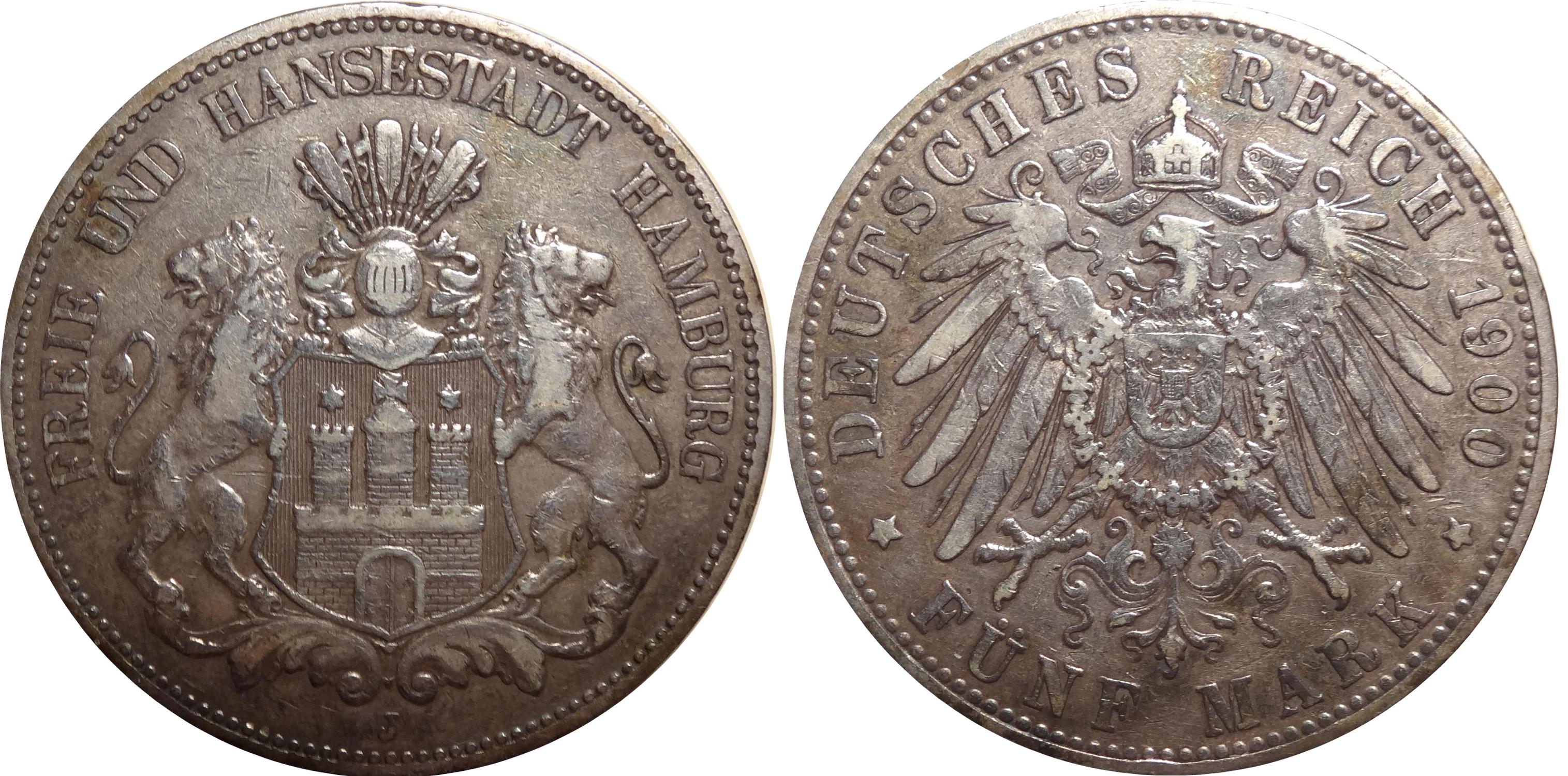
This is a five Mark coin minted in 1900 in Hamburg. German States were permitted to coin silver and gold coins of 2, 3, 5, 10, and 20 Mark until the conclusion of World War I. Obverse has the city arms and the identity as Free and Hanseatic City Hamburg. Reverse has German arms. Weighs 27.8 grams of 0.900 fineness.
HANNOVER
A state located in northwest Germany which became Hannover when Ernst August of Brunswick-Luneburg chose the title of Elector of Hannover after his capital city. During the Napoleonic wars it was first occupied by Prussia and then Incorporated into the Kingdom of Westphalia. in 1814, it was raised to the status of a kingdom. Hannover was absorbed by Prussia in 1866.
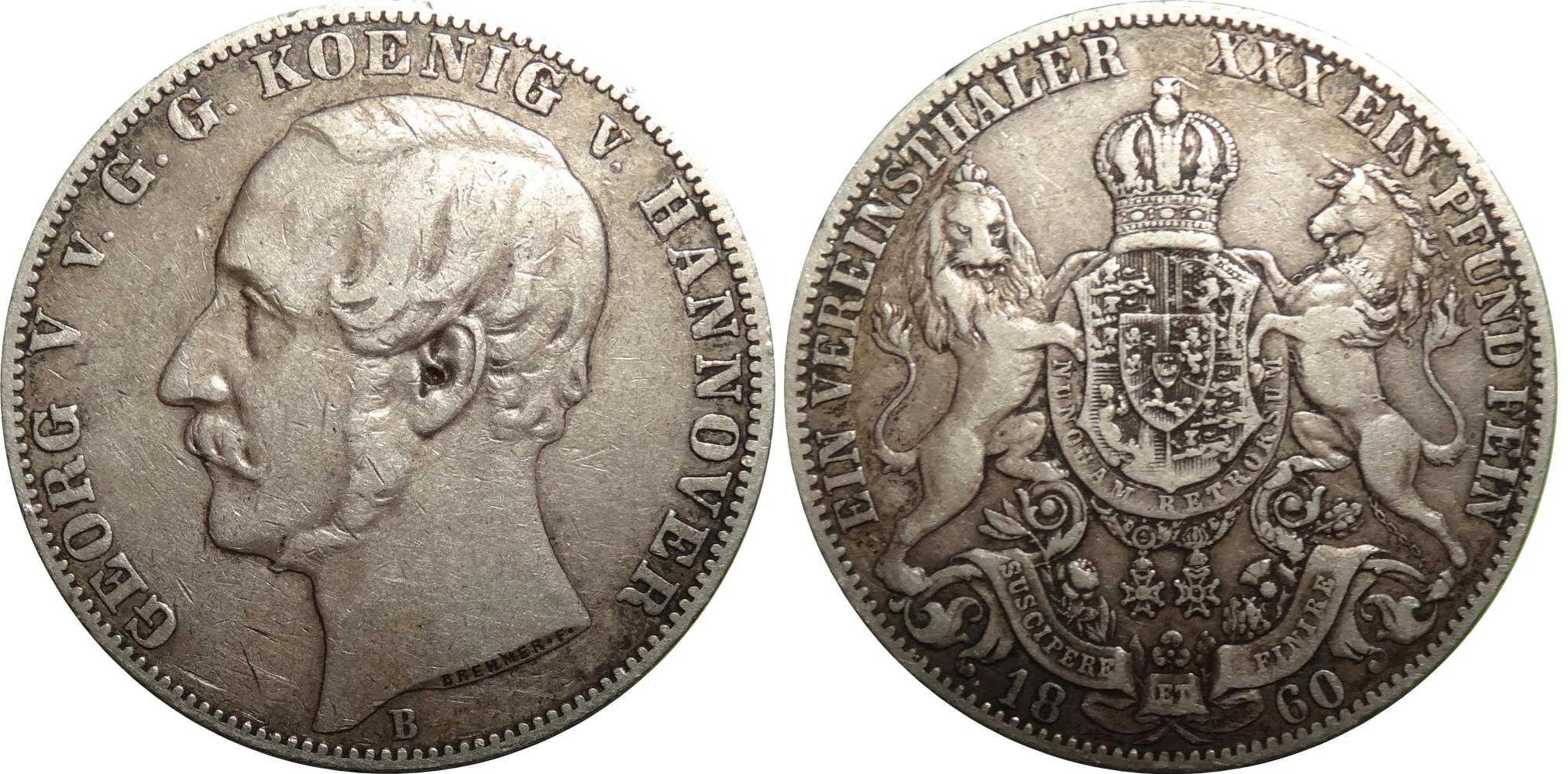
This is a one Thaler coin minted in Hannover in 1860. Obverse has King George V with the legend GEORG V. v.G.G. KOENIG v. HANNOVER (George V by grace of God (von Gottes Guust) King of Hannover). Reverse has the Hannover arms encircled by the legend EIN VEREINSTHALER XXX EIN PFUND FEIN . Weighs 18.5 grams of 0.896 fineness.
HAWAII
Hawaii consists of eight main islands and numerous smaller islets of coral and volcanic origin. It is situated in the central Pacific Ocean, 2400 miles from San Francisco. The islands, originally populated by Polynesians from the Society Islands, were rediscovered by British navigator Capt. James Cook in 1778. He named them the Sandwich Islands. King Kamehameha I (the Great) united the islands under one kingdom which endured until 1893, when Queen Lilioukalani was deposed and a provisional government established. This was followed in 1894 by a republic which governed Hawaii until 1898, when the islands were ceded to the United States. Hawaii was organized as a territory in 1900, and attained statehood on 21 Aug.1959.
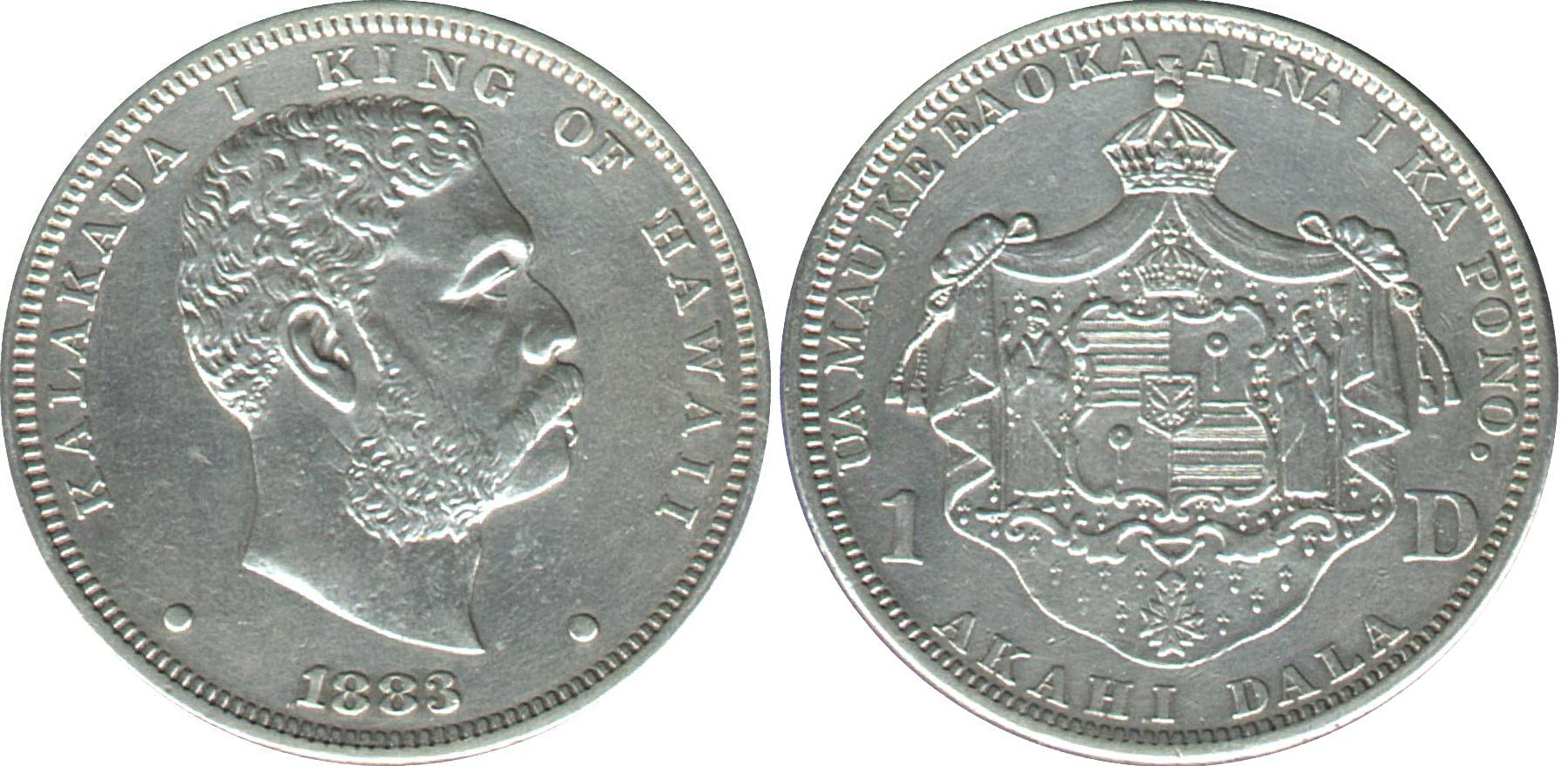
This is the Hawaiian one dollar coin. Coins of 1, 10, 25 and 50 cents and $1 were minted to U.S. standards in San Francisco. The cent was struck in 1847 and the silver was struck in 1883.The obverse has King Kalakaua I. The reverse has the Hawaiian arms. Weighs 28.77 grams of 0.900 fineness.
HESSE-DARMSTADT
Founded by the youngest of Philipp I’s four sons upon the death of their father in 1567, Hesse-Darmstadt was one of the two main branches of the family which survived past the beginning of the 17th century. The Countship of Hanau-Lichtenberg was through marriage when the male line failed in 1736. Ludwig X was forced to cede that territory to France in 1801. In 1803, Darmstadt acquired part of the Palatinate, the city of Friedberg, part of the city of Mainz, and the Duchy of Westphalia in a general settlement with France. The Landgrave was elevated to the status of Grand Duke in 1806 and reacquired Hesse-Homburg, which got its sovereignty back in 1816. In 1815 the Congress of Vienna awarded Hesse-Darmstadt the city of Worms and all of Mainz. These were relinquished, along with Hesse-Homburg, to Prussia in 1866 and Hesse-Darmstadt was called just Hesse from 1867 onwards. Hesse became part of the German Empire in 1871, but ceased to exist as a semisovereign state at the end of World War I.
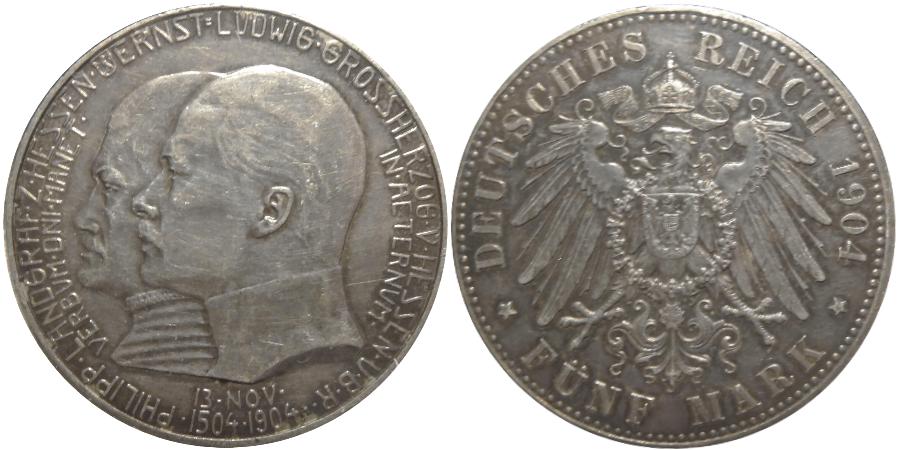
This is a five Mark coin minted in 1904 by Grand Duke Ernst Ludwig to commemorate the 400th birthday of Philipp the Magnanimous. Obverse has the busts of Philipp and Ludwig with the legend PHILIPP.LANDGRAF.Z.HESSEN.ERNST.LUDWIG.GROSSHERZOG.V.HESSEN.U.B.R.VERBUM.ONI.MANET. / IN.AETERNUM. Reverse has German arms. Weighs 27,8 grams of 0.900 fineness.
HONDURAS
The Republic of Honduras is situated in Central America alongside El Salvador, between Nicaragua and Guatemala. After declaring its independence from Spain on 15 September 1821, Honduras fell under the Mexican empire of Augustin de Iturbide, and then joined the Central American Republic (1823-39). Upon the effective dissolution of that federation (ca1840), Honduras reclaimed its independence as a self-standing republic. Honduras forces played a major part in permanently ending the threat of William Walker to establish a slave holding empire in Central America based on his self engineered elections to the presidency of Nicaragua. Thrice expelled from Central America, Walker was shot by a Honduran firing squad in 1860. 1876 to 1933 saw a period of instability and for some months were under U.S. Marine Corps military occupation. From 1933 to 1940 General Tibuitio Canas Andino was dictator president of the Republic. Since 1990 democratic practices have become more consistent.
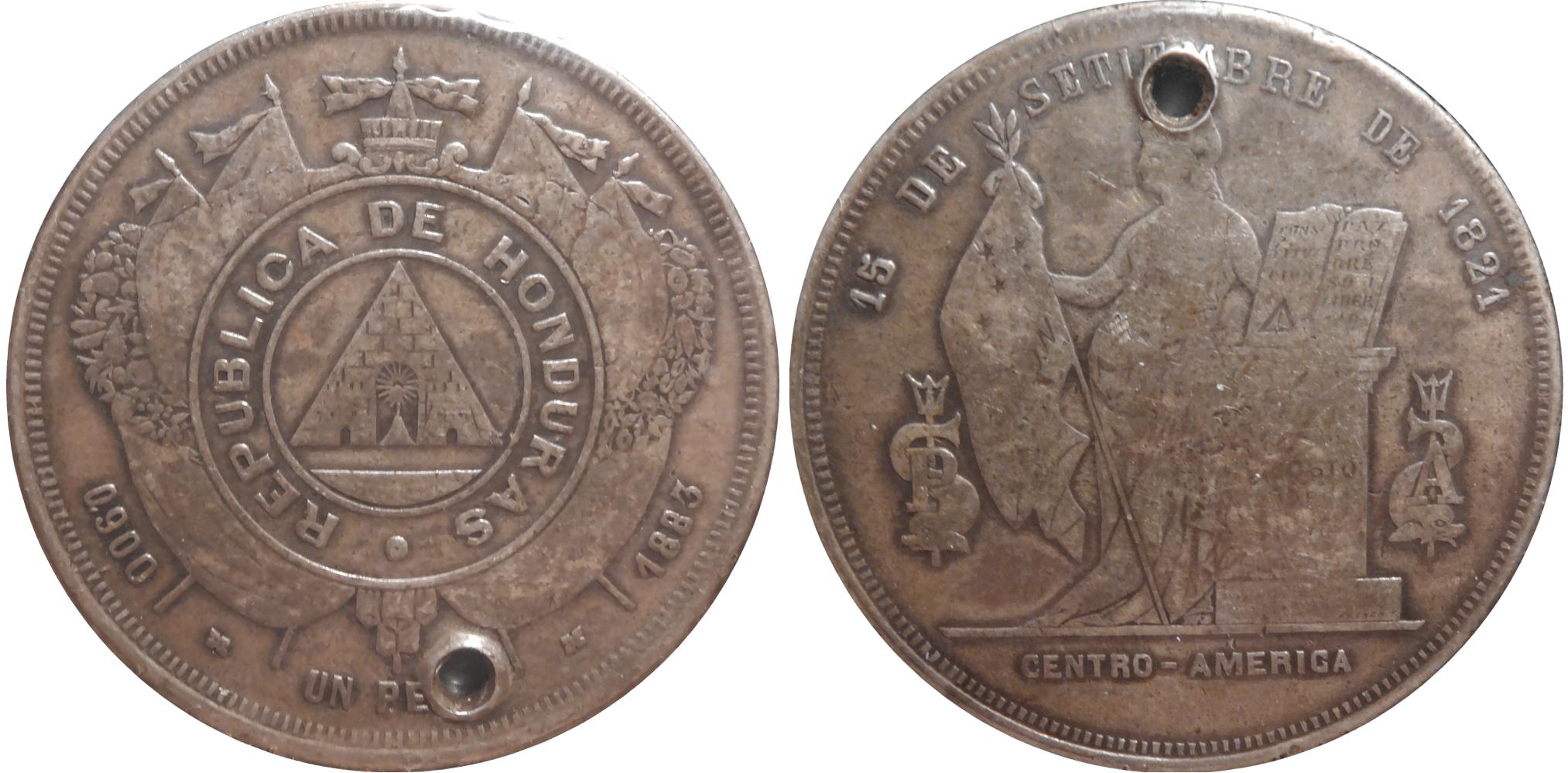
This is an 1883 one Peso piece minted in Tegucigalpa. Obverse has flags around the national symbol. The reverse has a standing Liberty. Weighs 25 grams of 0.900 fineness.
HONG KONG
Hong Kong is situated at the mouth of the Canton or Pearl River 90 miles (145 km.) southeast of Canton. Long a haven for fishermen-pirates and opium smugglers, the island of Hong Kong was ceded to Britain at the conclusion of the first Opium War, 1839-1842. The acquisition of a barren rock was ridiculed by London and English merchants operating in the Far East. The Kowloon Peninsula and Stonecutter's Island were ceded in 1860, and the so-called New Territories, comprising most of the mainland of the colony, were leased to Britain for 99 years in 1898.
The legends on Hong Kong coinage are bilingual: English
and Chinese.
\\
This is the Hong Kong dollar coin minted in 1866 (and also 1867 and 1868). The coin was struck at the Hong Kong mint. The reverse has Queen Victoria. Weighs 27 grams of 0.900 fineness.
HUNGARY
The ancient kingdom of Hungary, founded by the Magyars
In the 9th century, achieved Its greatest extension in the mid-14th century when
its dominions touched the Baltic, Black, and Mediterranean Seas. After suffering
repeated Turkish invasions, Hungary accepted Habsburg rule to escape Turkish occupation,
regaining independence in 1867 with the Emperor of Austria as king of a dual Austro-Hungarian
monarchy. Alter World War I, Hungary lost
⅔ of its territory and
½ of its population
and underwent a period of drastic political revision. The short-lived republic
in 1918
was followed by a chaotic interval of communist rule, 1919, and the restoration
of the monarchy in 1920 with Admiral Horthy as regent of the kingdom. Although a
German ally in World War II, Hungary was occupied by German troops who imposed a
pro-Nazi dictatorship, 1944. Soviet armies drove out the Germans in 1945 and assisted
the communist minority in seizing power. A revised constitution published on 20 Aug.
1949, established Hungary as a Peoples Republic of the Soviet type. On 23 October
1989, Hungary was proclaimed the Republic of Hungary.
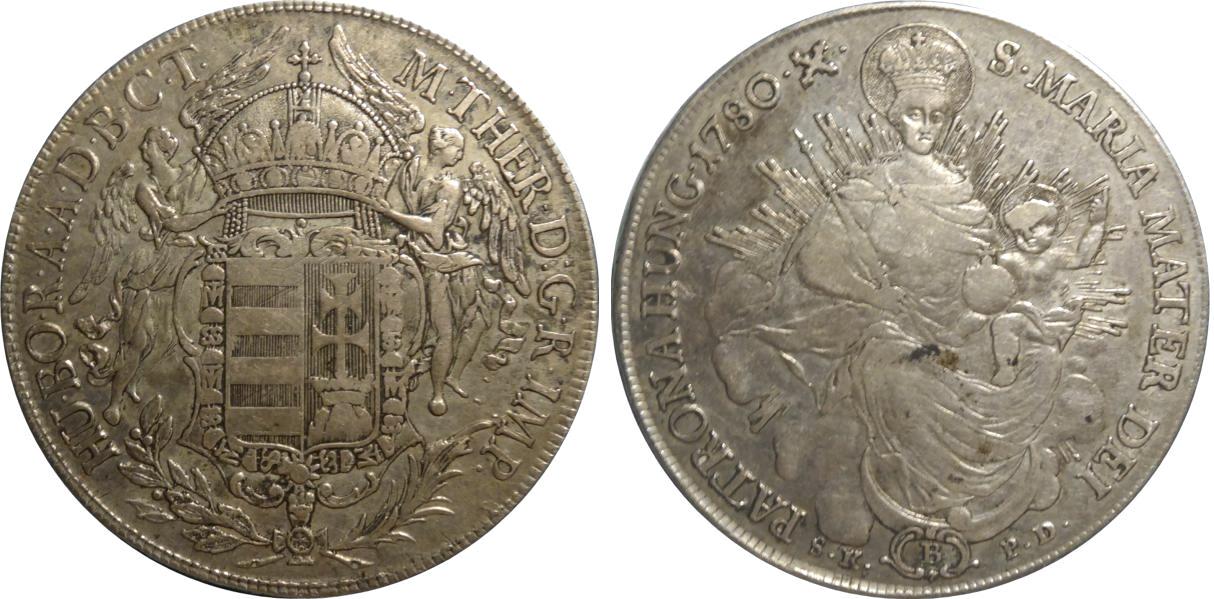
This is a one Thaler coin minted under Empress Maria Theresa in 1780, the year of her death. The obverse has the royal Austro-Hungarian arms with her name and titles M.THER.D.G.R IMP.HU.BO R.A.A.D.B.C.T (M.Ther, by the Grace of God, Empress of the Romans, Queen of Hungary and Bohemia, Archduchess of Austria, Duchess of Burgundy, Countess of Tyrol). The reverse has the Blessed Virgin Mary and the baby Jesus with the Latin legend S·MARIA·MATER·DEI·PATRONA·HUNG· for Holy Mary Mother of Mother of God Patron of Hungary. Weighs 28.06 grams of 0.833 fineness.
)
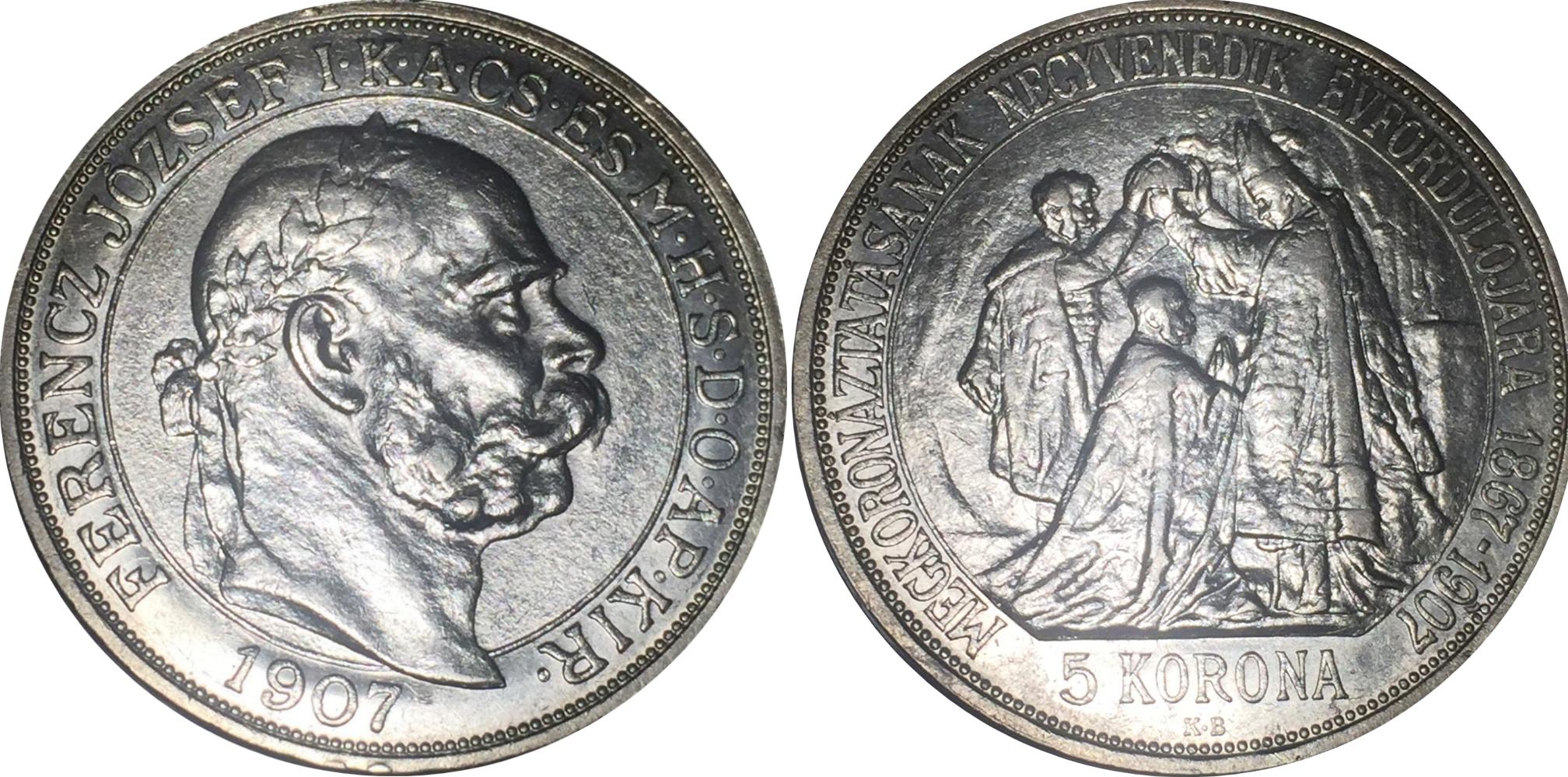
This is five Korona coin minted in 1907 to celebrate 40th anniversary of the coronation of Franz Josef. Obverse has Emperor Franz Josef with the Hungarian legend FERENCZ JÓZSEF I.K.A.CS.ÉS M.H.S.D.O.AP.KIR (Franz Josef by the Grace of God Emperor of Austria and Apostolic King of Hungary, Croatia, Slavonia, Dalmatia). Reverse has the coronation ceremony in 1867 with the legend MECKORONÁZTATÁSÁNAK NEGYVENEDIK EVFORDULOJÁRA 1867 - 1907 (FOR THE FOURTH DECADE OF THE CORONATION 1867 - 1907). Weighs 24 grams of 0.900 fineness.
ICELAND
The Republic of Iceland is an island of recent volcanic origin In the North Atlantic east of Greenland and immediately south of the Arctic Circle. Iceland was settled by Norwegians In the 9th century and established as an independent republic in 930. The Icelandic assembly called the Althingi also established in 930, is the oldest parliament in the world. Iceland came under Norwegian sovereignty in 1262, and passed to Denmark when Norway and Denmark were united under the Danish crown in 1380. In 1918 It was established as a virtually independent Kingdom in union with Denmark. On 17 June 1944, while Denmark was still under occupation by troops of the Third Reich, Iceland was established by plebiscite as an independent republic.
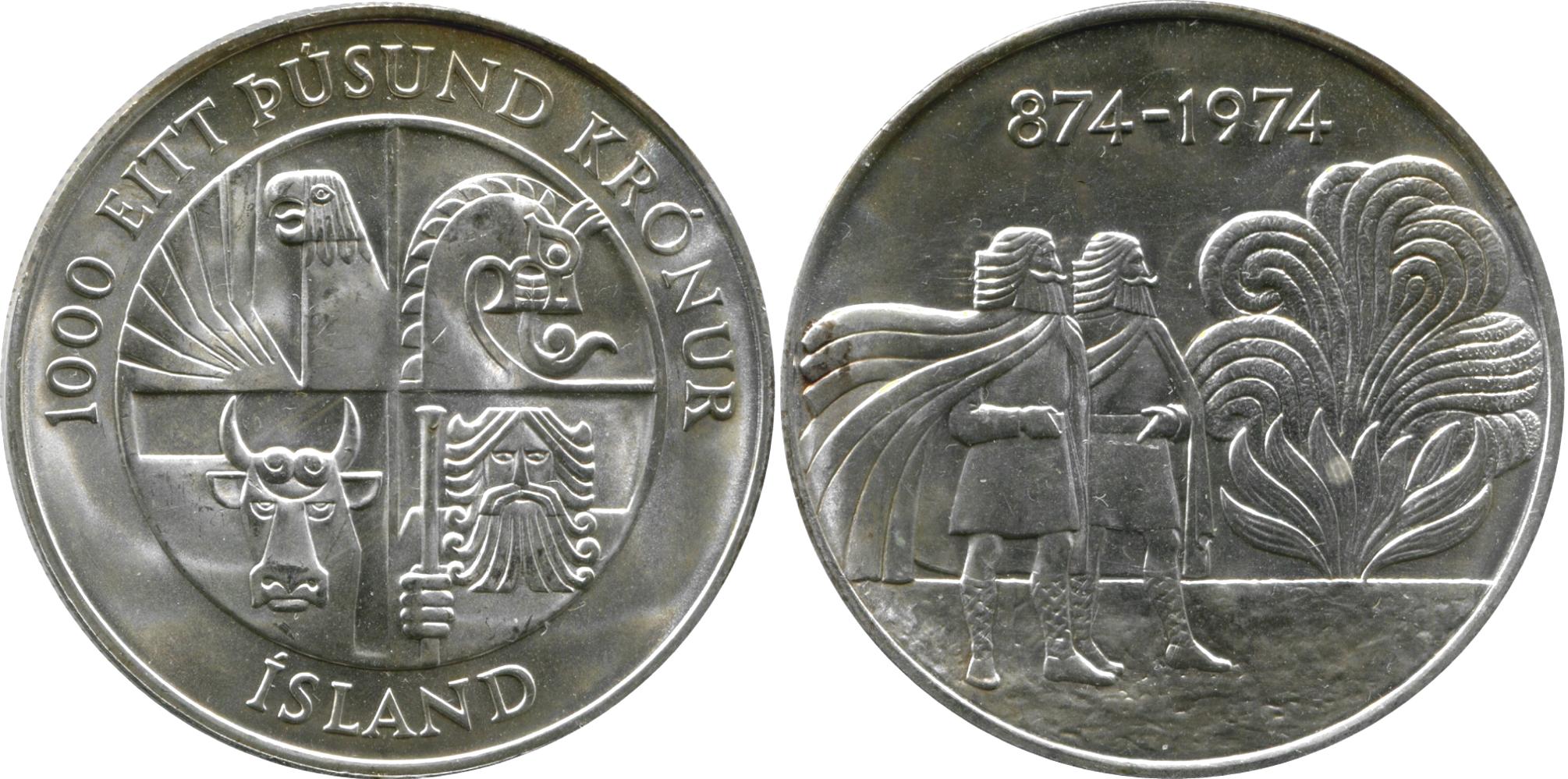
This is an one thousand kronur coin minted in 1974 to commemorate the 1100th anniversary of the first Norse settlement. Weighs 30 grams of 0.925 fineness.
ILES DE FRANCE ET BONAPARTE
These islands are now known as Reunion, a French department, and Mauritius, a republic. They are located in the Indian Ocean east of the island of Madagascar. Prior to and after Napoleonic times they were called Iles de France et Bourbon.
These coins were locally manufactured in 1810 with the silver coins, recovered from the Portuguese brig Ouvidor by the French privateer Pierre Bouvet, and was named Decaen dollar, after the governor of the islands of France and Bonaparte (Mauritius and Reunion Islands). The coins are usually weakly struck in the center on both sides. The denomination is 10 Livres. Weighs 27 grams of 0.896 fineness.
IRAQ
The Republic of Iraq, historically known as
Mesopotamia, is located in the Near East and is bordered by Kuwait, Iran,
Turkey, Syria, Jordan and Saudi Arabia. Mesopotamia was the site of a
number of flourishing
civilizations of antiquity - Sumeria, Assyria, Babylonia, Parthia, Persia and
the Biblical cities of Ur, Nineveh, and and Babylon. Desired because of its
favored location, which embracedthe fertile alluvial plains of the Tigris and
Euphrates Rivers, Mesopotamia - ‘land between the rivers’- was conquered by
Cyrus the Great of Persia, Alexander of Macedonia and by Arabs who made the
legendary city of Baghdad the capital of the ruling caliphate. Suleiman the
Magnificent conquered Mesopotamia for Turkey in 1534, and it formed part of the
Ottoman Empire until 1623, and from 1638 to 1917. Great Britain, given a League
of Nations mandate over the territory in 1920, recognized Iraq as a kingdom in
1922. Iraq became an independent constitutional monarchy presided over by the
Hashemite family, direct descendants of the prophet Mohammed, in 1932. In 1958,
the army-led revolution of 14 July overthrew the monarchy and proclaimed a
republic.
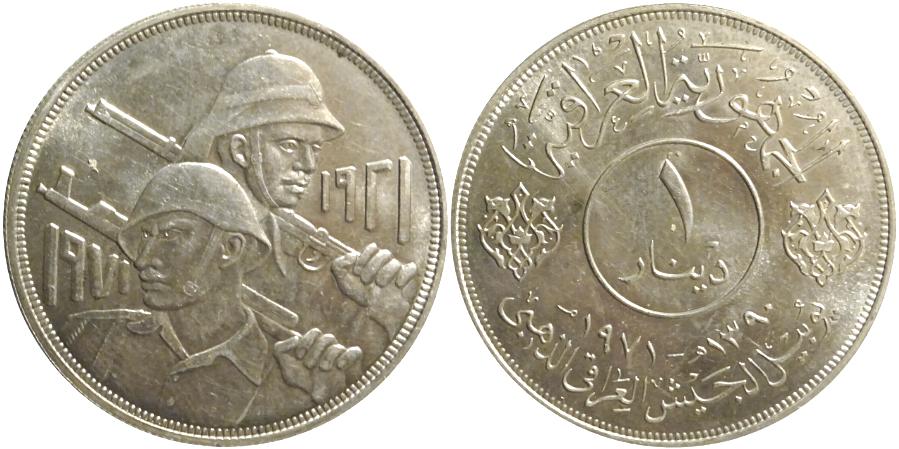
This one Dinar coin was part of a set issued to commemorate the 50th anniversary of the Iraqi Army. The obverse has images of an Iraqi soldier in 1921 and one in 1971 with the Arabic AH dates 1921 and 1871.The reverse has the denomination 1 Dinar (١ دينار) within the circle at center, the country's name IRAQI REPUBLIC (الجمهوريه العراقيه), the dates in AD 1971 and AH 1390 (١٣٩٠هـ-١٩٧١مـ), and the event commemorated GOLDEN JUBILEE OF THE IRAQI ARMY (يوبيل الجيش العراقي الذهبي). Weighs 31 grams of 0.900 fineness.
ISLE OF MAN
The Isle of Man, a dependency of the British Crown, located in the Irish Sea equidistant from Ireland, Scotland and England.
The prevalence of prehistoric artifacts and monuments on the
island give evidence that it’s mild, almost sub-tropical climate was enjoyed by
mankind before the dawn of history. Vikings
came to the Isle of Man during the 9th century and remained until ejected by the
Scottish in 1266. The island came under the protection of the British Crown in 1288,
and in 1406 was granted,
in perpetuity, to the earls of Derby, from whom it was inherited, 1736, by the Duke
of Atholl. The British Crown purchased the rights and title in 1765; the remaining
privileges of the Atholl
family were transferred to the crown in 1829. The Isle of Man is ruled by its own
legislative council and the House of Keys, the oldest, continuous legislative assembly
in the world. Acts of
Parliament passed in London do not affect the island unless it is specifically mentioned.
IOM is a prolific issuer of coinage thanks ton the local Pobjoy Mint.
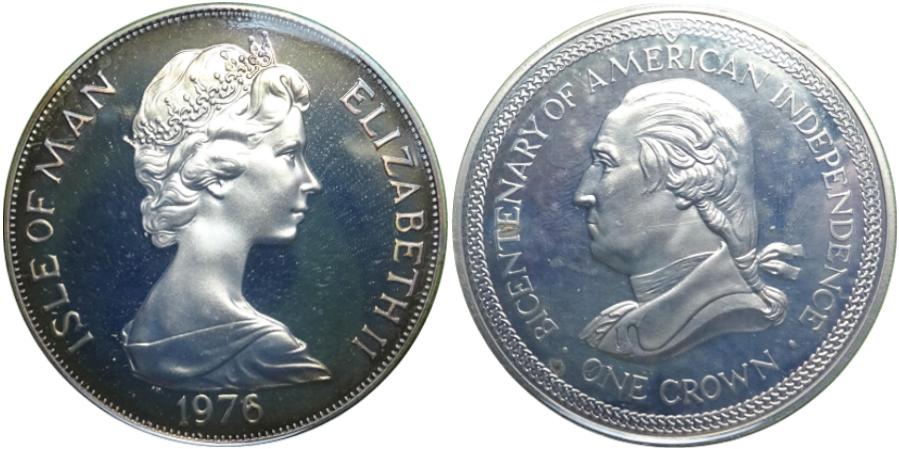
This is an one crown piece issued in 1976 to commemorate the bicentenary of American independence. The obverse has Queen Elizabeth II. The reverse has George Washington. Weighs 28.28 grams of 0.925 fineness.
ISRAEL
The state of Israel is a Middle Eastern republic at the eastern end of the Mediterranean Sea, bounded by Lebanon on the north, Syria on the northeast, Jordan on the east, and Egypt on the southwest. Palestine, which corresponds to Canaan of the Bible, was settled by the Philistines about the 12th century B.C. and shortly thereafter was settled by the Jews who established the kingdoms of Israel and Judah. Because of its position as part of the land bridge connecting Asia and Africa, Palestine was invaded and conquered by nearly all of the historic empires of ancient Europe and Asia. In the l6th century it became a part of the Ottoman Empire. After failing to the British in World War I, it, together with TransJordan, was mandated to Great Britain by the League of Nations, 1922. For more than half century prior to the termination of the British mandate over Palestine, 1948, Zionist leaders had sought to create a Jewish homeland for Jews who were dispersed throughout the world. For almost as long, Jews fleeing persecution had immigrated to Palestine. The Nazi persecutions of the 1930s and 1940s increased the Jewish movement to Palestine and generated international support for the creation of a Jewish state, first promulgated by the Balfour Declaration of 1917, which asserted British support for the endeavor. The state of Israel was proclaimed as the Jewish state in the territory that was Palestine. The remainder of that territory was occupied by Jordanian and Egyptian armies.
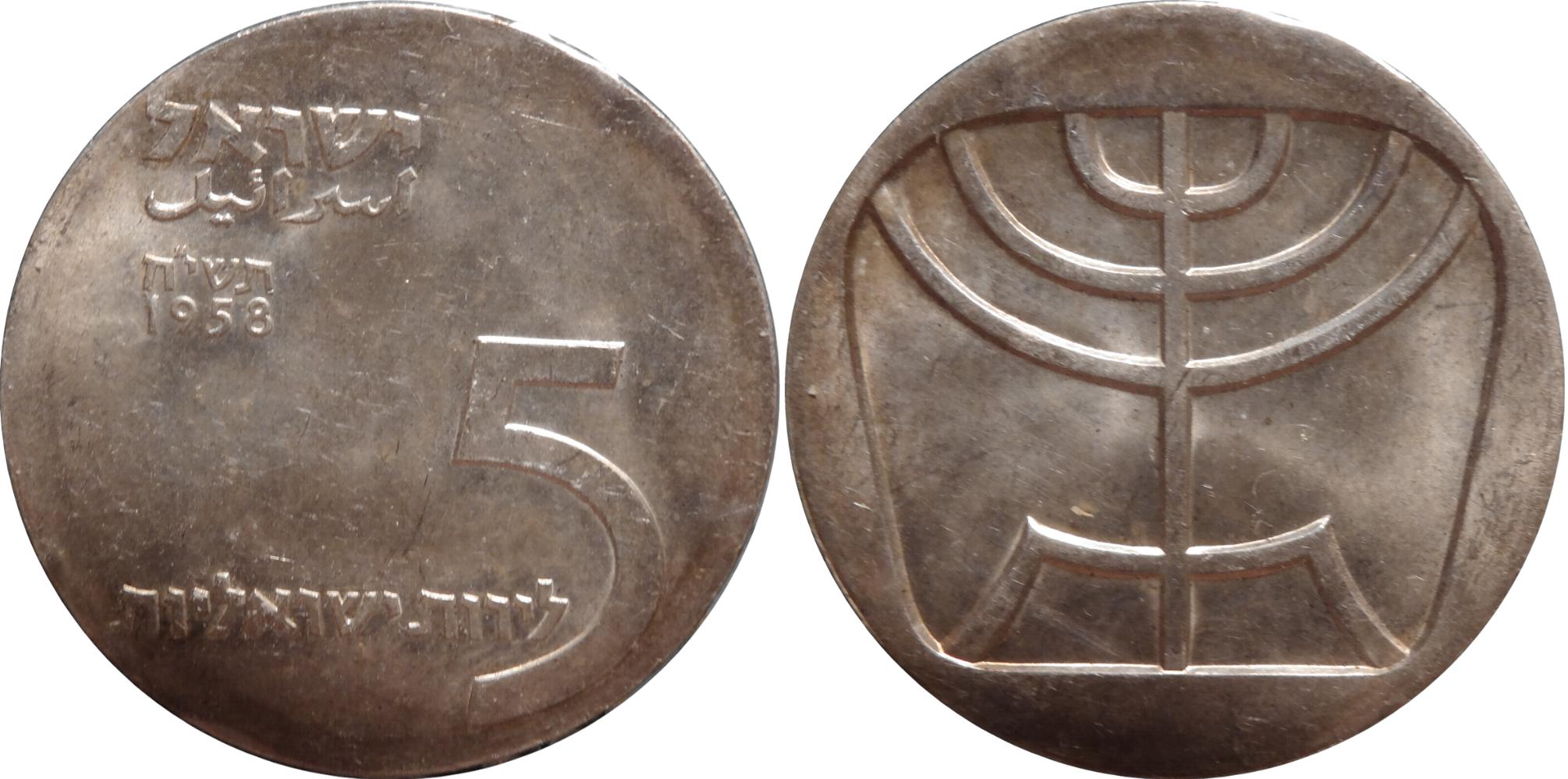
This is a 1958 five Lirot coin. It was issued to celebrate ten years of independence. Weighs 25 grams of 0.900 fineness.
ITALY
From the fall of Rome until modern times, ltaly was little more than a geographical expression. Although nominally Included in the Empire of Charlemagne and the Holy Roman Empire, It as in reality divided into a number of independent states and kingdoms presided over by wealthy families, soldiers of fortune, or hereditary rulers. The 19th century unification movement fostered by Mazzini, Garibaldi and Cavour attained fruition in 1860-70 with the creation of the Kingdom of Italy and the installation of Victor Emmanuel, king of Sardinia, as king of Italy. Benito Mussolini came to power during the post-World War I period of economic and political unrest, and installed a Fascist dictatorship with a figurehead king as titular Head of State. Mussolini entered Italy into the German-Japanese anti-comintern pact (Tri-Partite Pact) and withdrew from the League of Nations. The war did not go well for Italy and Germany was forced to assist Italy in its failed invasion of Greece. The Allied Invasion of Sicily on 10 July 1943 and bombings of Rome brought the Fascist council to a vote of no confidence on 23 July 1943. Mussolini was arrested but soon escaped and set up a government In Salo. Rome fell to the Allied forces in June 1944 and the country was allowed the status of co-belligerent against Germany. The Germans held northern Italy for another year. Mussolini was eventually captured and executed by partisans. Following the defeat of the Axis powers, the Italian monarchy was dissolved by plebiscite, and the Italian Republic proclaimed.
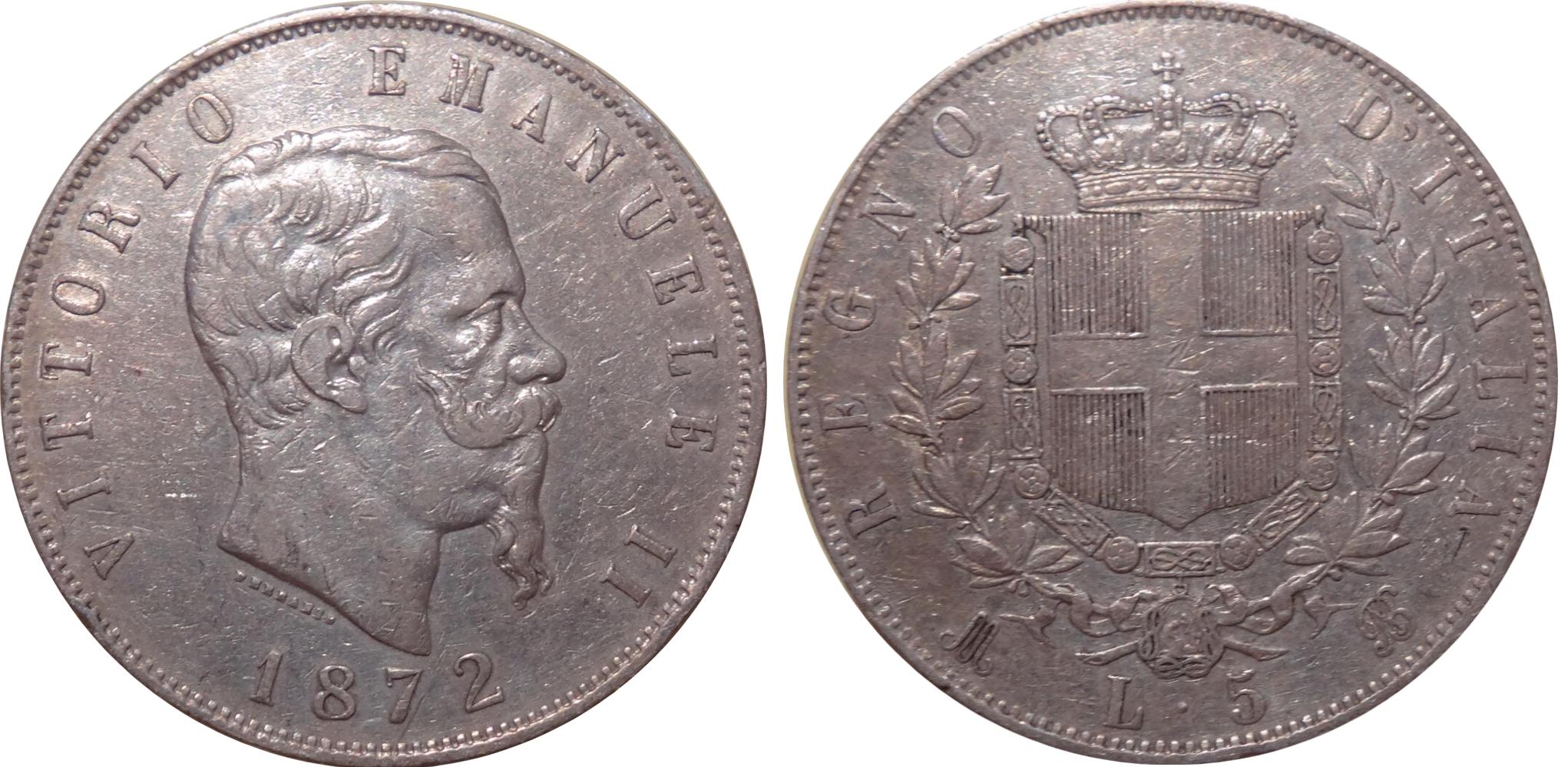
This is a five Lire piece minted in 1872 in Rome. The obverse has King Vittorio Emanuele II. The reverse has Italy's arms. Weighs 25 grams of 0.900 fineness.
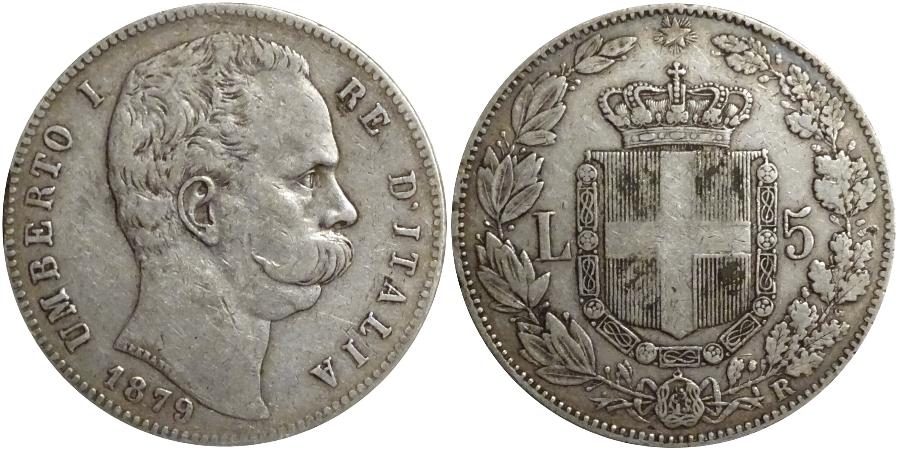
This is a five Lire piece minted in 1879 in Rome. The obverse has King Umberto I. The reverse has Italy's arms. Weighs 25 grams of 0.900 fineness.
KINGDOM OF NAPOLEON
The Kingdom of Italy was a kingdom in Northern Italy (formerly the Italian Republic) in personal union with France under Napoleon I. It was fully influenced by revolutionary France and ended with his defeat and fall. Its governance was conducted by Napoleon and his stepson and viceroy Eugène de Beauharnais. It covered the modern provinces of Lombardy, Veneto, Emilia-Romagna, Friuli, Venezia Giulia, Trentino, South Tyrol, and Marche.
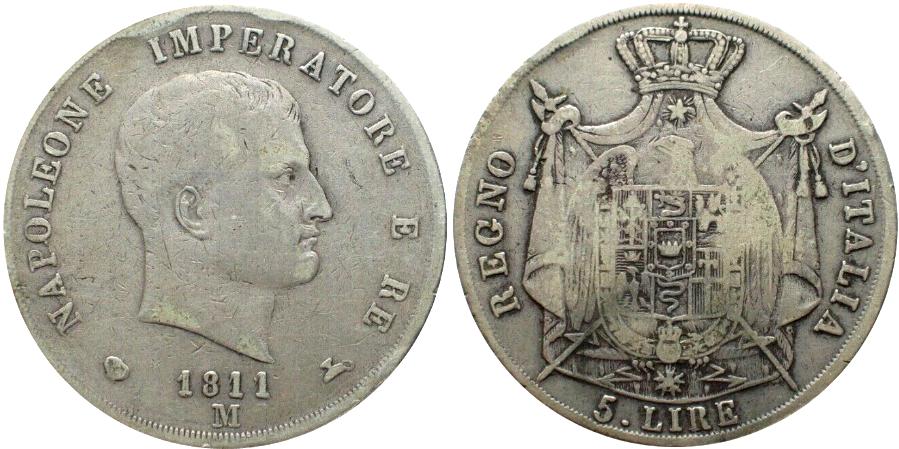
This five Lire piece was minted under Napoleon in 1811 at the Milan mint. Obverse features Napoleon. Reverse has the arms of the kingdom. Weighs 25 grams of 0.900 fineness.
KINGDOM OF THE TWO SICILIES
Sicily lies off the southwestern tip of mainland Italy and is the largest island in the Mediterranean Sea. It has been inhabited for millennia, early on by tribal peoples form various places around the Mediterranean in prehistoric times, followed by Elymians from the Aegean Sea and Phoenicians in the early historical period. Greek colonists began settling in Sicily around 750 BC and their most important urban center was Syracuse. Carthage also founded colonies in the western part of the island and clashes between those enclaves and the Greek area led to the series of conflicts known as the Punic Wars. The Roman Republic eventually intervened and upon defeating Carthage, annexed Sicily as the first Roman province outside of mainland Italy. The history of the island followed that of the Roman Republic and subsequent Empire, falling victim to barbarian invasions as the latter disintegrated. As the Byzantine Empire succeeded the Roman, Sicily came under a new threat in the rise of Mohammedism in North Africa. The Mohammedan conquest of Sicily extended over more than a century as one town or city after another fell during the 9th and 10th centuries. This lasted until the second half of the 11th century, when Normans from northern Europe, who had gained a foothold in southern Italy, eventually conquered the island, culminating in the capture of Palermo in 1072. The Normans established the Kingdom of Sicily and the island was ruled from that time on by a succession of European dynasties. The Spanish gained control of the island and the southern half of Italy by the 15th century and in the 18th century, a branch of the Bourbon dynasty ruled in both Sicily and Naples, usually as separate entities. After the Napoleonic Wars, Sicily and Naples were permanently united in the Kingdom of the Two Sicilies from 1816 until 1860. It was annexed by Sardinia-Piedmont in the latter year and became part of united Italy in 1861.

This five Lire piece was issued during the French occupation, Featured is Joachim Murat, a Marshall of France who was designated by Napoleon as king. Obverse has Murat (he was married to Napoleon's sister). Reverse has the national arms. Weighs 25 grams of 0.900 fineness.
LOMBARDY
Comprised the northern Italian duchies of Milan and Mantua were absorbed into the Kingdom of Napoleon in 1805. After Napoleon's fall they were awarded to Austria and incorporated into the Habsburg monarchy as the Kingdom of Lombardy-Venetia. Lombardy revolted against Austrian rule in 1848 and established a free provisional government. The Lombard campaign of 1859 restored rule under the Kingdom of Italy for Lombardy in 1859 and Venetia in1866.
This is a five Italian Lire piece minted at the Milan mint (mintmark M) in 1848 by the Provisional Government of Lombardy. Weighs 25 grams of 0.900 fineness..
LUCCA & PIOMBINO
A town in Tuscany and the residence of a marquis,
was nominally a fief but managed to maintain a de facto independence until awarded
by Napoleon to his sister Elisa in 1805. In 1814 it was occupied by the Neapolitans,
from 1817 to 1847 it was a duchy of the queen of Etruria, after which it became
a division of Tuscany.
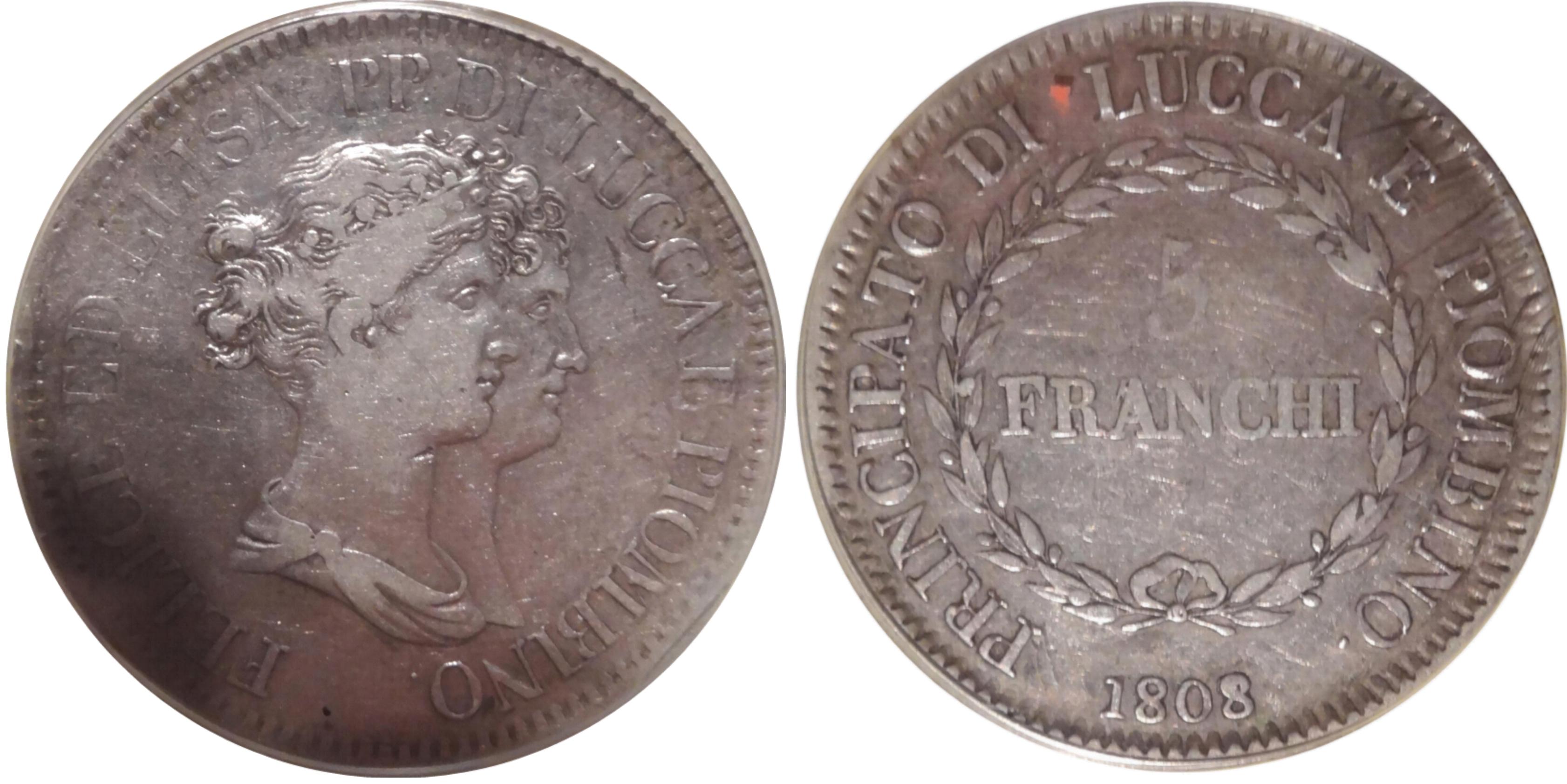
This is a five Franchi coin of 1808/7 featuring Elisa Bonaparte and her spouse Felix Bacciocchi. This is the overdate variety. Weighs 25 grams of 0.900 fineness.
MILAN
The principal city in northern Italy and the second largest city of the modern republic, Milan is located in Lombardy, south of the foothills of the Alps. It is of ancient Gaulic tribal foundation, conquered by Rome in 222 BC and named Mediolanum. Sacked by Attila in 452 and destroyed by the Goths in 539, the city belonged to the Kingdom of the Lombards after being rebuilt and later, belonged to the Germanic Empire. Various families ruled the city in the later Middle Ages and it was also a republic for periods in the 13th, 14th and 15th centuries. The Visconti family became Lords of Milan in the early 14th century and the form of government was changed from elective to hereditary, the lord being raised to the rank of duke in 1395. In 1450, Francesco I Sforza inherited the duchy through marriage to the Visconti heiress and the Sforza's began to enhance the power and prestige of Milan. The city became a pawn in the power struggles between France and the Habsburgs, passing to the control of Spain in 1535, then to Austria in 1740. Conquered by France in 1796, Milan formed part of the Cisalpine Republic from 1797 then the Italian Republic in 1802 and of the Kingdom of Italy from 1805 until 1814. In the latter year, Milan was ceded to Austria and became part of Lombardy-Venetia. In 1859, the city and territory was annexed to Sardinia, becoming part of united Italy.
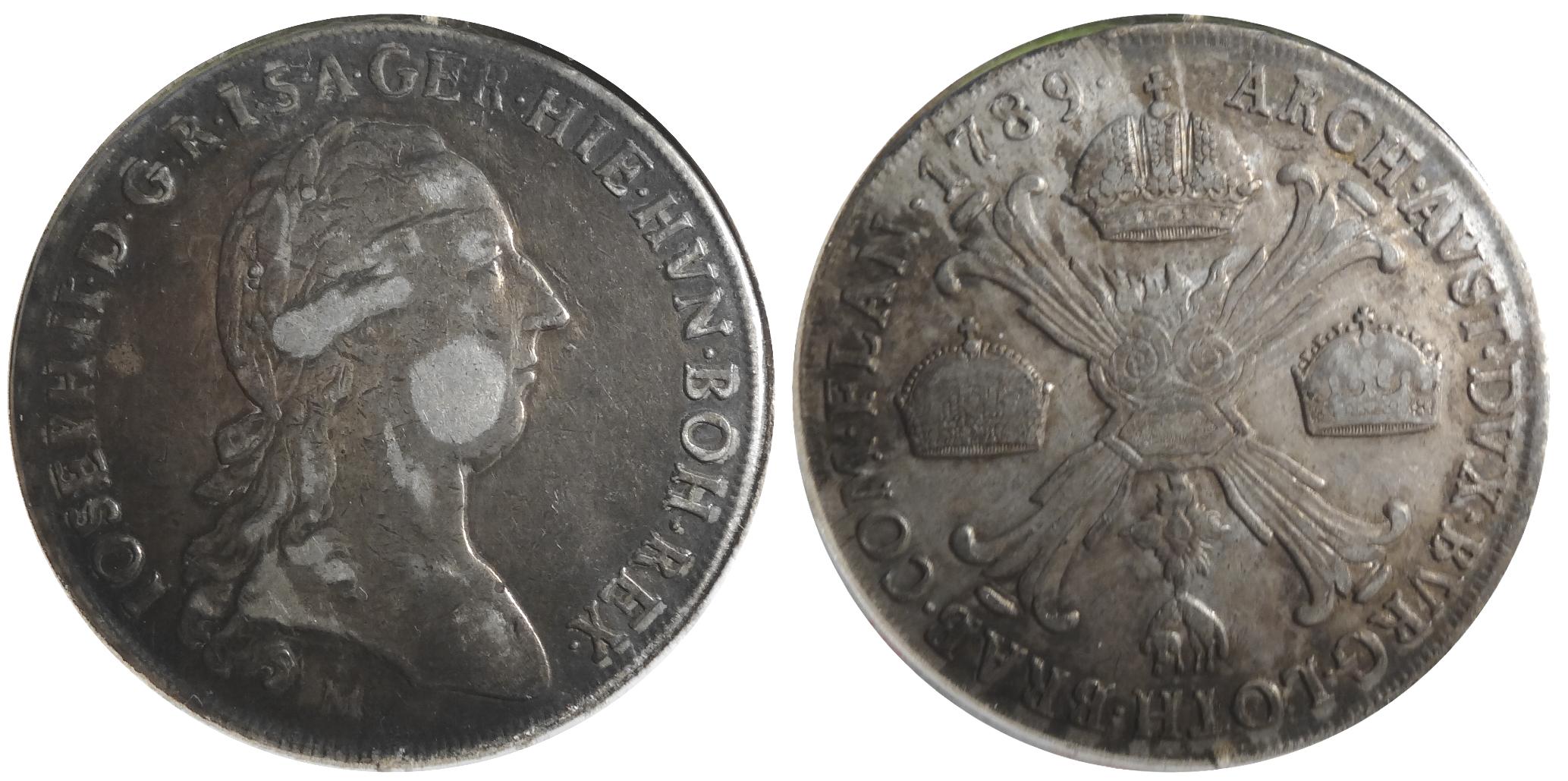
This is a Crocione, the Italian name for a Kronenthaler (crown dollar). It was minted in Milan in 1789 and depicts Joseph II of Austria. The mintmark M is below the bust. Weighs 29 grams of 0.7830 fineness.
NAPLES (KINGDOM OF TWO SICILIES)
The Kingdom of Naples existed as a political entity
for most of the period from the late 12th century to the middle of the 19th century.
Throughout almost 700 years of its existence, the kingdom was ruled by dynasties
from other countries, with periods of stability punctuated by the vicissitudes of
war, famine, pestilence and civil strife. The kingdom took its name from that of
the principal city of southern Italy, one of the oldest inhabited urban centers
in the world. Founded as a Greek colony in the 9th-8th century BC as Neapolis (New
City), Naples became part of the Roman Republic about 300 BC and was a major metropolitan
region of the Roman Empire. The city was the capital of a duchy from the mid-6th
century until the Normans, who had conquered Sicily earlier in the 12th century,
took control and united the Neapolitan territories to their island. The geographical
extent of the kingdom covered most of southern Italy and Sicily during periods when
the two parts were united. Naples came under the control of Aragon in the mid-15th
century, was briefly taken by France in the early 16th century, and then ruled by
the Spanish Habsburgs until 1714, at the end of the War of the Spanish Succession.
For a brief time in 1647-48, a Neapolitan Republic was created, under the patronage
of Duke Henri of Lorraine, as the result of a revolt against the Spanish viceroys.
Austria ruled Naples in the early 18th century until a branch of the Spanish Bourbon
dynasty was installed in 1734. During the Napoleonic period, a short-lived Parthenopean
Republic was proclaimed in 1799 on the French model. The Bourbon king was briefly
restored, only to be defeated by Napoleon himself, who then placed his own brother
as monarch in the kingdom. After the defeat of Napoleon, the Bourbons were restored
once again and Naples was formally united to Sicily in 1816 as the Kingdom of the
Two Sicilies. It was annexed by Sardinia-Piedmont in 1860 and became part of united
Italy in 1861.
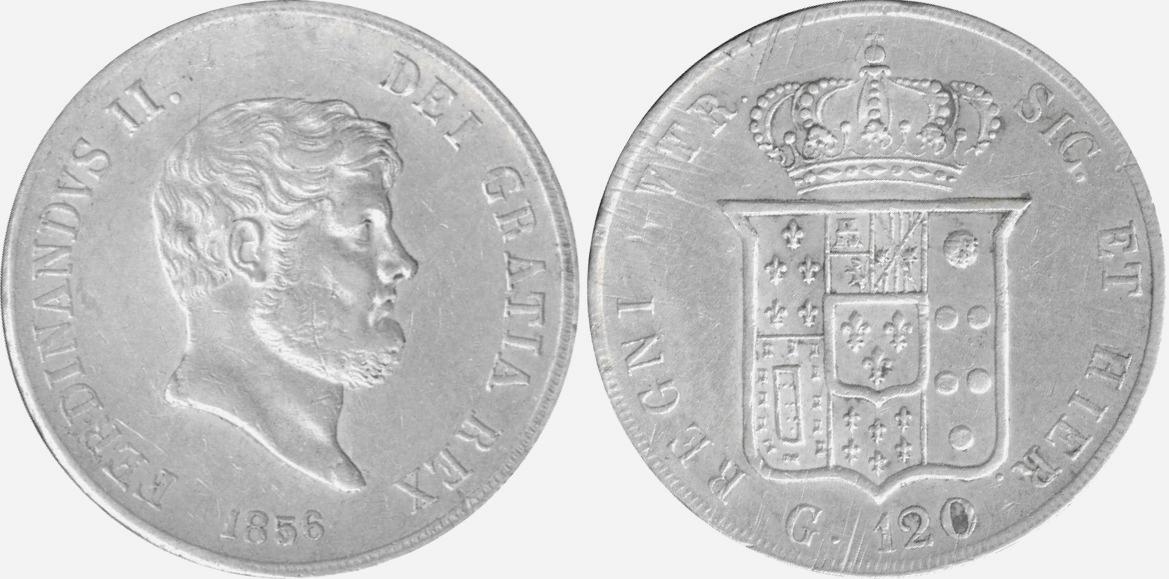
This is a 120 grana piece minted in 1856. In those days, planchets (coin blanks) were weighed before striking and if overweight, they were filed down to the correct weight. This coin shows these marks (called adjustment marks) on the reverse. Weighs 27.5 grams of 0.833 fineness.
PAPAL STATES
During many centuries prior to the formation of the
unified Kingdom of Italy, when Italy was divided into numerous independent papaI
and ducal states, the Popes held temporal sovereignty over an area in central Italy
comprising some 17,000 sq. mi. (44,030 sq. km.) including the city of Rome. At the
time of the general unification of Italy under the Kingdom of Sardinia, 1861, the
papal dominions beyond Rome were acquired by that kingdom diminishing the Pope's
sovereignty to Rome and its environs. In 1870, while France's opposition to papal
dispossession was neutralized by its war with Prussia, the Italian army seized weakly
defended Rome and made it the capital of Italy, thereby abrogating the last vestige
of papal temporal power. In 1871, the Italian Parliament enacted the Law of Guarantees,
which guaranteed a special status for the Vatican area, and spiritual freedom and
a generous income for the Pope. Pope Pius IX and his successors adamantly refused
to acknowledge the validity of these laws and voluntarily "imprisoned" themselves
in the Vatican. The impasse between State and Church lasted until the signing of
the Lateran Treaty, 11 Feb. 1929, by which Italy recognized the sovereignty and
independence the new Vatican City state.
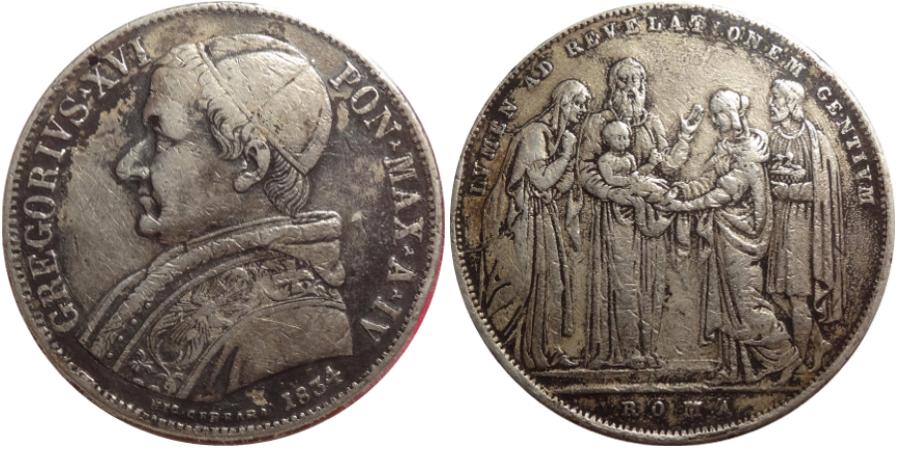
This is a one Scudo coin minted in Rome in 1834 by the Papal States. The obverse has Pope Gregory XVI with the legend GREGORIVS·XVI PON·MAX·A·III and the engraver NIC. CERBARA at the bottom. The reverse has the Holy Family presenting Jesus at the temple with the legend LVMEN AD REVELATIONEM GENTIVM and ROMA at the bottom. Weighs 26.43 grams of 0.917 fineness.
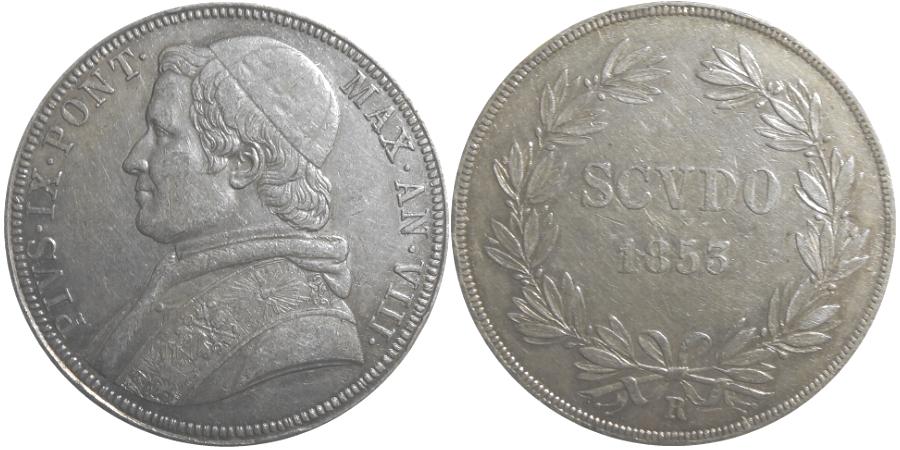
This is an one Scudo coin minted in Rome in 1853 by the Papal States. The obverse has Pope Pius IX with the legend PIVS • IX • PONT • MAX • AN • VIII •. The reverse has denomination, data and R mintmark. . Weighs 28.87 grams of 0.900 fineness.
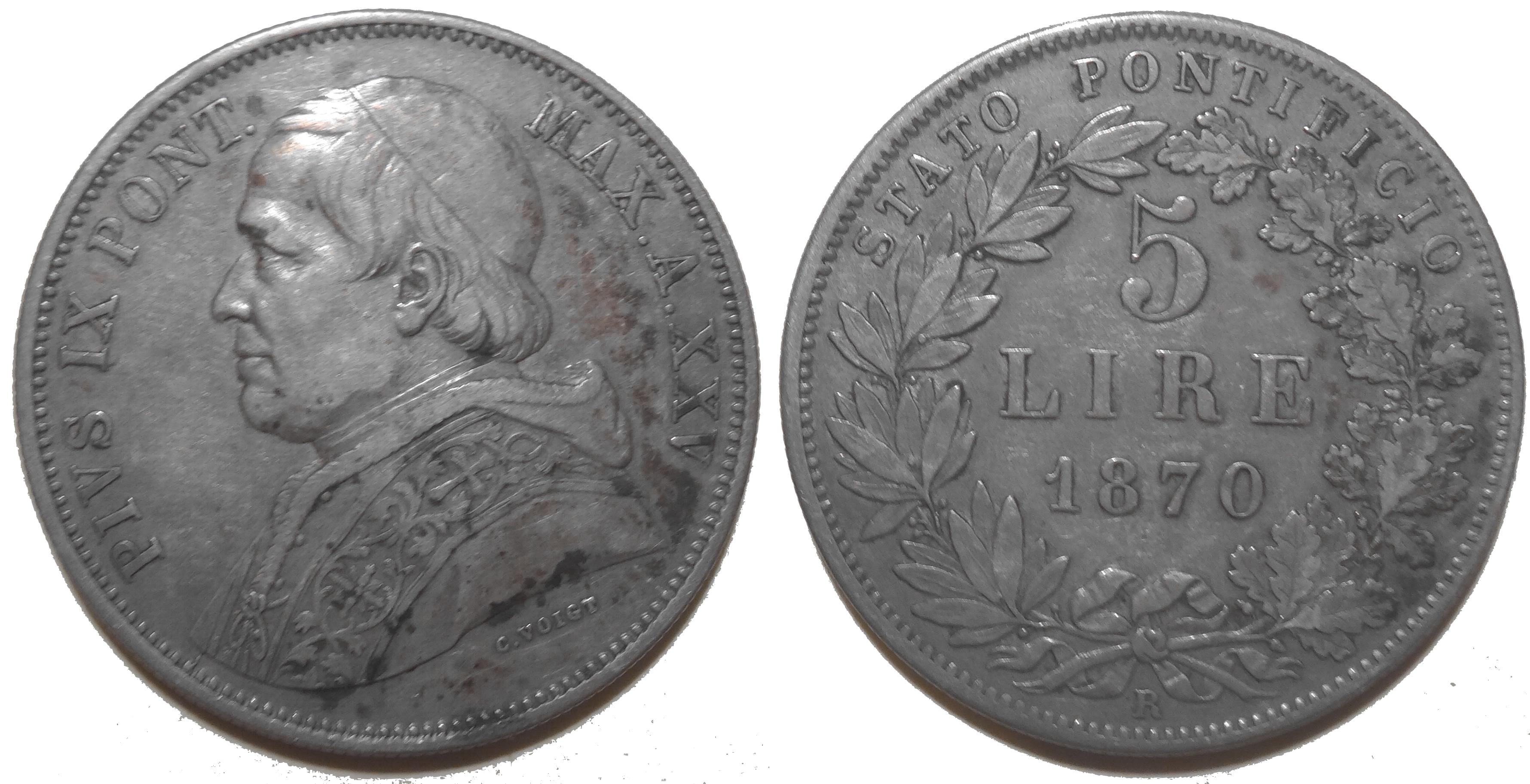
This is a five Lire coin minted in Tome by the Papal States. The obverse has Pope Pius IX. Weighs 25 grams of 0.900 fineness.
PIEDMONT REPUBLIC
Established by Napoleon in 1798 in the Piedmont area of northwest Italy. It was the mainland possession of the kingdom of Sardinia. The republic was overthrown by Austro-Russian forces in 1799. It was reestablished as the Subalpine Republic, after Napoleon took back much of northern Italy after the victorious Battle of Marengo. The Subalpine Republic lasted until 11 September 1802, when it was divided between the French and Italian Republics.
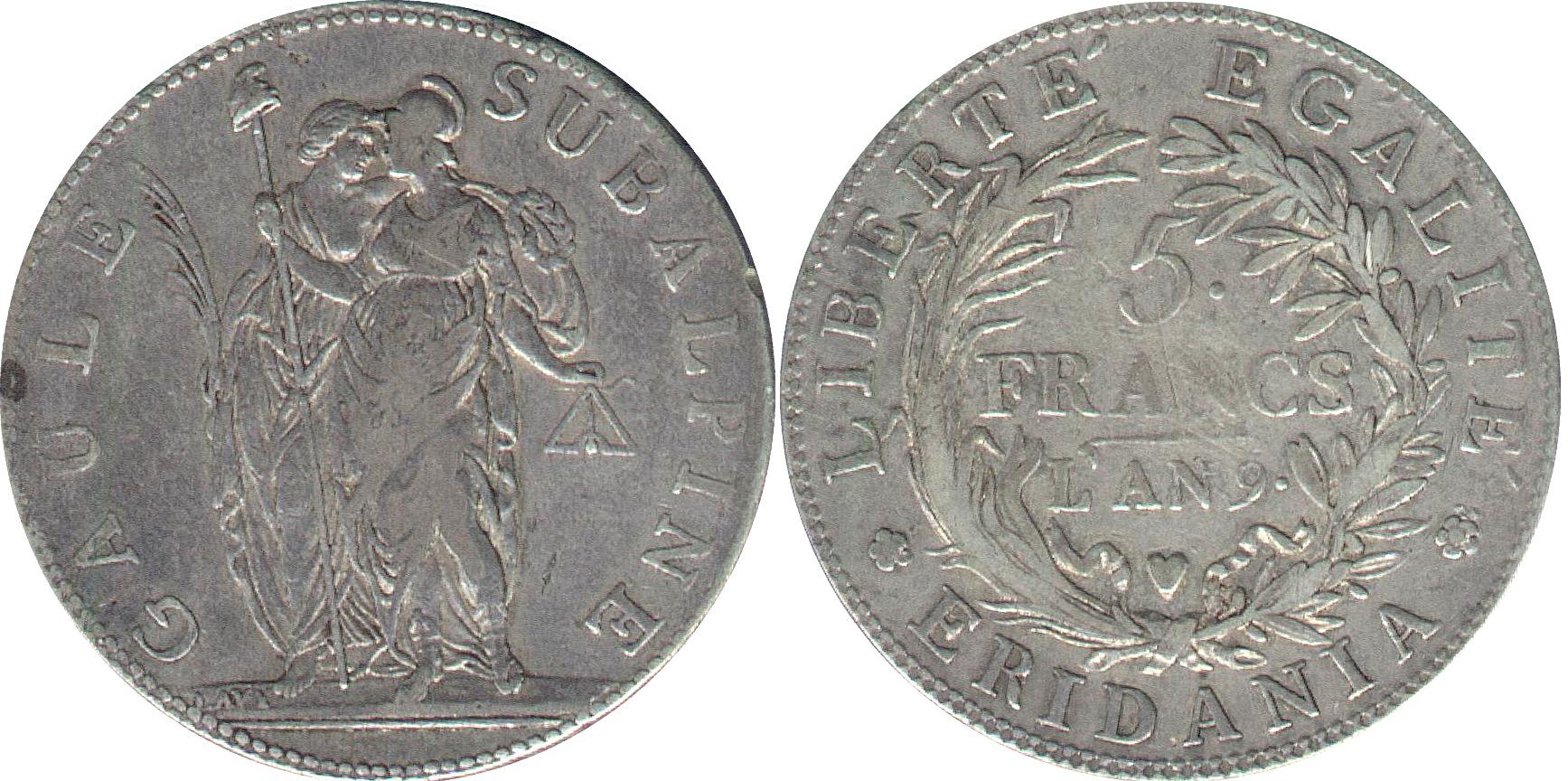
This is the single 5 Franc piece produced for this republic in 1801. The coin is dated L'AN 9 which is the 9th year of the French revolutionary calendar.. Weighs 25 grams of 0.900 fineness.
SARDINIA
Sardinia is an island located in the Mediterranean Sea, west of the southern Italian peninsula. Along with some minor islands, it constitutes an autonomous region of Italy separated on the north from Corsica, France by the Strait of Bonifacio. Settled by Phoenicians and Greeks before it came under control of Carthage about 600 BC; taken by the Romans in 238 BC; part of the Vandal Kingdom during the 5th century; re-conquered by the Byzantine Empire in 533 AD. From the 8th century, it was frequently raided by Muslims, but that threat was eliminated by Pisa in 1016 as the object of a competitor's bet. The Genoese and Pisans were driven out by the Aragonese during the 14th-15th centuries, remaining under Spanish rule until 1708; held by Austria 1708-17, regained by the Spanish in 1717 until it was finally ceded to Savoy in 1720 in exchange for Sicily. The combined territories of Savoy (Piedmont) and Sardinia were known henceforth as the Kingdom of Sardinia or Sardinia-Piedmont. As a result of Napoleon's invasion of Italy and his restructuring of the states in various regions, Carlo Emanuele IV abdicated in favor of his brother, Vittorio Emanuele I in 1802. As a result of the political upheavals of the 1850s in Italy, Vittorio Emanuele II was elected king of united Italy in 1859 and assumed the title in 1861.
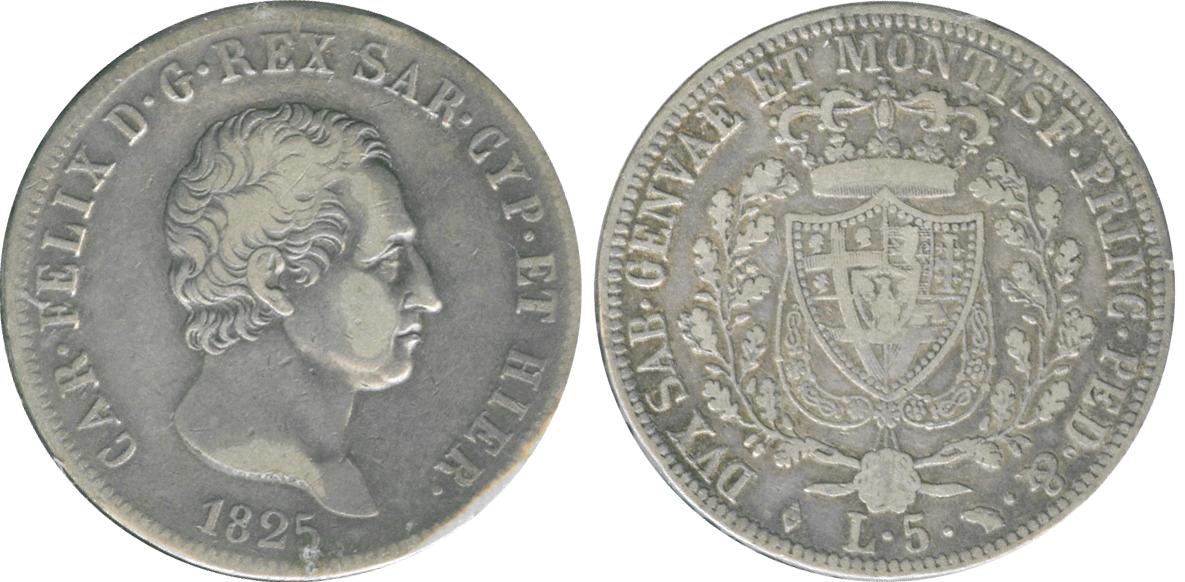
This is a five Lire coin minted in 1825 in Torino (mintmark is on reverse L in diamond to the left of L-5). The coin features King Carlo Felice with his title CAR·FELIX D·G·REX SAR·CYP·ET HIER·. The reverse has the kingdom's arms with the legend DVX SAB·GENVAE ET MONTISF·PRINC·PED·&· (Duke of Savoy, Genoa, Montferrat, Prince of Piedmont) and the denomination flanked by the mintmark and the assayer's symbol. The edge has FERT - FERT - FERT which is the House of Savoy's motto Fortitudo Eius Rhodum Tenuit. Weighs 25 grams of 0.900 fineness.
VENICE
The ‘Queen of the Adriatic', Venice grew from
small settlements of refugees fleeing the waves of Germanic and Hun invasions during
the 5th and 6th centuries, to become one of the great maritime powers of the Mediterranean
in the following centuries. Early in the 8th century, the people living around the
lagoons fearing further conquests by the Lombards, elected their first duke, Ursus,
who is recognized as being the first Doge of Venice. At the beginning of the 9th
century, the seat of the doge was moved to the Rialto and the first ducal palace,
as well as the basilica of St. Mark were constructed. Charlemagne recognized Venice
as part of Byzantine territory in Italy and the city’s trading rights along the
Adriatic coast. When Venice acquired the purported relics of St. Mark from Alexandria
in 828. its position as one of the major city-states of the Mediterranean was firmly
fixed. As the city’s commercial and naval power expanded during the next few centuries.
Venice gradually gained control of other coasts and islands along the Adriatic and
in the Eastern Mediterranean. Venice became an imperial power as a result of the
Fourth Crusade in 1204, when it financed the Latin takeover of Constantinople and.
by the late 13th century, was the most prosperous city in all of Europe. When the
printing press made its appearance in Germany in the mid-15th century. Venice was
quick to adopt the invention and became the printing capital of Europe by 1482.
The wealth of the city’s commercial and political families financed the building
of magnificent palaces and churches, as well as supported much of the art of the
Renaissance in that part of Italy. The city began to decline at the same time, due
in part, to the Turkish conquest of the Byzantine Empire and the subsequent loss
of some territories in the Eastern Mediterranean. The discovery of the New World
and the all-sea route to India destroyed the city’s trade monopoly. By the time
Napoleon conquered Venice and deposed the last doge in 1797, thus ending eleven
centuries of the Republic, the city held only a remnant of its former territory
and power, but still gloried in its many exquisite buildings and canals. Napoleon
signed over control of Venice to Austria in the same year, but it became a part
of his Kingdom of Italy in 1805. After Napoleon's defeat in 1814. Venice was returned
to Austria as part of Lombardy-Venetia.
Venice was swept up in the revolutionary tide crashing over the peninsula
and the continent in 1848-49. Following the Third
Italian War of Independence in 1866. Venice became a permanent part of the new Kingdom
of Italy.
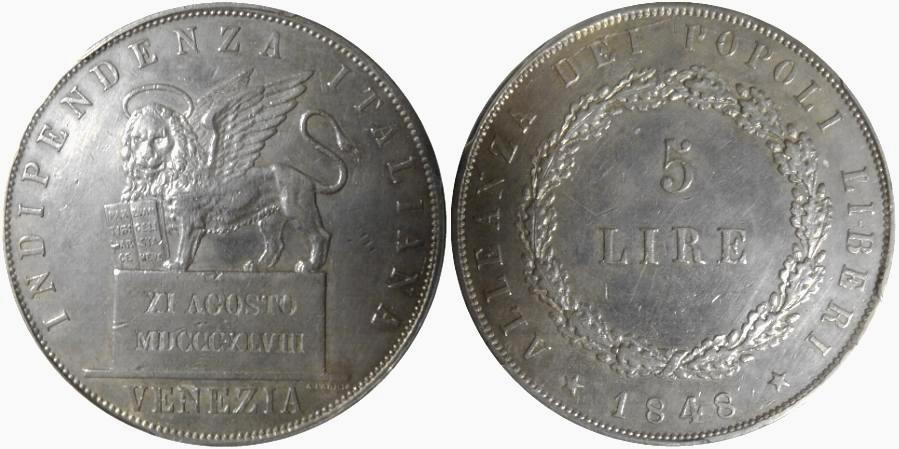
This five Lire coin was issued in 1848 by the Provisional Government. The obverse has the arms of the city with the motto INDIPENDENZA ITALIANA. The reverse has the denomination with the legend ALLEANZA DEI POPOLI LIBERI. Weighs 25 grams of 0.900 fineness.
JAMAICA
Jamaica was discovered by Columbus on 3 May 1494, and settled by Spain in 1509. The island was captured in 1655 by a British naval force under the command of Admiral William Penn, sent by Oliver Cromwell and ceded to Britain by the Treaty of Madrid, 1670. For more than 150 years, the Jamaican economy of sugar, slaves and piracy was one of the most prosperous in the new world. Dissension between the property-oriented island legislature and the home government prompted parliament to establish a crown colony government for Jamaica in 1866. From 1958 to 1961 Jamaica was a member of the West Indies Federation, withdrawing when Jamaican voters rejected the association. The colony attained independence on 6 Aug. 1962. Jamaica is a member of the Commonwealth of Nations. Elizabeth II is the Head of State, as Queen of Jamaica.
In 1758, the Jamaican Assembly authorized stamping a certain amount of Spanish milled
coinage. Token coinage by merchants aided the island's monetary supply in the early
19th century. Sterling coinage was introduced in Jamaica in 1825, with the additional
silver three halfpence under William IV and Victoria. Certain issues of three pence
of William IV and Victoria were intended for colonial use, including Jamaica, as
were the last dates of three pence for George VI. There was an extensive token and
work tally coinage for Jamaica in the late 19th and early 20th centuries. A decimal
standard currency system was adopted on 8 Sept. 1969.
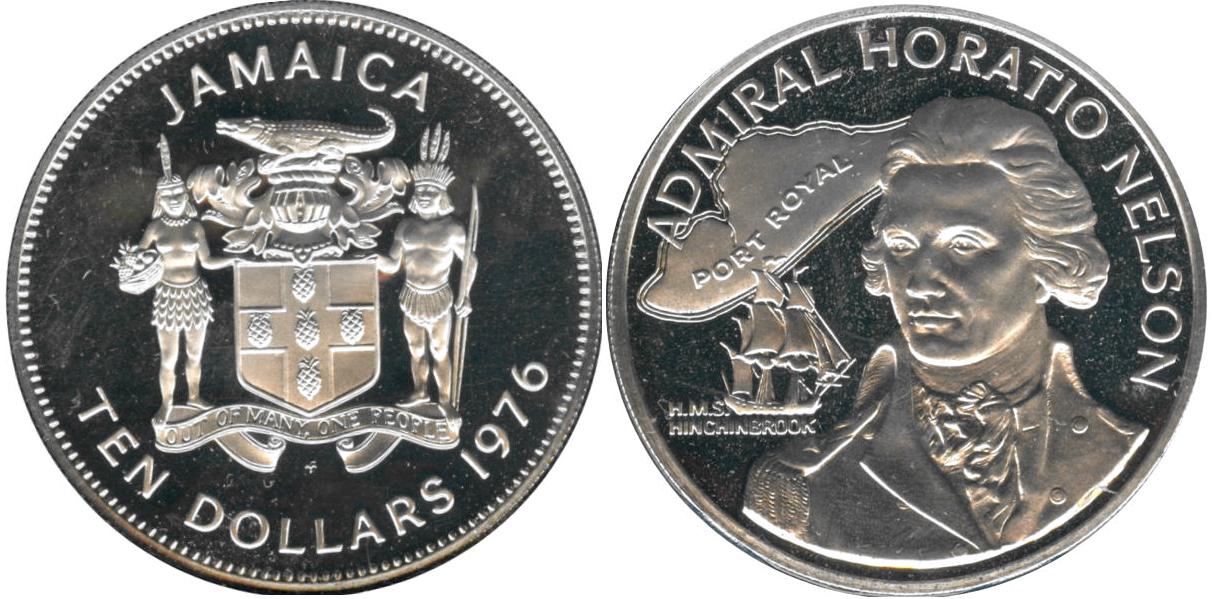
This is a ten Dollar coin issued in 1976 to honor Admiral Nelson. This is a larger than usual coin weighing 42.6 grams of 0.925 fineness minted by the Franklin Mint...
JAPAN
Japan, founded (so legend holds) In 660 BC by a direct descendant of the Sun Goddess, was first brought into contact with the west by a storm-blown Portuguese ship in 1542. European traders and missionaries proceeded to enlarge the contact until the Shogunate, sensing a military threat in the foreign presence, expelled all foreigners and restricted relations with the outside world in the 17th century. Alter Commodore Perry's U.S. flotilla visited in 1854, Japan rapidly industrialized, abolished the Shogunate and established a parliamentary form of government, and by the end of the 19th century achieved the status of a modern economic and military power. A series of wars with China and Russia, and participation with the allies in World War I, enlarged Japan territorially but brought its interests into conflict with the Far Eastern interests of the United States, Britain and the Netherlands, causing it to align with the Axis Powers for the pursuit of World War II. Alter its defeat in World War II, General Douglas MacArthur forced Japan to renounce military aggression as a political instrument, and he Instituted constitutional democratic self-government. Japan quickly gained a position as an economic world power.
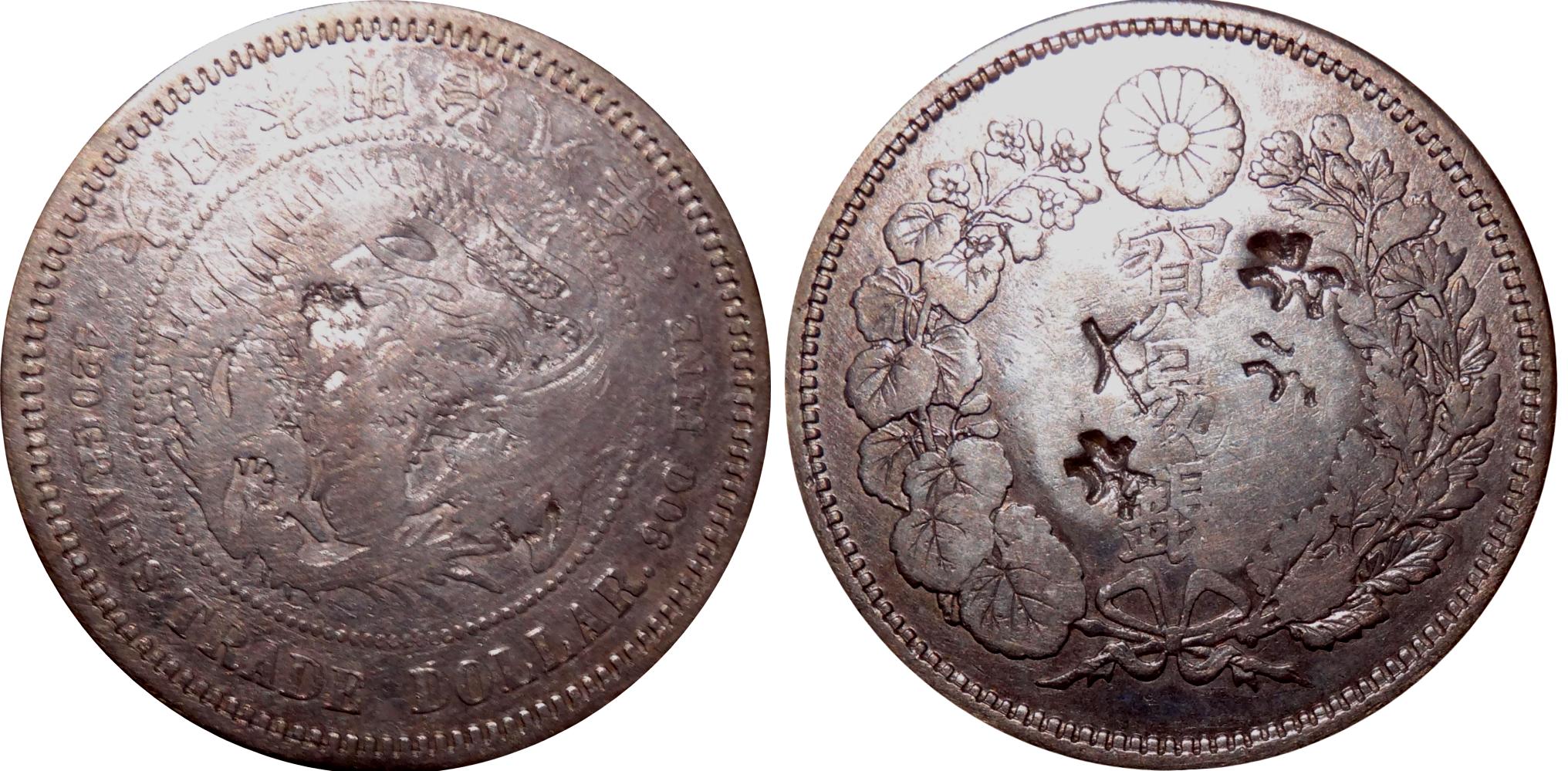
This is a Trade Dollar minted in Meiji 9 (!875). This coin has been validated by Chinese merchants who put their chop marks on the coin. Weighs 27.2 grams of 0.900 fineness.
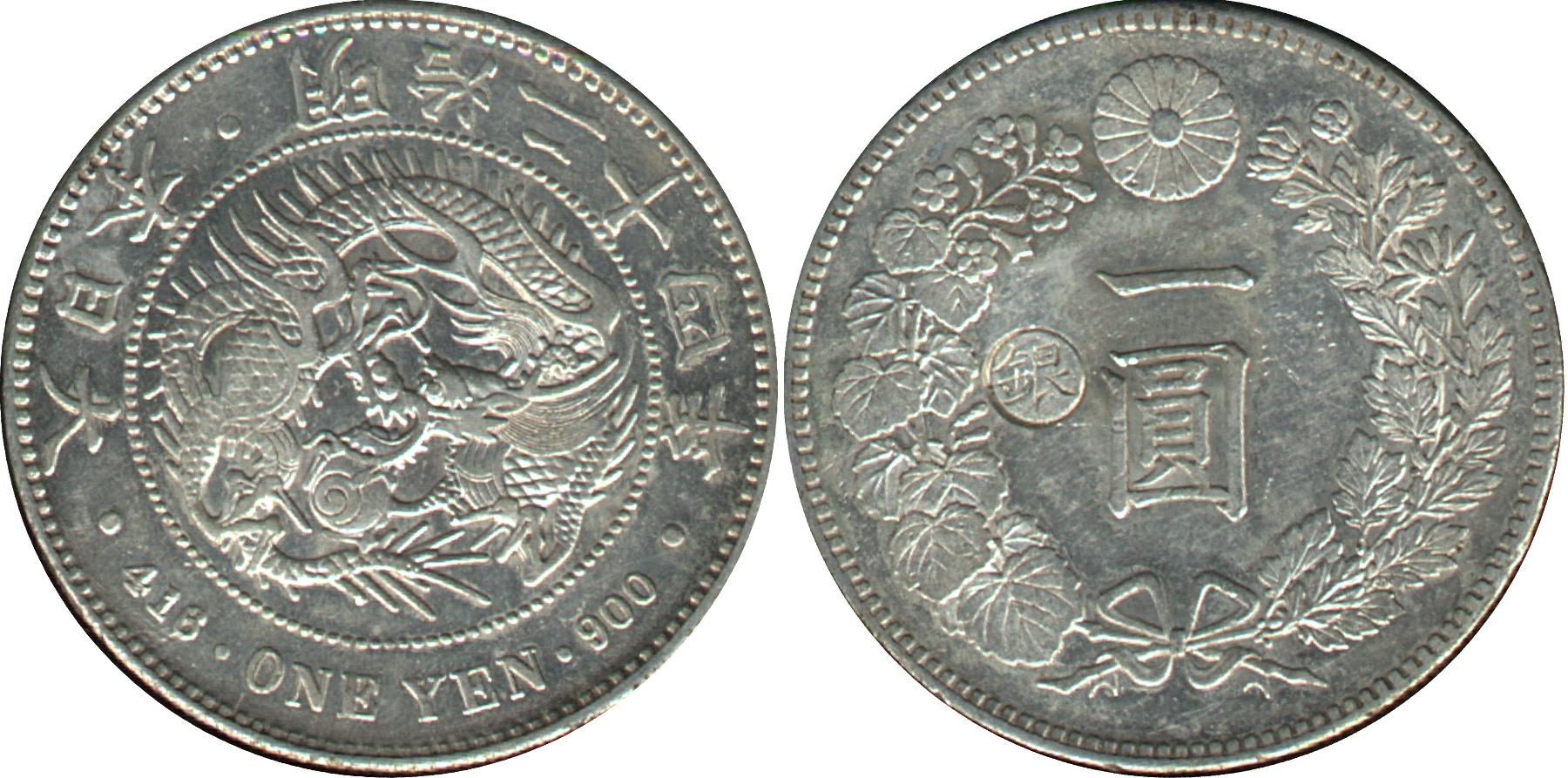
This is an one Yen coin minted at the Osaka mint in Meiji 24. The reverse has the Gin (silver) mark at left. Weighs 27 grams of 0.900 fineness.
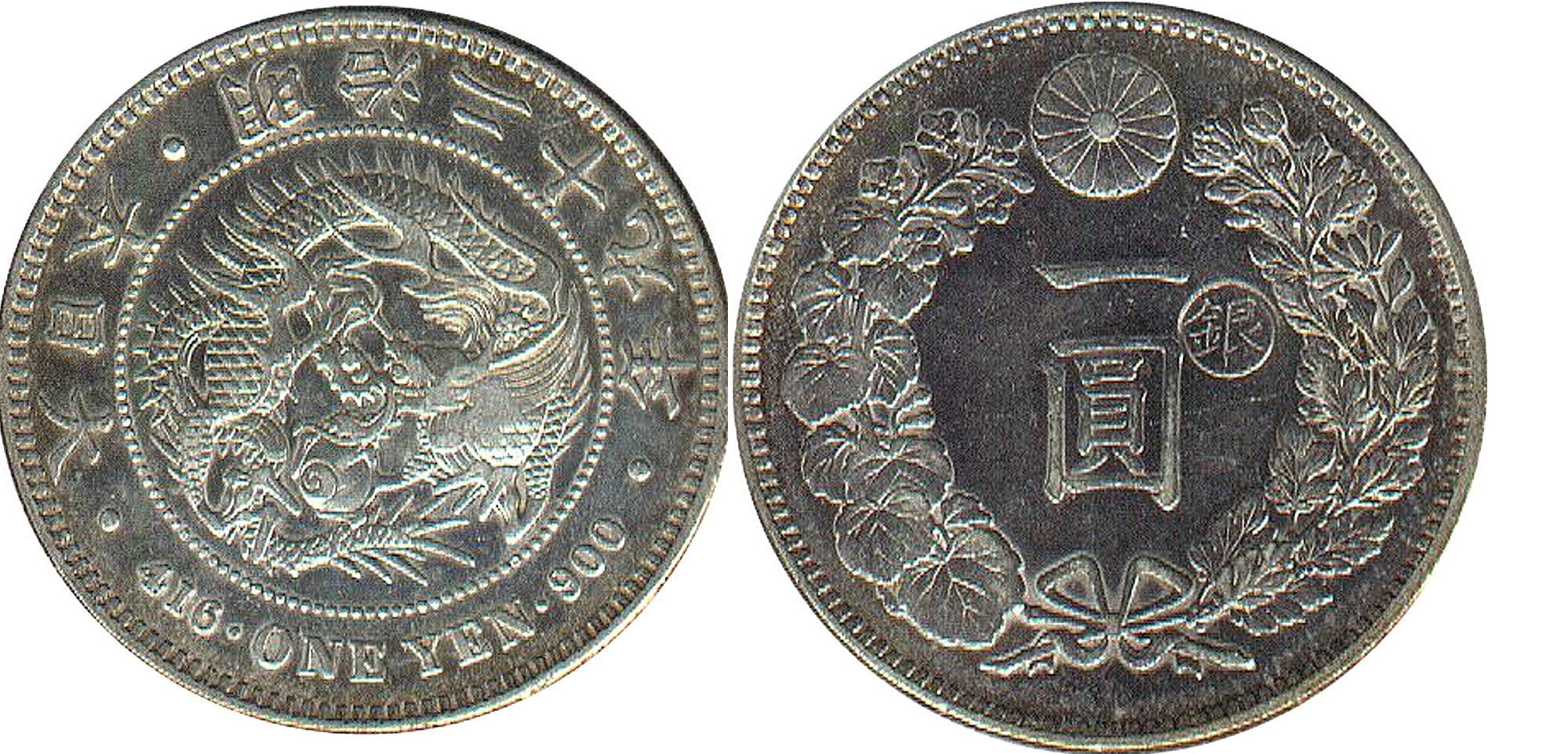
This is an one Yen coin minted at the Edo (Tokyo) mint in Meiji 249 The reverse has the Gin (silver) mark at right. These are normally attributed to circulate in Taiwan, then a Japanese territory. Weighs 27 grams of 0.900 fineness.
KIRIBATI
The Republic of Kiribati (formerly the Gilbert Islands), consists of 30 coral atolls and islands spread over more than one million sq. mi. (2,590,000 sq. km.) of the southwest Pacific Ocean. In addition to the Gilbert Islands proper, Kiribati includes Ocean Island, the Central and Southern Line Islands, and the Phoenix Islands, though possession of Canton and Enderbury of the Phoenix Islands is disputed with the United States. Most families engage in subsistence fishing. Copra and phosphates are exported, mostly to Australia and New Zealand. The Gilbert Islands and the group formerly called the Ellice Islands (now Tuvalu) comprised a single British crown colony, the Gilbert and Ellice Islands. Spanish mutineers first sighted the islands in 1537, succeeding visits were made by the English navigators John Byron (1764), James Cook (1777), and Thomas Gilbert and John Marshall (1788). An American, Edward Fanning, arrived in 1798. Britain declared a protectorate over the Gilbert and Ellice Islands, and in 1915 began the formation of a colony which was completed when the Phoenix Islands were added to the group in 1937. The Central and Southern Line Islands were administratively attached to the Gilbert and Ellice Islands colony in 1972, and remained attached to the Gilberts when Tuvalu was created in 1975. The colony became self-governing in 1971. Kiribati attained independence on 12 July 1979.
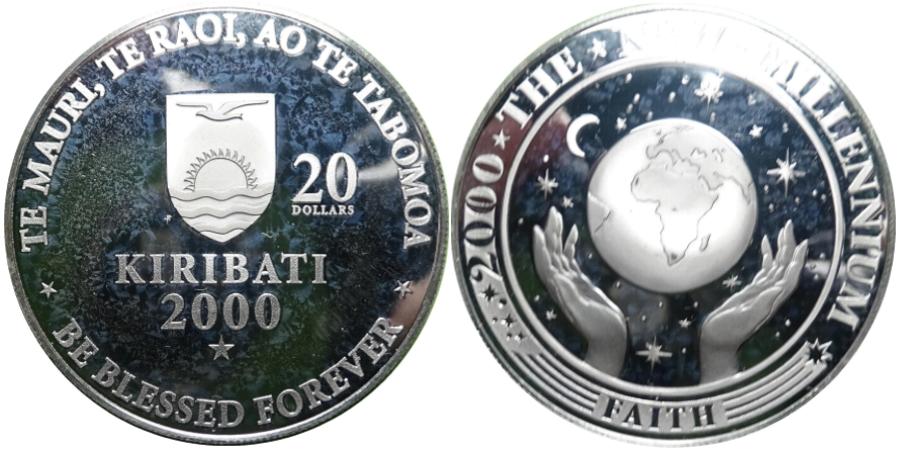
This 20 dollar coin was issued to mark the millennial year 2000. Weighs 21.24 grams of 0.925 fineness.
KOREA
Japan replaced China as the predominant foreign influence
in Korea in 1895 and annexed the peninsular country in 1910. Defeat in World War
II brought an end to Japanese rule. U.S. troops entered Korea from the south and
Soviet forces entered from the north. The Cairo conference (1943) had established
that Korea should be free and independent. The Potsdam conference (1945) set the
38th parallel as the line dividing the occupation forces of the United States and
Russia. When Russia refused to permit a U.N. commission designated to supervise
reunification elections to enter North Korea, an election was held in South Korea
on 12 May 1948. By its determination, the Republic of Korea was inaugurated on
15 Aug. 1948.
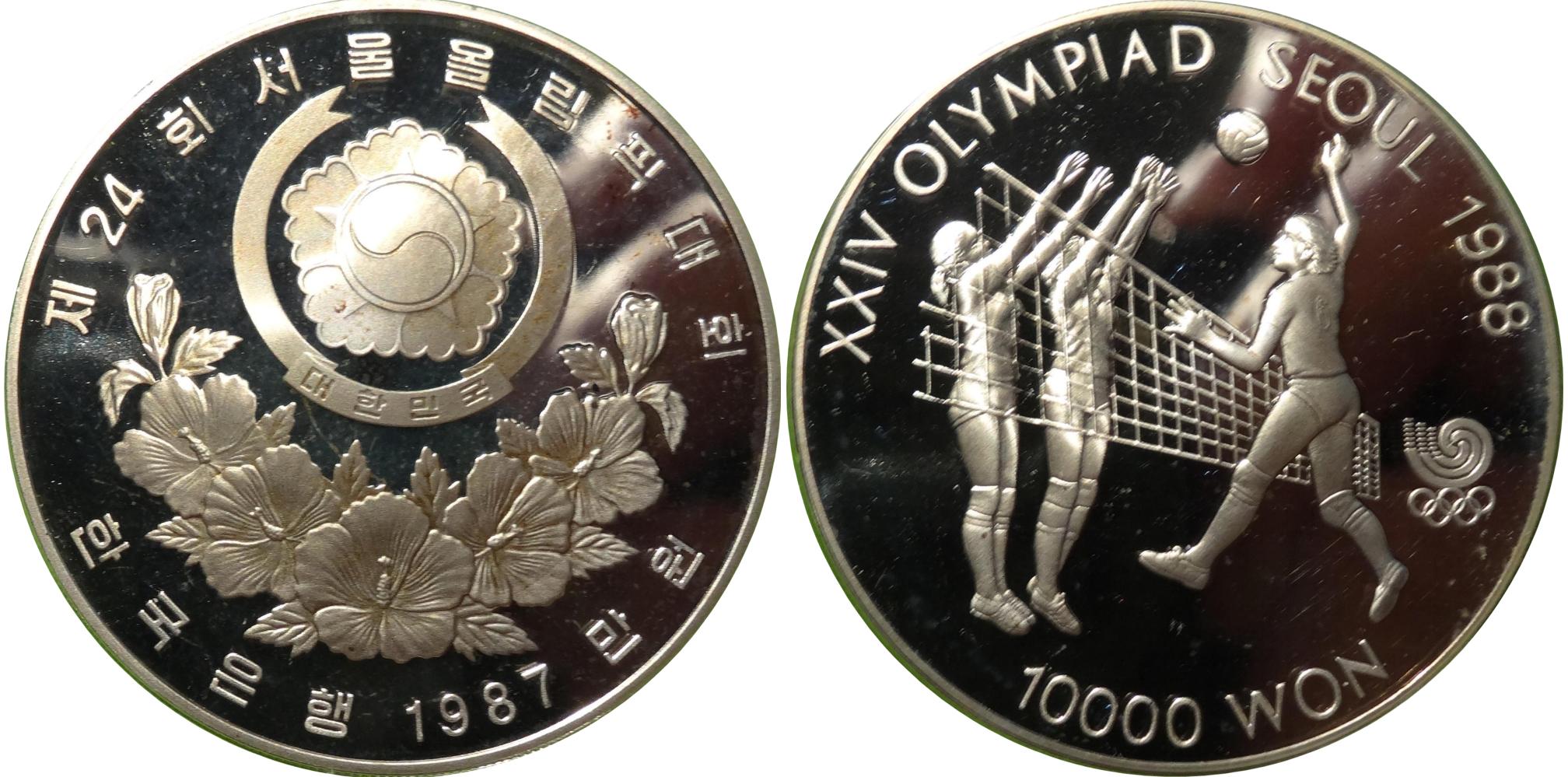
This is a ten thousand Won coin issued in honor of the 24th Olympic Games held in Seoul in 1987. Weighs 22.6 grams of 0.925 fineness.
LATVIA
The Latvians, of Aryan descent primarily from the German Order of Livonian Knights, were nomadic tribesmen who settled along the Baltic prior to the 13th century. Ideally situated as a trade route and lacking a central government, conquered in 1561 by Poland and Sweden. Following the third partition of Poland by Austria, Prussia, and Russia in 1795, Latvia came under Russian domination and did not experience autonomy until the Russian Revolution of 1917 provided an opportunity for freedom. The Latvian Republic was established on 18 Nov. 1918. The republic was occupied by Soviet troops and annexed to the Soviet Union In 1940. Following the German occupation of 1941-44, it was retaken by Russia and reestablished as a member republic of the Soviet Union. Western countries, including the United States, did not recognize Latvia's incorporation into the Soviet Union. The coinage issued during the early 20th Century Republic Is now obsolete. Latvia declared their independence from the U.S.S.R. on 22 August 1991.
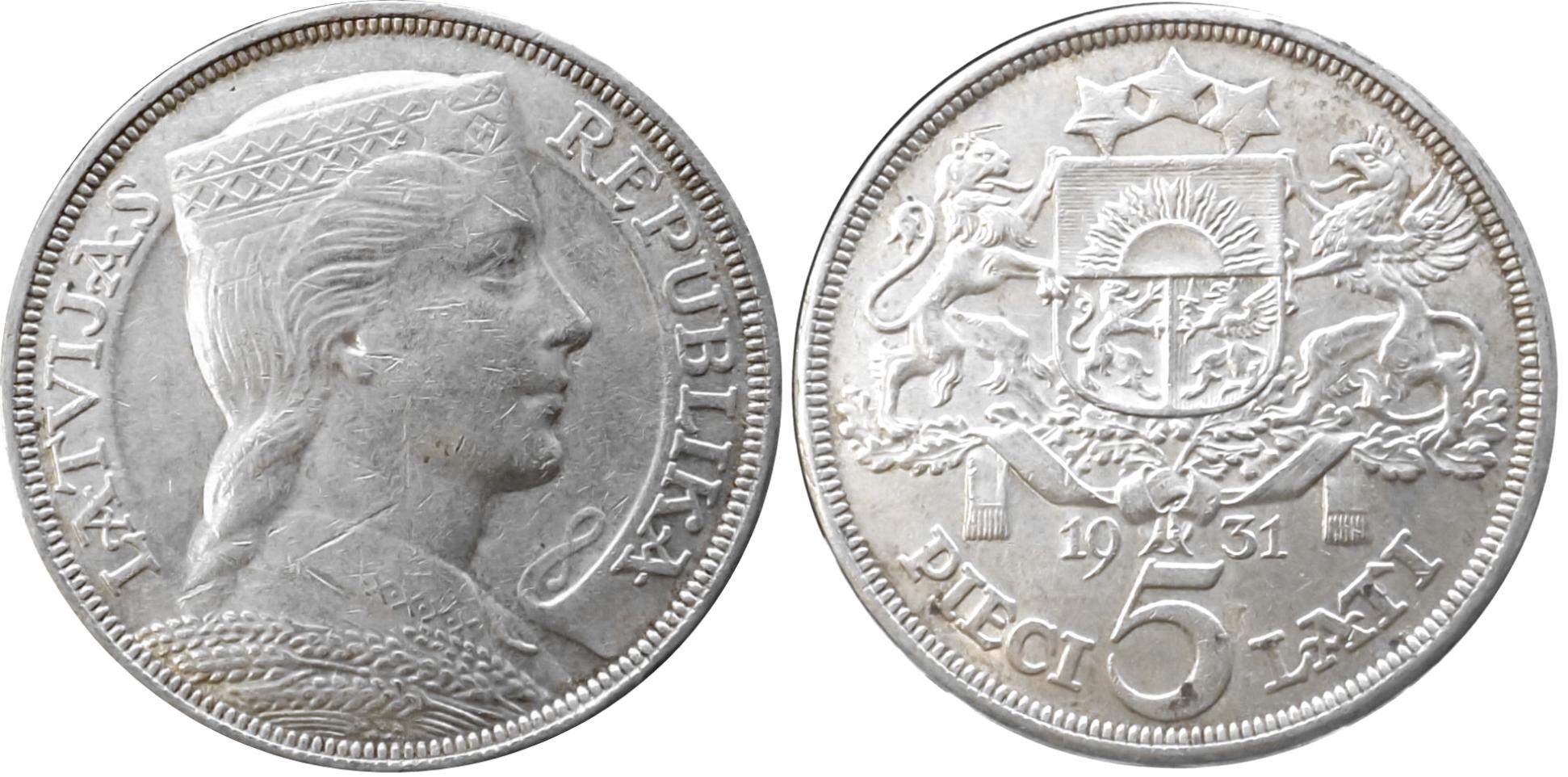
This is a five Lats coin minted in 1931.Obverse has a woman in native costume. Reverse has the nation's arms. Weighs 25 grams of 0.835 fineness.
LIBERIA
The Republic of Liberia is located on the southern side of the West African bulge between Sierra Leone and Ivory Coast. The Liberian coast was explored and charted by Portuguese navigator Pedro de Cintra in 1461. For the three centuries following Portuguese traders visited the area regularly to trade for gold, slaves, and pepper. The modern country of Liberia, Africa's first republic, was settled in 1822 by the American Colonization Society as a homeland for American freed slaves, with the U.S. government furnishing funds and assisting in negotiations for procurement of land from the native chiefs. The various settlements united in 1839 to form the Commonwealth of Liberia, and in 1847 established the country as a republic with a constitution modeled after that of the United States. U.S. money was declared legal tender in Liberia in 1943, replacing British West African currency.
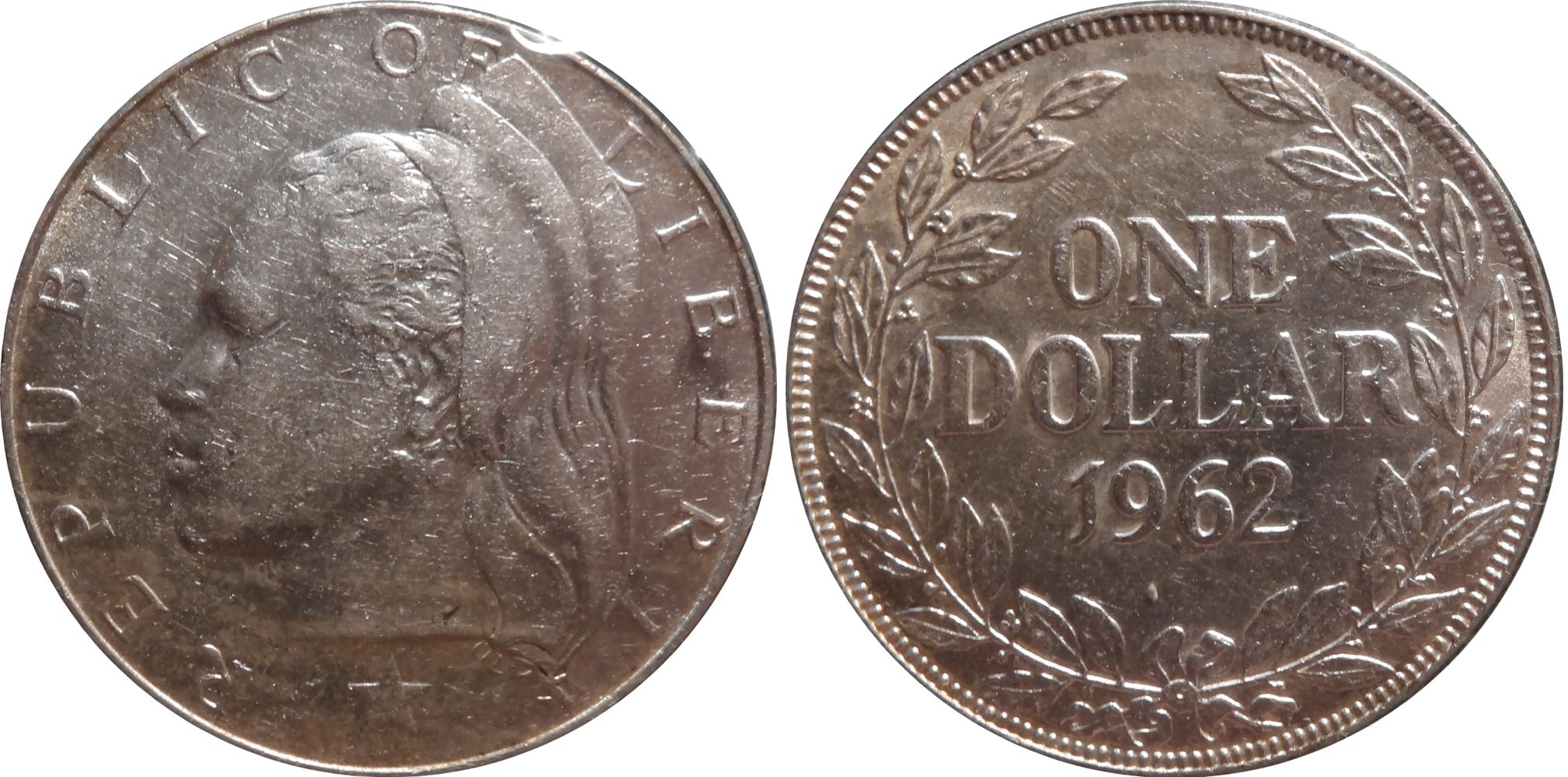
This is a 1962 one Dollar coin. Weighs 20.7 grams of 0.900 fineness.
LIECHTENSTEIN
Liechtenstein is a small principality located between Switzerland and Austria. The coinage was denominated in Austrian Krone until World War I when the Austrian currency collapsed. After that, they were denominated in Swiss Francs.
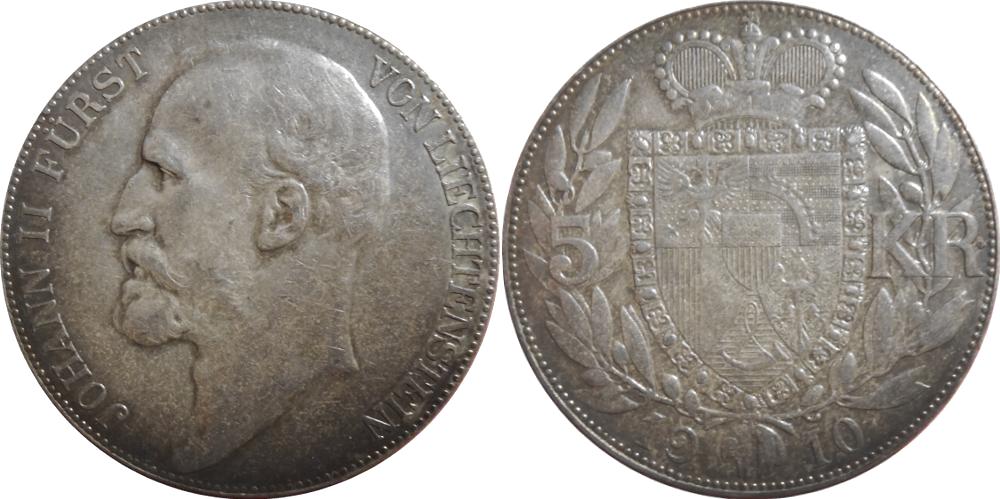
This is an example of a five Kronen crown struck in 1910. The obverse has Johann II with his title JOHANN II FÜRST VON LIECHTENSTEIN. The reverse has the crowned arms, the denomination, and the date. The mintage was rather small, only 10000. Weighs 24 grams of 0.900 fineness.
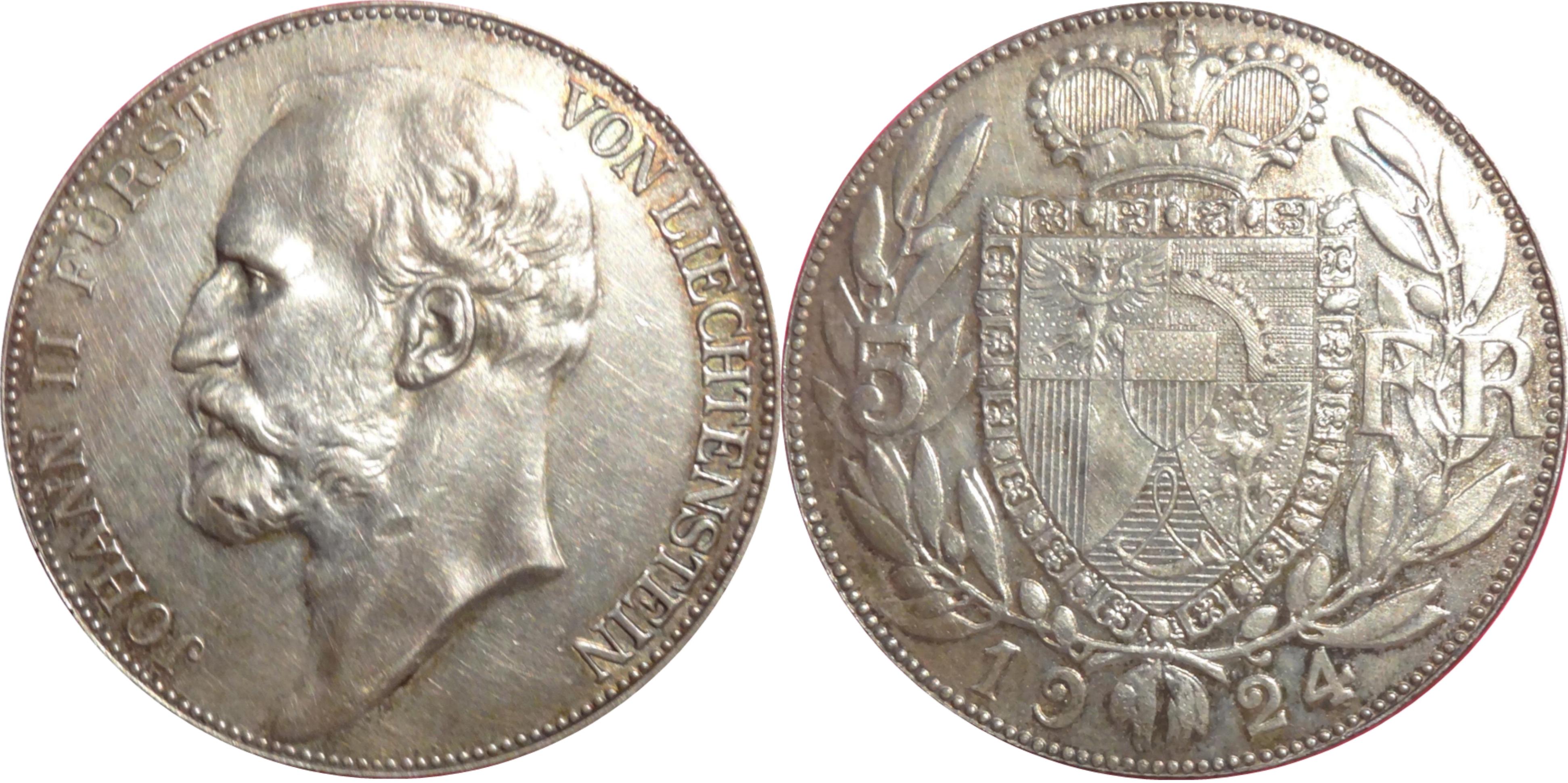
This is an example of a five Francs crown struck in 1924. The mintage was rather small, only 15000. Weighs 25 grams of 0.900 fineness.
LUXEMBOURG
The Grand Duchy of Luxembourg is located in western Europe between Belgium, Germany, and France. Founded about 963, Luxembourg was a prominent country of the Holy Roman Empire; one of its sovereigns became Holy Roman Emperor as Henry VII, 1308. After being made a duchy by Emperor Charles IV, 1354, Luxembourg passed under the domination of Burgundy, Spain, Austria, and France, 1443-1815, regaining autonomy under the Treaty of Vienna, 1815, as a grand duchy in union with the Netherlands, though ostensibly a member of the German Confederation. When Belgium seceded from the Kingdom of the Netherlands, 1830, Luxembourg was forced to cede its greater western section to Belgium. The tiny duchy left the German Confederation In 1867 when the Treaty of London recognized it as an independent state and guaranteed its perpetual neutrality. Luxembourg was occupied by Germany and liberated by American troops In both World Wars.
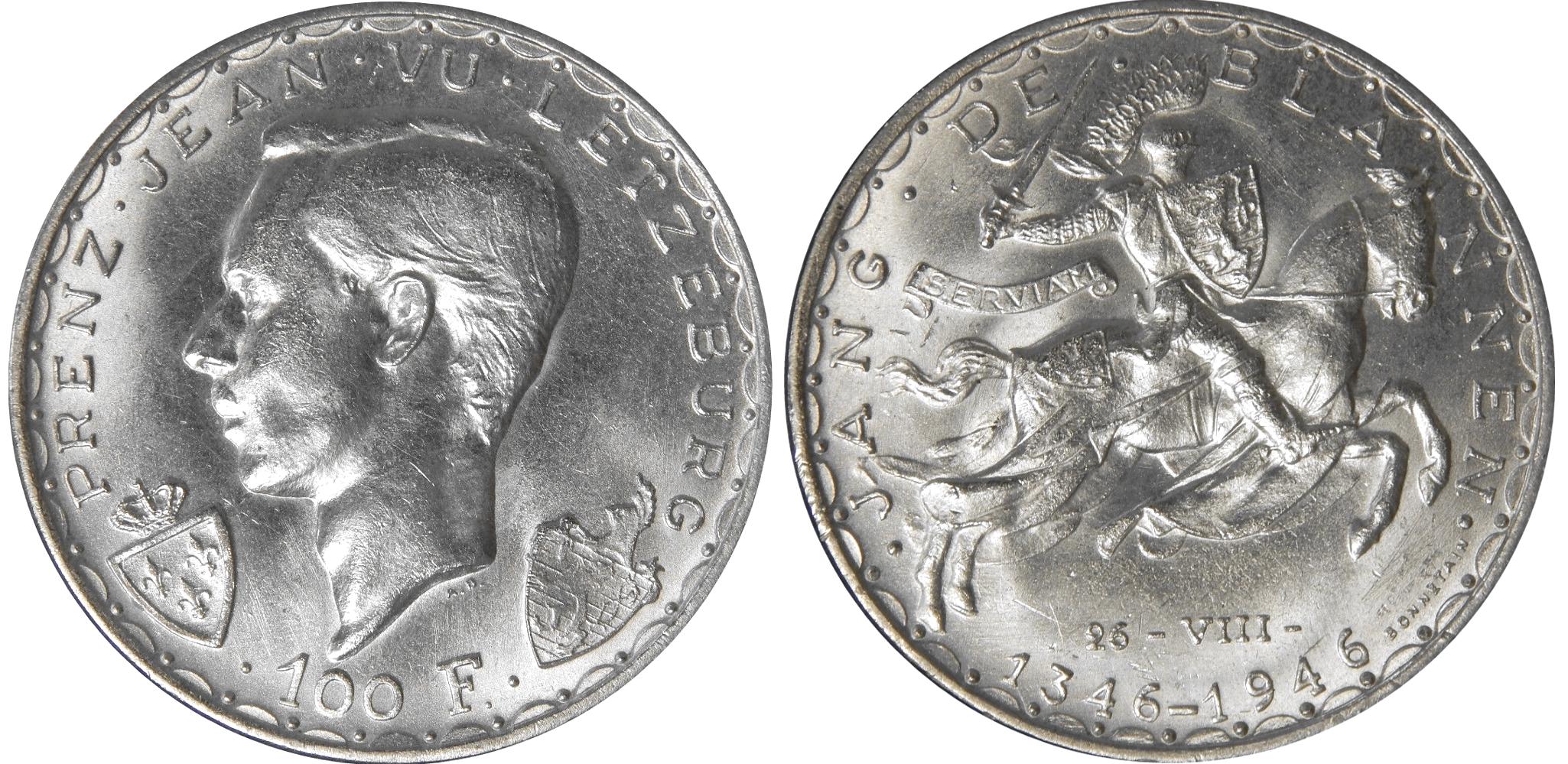
This is a one hundred Francs coin issued in 1946 to commemorate the 600th anniversary of Jean the Blind. The obverse has Prince Jean. The reverse has a mounted Jean charging. Weighs 27 grams of 0.835 fineness.
MALI
The Republic of Mali is a landlocked country in the interior of West Africa southwest of Algeria. Malians are descendants of the ancient Malinke Kingdom of Mali that controlled the middle Niger from the 11th to the 17th centuries. The French penetrated the Sudan (now Mali) about 1880, and established their rule in 1898 after subduing fierce native resistance. In 1904 the area became the colony of Upper Senegal-Niger (changed to French Sudan in 1920), and became part of the French Union in 1946. In 1958 French Sudan became the Sudanese Republic with complete internal autonomy. Senegal joined with the Sudanese Republic in 1959 to form the Mali Federation which, in 1960, became a fully independent member of the French Community. Upon Senegal’s subsequent withdrawal from the Federation, the Sudanese, on 22 Sept. 1960, proclaimed their nation the fully independent Republic of Mali and severed all ties with France.
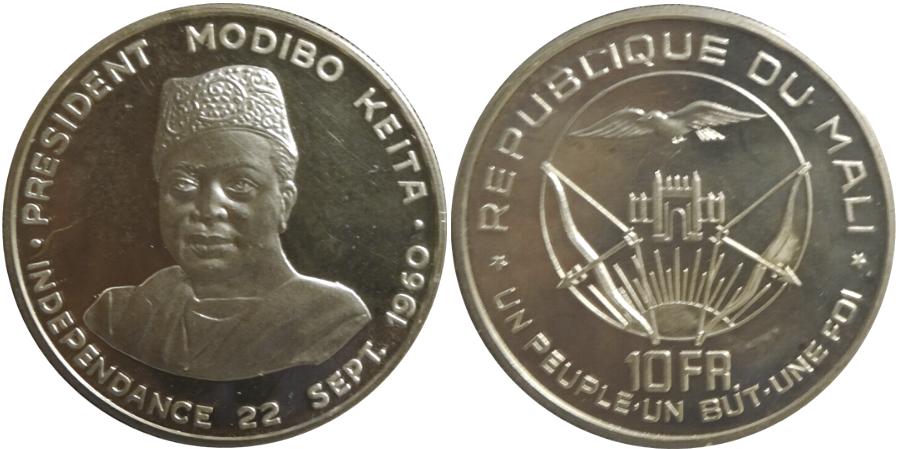
This is a ten Francs coin issued in 1960 to commemorate the attainment of independence. The obverse has President Keita. The reverse has the arms, country information, and the deno9mination. Weighs 25 grams of 0.900 fineness.
MALTA
The Republic of Malta, an independent parliamentary democracy, is situated in the Mediterranean Sea between Sicily and North Africa. For more than 3,500 years Malta was ruled, in succession by Phoenicians, Carthaginians, Romans, Arabs, Normans, the Knights of Malta, France,. and Britain. Napoleon seized Malta by treachery in 1798. The French were ousted by a Maltese insurrection assisted by Britain, and in 1814 Malta, of its own free will, became a part of the British Empire. Malta obtained full independence in Sept. 1964; electing to remain within the Commonwealth with the British monarch as the nominal head of state. Malta became a republic on 13 Dec. 1974, but remained a member of the Commonwealth of Nations. The president is Chief of State. The prime minister is the Head of Government.
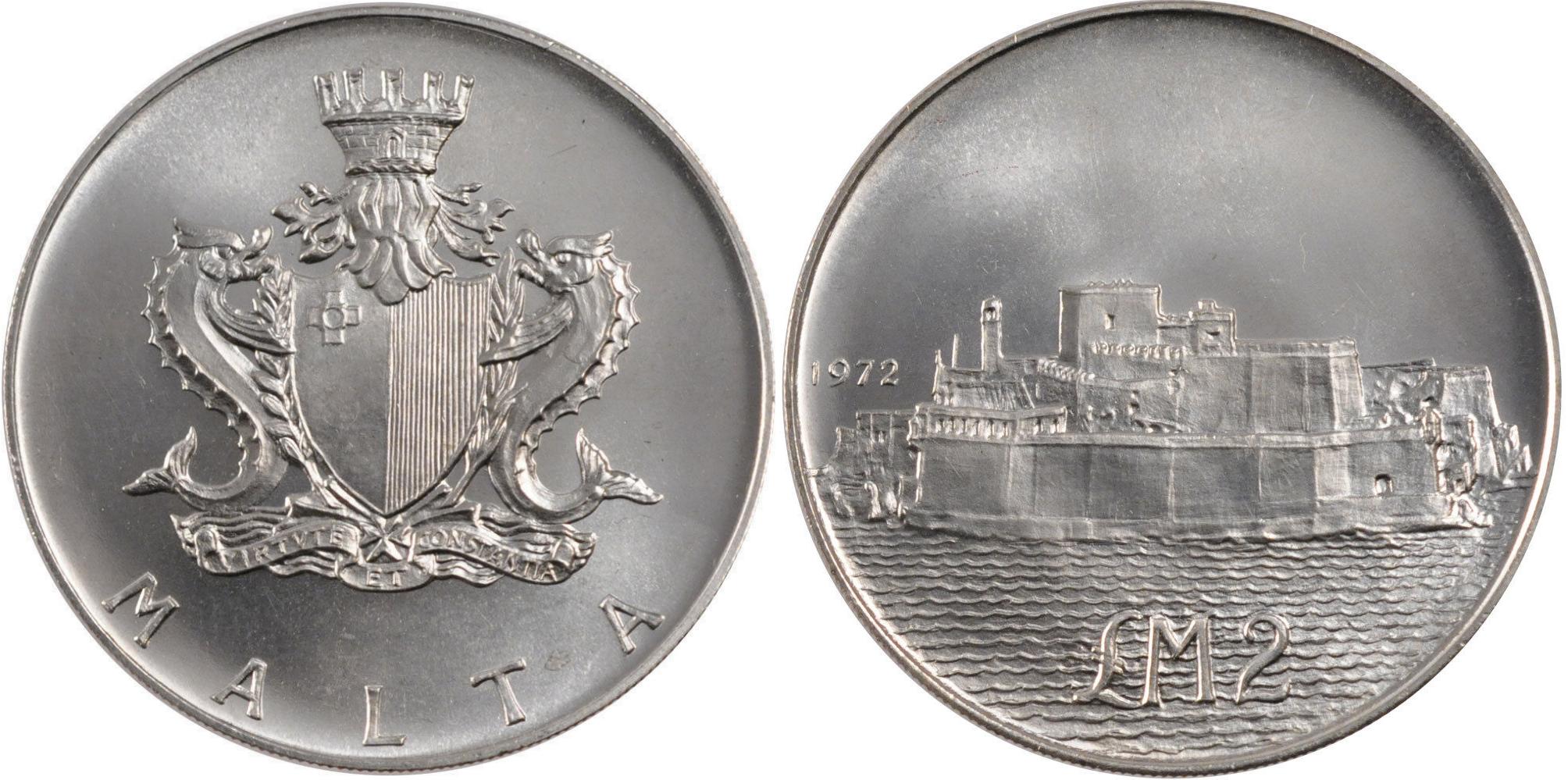
This is a two Maltese Pounds coin of 1972. The obverse has Malta's arms whilst the reverse pictures Fort St. Angelo. Weighs 20 grams of 0.987 fineness.
MAURITIUS
The Republic of Mauritius is located in the Indian Ocean 500 miles (805 km.) east of Madagascar. It was a British colony. Mauritius became independent on March 12, 1968. It Is a member of the Commonwealth of Nations.
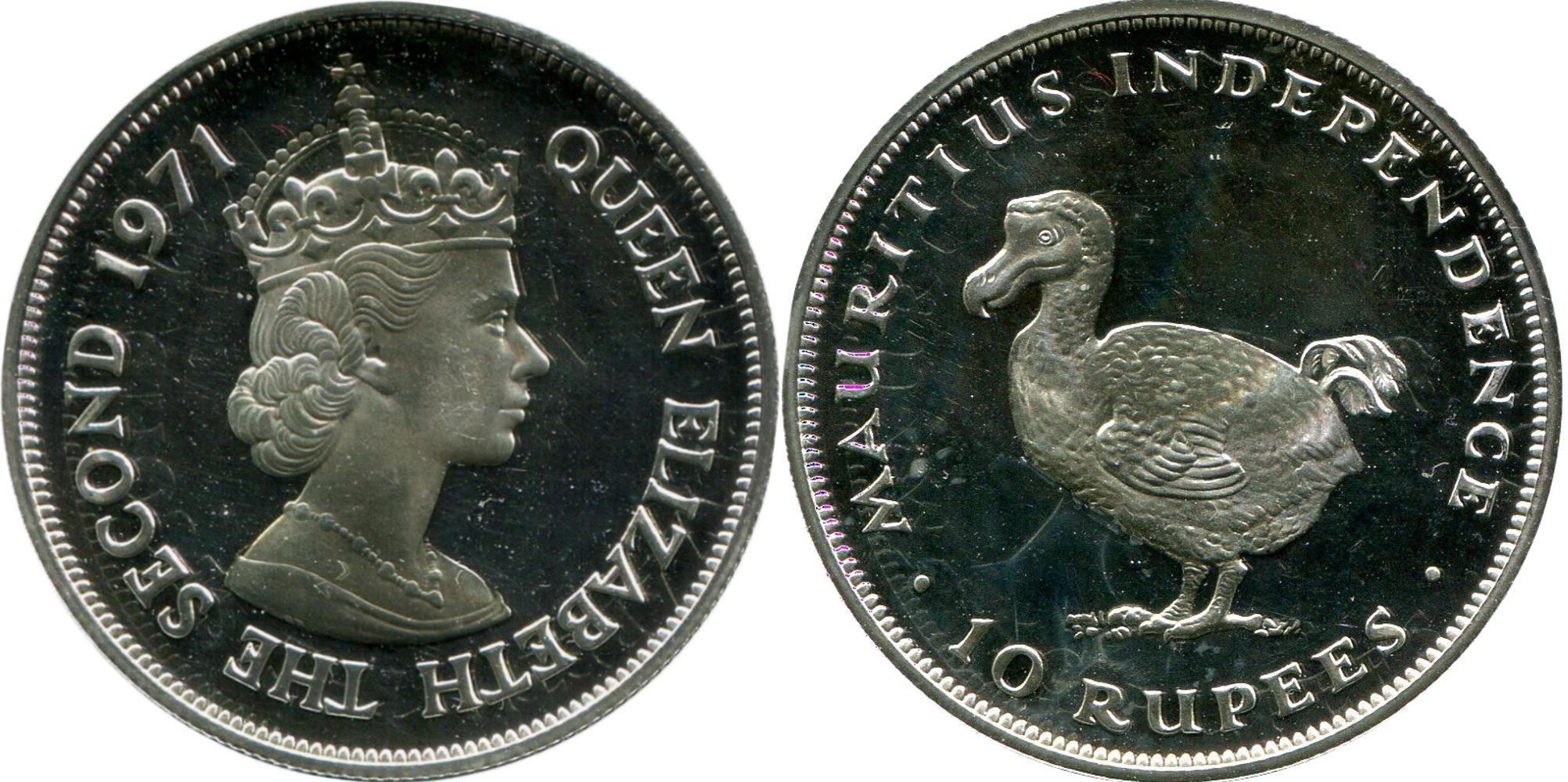
This is a ten Rupee coin minted in 1977 to commemorate independence. Obverse has Queen Elizabeth II. Reverse has the extinct dodo bird. Weighs 29 grams of 0.925 fineness.
MECKLINBERG-SCHWERIN
The Duchy of Mecklenburg was divided in 1592 to form the branches of Mecklenburg-Schwerin and Mecklenburg-Güstrow. During the Thirty Years’ War, the several dukes of the Mecklenburg states sided with the Protestant forces against the emperor. Albrecht von Wallenstein. Duke of Friedland and imperial general, ousted the Mecklenburg dukes from their territories in 1628. The rightful rulers were each restored to their lands in 1632. In 1658, Mecklenburg-Schwerin was divided by the four sons of Adolf Friedrich into the lines of Mecklenburg-Schwerin, Mecklenburg-Grabow, Mecklenburg-Mirow (extinct in 1675) and Mecklenburg-Strelitz. Mecklenburg-Schwerin and Mecklenburg-Güstrow fell extinct in the male line in 1692 and 1695 respectively, becoming a source of dispute between Mecklenburg-Grabow and Mecklenburg-Strelitz. Both parties finally agreed to a settlement in 1701 which awarded about eighty percent of all Mecklenburg territory to Grabow, which became the main Schwerin line, and the rest to Strelitz. No coinage was produced for Mecklenburg-Schwerin from 1708 until 1750. In 1815, the Congress of Vienna elevated the ruler to the rank of Grand Duke. Mecklenburg-Schwerin became a part of the German Empire in 1871. The last grand duke abdicated at the end of World War I in 1918.
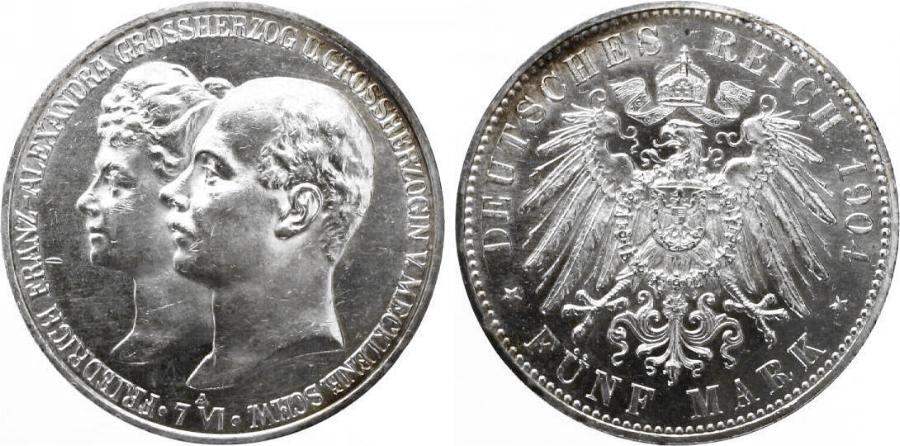
This is a five Mark coin minted in 1904 to commemorate Friedrich Franz IV's wedding. The obverse features the conjoined busts of Grand Duke Franz IV and Grand Duchess Alexandra with the legend · FRIEDRICH FRANZ-ALEXANDRA GROSSHERZOG U. GROSSHERZOGIN V. MECKLENB. SCHW. ·. Reverse has German arms. Weighs 27.8 grams of 0.900 fineness.
MEXICO
Mexico was the site of highly advanced Indian civilizations 1,500 years before conquistador Hernando Cortes conquered the wealthy Aztec empire of Montezuma, 1519-21, and founded a Spanish colony which lasted for nearly 300 years. During the Spanish period, Mexico, then called New Spain, stretched from Guatemala to the present states of Wyoming and California, its present northern boundary having been established by the secession of Texas during 1836 and the war of 1846-48 with the United States. Independence from Spain was declared by Father Miguel Hidalgo on 16 Sept. 1810, (Mexican Independence Day) and was achieved by General Agustin de Iturbide in 1821. Iturbide became emperor in 1822 but was deposed when a republic was established a year later. For more than fifty years following the birth of the republic, the political scene of Mexico was characterized by turmoil which saw two emperors (including the unfortunate Maximilian), several dictators and an average of one new government every nine months passing swiftly from obscurity to oblivion. The land, social, economic and labor reforms promulgated by the Reform Constitution of 5 Feb. 1917 established the basis for sustained economic development and participative democracy that have made Mexico one of the most politically stable countries of modern Latin America.
This an eight reales piece struck in Mexico City around 1668 during the reign of Charles II. These rough coins were called "cobs" as they were cut from rough bars (the Spanish word was coba de barra). Weighs 27 grams of 0.931 fineness.
This is an example of the famed "piece of eight." This is called the Pillars type as the obverse features the Pillars of Hercules at the mouth of the Mediterranean Sea. The European pillar is the Rock of Gibraltar, the African pillar is Morocco's Jebel Musa .The ribbons read PLUS ULTRA (More Beyond) and the legend VTRAQUE VNUM (Both as one). This coin was minted in 1759. This was a very commercially successful coinage as they were accepted throughout the world because of silver quality. Sometimes you find these coins with Chinese characters called chopmarks stamped into the coin to attest to its quality.. Assayer's initial M is for Manuel de la Peña. It was known as the Pillar dollar and as the Spanish Milled Dollar. Weighs 27 grams of 0.9170 fineness.
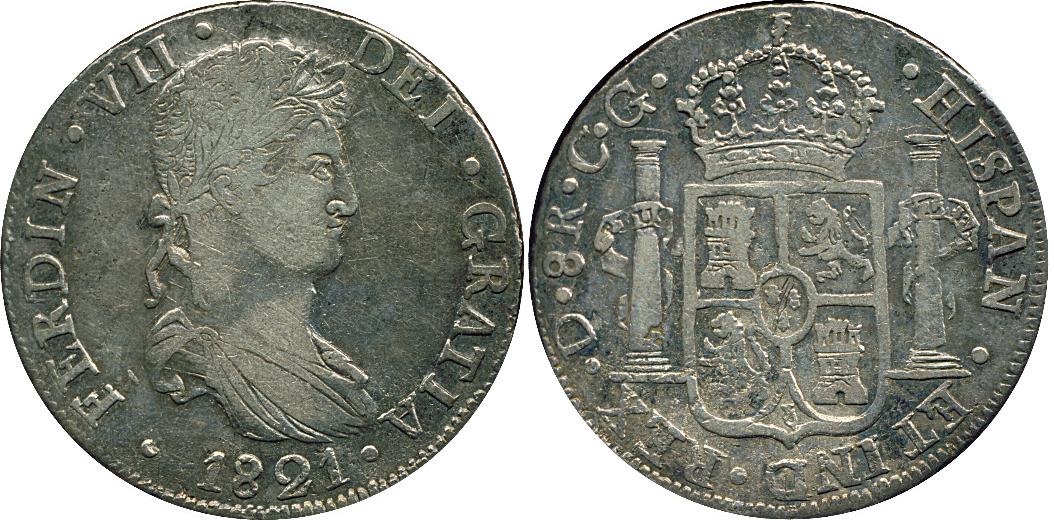
This is a Royalist eight reales coin minted in Durango in 1821. The obverse has King Ferdinand VII and the reverse has the Spanish arms (the D is the mintmark for Durango, the C.G. is the assayer's initials). Weighs 27.07 grams of 0.896 fineness.
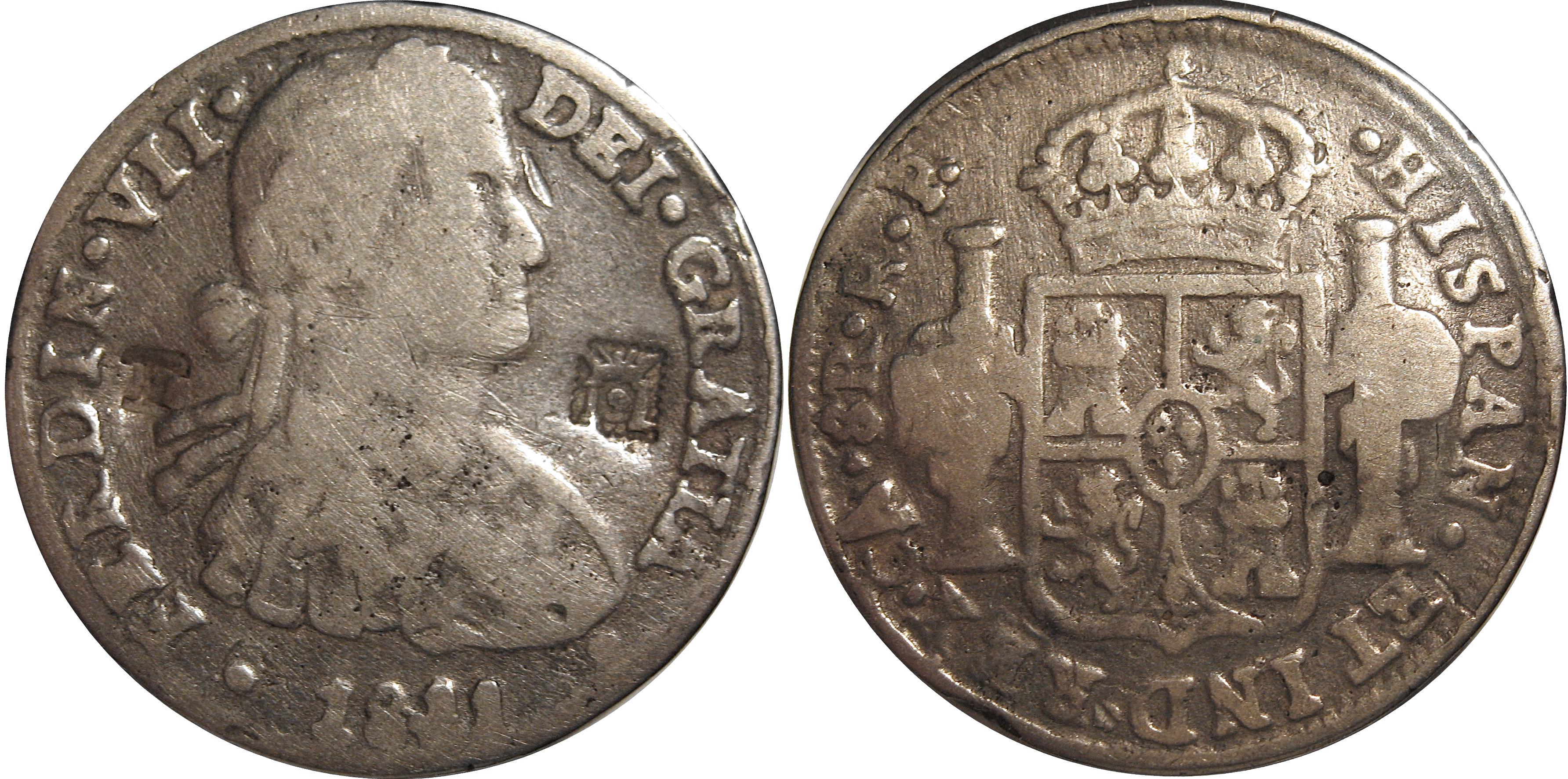
The Chihuahua Mint was established by a decree of 8 October 1810 as a temporary mint. Their first coins were cast 8 reales using Mexico City coins as patterns and obliterating/ changing the mint mark and rnoneyer initials. two countermarks were placed on the obverse - on the left, a T designating receipt by the Royal Treasurer, crowned pillars of Hercules on the right with pomegranate beneath, the comptroller's symbol. The coin used for the mold was an 1811 piece. The obverse has a T to the left and pillars to the right counterstamps. The reverse has the mintmark CA and the assayer's initials R.P.
Mexico revolted against Spain in 1810. The war continued into the 1820s. After independence, the victor Gen. Augustin de Iturbide seized power and declared himself Emperor Agustin I of Mexico. He was deposed in 1823 and a republic was established. This eight reales coin was minted in Mexico City in 1822. The obverse has Iturbide. The reverse has the imperial arms and the legend MEX·I·IMPERATOR · CONSTITUT·8·R·I·M ·(Mexico's 1st constitutional Emperor). Weighs 27 grams of 0.903 fineness.
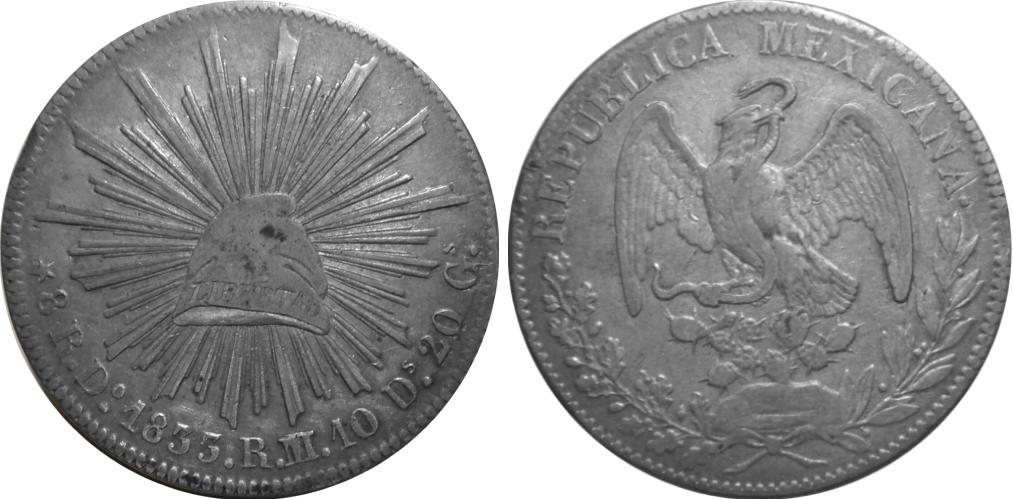
This is a Republic eight reales piece minted in Durango in 1833. The obverse has a radiant Liberty cap with *8 R.Do.1833.R.M.10 Ds.20 Gs (8 Reales Do (Durango) assayers' initials (Ramon Mascarenas) 10 Dineros 20 Grams). The reverse has the Mexican eagle. This series was issued for several years from many different mints including As Alamos, Ca Chihuahua, CE Real de Catorce, Cn Culiacan, EoMo Estado de Mexico, Ga Guadalajara, GC Guadalupe y Calvo, Go Guanajuato, Ho Hermosillo, Mo Mexico City, Oa Oaxaca, Pi San Luis Potosi, and Zs Zacatecas. Weighs 27.07 grams of 0.903 fineness.
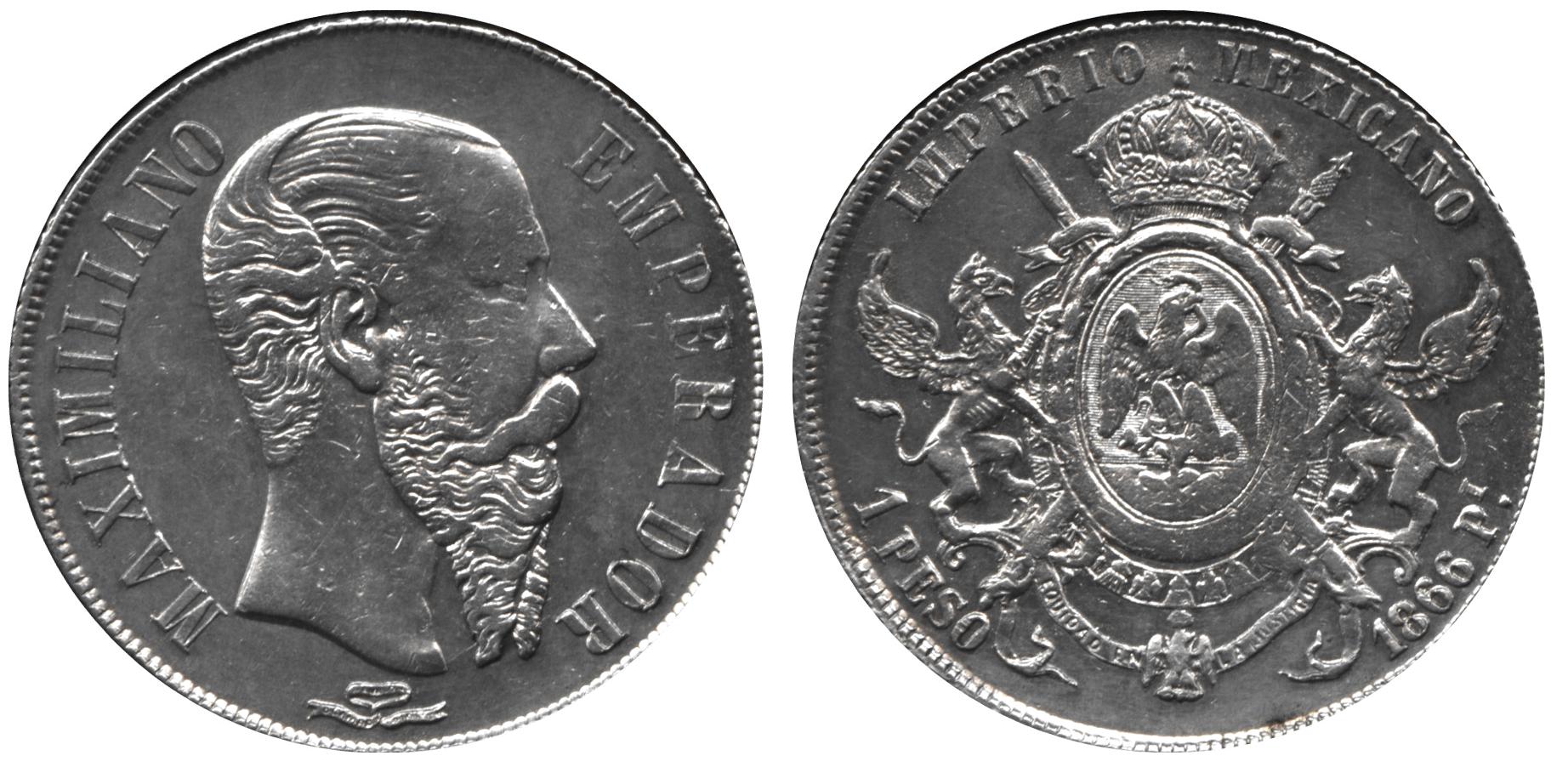
In 1866 there was a group of elites who wanted to reinstitute a Mexican Empire. They invited Maximilian, the younger brother of Emperor Franz Josef of Austria, to accept the crown. Maximilian and his wife Carlota journeyed to Mexico and were crowned on 10 April 1864. They were deposed in 1867 and Maximilian was executed. This is a Peso coin minted in Potosi in 1866. Weighs 27 grams of 0.903 fineness.
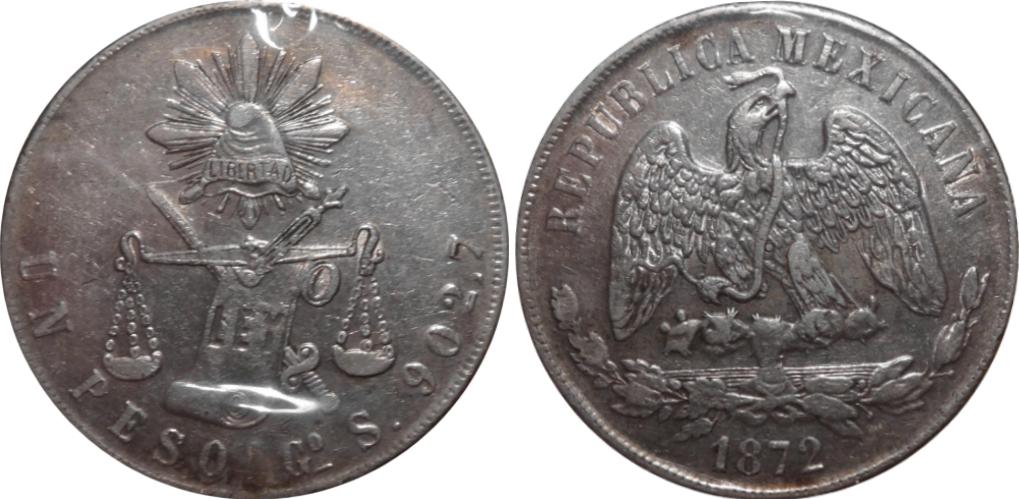
This is a Mexican one Peso coin minted in 1872 at the Guanajuato mint. The obverse has a radiant Liberty cap over a scale with a panel inscribed LEY (Law), the denomination, the mintmark, the assayer (S) and the fineness 0.9027. Weighs 27.07 grams of 0.903 fineness.
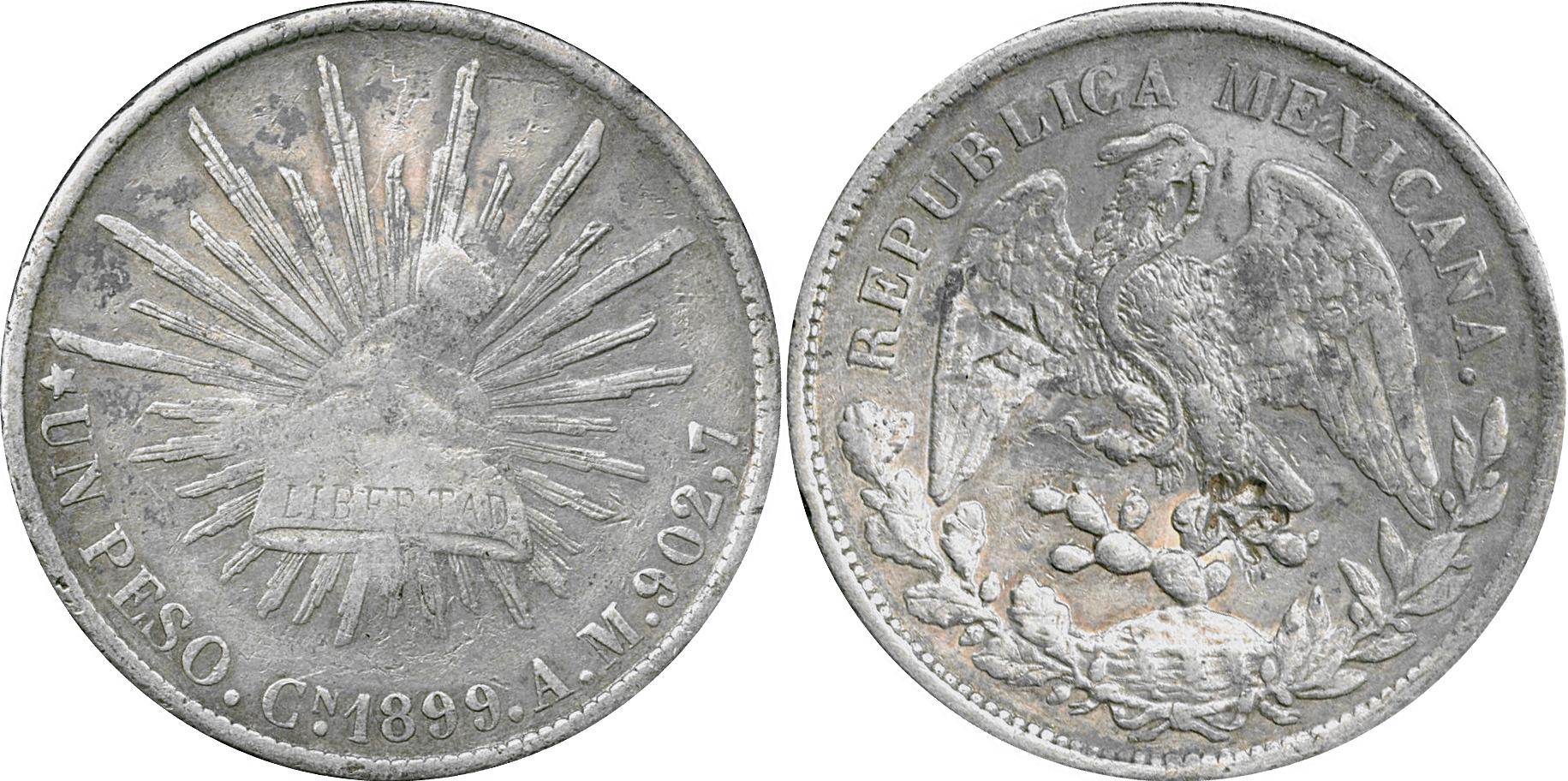
This is a Republic one Peso piece minted in Culiacan in 1898. The design is about the same as the old eight reales coins. The obverse has a radiant Liberty cap with *UN PESO.CN 1899.A.M.902,7. (One Peso mintmark year assayer initials (Antonio Moreno) and the fineness). The reverse has the Mexican eagle. This coin has a coupe of Chinese chops on the reverse. Weighs 27.07 grams of 0.9027 fineness.
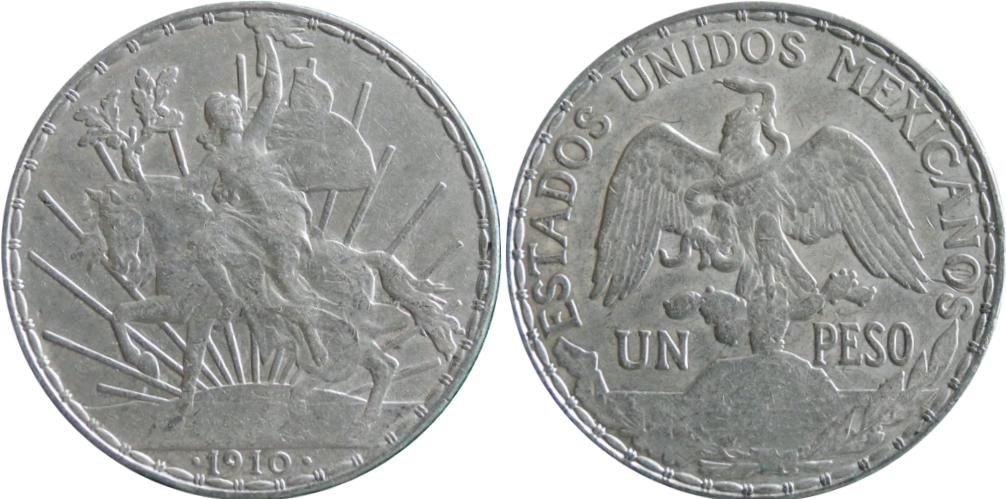
This is the last of the full size silver Mexican one Peso coin. It is commonly called the Caballito Peso. The obverse has a mounted Liberty and the date 1910. Weighs 27.07 grams of 0.903 fineness.
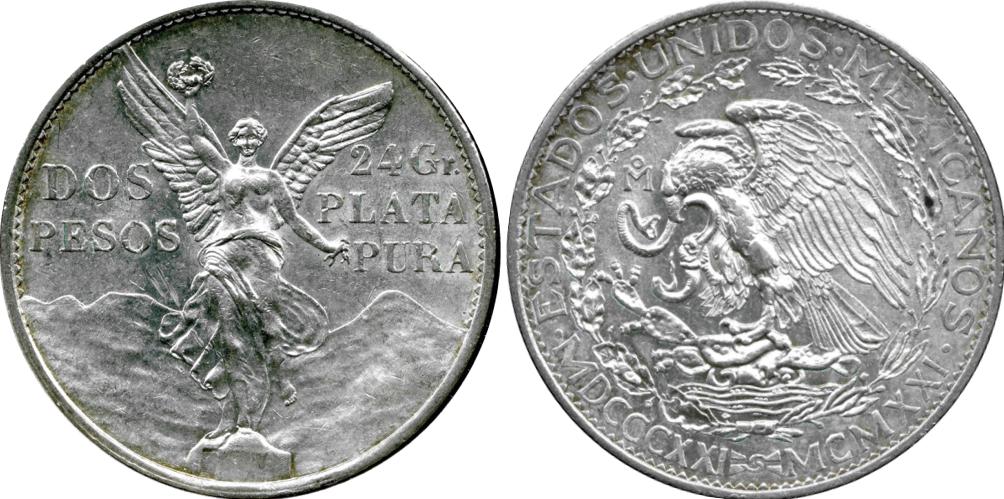
This is a Mexican two Peso coin issued to commemorate the centenary of Mexican independence in 1921. The obverse has the winged Liberty with the denomination, the weight, and pure silver. The reverse has the national symbol with the country's name and the dates 1821 - 1921 in Roman numerals. Weighs 26.67 grams of 0.900 fineness.
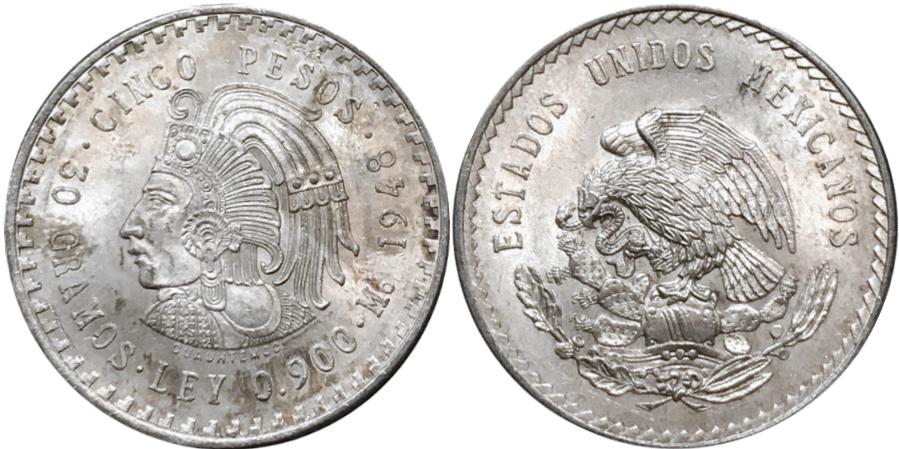
This is a Mexican five Peso coin issued in 1948. The obverse has Cuauhtemoc, the denomination, the weight, the fineness, the mintmark, and the date. Weighs 30 grams of 0.900 fineness.
MONACO
The Principality of Monaco is located on the Mediterranean coast nine miles from Nice. Monaco derives its name from Monoikos: the Greek surname for Hercules, the mythological strong man who, according to legend, formed the Monacan headland during one of his twelve labors. Monaco has been ruled by the Grimaldi dynasty since 1297 - Prince Albert II, the present and 32nd monarch of Monaco, is still of that line - except for a period during the French Revolution until Napoleon's downfall when the Principality was annexed to France. Since 1865, Monaco has maintained a customs union with France which guarantees its privileged position as long as the royal line remains intact. Under the new constitution proclaimed on 17 December 1962, the Prince shares his power with an 18-member unicameral National Council.
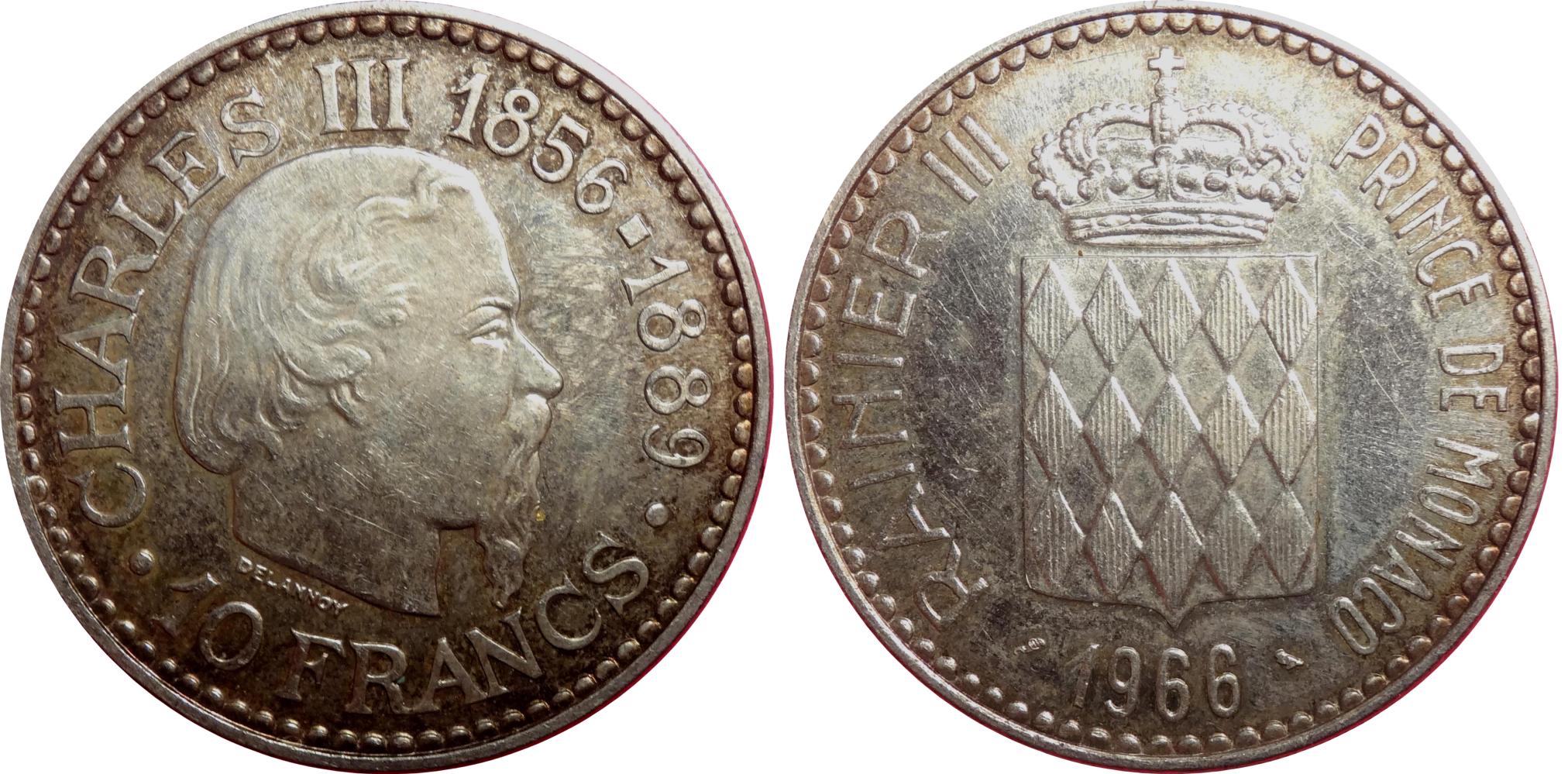
This is a 10 Francs coin issued in 1966. The obverse has Prince Charles III, the dates of his reign, and the denomination. The reverse has the Monacoan arms, the then-current prince, and the date flanked by the Paris mintmarks. Weighs 25 grams of 0.900 fineness.
MONGOLIA
The State of Mongolia, (formerly the Mongolian People's Republic) is a landlocked country in central Asia between Russia and the People's Republic of China. Mongolia (often referred to as Outer Mongolia), one of the world's oldest countries, attained its greatest power in the 13th century when Genghis Khan and his successors conquered all of China and extended their influence westward as far as Hungary and Poland. The empire dissolved in later centuries and in 1691 was brought under suzerainty of the Manchus, who had conquered China in 1644. Afterward the Chinese republican movement led by Sun Yat-sen overthrew the Manchus and set up the Chinese Republic in 1911. Mongolia, with the support of Russia, proclaimed their independence from China and, on 13 March 1921 a Provisional People's Government was established and later, on 26 Nov. 1924 the government proclaimed the Mongolian People's Republic. Although nominally a dependency of China, Outer Mongolia voted at a plebiscite 20 Oct.1945 to sever all ties with China and become an independent nation. Opposition to the communist party developed in late 1989 and after demonstrations and hunger strikes, the Politburo resigned on 12 March 1990 and the new State of Mongolia was organized. On 12 Feb. 1992 it became the first to discard communism as the national political system by adopting a new constitution.

This is a one Tugrik coin minted in 1925. The obverse has the Soyombo symbol with the Hudum legends for Pure Silver, 18 grams with the date Year 15. The reverse has the legend for Mongolian Peoples' Republic and One Tögrög, Weighs 20 grams of 0.900 fineness.
MOROCCO
Morocco's strategic position at the gateway to Western Europe has been the principal determinant of its violent, frequently unfortunate history. Time and again the fertile plain between the rugged Atlas Mountains and the sea has echoed the battle's trumpet as Phoenicians, Romans, Vandals, Visigoths, Byzantine Greeks, and Islamic Arabs successively conquered and occupied the land. Modern Morocco Is remnant of an early empire formed by the Arabs at the close of the 7th century, which encompassed all of northwest Africa, and most of the Iberian Peninsula. During the 17th and 18th centuries, while under the control of native dynasties, it was the headquarters of the famous Salé pirates. Morocco's strategic position involved it In the competition of 19th century European powers for political Influence in Africa, and resulted in the division of Morocco into French and Spanish spheres of interest, which were established as protectorates in 1912. Morocco became independent on 2 March 1956, alter France agreed to end its protectorate. Spain signed similar agreements on 7 April of the same year. Tangiers remained as an international city until 29 October 1956. The Spanish retained two enclaves, Ceuta and Melilla.
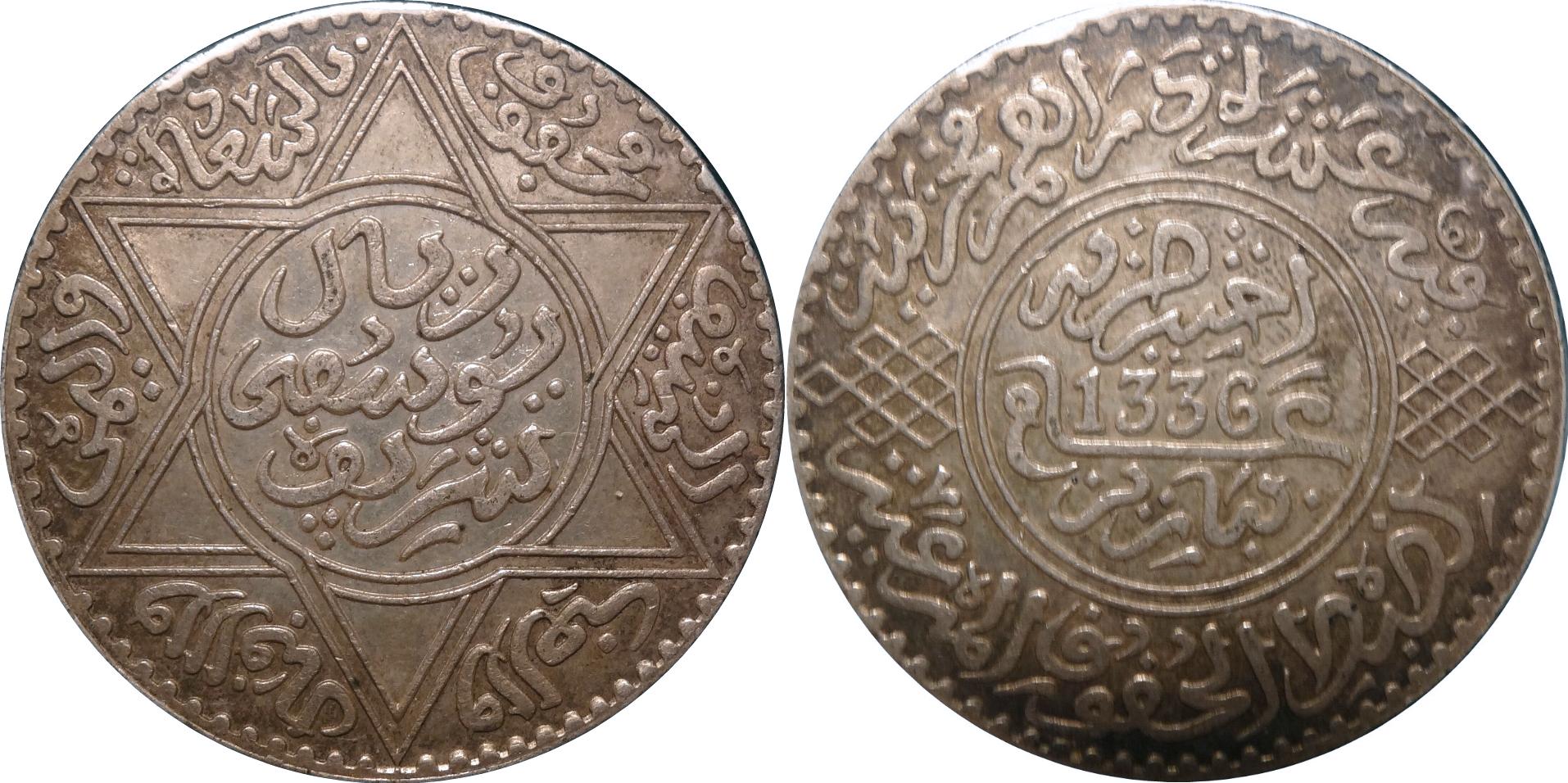
This is a 10 Dirhems/1 Rial piece dated 1336 AH (1918 AD). It was
minted at the Paris Mint. The obverse has the Arabic legend
المُنِيڢٗ | محڢُوڢ | بالسَعٚادة | واليمںٗ | والاڧبال | والعِز ريال يُوسُڢى
شَرِيڢٗ
(the
surrounded by happiness and pride Yusufi Sharif Rial)
within the star. The reverse has the legend
دَرَاهم مخزَنيٚۃ اختِير ضربہ 1331عَامبباريزلِضبٗط الحُڧوُڧِ المرٗ1336عَيٚۃ
(It
has 10 "makhzini" dirhams
-
Selected to be struck Year 1336 in Paris to control the considered rights).
Weighs 25 grams of 0.900 fineness.
NEPAL
The Kingdom of Nepal, the world’s only surviving
Hindu kingdom, is a landlocked country occupying the southern slopes of the
Himalayas. Apart from a brief Muslim invasion in the 14th century, Nepal was
able to avoid the mainstream of Northern Indian politics, due to its impregnable
position in the mountains. It is therefore a unique survivor of the medieval
Hindu and Buddhist culture of Northern India, which was largely destroyed by the
successive waves of Muslim invasions. Apart from agriculture, Nepal owed its
prosperity to its position on one of the easiest trade routes between the great
monasteries of central Tibet, and India. Nepal made full use of this, and a
trading community was set up in Lhasa during the 16th century, and Nepalese
coins became the accepted currency medium in Tibet. A popular revolution in 1950
toppled the Rana family and reconstituted power in the throne. In 1959 King
Mahendra
declared Nepal a constitutional monarchy, and in 1962 a new constitution set up
a system of panchayat (village council) democracy. In 1990, following political
unrest, the king’s powers were reduced. The country then adopted a system of
parliamentary democracy. On 2 June 2001 tragedy struck the royal family when
Crown Prince Dipendra used an assault rifl e to kill his father, mother and
other members of the royal family as the result of a dispute over his current
lady friend. He died 48 hours later, as King, from self infl icted gunshot
wounds. Gyanendra began his second reign as King (his first was a short time as
a toddler, 1950-51).
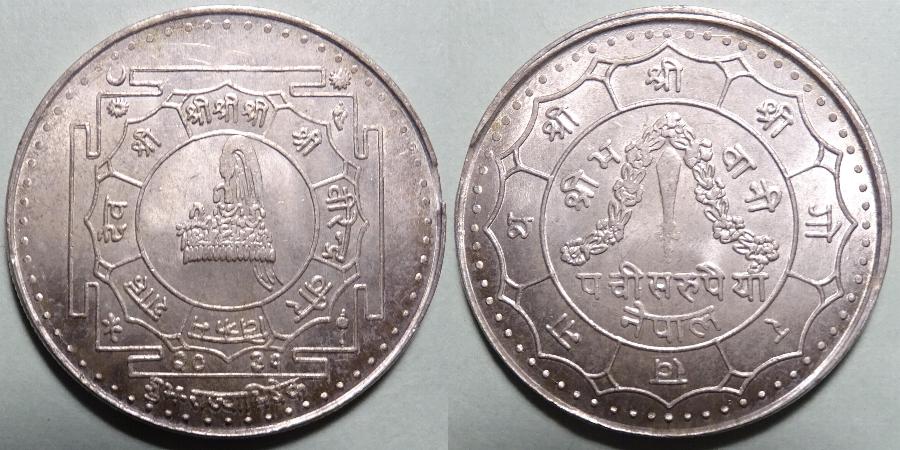
This is a 25 rupee coin issued on 2031 VS (1974) to
commemorate the coronation of Birendra. Weighs 25.6 grams of 0.500 fineness.
NETHERLANDS
After being a part of Charlemagne's empire in the 8th and 9th centuries, the Netherlands came under control of Burgundy and the Austrian Habsburgs, and finally was subjected to Spanish dominion in the 16th century. Led by William of Orange, the Dutch revolted against Spain in 1568. The seven northern provinces formed the Union of Utrecht and declared their Independence in 1581, becoming the Republic of the United Netherlands. In the following century, the Golden Age of Dutch history, the Netherlands became a great sea and colonial power, a patron of the arts and a refuge for the persecuted. The United Dutch Republic ended in 1795 when the French formed the Batavian Republic. Napoleon made his brother Louis, the King of Holland in 1806, however he abdicated in 1810 when Napoleon annexed Holland. The French were expelled in 1813, and all the provinces of Holland and Belgium were merged Into the Kingdom of the United Netherlands under William I In 1814. The Belgians withdrew in 1830 to form their own kingdom, the last substantial change In the configuration of European Netherlands.
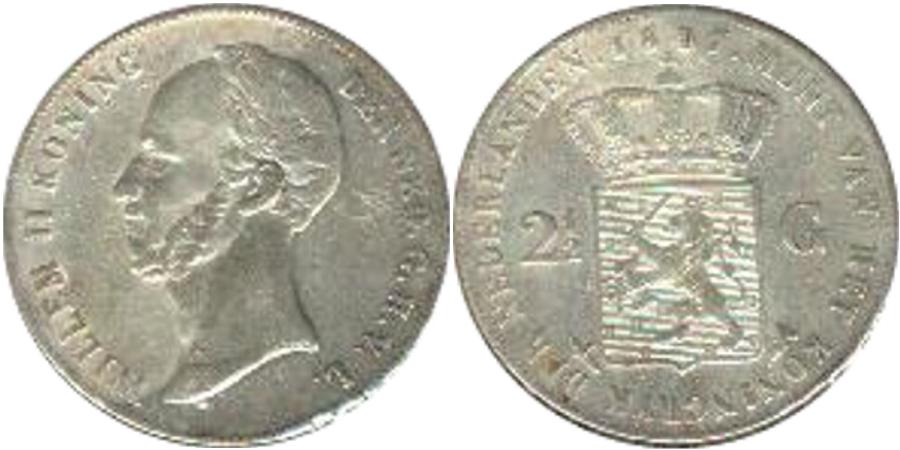
his is a two and one half Guilder minted in 1847. The obverse features King Willem II with the legend WILLEM II KONING DER NED.G.H.V.L. (WILLEM II KING OF THE NETHERLANDS GRAND DUKE OF LUXEMBOURG). The reverse has the Dutch coat-of-arms eth the legend .MUNT VAN HET KONINGRIJK DER NEDERLANDEN.1847 (MONEY OF THE KINGDOM OF NETHERLANDS). The edge has the inscription GOD * ZY * MET * ONS *. Weighs 25 grams of 0.945 fineness.
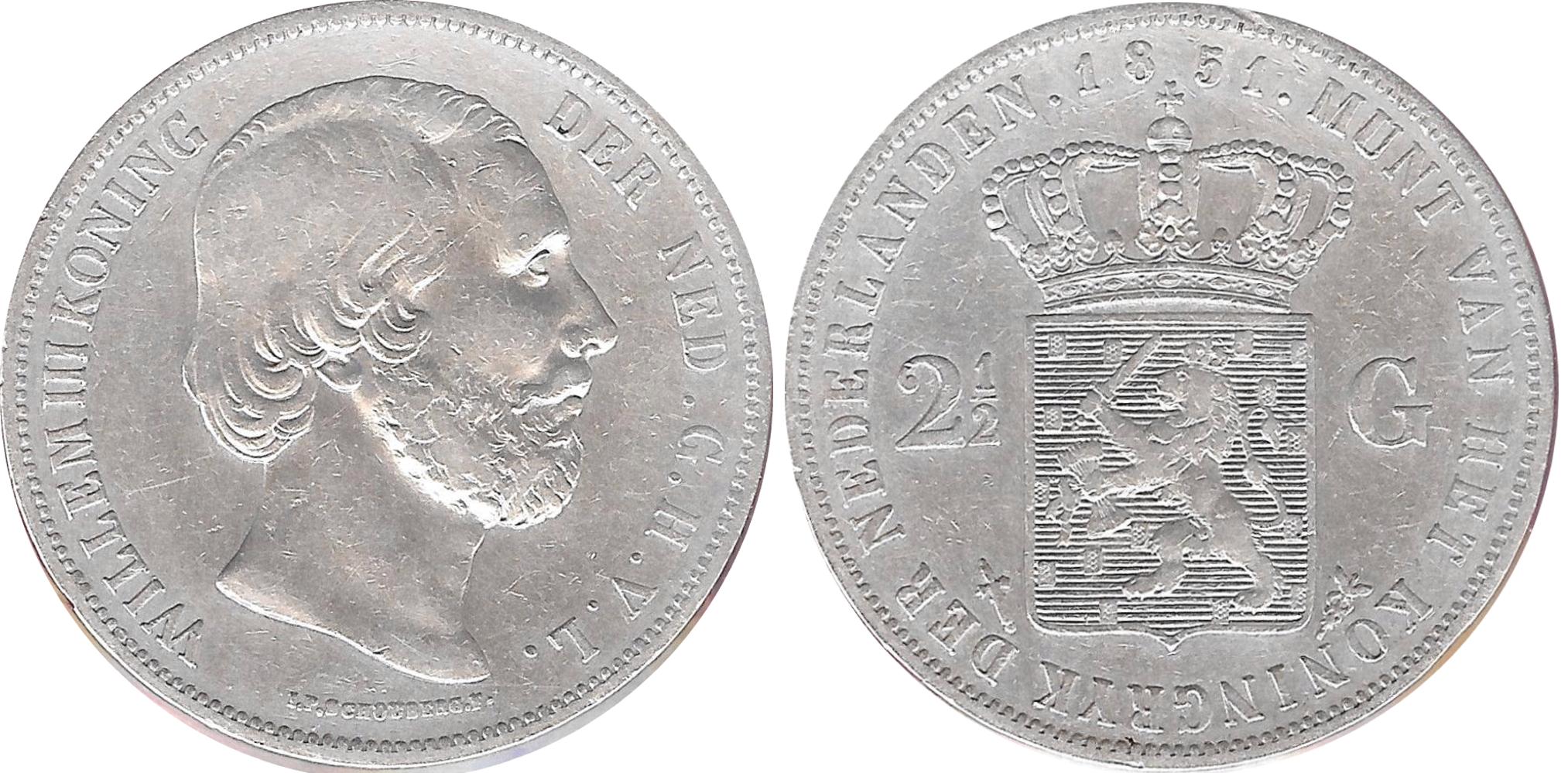
This is a two and one half Guilder minted in 1851. The obverse features King Willem III with the legend WILLEM III KONING DER NED.G.H.V.L. (WILLEM III KING OF THE NETHERLANDS GRAND DUKE OF LUXEMBOURG). The reverse has the Dutch coat-of-arms eth the legend .MUNT VAN HET KONINGRIJK DER NEDERLANDEN.1852 (MONEY OF THE KINGDOM OF NETHERLANDS). The edge has the inscription GOD * ZY * MET * ONS *. Weighs 25 grams of 0.945 fineness.
GELDERLAND
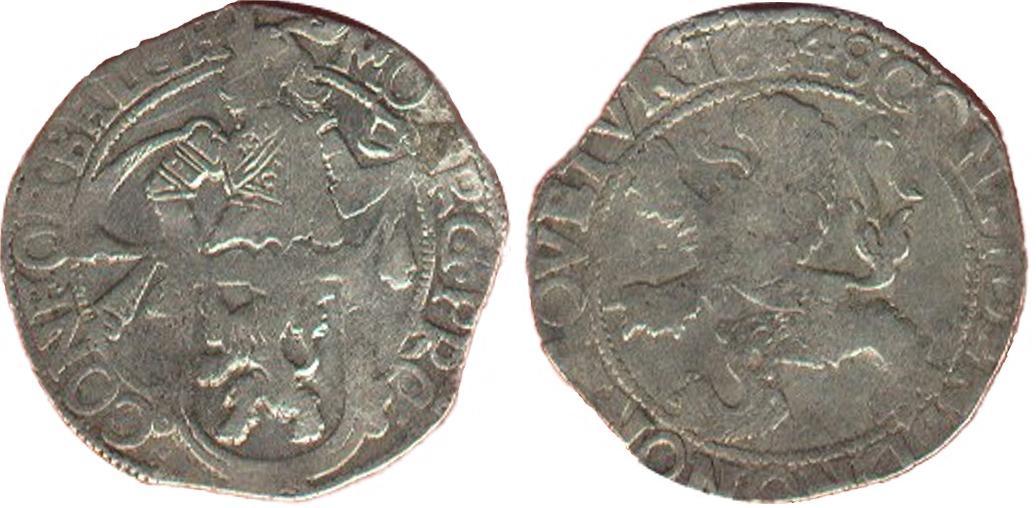
This silver Lion 48 Stuivers daalder from the Netherlands is dated 1648. The obverse features an armored knight looking to the right above a shield bearing the likeness of a lion with the legend MO.ARG.PRO.CON FOE.BELG.GEL. (Silver money of the Province of the Netherlands Confederation at Belgian Gelderland). The reverse design features a rampant lion looking to the left with the legend CONFIDENS DNO NON MOVETUR (Confidence in the Lord is not moved) and the date 1648 at the top. Weighs 20 grams of 0.885 fineness.
HOLLAND
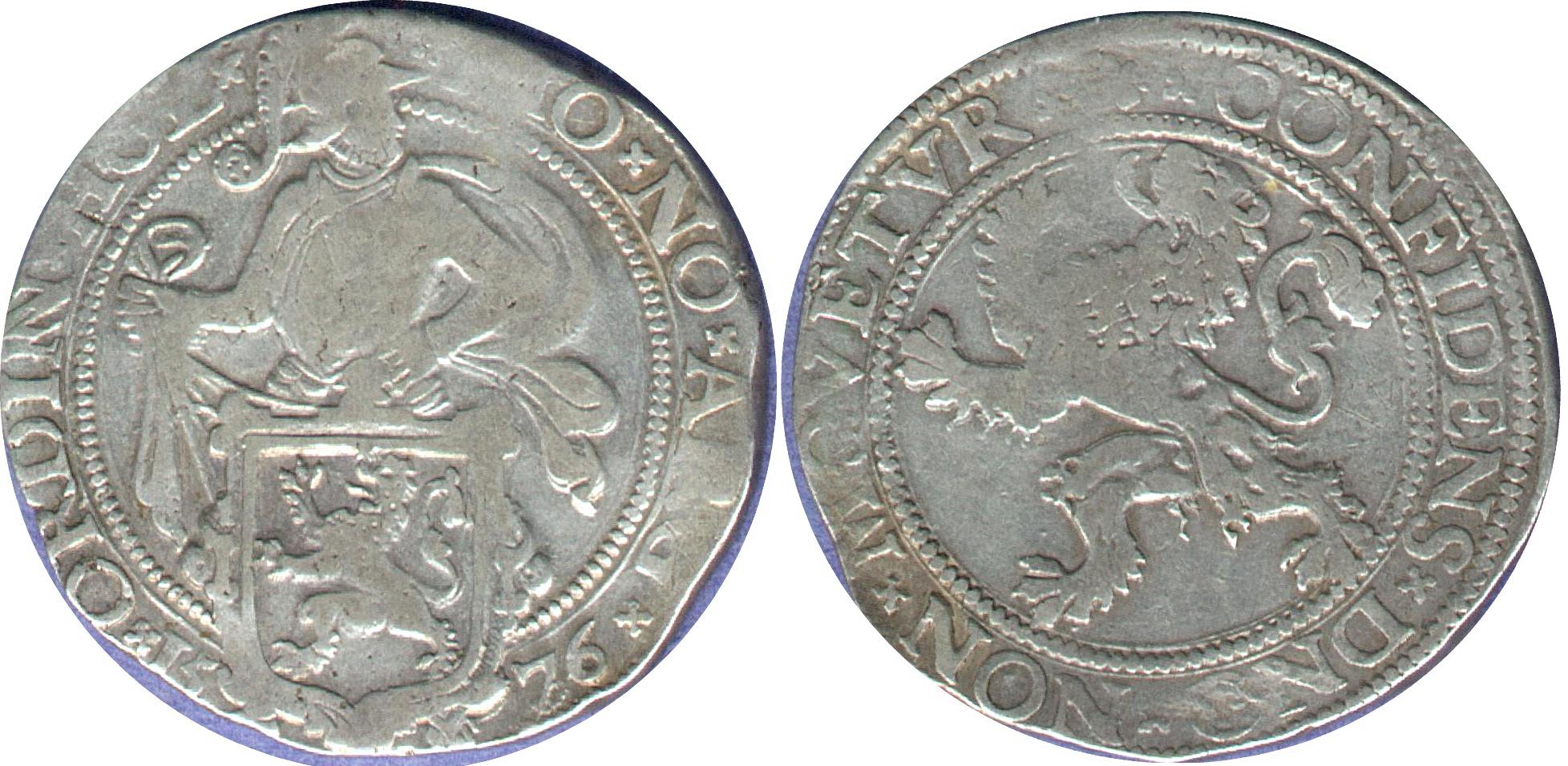
This silver Lion 48 Stuivers daalder from the Netherlands is dated 1576. The obverse features an armored knight looking to the right above a shield bearing the likeness of a lion with the legend MOx NOx ARGx x ORDINx HOLx (Coin Silver of the Province Holland) and the date 1576 at the bottom. The reverse design features a rampant lion looking to the left with the legend CONFIDENS DNO NON MOVETUR Weighs 20 grams of 0.885 fineness.
AUSTRIAN NETHERLANDS
The Austrian Netherlands, which corresponds roughly to present-day Belgium, came into being on 11 April 1713, when the Treaty of Utrecht awarded the lands to Austria as part settlement following the war with Spain. It passed to France in 1795, was part of the Kingdom of Netherlands from 1815 to 1830, and became the present Belgium as the result of the revolution of 1830 against William I, Prince of Orange and King of the Netherlands.
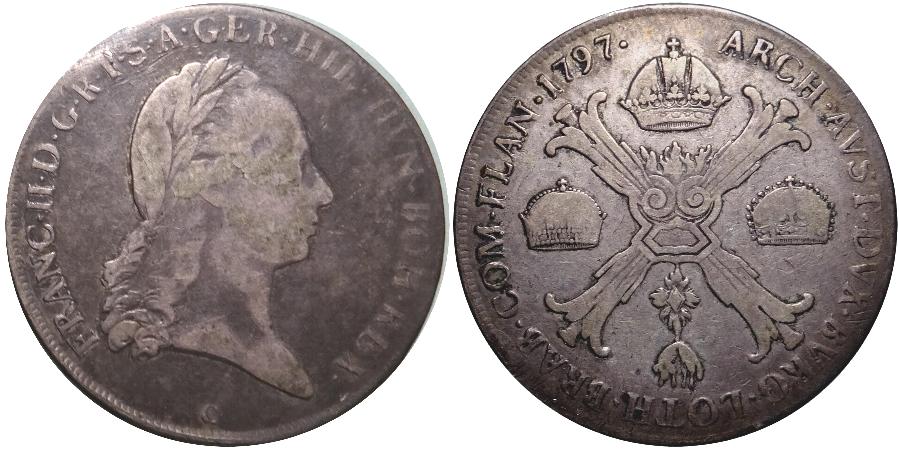
This is an one kronenthalerminted in 1797 in Prague. The obverse has Emperor Franz II with the legend FRANC·II·D·G·R·I·S·A·GER·HIE·HVN·BOH ·REX· (Francis II, By the Grace of God, Holy Roman Emperor, always August, of Germany, Jerusalem, Hungary, and Bohemia, King) and the mintmark C. The reverse has stylized arms with the legend ARCH·AVST·DVX·BVRG·LOTH·BRAB·COM·FLAN· (Archduke of Austria, Duke of Burgundy, Lorraine, Brabant, Count of Flanders) and the date.. Weighs 29.44 grams of 0.8263 fineness.
SPANISH NETHERLANDS
The Netherlands as an entity perhaps came into being when Philip the Good, duke of Burgundy (1419-1467) called all the Burgundian states together for a common session at Bruges in 1464. Charles the Bold continued to add to the territory and consolidated his power, which, however reverted to the States General at his death in 1477. His daughter Mary married the Austrian archduke Maximilian, and was succeeded by her only son, Philip the Handsome (1494-1506). He married Joanna of Spain, daughter of Ferdinand and Isabella, and their oldest son, Charles V, became king of Aragon and Castile in 1520, head of the Austrian house of Habsburg, and Holy Roman Emperor. The Netherlands passed under the regency of his aunts Margaret of Austria (1519-30) and Mary of Hungary (1531-55). Philip II (1556-98) was a Spaniard and resented by many of the Netherlanders, especially the Protestants and the higher nobility and clergy. The ruthless savagery of his governor the duke of Alba led to continued revolts, and finally to the Pacification of Ghent 1576, a union which was short lived. By the Union of Utrecht (1579) the northern provinces to all intents and purposes were separated from the southern ones.
The Spanish under Farnese, the duke of Parma, gradually regained supremacy in the southern provinces. Philip gave the provinces as dowry when his daughter. Isabella, married the archduke Albert of Austria in 1598. The Spanish Netherlands was to be an independent state based on Catholicism as the only recognized religion, and strong central government. Albert died in 1621 and Isabella in 1633, childless, and the provinces reverted to Philip IV of Spain. War with the United Netherlands and France followed until by the Peace Westphalia, concluding the Thirty Years War in 1648, Philip recognized the independence of the northern states. By the Peace of the Pyrenees in 1659 and the Peace of Aix-la-Chapelle in 1668, Louis XIV of France acquired Artois and other border districts. On the death of Charles II in 1700 the southern Netherlands passed to the new Bourbon king of Spain, the French duke Philip of Anjou. In 1701, Louis XlV compelled his grandson to turn the territory over to France, but by the Treaty of Utrecht concluding the War of the Spanish Succession, the provinces were given to Austria.. These provinces are pretty much today's territory of Belgium.
This is a Ducaton issued in Brabant in 1640. The obverse has Philip IV with the legend PHIL IIII D G HISP ET INDIAR REX. The mintmark a hand, denoting the Anvers Mint, is located in the middle of the date. The reverse has the coat-of-arms of the Spanish Netherlands with the legend ARCHID AVST DVX BVRG BRAB Zc. Weighs 32.5 grams of 0.944 fineness.
NETHERLANDS INDIES
Netherlands East Indies was the world's largest archipelago extending for more than 3,000 mi. along the equator from the mainland of southeast Asia to Australia. At present time, since the late 1940's, it is known as Indonesia. The Dutch were in control until 1942 when the Japanese invaded. At the end of World War II, with Japanese encouragement, Indonesia declared its independence. World War II Coinage Netherlands and Netherlands East Indies coins of the 1941-45 period were struck at U.S. Mints (P - Philadelphia, D - Denver, S - San Francisco) and bear the mint mark and a palm tree (acorn on Homeland issues) flanking the date.
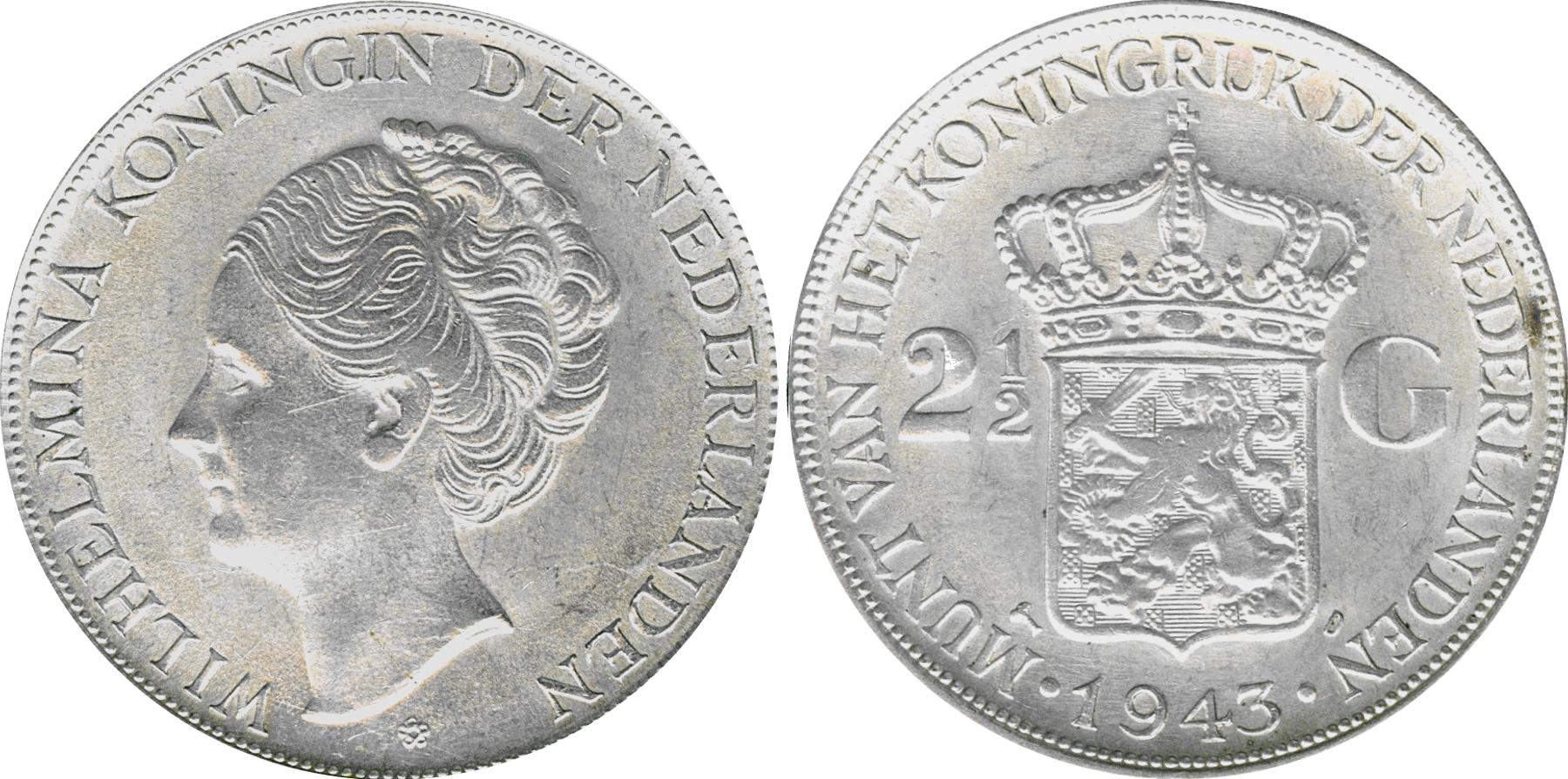
This is a two and one half Guilder coin minted at Denver. The obverse has the image of Queen Wilhelmina and the reverse the Dutch arms. The coin bears no reference to the Netherlands Indies but was issued for that entity after liberation from the Japanese occupiers. Weighs 25 grams of 0.720 fineness.
NEW HEBRIDES
The New Hebrides were discovered by Portuguese navigator Pedro de Quiros in 1606, visited by French explorer Bougainville in 1768, and named by British navigator Capt. James Cook in 1774. Ships of all nations converged on the Islands to trade for sandalwood, prompting France and Britain to relinquish their Individual claims and declare the Islands a neutral zone in 1878. The New Hebrides were placed under the control of a mixed Anglo-French commission of naval officers during the native uprisings of 1887, until achieving independence as Vanuatu, within the Commonwealth of nations on 30 Sept. 1980.
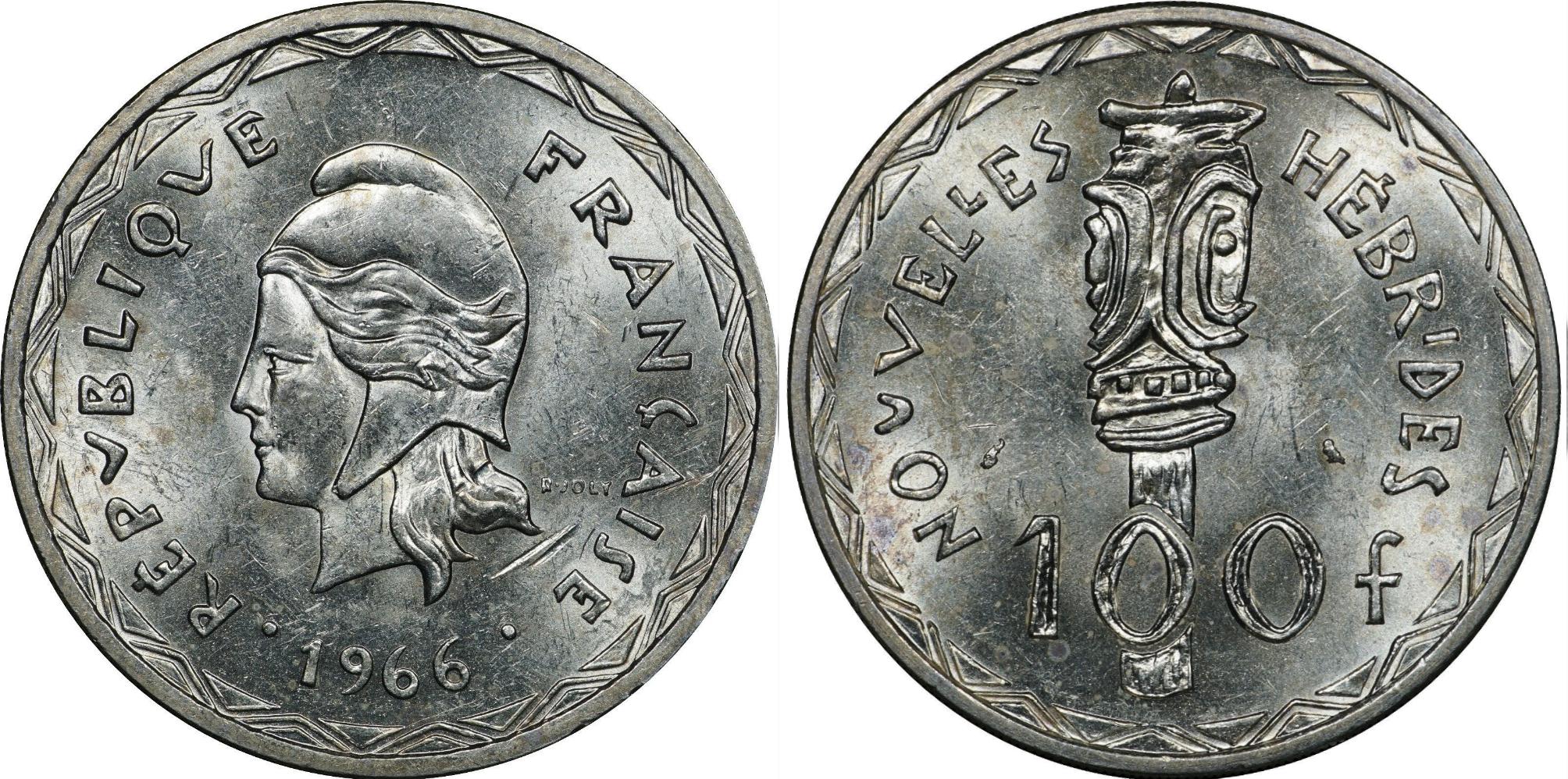
This one hundred Francs coin was minted in 1966 in Paris. The obverse has a likeness of Marianne, symbolizing Liberty. The reverse has a native scepter. Weighs 25 grams of 0.835 fineness.
NEW ZEALAND
Now Zealand is a parliamentary state located in the Southwest Pacific 1,250 miles (2,011 km.) east of Australia. The first European to sight New Zealand was the Dutch navigator Abel Tasman in 1642. The islands were explored by British navigator Capt. James Cook who surveyed it in 1769 and annexed the land to Great Britain. The British government disavowed the annexation and for the next 70 years the only white settlers to arrive were adventurers attracted by the prospects of lumbering, sealing, and whaling. Great Britain annexed the land in 1840 by treaty with the native chiefs and made it a dependency of New South Wales. The colony was granted self-government in 1852, a ministerial form of government in 1856, and full dominion status on 26 Sept. 1907 Full internal and external autonomy, which New Zealand had in effect possessed for many years, was formally extended in 1947. New Zealand is a member of the Commonwealth of Nations. Elizabeth Il ls Head of State as Queen of New Zealand. Prior to 1933 British coins were the official legal tender but Australian coins were accepted in small transactions. Currency fluctuations caused a distinctive New Zealand coinage to be introduced in 1933. The 1935 Waitangi crown and proof set were originally intended to mark the introduction but delays caused their date to be changed to 1935. The 1949 and 1953 crowns commemorated Royal visits
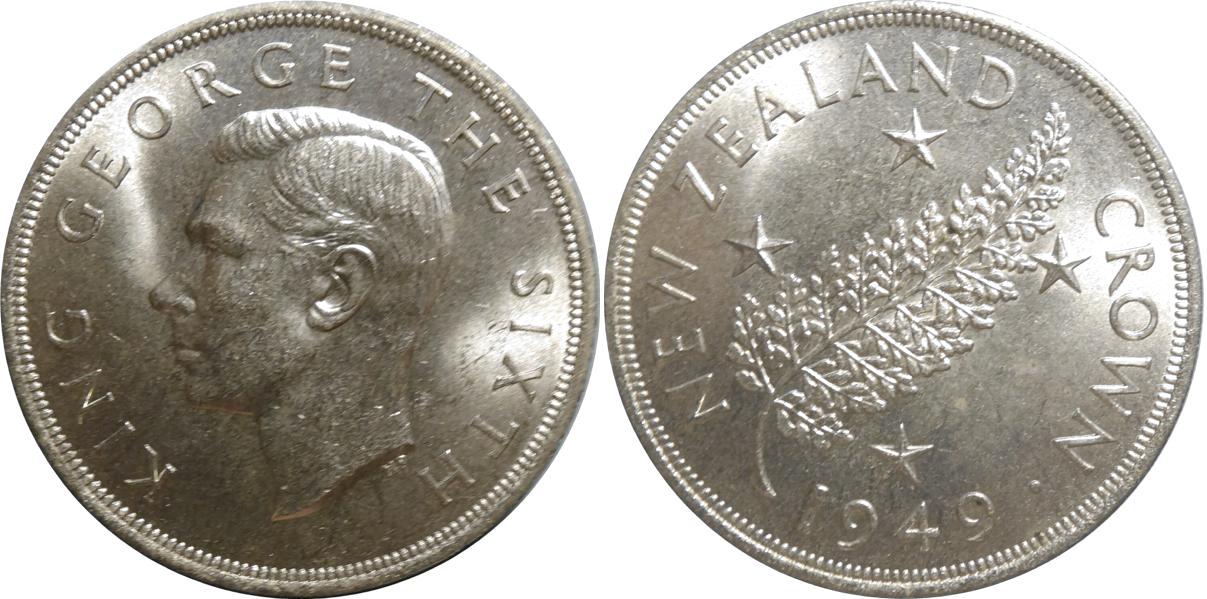
This is a five shilling piece minted in 1949 to celebrate the proposed Royal Visit. Weighs 28 grams of 0.500 fineness.
NORWAY
The Kingdom of Norway (Norge, Noreg) is a constitutional monarchy located in northwestern Europe including the island territories of Spitzbergen (Svalbard) and Jan Mayen. A united Norwegian kingdom was established in the 9th century, the era of the indomitable Norse Vikings who ranged far and wide, visiting the coasts of northwestern Europe, the Mediterranean, Greenland, and North America. In the 13th century the Norse kingdom was united briefly with Sweden, then passed through inheritance in 1380 to the rule of Denmark which was maintained until 1814. In 1814 Norway fell again under the rule of Sweden. The union lasted until 1905 when the Norwegian Parliament arranged a peaceful separation and invited a Danish prince (King Haakon VII) to ascend the throne of an Independent Kingdom of Norway

This is the only silver crown-sized coin issued by Norway. This twenty-five kroner piece was minted in 1970 to celebrate the 25th anniversary of victory in World War II. The obverse has conjoined busts of Haakon VII (the war king) and Olav V (then king). The reverse commemorate the victory on 8 May 1945. Weighs 29 grams of 0.875 fineness.
PANAMA
The Republic of Panama, a Central American Country situated between Costa Rica and Colombia. Discovered in 1501 by the Spanish conquistador Rodrigo Galvan de Bastidas, the land of Panama was soon explored and after a few attempts at settlement was successfully colonized by the Spanish. It was in Panama in 1513 that Vasco Nunez de Balboa became the first European to see the Pacific Ocean. The first Pacific-coast settlement, founded in 1519 on the site of a village the natives called Panama, was named Nuestra Senora de Ia Asuncion de Panama (Our Lady of the Assumption of Panama). The settlement soon became a city and eventually, albeit briefly, an Audiencia (judicial tribunal).
In 1578 the city of Panama, being a primary transshipment center for treasure and supplies to and from Spain's South Pacific-coast colonies, was chosen for a new mint, and minting had begun there by 1580. By late 1582 or 1583 production was halted, possibly due to the fact that there were no nearby silver mines to sustain it. In it's brief operation, the Panama Mint must not have made many coins, as the corpus of surviving specimens known today from this colonial mint is less than 40. The city of Panama, known today as the Old City of Panama, was sacked and burned in 1671 by the famous Henry Morgan in one of the greatest pirate victories against the Spanish Main.
Panama declared its independence in 1821 and joined the Confederation of Greater Colombia. In 1903, after Colombia rejected a treaty enabling the United States to build a canal across the Isthmus, Panama with the support of the United States proclaimed its independence from Colombia and became a sovereign republic.

This was the first crown issued by the republic of Panama in 1904. The coin is the exact same specification as the U.S. dollar except it is denominated at fifty centesimos! Obverse has Balboa. Reverse the arms of Panama. Weighs 25 grams of 0.900 fineness.
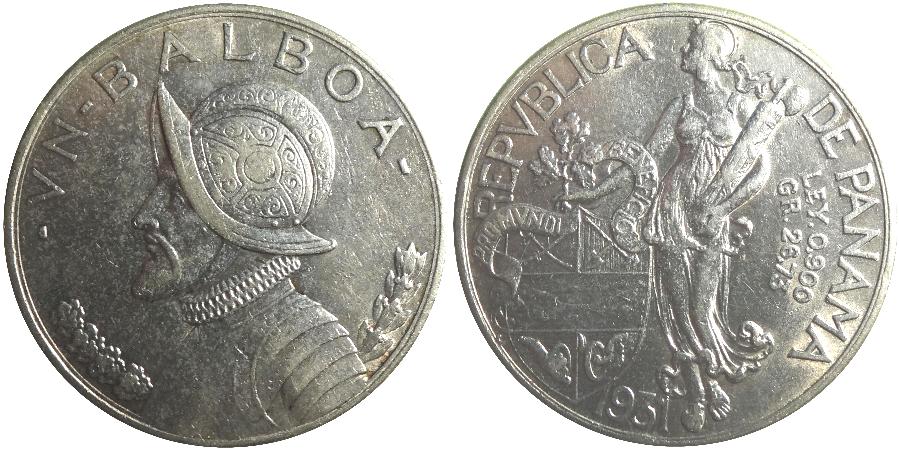
This is a one Balboa crown issued by Panama in 1931. Obverse has Balboa. Reverse has Liberty standing, holding fasces in one arm and an oak sprig in the other, resting the arm with the oak on the Panamanian shield. The country name is above, the purity and weight are to the right, and the date is below. Weighs 25 grams of 0.900 fineness.
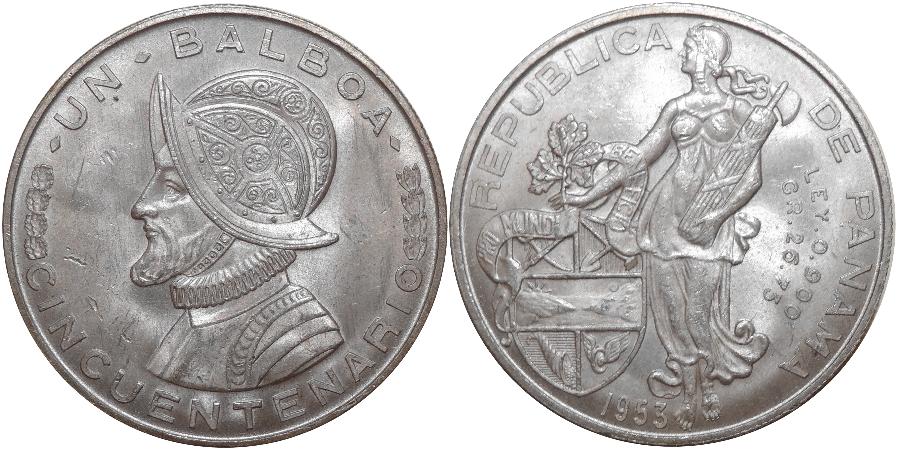
This is a one Balboa crown issued by Panama in 1953 to celebrate the 50th anniversary of the founding of the republic. Obverse has Balboa with the legend denoting the 50th celebration. Reverse has Liberty standing, holding fasces in one arm and an oak sprig in the other, resting the arm with the oak on the Panamanian shield. The country name is above, the purity and weight are to the right, and the date is below. Weighs 25 grams of 0.900 fineness.
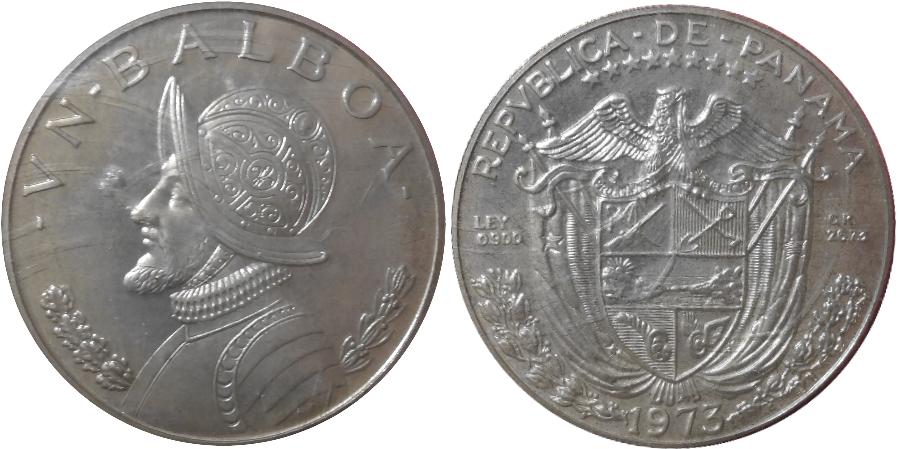
This is a one Balboa crown issued by Panama in 1973. Obverse has Balboa. Reverse the arms of Panama. Weighs 25 grams of 0.900 fineness.
PARAGUAY
The Republic of Paraguay is a landlocked country
in the heart of South America surrounded by Argentina, Bolivia, and Brazil. Paraguay
was first visited by a ship-wrecked Spaniard named Alejo Garcia, in 1524. The interior
was explored by Sebastian Cabot in 1527 and 1528, when he sailed up the Parana and
Paraguay rivers. Asuncion, which would become the center of a Spanish colonial province
embracing much of southern South America, was established by the Spanish explorer
Juan de Salazar on 25 Aug. 1537. For 150 years the history of Paraguay was largely
the history of the agricultural colonies established by the Jesuits in the south
and east to Christianize the Indians. In 1811, following the outbreak of the South
American wars of independence, Paraguayan patriots over-threw the local Spanish
authorities and proclaimed their country's independence. During the Triple Alliance
War (1864-1870) in which Paraguay faced Argentina, Brazil, and Uruguay, Asuncion's
ladies gathered in an Assembly on 24 Feb. 1867 and decided to give up their Jewelry
in order to help the national defense. The President of the Republic, Francisco
Solano Lopez, accepted the offering and ordered one twentieth of it be used to mint
the first Paraguayan gold coins according to the Decree of the 11 Sept.1867
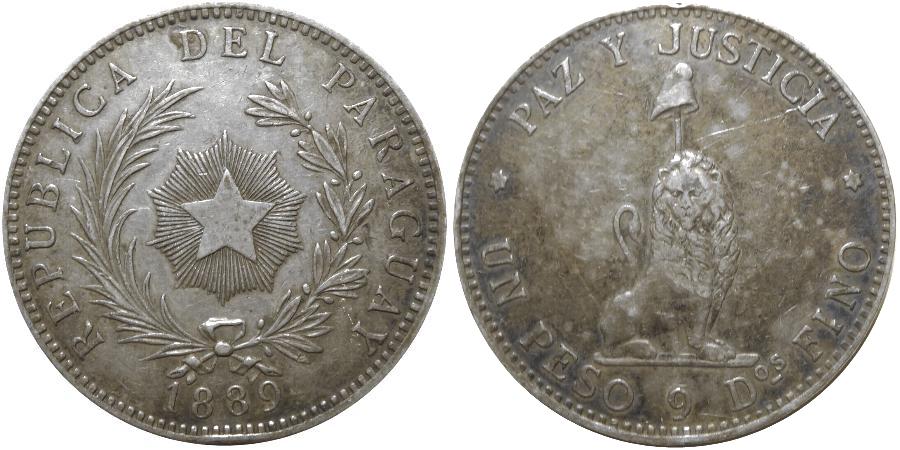
This is an one Peso coin minted in 1889. Weighs 25 grams of 0.900 fineness.
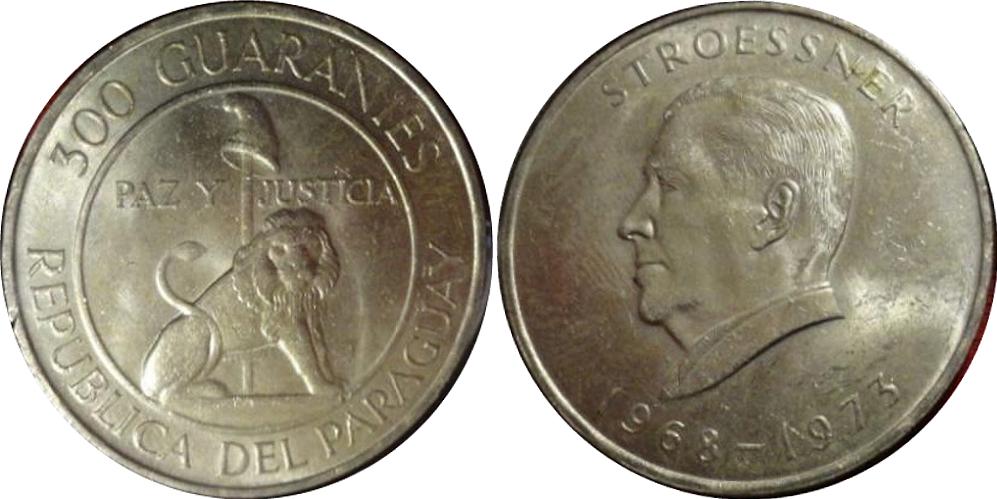
This is a three hundred Guaranies coin minted in 1968. The reverse has a bust of President Stroessner. Weighs 26.6 grams of 0.720 fineness.
PERSIA
Persia, now known as Iran, is located between the Caspian Sea and the Persian Gulf in southwestern Asia. Iran is one of the world's most ancient and resilient nations. Strategically astride the lower land gate to Asia, it has been conqueror and conquered, sovereign nation and vassal state, ever emerging from its periods of glory or travail with its culture and political individuality intact. Iran (Persia) was a powerful empire under Cyrus the Great (600-529 BC), its borders extending from the Indus to the Nile. It has also been conquered by the predatory empires of antique and recent times - Assyrian, Medean, Macedonian, Seljuq, Turk, Mongol, and more recently been coveted by Russia, the Third Reich, and Great Britain. Revolts against the absolute power of the Persian shahs resulted in the establishment of a constitutional monarchy in 1906. The last Shah, Mohammad Reza Pahlevi, was overthrown by Mohammedan radicals in 1979 after which the Islamic Republic was established.
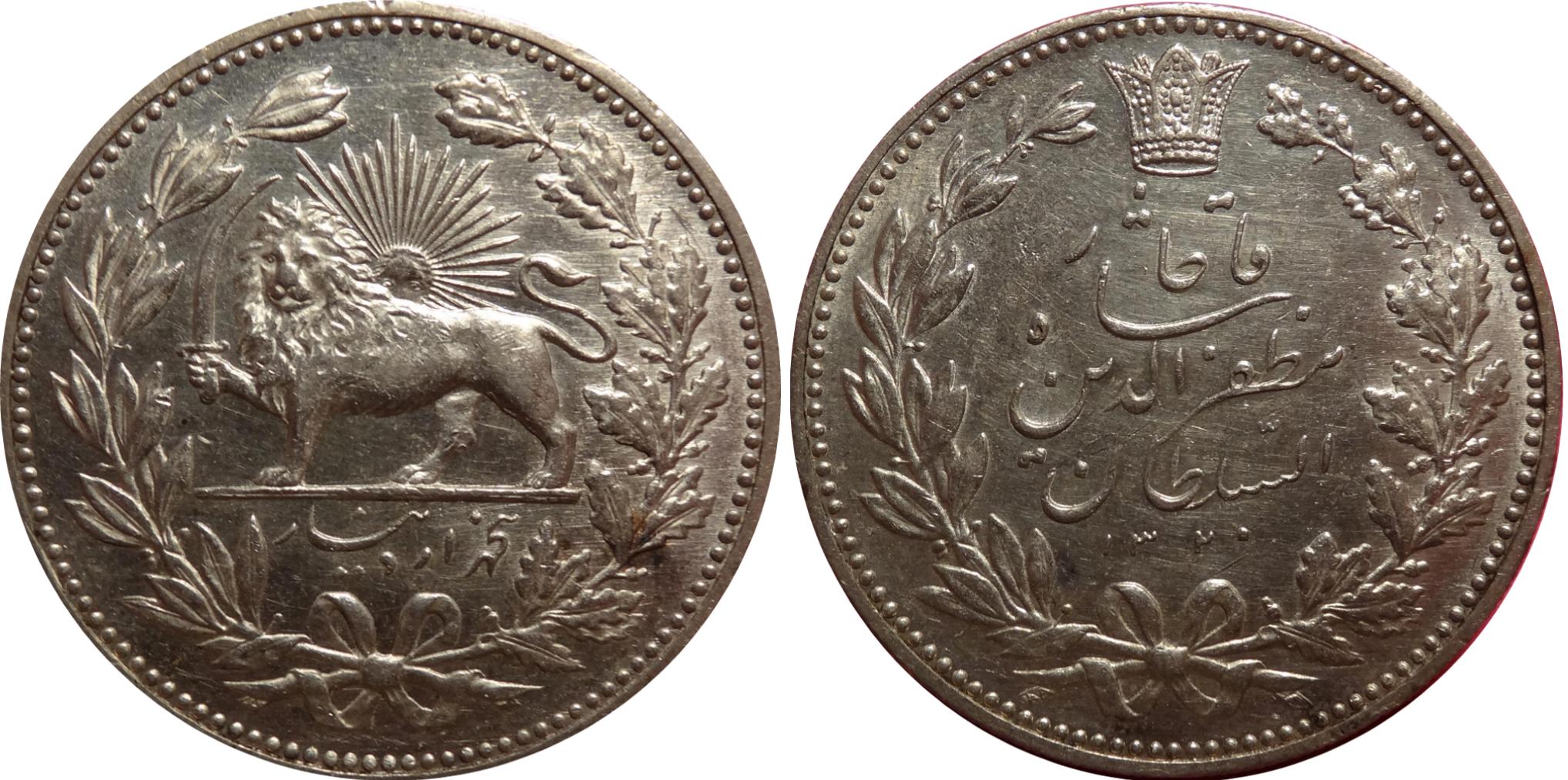
This is a 5000 Dinar or 5 Kran piece minted in 1320 AH (1903 AD) under Muzaffar al-Din Shah. The obverse has the Farsi legend السلطان مظفر الدین شاه قاجار (Sultan Muzaffar al-Din Shah Qajar). The reverse has the imperial arms with the legend پنجهزار دینار (5000 dinar). Weighs 23 grams of 0.900 fineness.
PERU
The Republic of Peru is located on the Pacific coast of South America. Once part of the great Inca Empire that reached from northern Ecuador to central Chile, the conquest of Peru by Francisco Pizarro began in 1531. Desirable as the richest of the Spanish viceroyalties, it was torn by warfare between avaricious Spaniards until the arrival in 1569 of Francisco de Toledo, who initiated 2½ centuries of efficient colonial rule, which made Lima the most aristocratic colonial capital and the stronghold of Spain's American possessions. Jose de San Martin of Argentina proclaimed Peru's independence on 28 July 1821;Simon Bolivar of Venezuela secured it in December 1824 when he defeated the last Spanish army in South America. After several futile attempts to re-establish its South American empire, Spain recognized Peru's independence in 1879. Andres de Santa Cruz, whose mother was a high-ranking Inca, was the best of Bolivia's early presidents, and temporarily united Peru and Bolivia 1836-39, thus realizing his dream of a Peruvian/Bolivian confederation.
This prompted the separate coinages of North and South Peru. Peruvian resistance and Chilean intervention finally broke up the confederation, sending Santa Cruz into exile. A succession of military strongman presidents ruled Peru until Marshall Castilla revitalized Peruvian politics in the mid-19th century and repulsed Spain's attempt to reclaim its one-time colony. Subsequent loss of southern territory to Chile in the War of the Pacific, 1879-81, and gradually increasing rejection of foreign economic domination, combined with recent serious inflation, affected the country numismatically.
As a result of the discovery of silver at Potosi in 1545, a mint was eventually authorized in 1565 with the first coinage taking place in 1568. The mint had an uneven life span during the Spanish Colonial period from 1568-72. It was closed from 1573-76, reopened from 1577-88. It remained closed until 1659-1660 when an unauthorized coinage in both silver and gold were struck. After being closed in 1660, it remained closed until 1684 when it struck cob style coins until 1752.
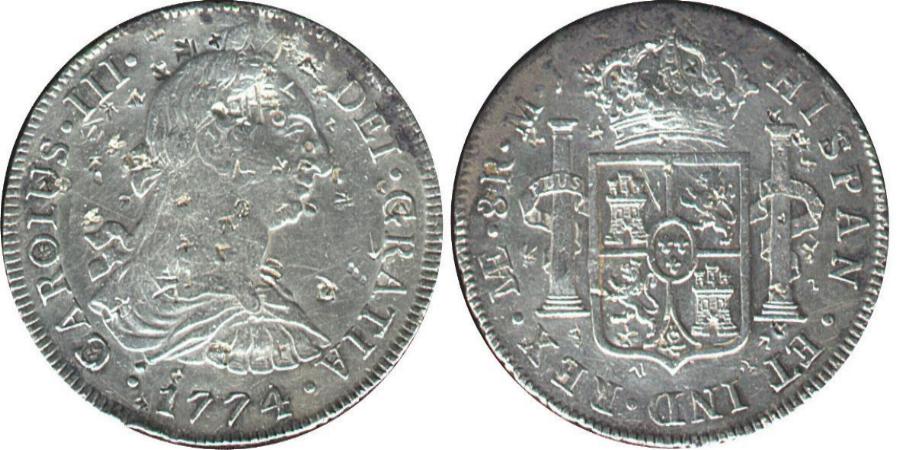
This is a Royalist eight reales coin minted in Lima in 1774. The obverse has King Charles III and the reverse has the Spanish arms. The coin has numerous Chinese chopmarks attesting to its purity. Weighs 27.07 grams of 0.896 fineness.
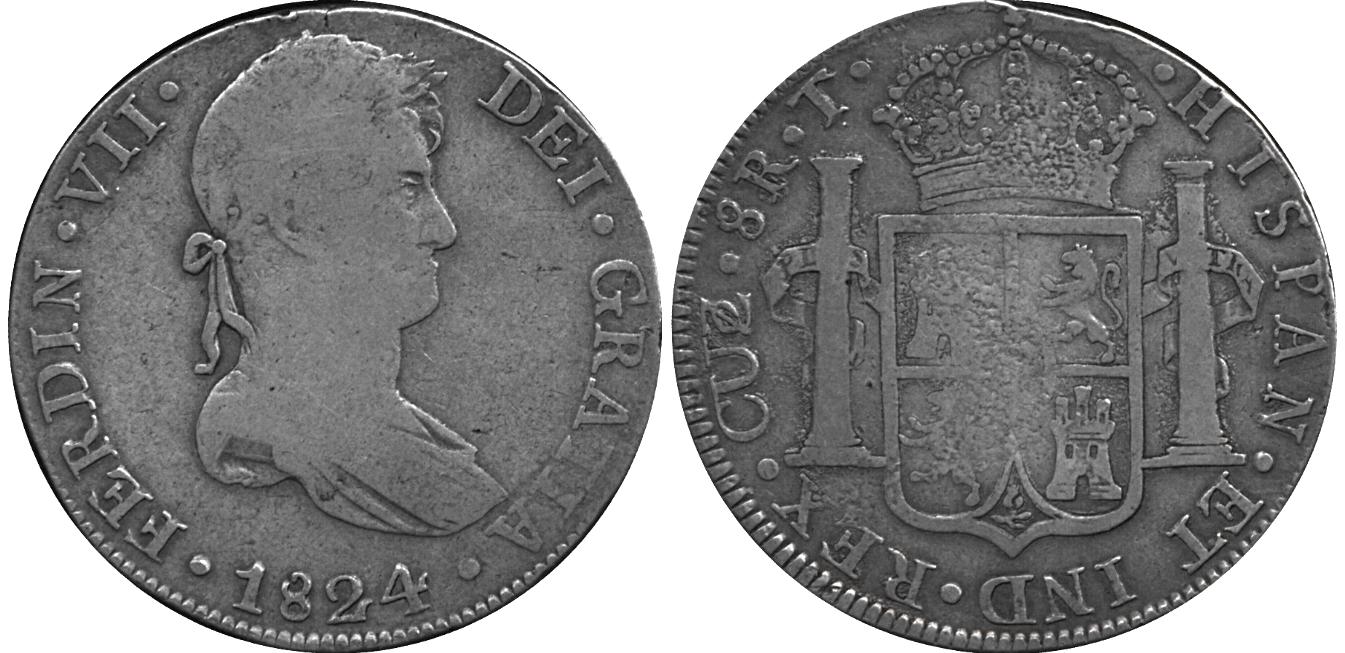
This is a Royalist issue minted in Cuzco in 1824. It is one of the last Spanish coins used for its South American colonies. The obverse has Ferdinand VII, King of Spain. The reverse has the Spanish coat-of-arms with the CUZO mintmark. Weighs 27 grams of 0.896 fineness.
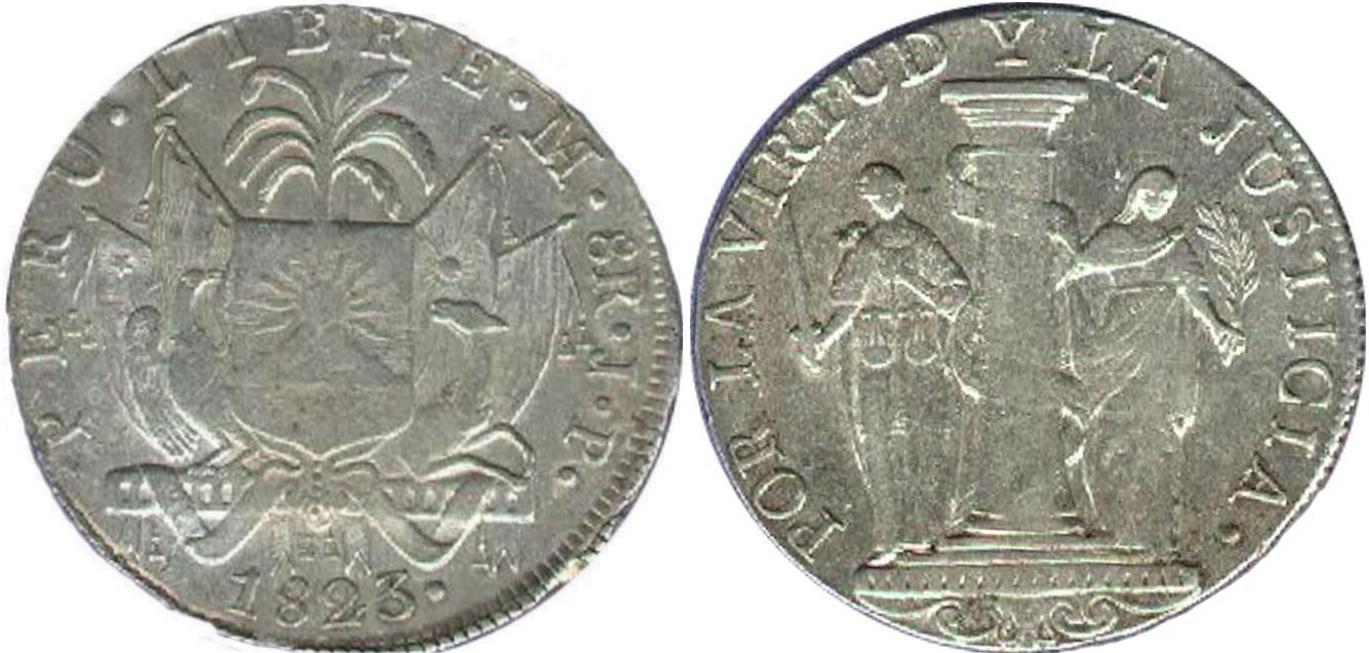
This was one of the first crowns struck for Free Peru. It was minted in Lima in 1823. The obverse has a palm tree over the coat-of-arms with PERU - LIBRE - LIMAE - 8R - J - P- 1823 (the assayers were .Juan Martínez de Roxas y Pablo Cano Melgarejo). The reverse features the pillar of state flanked by Justice on the left and Liberty on the right with the motto POR LA VIRTUD Y LA JUSTICIA. Weighs 25 grams of 0.903 fineness.
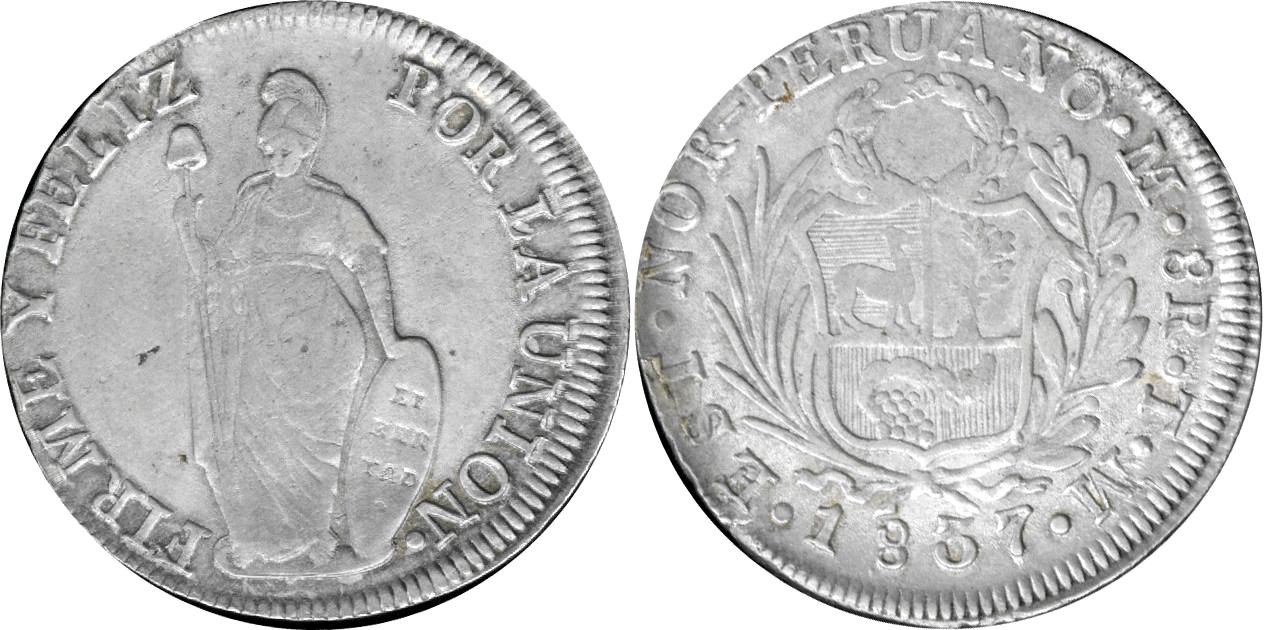
This 8 reales piece was issued by the North Peruvian State and was minted in Lima in 1837. The obverse has a standing Liberty with the legend FIRME Y FELIZ POR LA UNION. The reverse has the Peruvian coat-of-arms and the legend EST-NOR-PERUANA - LIMAE - 8R - T -M - 1837. Weighs 27 grams of 0.900 fineness.
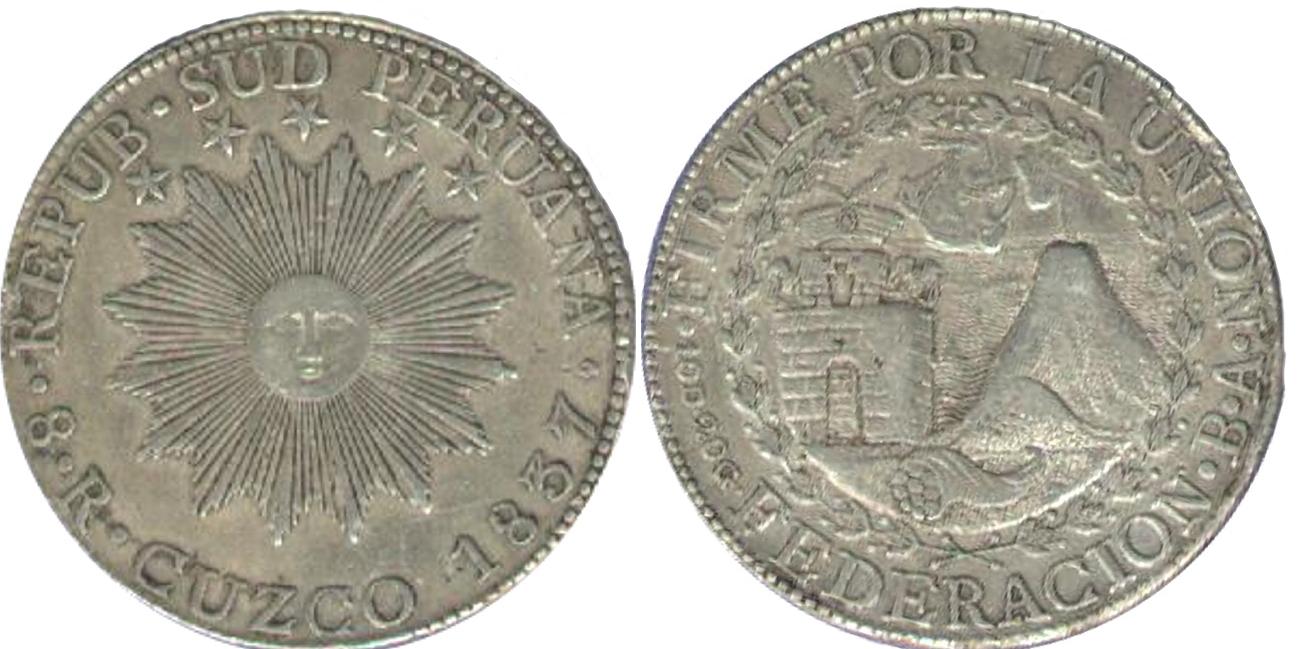
This eight reales coin from the South Peruvian Republic was minted in Cuzco in 1837. The obverse features a radiant Sun with the motto REPUB - SUD PERUANA - 8 - R - CUZCO - 1837. The reverse has a fortress, ship, volcano, and cornucopia within a wreath and the legend FIRME POR LA UNION - 10D20G FEDERACION - B -A. Weighs 27 grams of 0.900 fineness.
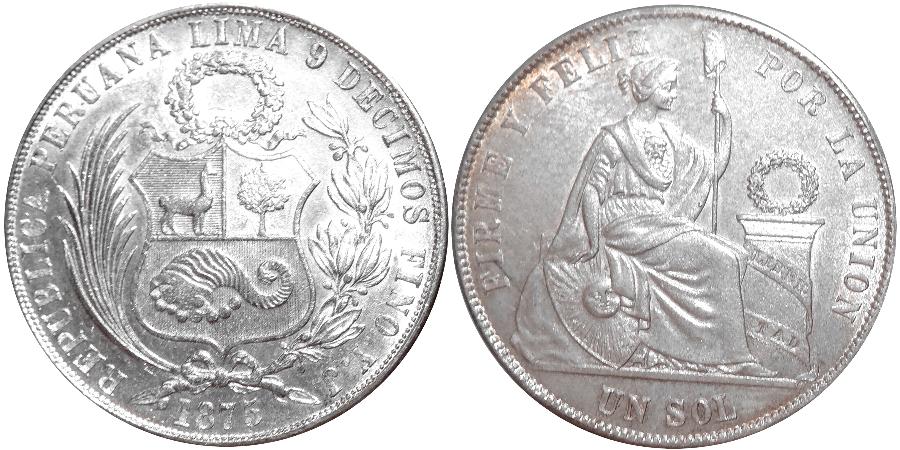
This is an one Sol piece minted in 1875. Obverse has Peru's arms in a wreath with the legend REPUBLICA PERUANA LIMA 9 DECIMOS FINO Y.J. and the date. Reverse has seated Liberty with the legend FIRME Y FELIZ POR LA UNION and the denomination. Weighs 25 grams of 0.900 fineness.
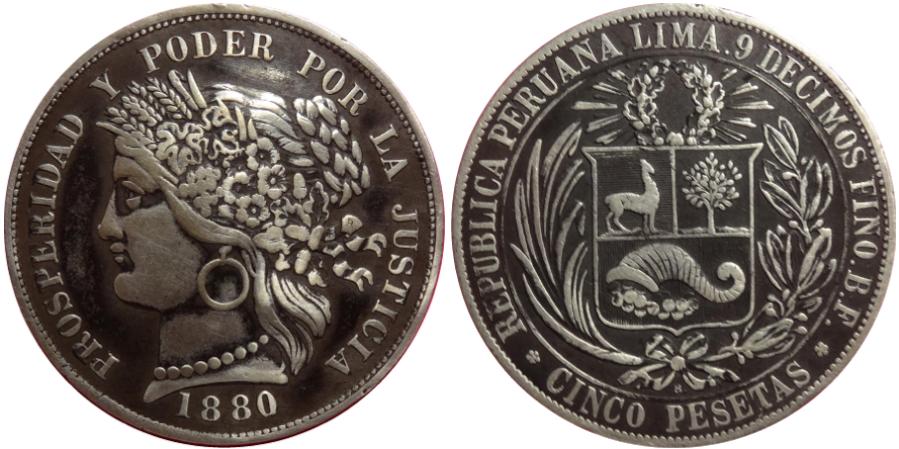
This is a five pesetas piece minted in 1880. The obverse has Liberty with the legend PROSPERIDAD Y PODER POR LA JUSTICIA and the date. Reverse has seated Liberty with the legend REPUBLICA PERUANA LIMA. 9 DECIMOS FINO.B.F. and the denomination. Weighs 25 grams of 0.900 fineness.
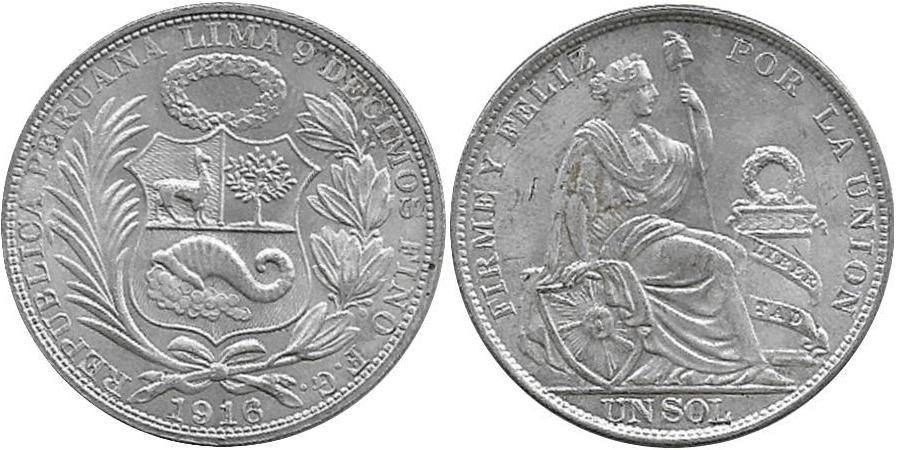
This is an one Sol piece minted in 1916. Obverse has Peru's arms in a wreath with the legend REPUBLICA PERUANA LIMA 9 DECIMOS FINO F.G.. and the date. Reverse has seated Liberty with the legend FIRME Y FELIZ POR LA UNION and the denomination. Weighs 25 grams of 0.900 fineness.
PHILIPPINES
The Philippines, an archipelago in the western Pacific 500 miles (805 km.) from the southeast coast of Asia, has an area of 115,830 sq. mi. (300,000 sq. km.). Migration to the Philippines began about 30,000 years ago when land bridges connected the islands with Borneo and Sumatra. Ferdinand Magellan claimed the islands for Spain in 1521. The first permanent settlement was established by Miguel de Legazpi at Cebu April 1565. Manila was established in 1572. A British expedition captured Manila and occupied the Spanish colony in October 1762, but returned it to Spain by the treaty of Paris, 1763. Spain held the Philippines despite growing Filipino nationalism until 1898 when they were ceded to the United States at the end of the Spanish-American War.
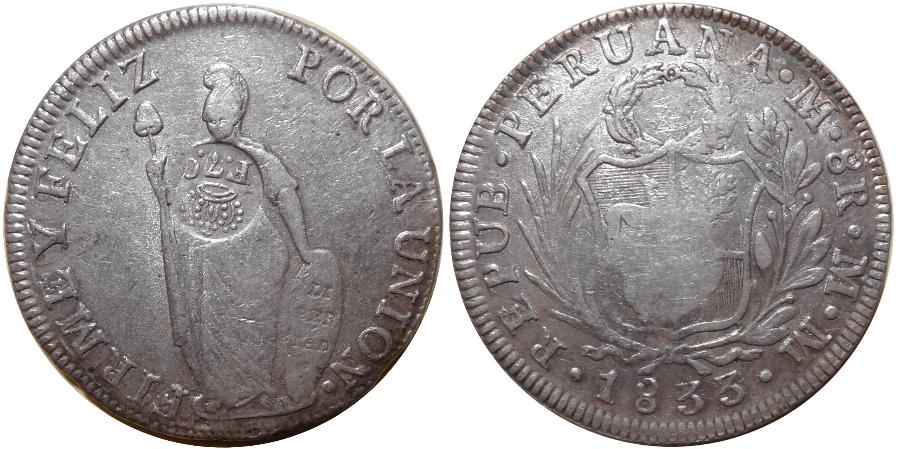
The first silver coins meant for circulation in the Philippines were counterstamped 8 reales pieces from American former Spanish colonies. The counterstamp has a crown and the abbreviation on the ruler it was struck under, F-VII- for Ferdinand VII on a Peruvian 1833 8 reales. Weighs 27 grams of 0.900 fineness.
The first silver coins meant for circulation in the Philippines were counterstamped 8 reales pieces from American former Spanish colonies. The counterstamp has a crown and the abbreviation on the ruler it was struck under Y-II- for Isabella II. on a Peruvian 1834 8 reales. Weighs 27 grams of 0.900 fineness.
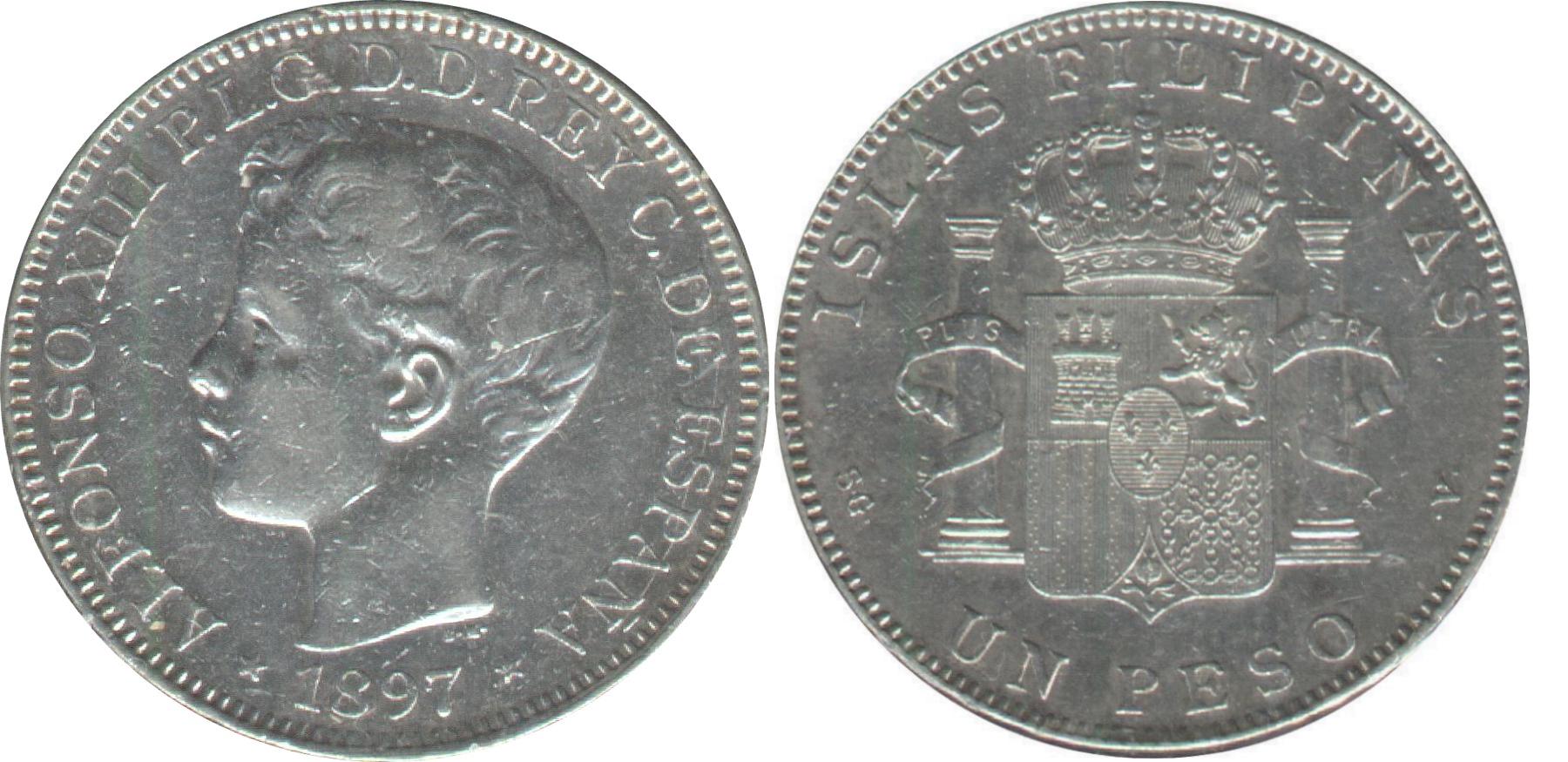
This is the only crown sized coin minted specifically for the Spanish colony of the Philippines. It is a 1 Peso dated 1897. Obverse has King Alfonso XIII as a youth. The reverse has the Spanish arms. Weighs 25 grams of 0.900 fineness.
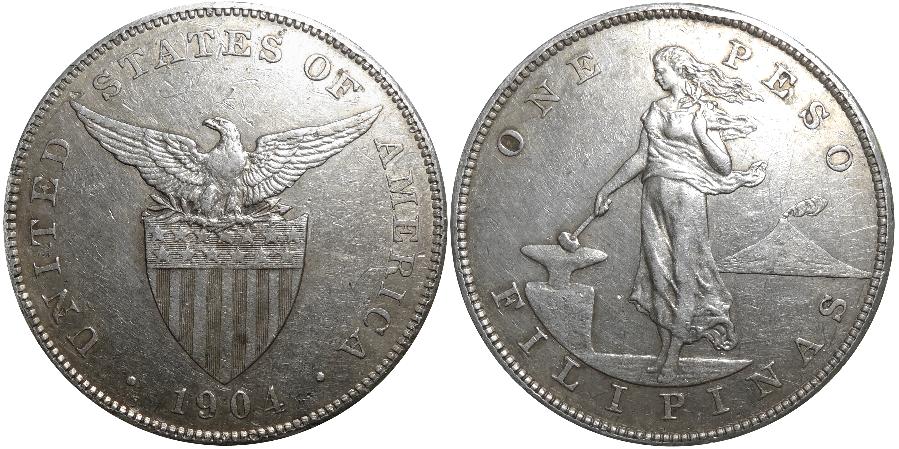
This is a an one Peso piece issued under the U.S. Administration of the islands in 1904. The obverse had a stylized U.S. arms. The reverse has a standing woman with her right hand holding hammer resting on anvil. The volcano Mt. Mayon is on right. The peso was devalued in 1907 and subsequent pesos weighed 20 grams of 0.800 fineness. Weighs 26.96 grams of 0.900 fineness.
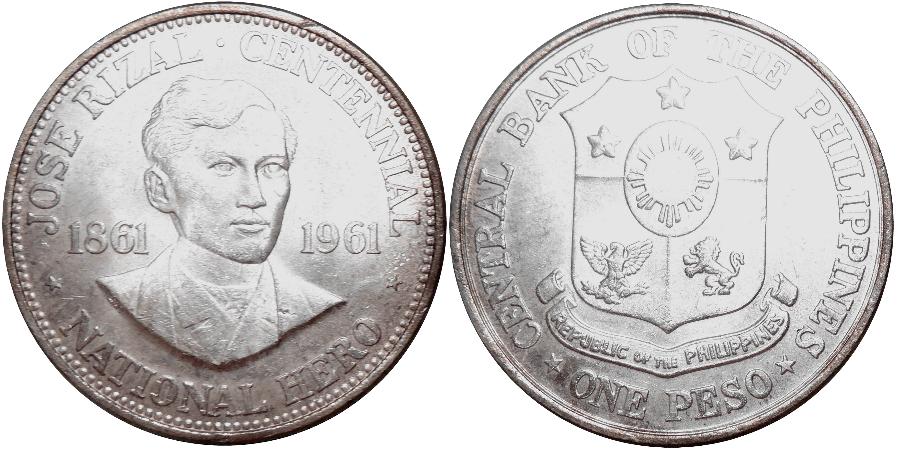
This is an one peso commemorative issued by the republic honoring the 100th anniversary of the birth of patriot Dr. Jose Rizal. The obverse features his image. The obverse has the republic's arms. Weighs 26 grams of 0.900 fineness.
POLAND
Poland is located in central Europe. Poland, which began as a Slavic duchy in the 10th century and reached its peak of power between the 14th and 16th centuries, has had a turbulent history of invasion, occupation or partition by Mongols, Turkey, Transylvania, Sweden, Austria, Prussia, and Russia and in modern times by the German Third Reich. The first partition took place in 1772. Prussia took Polish Pomerania, Russia took part of the eastern provinces, and Austria occupied Galicia, in which lay the capital city of Lwów. The second partition occurred in 1793 when Russia took another slice of the eastern provinces and Prussia took what remained of western Poland. The third partition, 1795, literally removed Poland from the map. Russia took what was left of the eastern provinces. Prussia seized most of central Poland, including Warsaw. Austria took what was left of the south. Napoleon restored to Poland much of the territory lost to Prussia and Austria, but after his defeat another partition returned the Duchy of Warsaw to Prussia, made Krakow into a tiny republic, and declared what remained to be the Kingdom of Poland under the czar and in permanent union with Russia.
This technically not a crown but is the largest silver coin minted during the Polish revolution of 1830-1. It is a 5 Polish Złoty minted in Warsaw in 1831. The obverse has the Polish arms with the legend KROLESTWO POLSKIE (Kingdom of Poland) The reverse has the denomination with the legend 17 211/625 Z GRZIW · CZYST · KOL, and the date. Weighs 15.6 grams of 0.868 fineness.
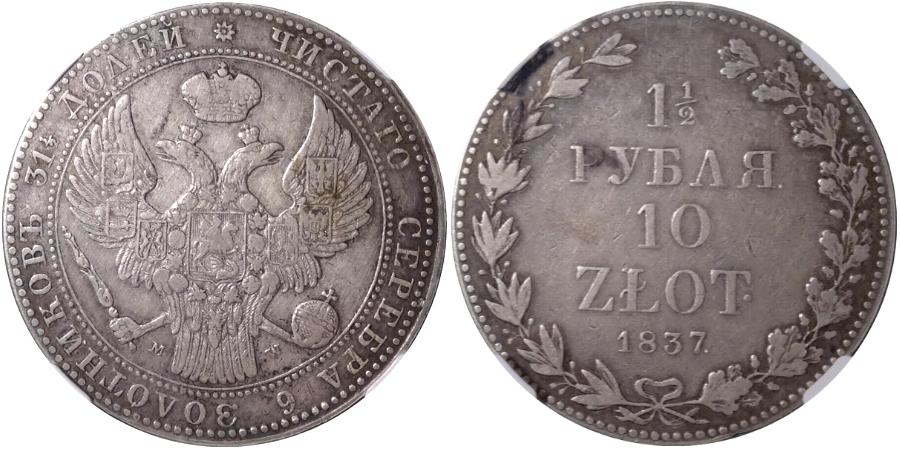
This is a 1 Ruble / 10 Polish Złoty coin minted at the Warsaw Mint in 1837 after the Russians crushed the Revolution. The obverse has the imperial Russian eagle with shields of Kazan, Astrakhan and Siberia on the eagle's right wing and Poland, the Taurica (Crimea) and Finland on the eagle's left wing encircled by the Russian legend ЧИСТАГО СЕРЕБРА 6 ЗОЛОТНИКОВЪ 31½ ДОЛЕЙ (Pure Silver 6 Zolotnikov 31½ Dolei) and the mintmark M W for the Warsaw Mint. The reverse has the denomination in Russian and Polish currency. Weighs 32 grams of 0.868 fineness.
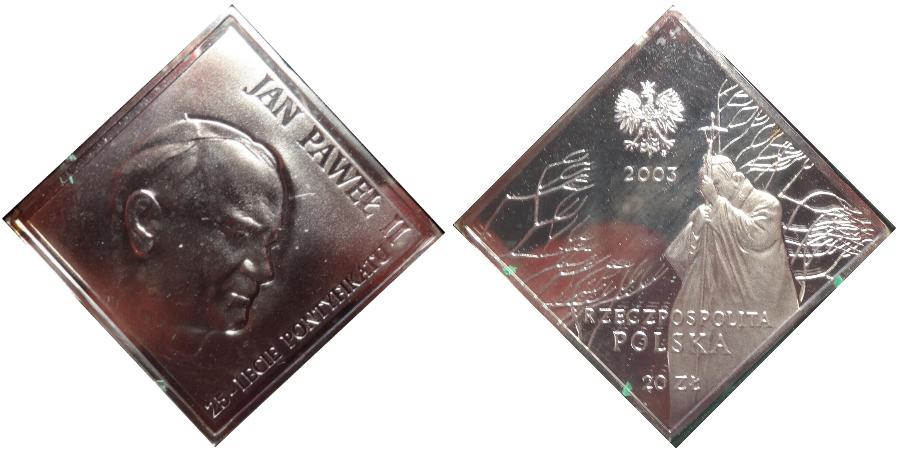
This is a 20 Złoty coin minted in 2003 to honor the Saint Pope John Paul II, a Polish native. Weighs 28.28 grams of 0.925 fineness.
PORTUGAL
The Portuguese Republic is located in the western part of the Iberian Peninsula in southwestern Europe. After centuries of domination by Romans, Visigoths, and Moors, Portugal emerged in the 12th century as an independent Kingdom financially and philosophically prepared for the great period of exploration that would soon follow. Attuned to the inspiration of Prince Henry the Navigator (1394-1460), Portugal's daring explorers of the l5th and 16th centuries roamed the world's oceans from Brazil to Japan in an unprecedented burst of energy and endeavor that culminated in 1494 with Portugal laying claim to half the transoceanic world. Unfortunately for the fortunes of the tiny Kingdom, the Portuguese population was too small to colonize this vast territory. Less than a century after Portugal laid claim to half the world, English, French, and Dutch trading companies had seized the lion's share of the world's colonies and commerce, and Portugal's place as an imperial power was lost forever. The monarchy was overthrown in 1910 and a republic was established. On 25 April 1974, the government of Portugal was seized by a military junta which reached agreements providing for independence for the Portuguese overseas provinces of Portuguese Guinea (Guinea-Bissau), Mozambique, Cape Verde Islands, Angola, and St. Thomas and Prince Islands (Sao Tome and Principe).
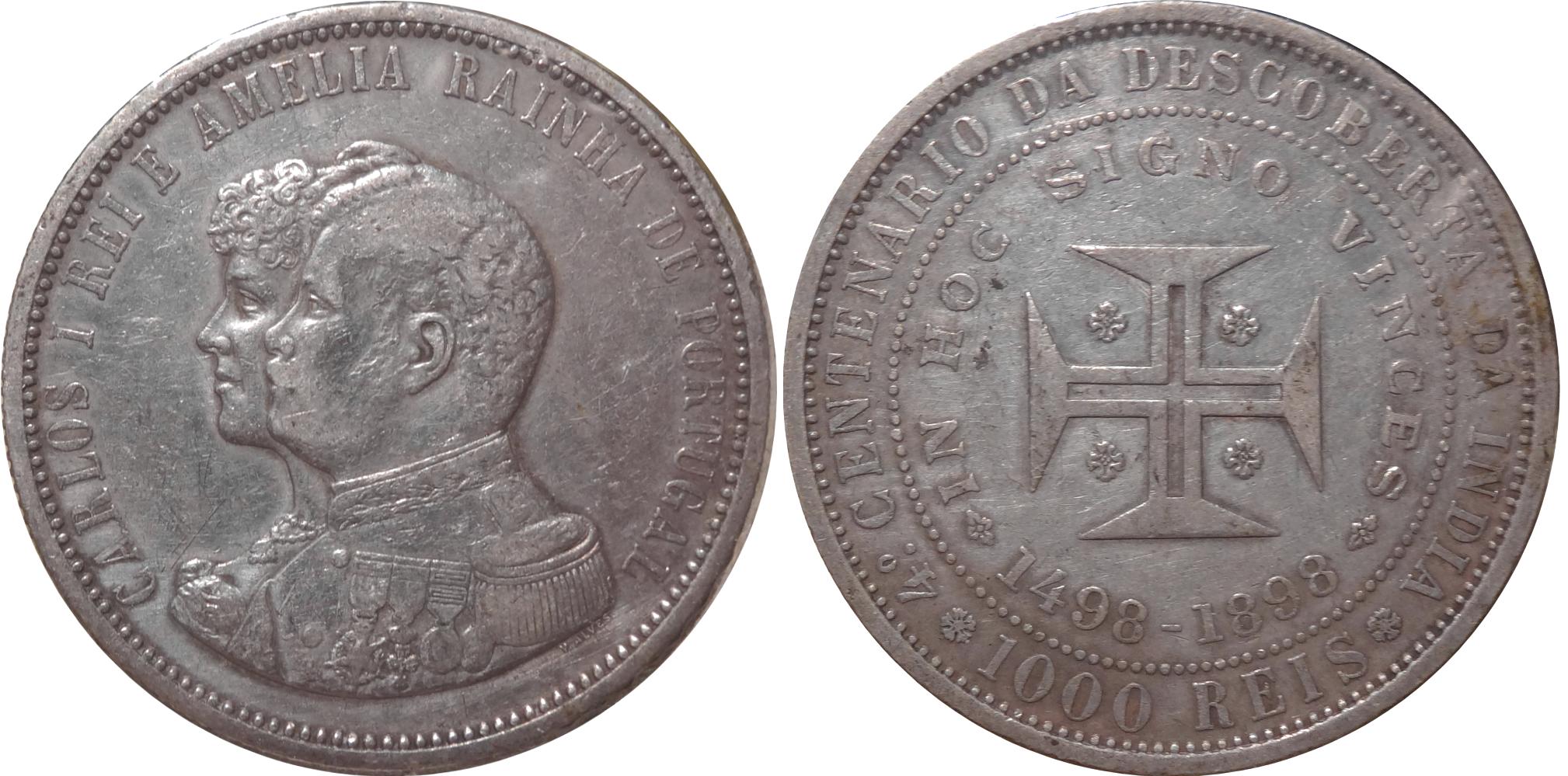
This is an one thousand reis coin minted in 1898 to celebrate the 400th anniversary of the discovery of India. The obverse has conjoined images of King Carlos I and Queen Amelia. The reverse has the coat-of-arms of Royalist Portugal. Weighs 25 grams of 0.917 fineness.
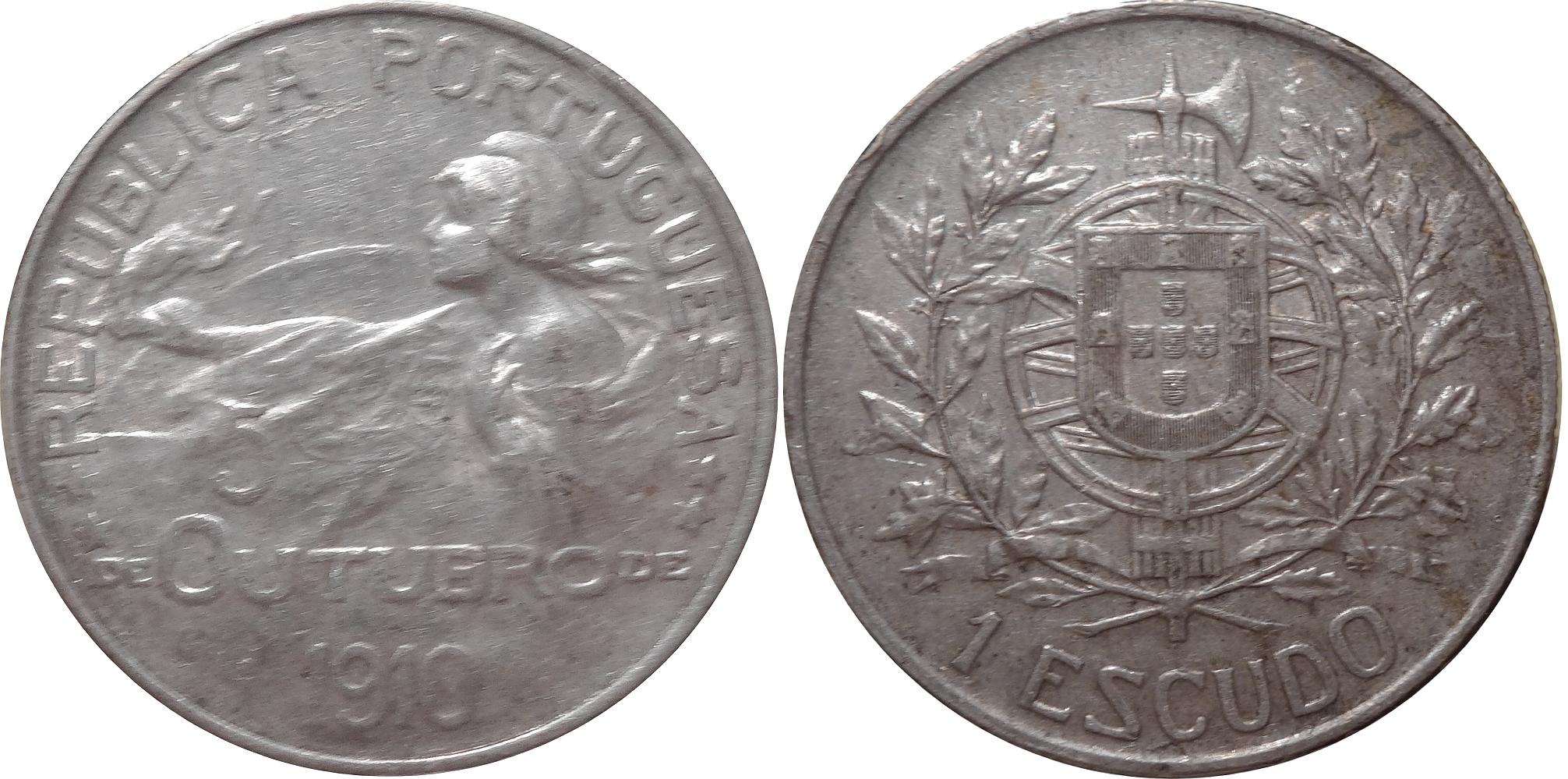
This one Escudo coin was issued by the Republic in 1910 to celebrate the establishment of the Republic on the 5 October 1910. The obverse has an image of Liberty holding a torch. The reverse has the Republic arms. Weighs 25 grams of 0.835 fineness.
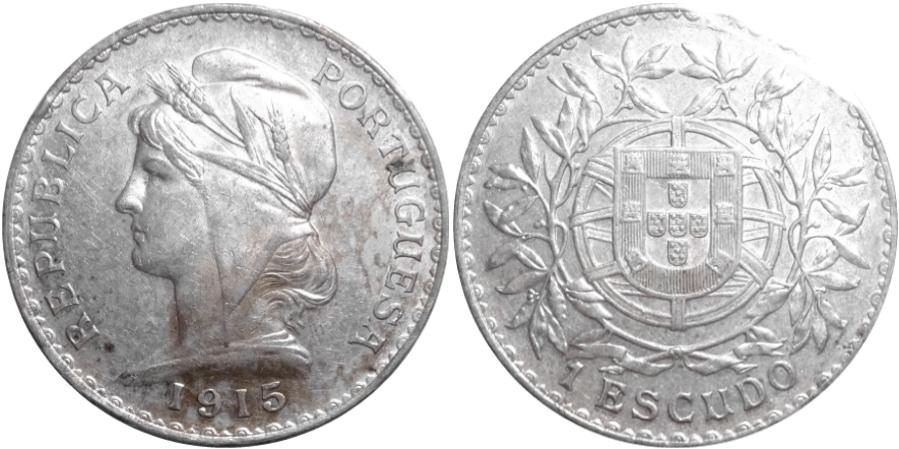
This one Escudo coin was issued in 1915. The obverse has Liberty with the country's name and date. The reverse has the nation's arms and the denomination. Weighs 25 grams of 0.835 fineness.
PRUSSIA
Elector Friedrich III of Brandenburg-Prussia (1688-1713) was accorded the title of 'King in Prussia" in 1701 as a reward for his support of Austria during the War of the Spanish Succession. Under successive strong leaders, Prussia gained increasing importance and added to its territories to become one of the leading countries of Europe in the course of the 18th century. As part of the reforms instituted by Friedrich III, the system of single letter mintmarks representing specific mints replaced the traditional incorporation of mint officials' symbols and/or initials as part of coin designs. Some of these very same mintmarks are still in use on modern German coins up to the present day. During the Napoleonic Wars (1792-1815), Prussia was allied with Saxony and they were soundly defeated at Jena in 1806. Prussia was forced to cede large portions of its territory at the time, but played a large part in the final defeat of Napoleon. The Congress of Vienna awarded Prussia part of Pomerania, the northern halt of Saxony, much of Westphalia and the Rhineland, thus making it the largest state in Germany and a major power in European affairs. After defeating Denmark in 1864 and Austria in 1866, Prussia acquired Schleswig-Holstein, Hannover, Hesse-Kassel, Nassau, and Frankfurt am Main. By this time, Prussia encompassed a large part of German territory and Its population included two-thirds of all the German people. By winning the Franco-Prussian War (1870-71), Prussia became the pivotal state in the unification of Germany in 1871. King Wilhelm I was proclaimed Kaiser (Emperor) of all Germany, but World War I brought an end to both the Empire and the Kingdom of Prussia In 1918.
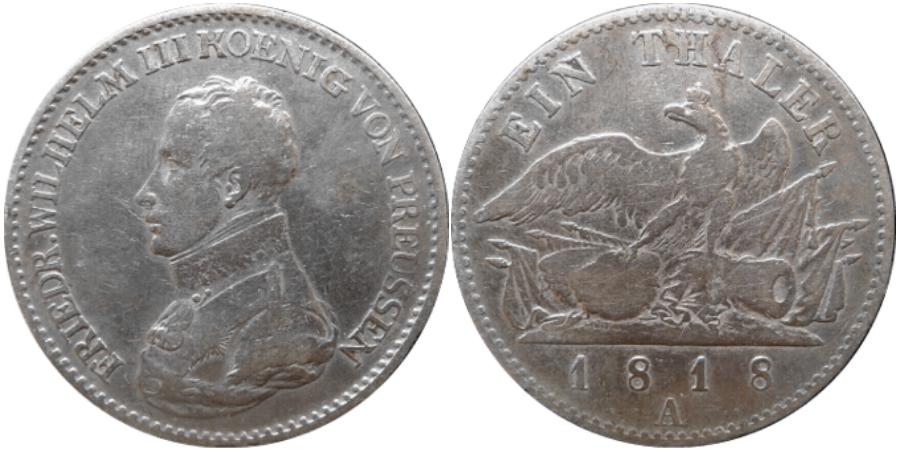
This is an one thaler coin minted in Berlin in 1818. The obverse has King Friedrich Wilhelm III with his title FRIEDR.WILHELM III KOENIG VON PREUSSEN. The reverse has a crowned eagle with flags and cannons and the denomination. Weighs 22.27 grams of 0.750 fineness.
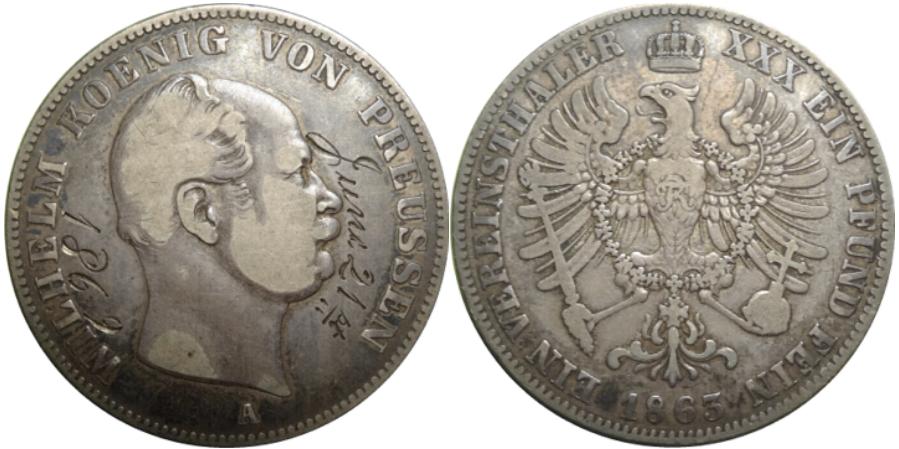
This is an one vereinsthaler coin minted in Berlin in 1863. The obverse has King Wilhelm. The reverse has the Prussian arms and the legend EIN VEREINSTHALER XXX EIN PFUND FEIN and the date. Someone engraved "June 21st 1862" on the obverse. Weighs 18.52 grams of 0.900 fineness.
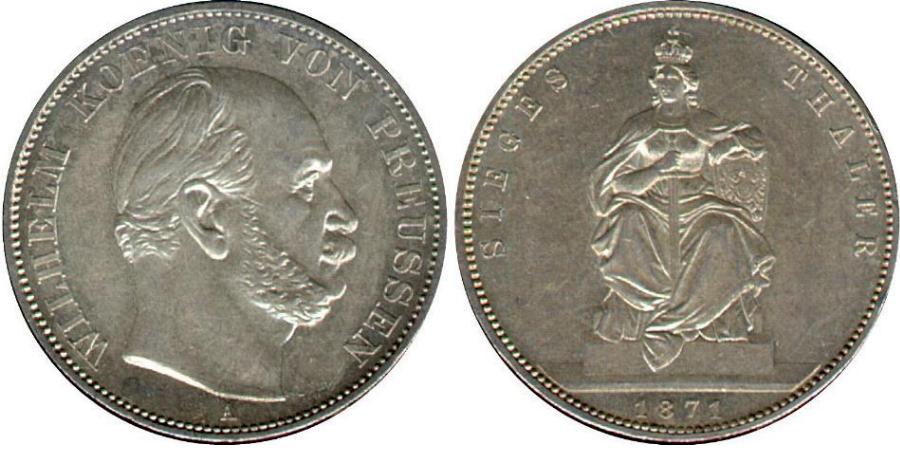
This is an one thaler coin of 1871 commemorating the defeat of France in the Franco-Prussian War. The obverse has King Wilhelm. The reverse has Germania. Weighs 18.52 grams of 0.900 fineness.
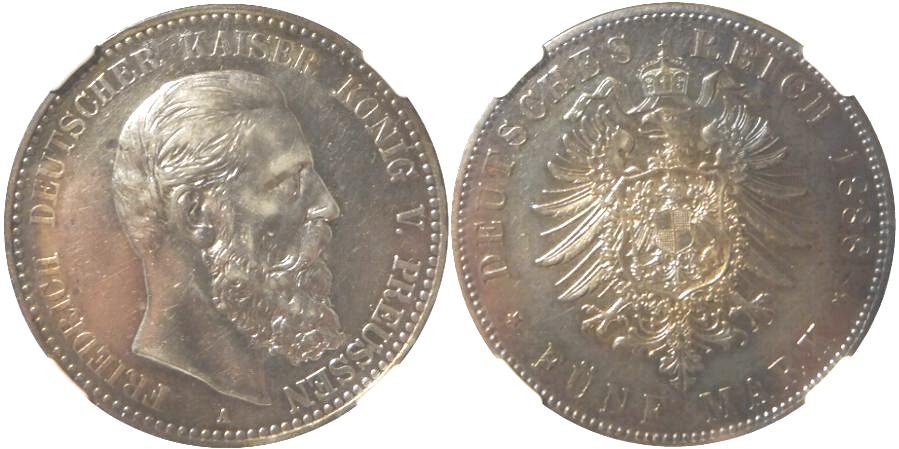
This five Mark coin was minted in Berlin (mintmark A) in 1888. The obverse has Friedrich German Kaiser and Prussian king. The reverse has the German coat-of-arms. Weighs 27.8 grams of 0.900 fineness.
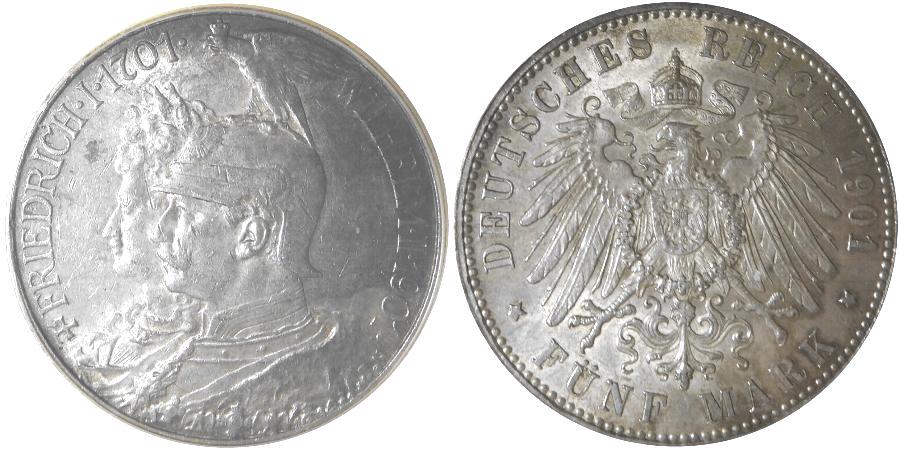
This five Mark coin was minted in Berlin (mintmark A) in 1901 to celebrate 200 years of the Kingdom of Prussia The obverse has the conjoined busts of Friedrich I and Wilhelm II. The reverse has the German coat-of-arms. Weighs 27.8 grams of 0.900 fineness.
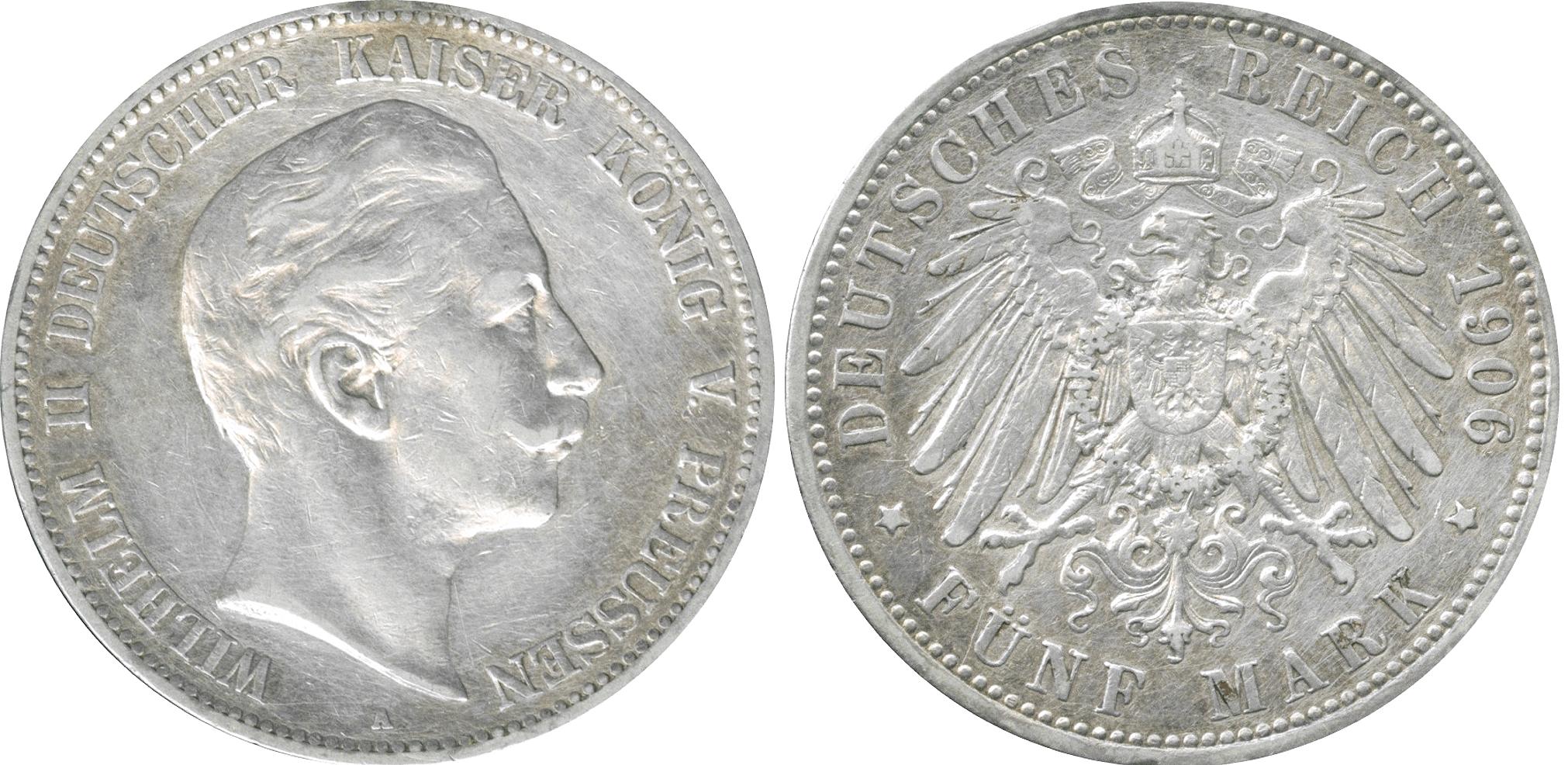
This five Mark coin was minted in Berlin (mintmark A) in 1906. The obverse has Wilhelm II, German Kaiser and Prussian king. The reverse has the German coat-of-arms. Weighs 27.8 grams of 0.900 fineness.
PUERTO RICO
Columbus discovered Puerto Rico (Rich Port) and took possession for Spain on 19 November 1493 - the only time Columbus set foot on the soil of what is now a possession of the United States. The first settlement, Caparra, was established by Ponce de Leon in 1508. The early years of the colony were not promising. Considerable gold was found, but the supply was soon exhausted. Efforts to enslave the Indians caused violent reprisals. Hurricanes destroyed crops and homes. French, Dutch, and English freebooters burned the towns. Puerto Rico remained a Spanish possession until 1898, when it was ceded to the United States following the Spanish-American War.
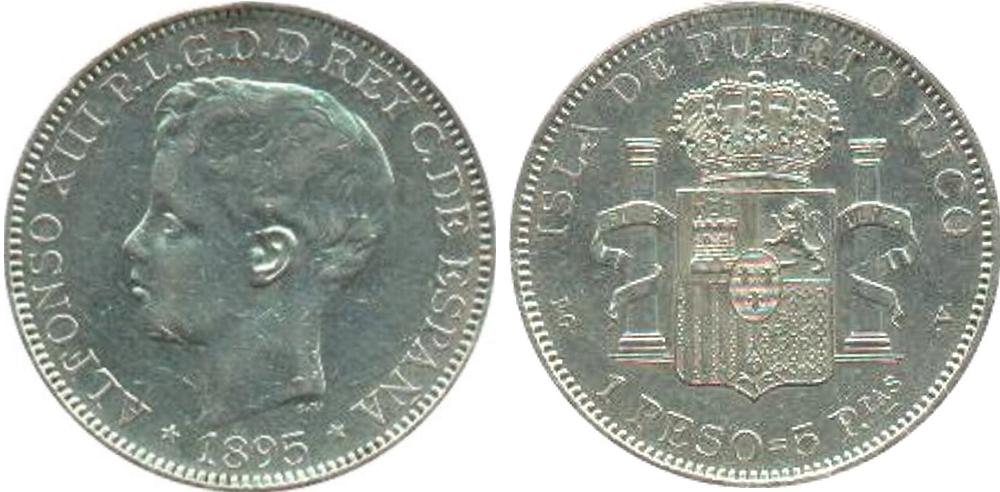
This is the only crown size coin struck by Spain for its colony of Puerto Rico. It is a one Peso/five Pesetas piece dated 1895. The reverse has the youth bust of King Alfonso XIII. The reverse has the Spanish arms. Weighs 25 grams of 0.900 fineness
ROMANIA
Romania is a country in southeast Europe. Modern Romania was formed in 1859 through a personal union of the Danubian Principalities of Moldavia and Wallachia. It gained independence from the Ottoman Empire in 1877. A new constitution was adopted in 1923. In November 1940, Romania signed the Tripartite Pact and, consequently, in June 1941 entered World War II on the Axis side, fighting against the Soviet Union until August 1944, when it joined the Allies. During this period In history, the Romanian government struggled with domestic problems, agrarian reform and economic reconstruction. On August 23, 1944, King Mihai I proclaimed an armistice with the Allied Forces. The Romanian army drove out the Germans and Hungarians in northern Transylvania, but the country was subsequently occupied by the Soviet army. That monarchy was abolished on 30 December 1947 and Romania became a "Peoples Republic" based on the Soviet regime. The anti-Communist combative resistance movement developed frequent purges of dissidents: mainly political but also clerical, cultural, and peasants. Romanian elite disappeared into the concentration camps. The anti-Communist combative resistance movement developed in spite of the Soviet army presence until 1956. The partisans remained in the mountains until 1964. With the accession of N. Ceausescu to power, Romania began to exercise a considerable degree of independence, refusing to participate in the invasion of Czechoslovakia (August 1968). In 1965, It was proclaimed a "Socialist Republic." After 1977, an oppressed and impoverished domestic scene worsened. On 17 December 1989, an anti-Communist revolt started in Timișoara. On 22 December 1989 the Communist government was overthrown. Ceausescu and his wife were arrested and later executed. The new government established a republic, the constitutional name being Romania.
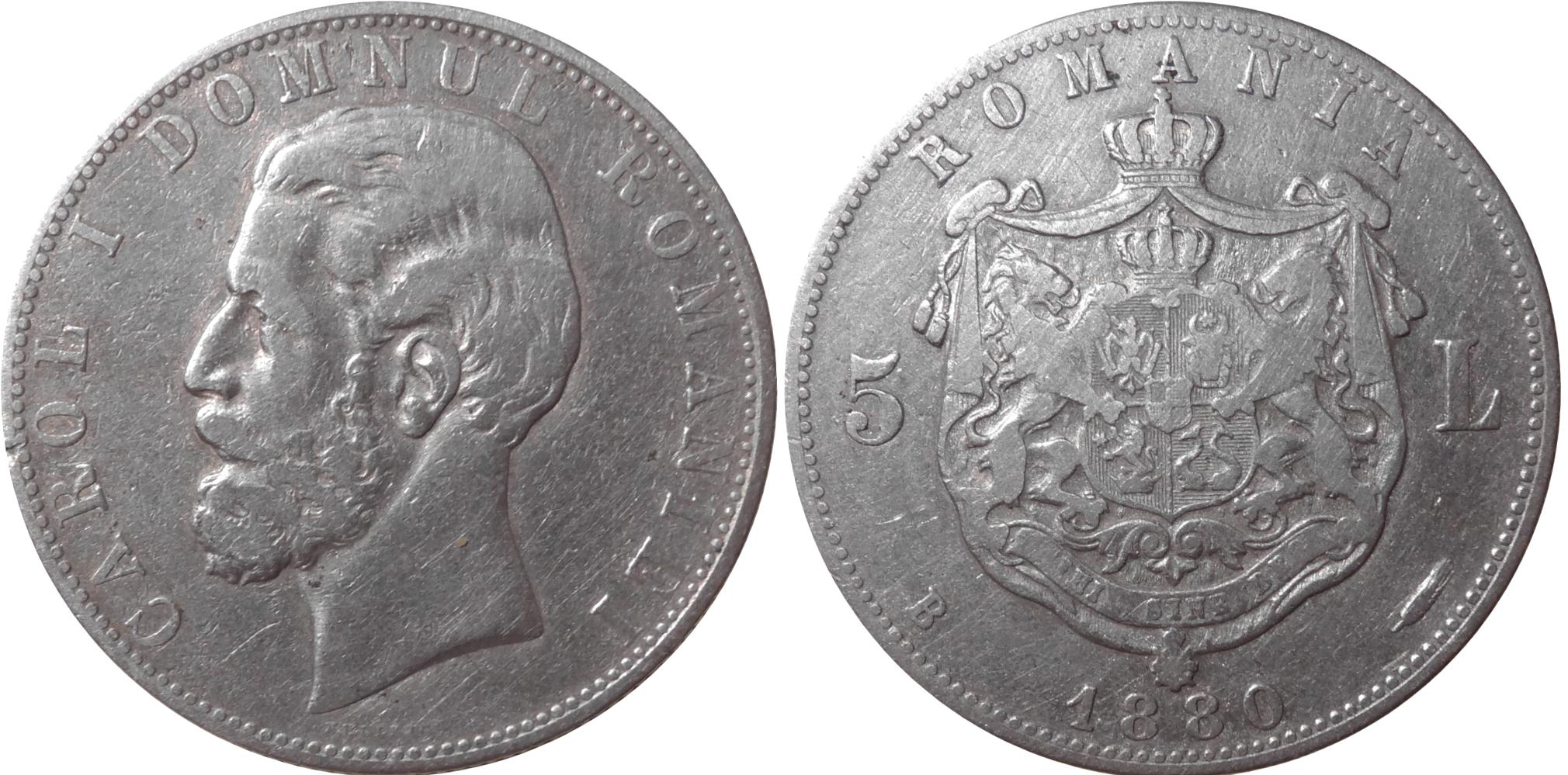
This five Lei was minted in Bucharest in 1880. The obverse has Lord Carol I. The reverse has the coat-of-arms. Weighs 25 grams of 0.900 fineness
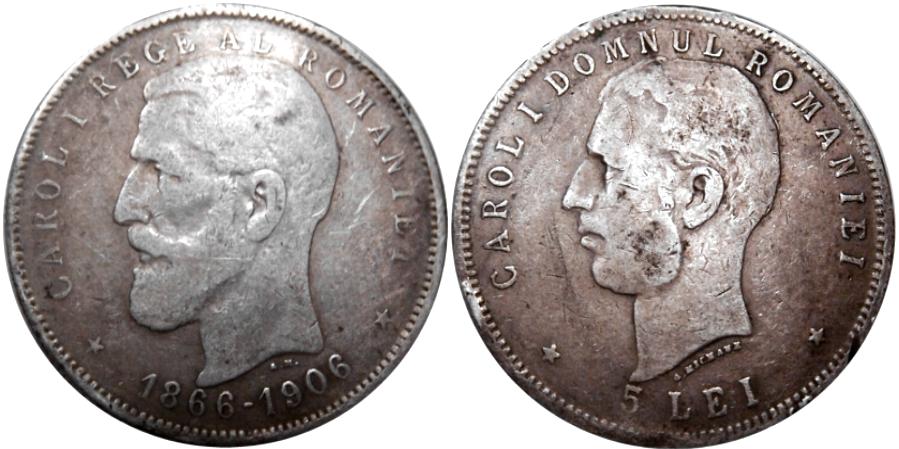
This five Lei was minted in Bucharest in 1906 to commemorate the 40th anniversary of the kingdom. The obverse has King Carol I. The reverse has a young Carol I as Lord of Romania. Weighs 25 grams of 0.900 fineness
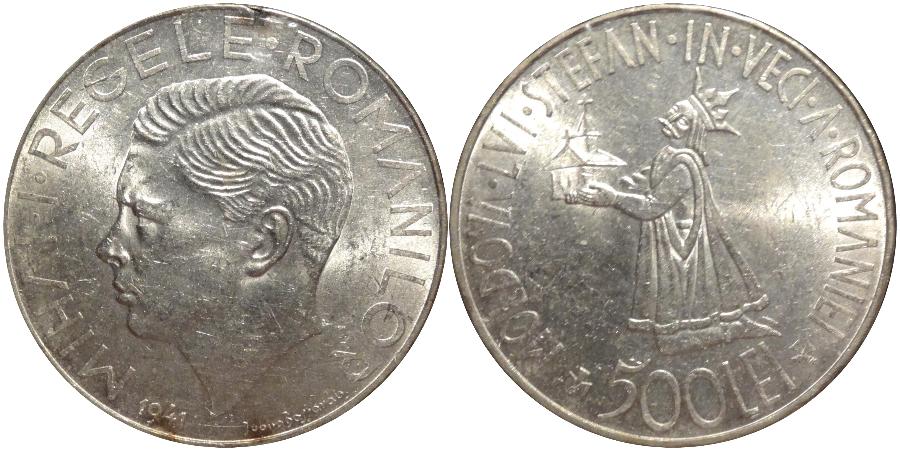
This 500 Lei was minted in Bucharest in 1941 to commemorate the Reunion with Bessarabia . The obverse has King Michael I. The reverse has Stephen III of Moldavia, known as Stephen the Great who was voivode (or prince) of Moldavia from 1457 to 1504, kneeling presenting Putna Monastery to the Lord with the legend MOLDOVA·LVI·STEFAN·IN·VECI·A·ROMANIEI. Weighs 25 grams of 0.835 fineness.
RUSSIA
The first Russian dynasty was founded in Novgorod by the Viking Rufik in 862 AD. The subsequent Kievan state became one of the great commercial and cultural centers of Europe before falling to the Mongols of the Batu Khan, 13th century, who were suzerains of Russia until late in the 15th century when Ivan III threw off the Mongol yoke. The Russian Empire was enlarged, solidified and westernized during the reigns of Ivan the Terrible, Peter the Great, and Catherine the Great, and by 1881 extended to the Pacific and into Central Asia. Contemporary Russian history began in March of 1917 when Tsar Nicholas II abdicated under pressure and was replaced by a provisional government composed of both radical and conservative elements. This government rapidly lost ground to the Bolshevik wing of the Socialist Democratic Labor Party which attained power following the Bolshevik Revolution which began on 7 Nov. 1917. After the Russian Civil War, the regional governments, national states and armies became federal republics of the Russian Socialist Federal Soviet Republic. These autonomous republics united to form the Union of Soviet Socialist Republics that was established as a federation under the premiership of Lenin on 30 Dec. 1922. In the Fall of 1991, events moved swiftly in the Soviet Union. Estonia, Latvia, and Lithuania won their independence and were recognized by Moscow, 6 Sept. The Commonwealth of Independent States was formed 8 Dec. 1991 in Minsk by Belarus, Russia, and Ukraine. It was expanded at a summit 21 Dec. 1991 to include 11 of the 12 remaining republics (excluding Georgia) of the old U.S.S.R.
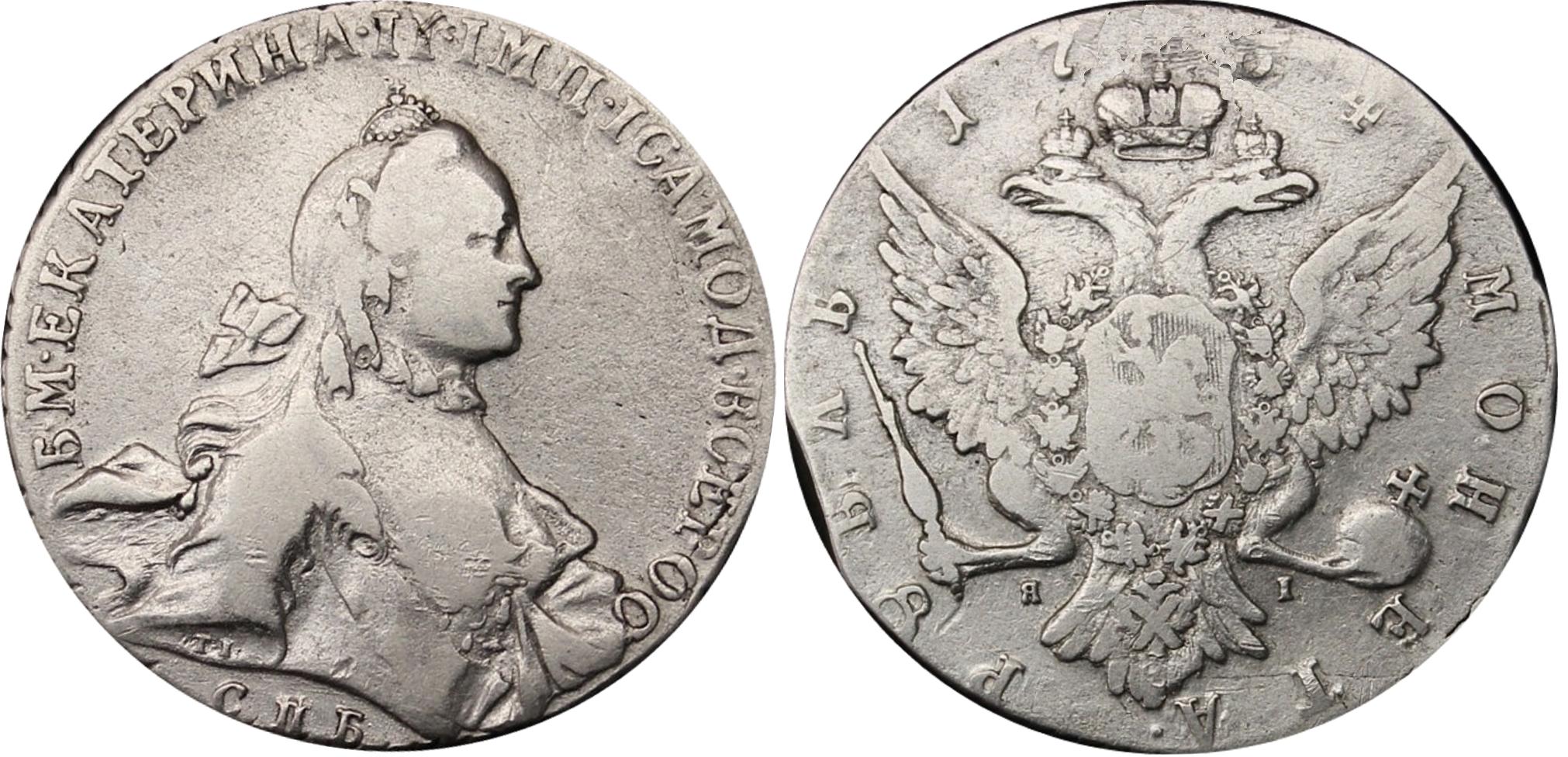
This is an one Ruble coin minted in St. Petersburg (mintmark СПБ) in 1764. The obverse has Empress Catherine II. The legend reads Б М ЕКАTЕРИНА II IМП IСАМОД ВСЕРОC (Catherine II Empress of all Russias). The reverse has the coat of arms, МОНЕТА РУБЛЬ (Ruble Money), the mintmaster's inirials ЯI (Yakov Ivanov) and the date 1764. Weighs 24 grams of 0.750 fineness
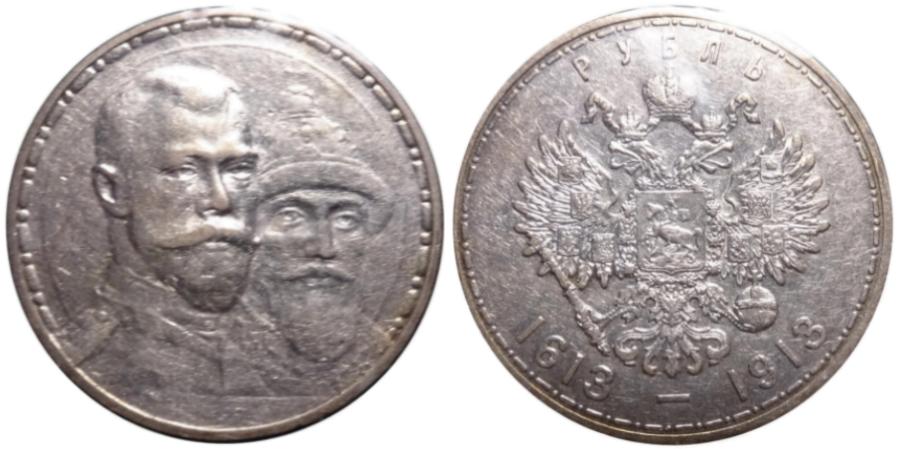
This is an one Ruble coin minted in St. Petersburg in 1913 to commemorate the 300th anniversary of the Romanov Dynasty. The obverse has Emperors Nicholas II and Michael I. The reverse has the coat of arms, РУБЛЬ, and the dates 1613-1913. Weighs 20 grams of 0.900 fineness
SAXONY
From about the time of Charlemagne, the term Saxony covered most of what is the northwestern part of modern day Germany. It roughly covered the area between the River Ems, the North Sea, the Eider and Elbe Rivers, extending to the southern slopes of the Harz Mountains, bordering Franconia, but not as far as the Rhine. The early Saxon tribes were pagans who, upon conquest by the Franks, became the nucleus of a buffer state between that empire and the heathen Slav peoples to the east.
The first Margrave of Saxony was Ludolf, named in
850 to defend the frontier, and recognized as founder of the Liudolfinger dynasty.
His grandson acquired Thuringia in 908 and was raised to the rank of
duke in 911. The dynasty furnished the Saxon line of German kings and emperors beginning
with Heinrich I the Fowler in 919 and up to Heinrich II, who died in 1024. A relative
of the dynasty was delegated to rule Saxony and founded the Billung dynasty of dukes
in 961. In 1260, Saxony was divided into Saxe-Lauenburg (Northern or Lower Saxony) and Saxe-Wittenberg, also known as Upper Saxony, the southern part of
the territory ruled by the Billungers.
This is a one Thaler piece dated 1592. The obverse has the three brothers Christian II, Johann Georg I, and August. The mintmark HB is at the reverse top. The reverse has the coat-of-arms. Weighs 29 grams of 0.???5 fineness

This is a five Mark coin minted in 1876 . The obverse features King Albert. Reverse has German arms. Weighs 27.8 grams of 0.900 fineness.
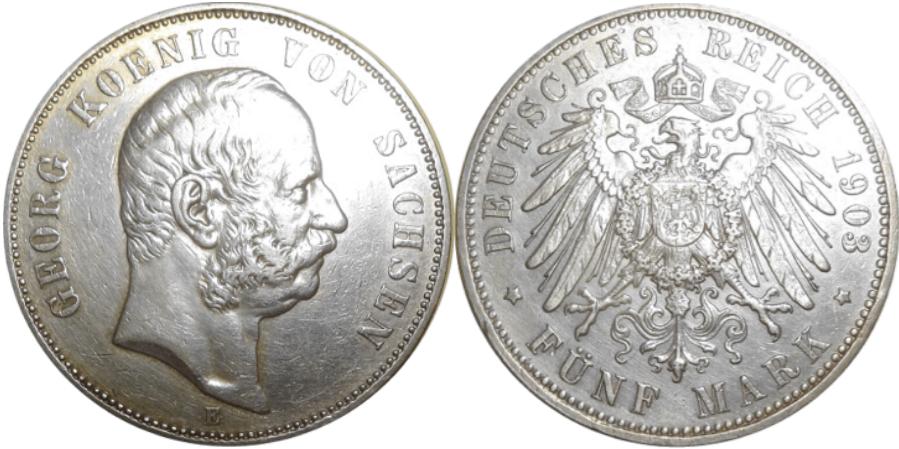
This is a five Mark coin minted in 1903 . The obverse features King George Reverse has German arms. Weighs 27.8 grams of 0.900 fineness.
SCHLESWIG-HOLSTEIN
Christian I, son of Count Dietrich of Oldenburg (1423-40), was elected King of Denmark in 1448. By virtue of his marriage to Hedwig, the last surviving heir of the countship of Holstein-Rendsburg, Christian I became Duke of Schleswig and Count of Holstein in 1459. His status over Holstein was raised to that of duke in 1474 and from that year onwards, the dual duchies of Schleswig-Holstein were ruled by the Danish royal house. In 1533, a separate line for one of Friedrich I’s sons was established in Gottorp. Similarly, a son of Christian III was given Sonderburg as his domain in 1559. The Danish kings continued to have coins struck for their remaining portions of Schleswig-Holstein during the next several centuries. Upon the dissolution of the Holy Roman Empire by Napoleon in 1806, Holstein was made a part of Denmark. However, Holstein, without Schleswig, joined the German Confederation following the final defeat of Napoleon in 1815. After Denmark tried to annex Schleswig and Holstein in 1846, she fought a war with Prussia for three years over control of the duchies, but it was inconclusive. In 1863, Denmark declared that Schleswig was part of that country although it had a German majority in the population. A second war was fought between Denmark against Prussia and Austria and Schleswig-Holstein was occupied by the victorious Prussians. The administration of Holstein was given to Austria, while that of Schleswig was obtained by Prussia in 1865. However, Austria was forced to give up Holstein after losing a war with Prussia in 1866. Schleswig-Holstein were controlled by Prussia and became part of the German Empire in 1871. Following World War I, a plebiscite was held in Schleswig and the northern part, with its majority Danish population, was ceded to Denmark in 1920.
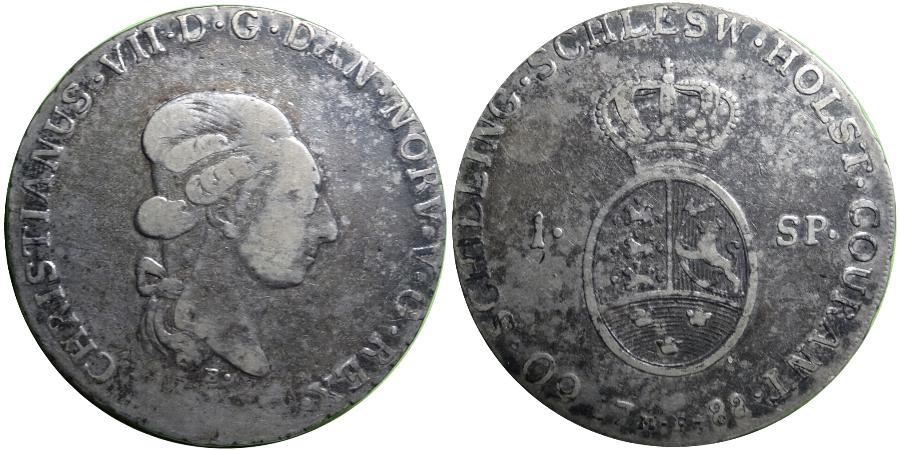
This is a one speciedaler/60 schilling coin minted in 1788. The obverse
has Christian VII with the legend
CHRISTIANUS · VII · D · G · DAN · NORV · V · G · REX. The reverse has the crowned
arms, the legend 60 · SCHILLING · SCHLESW · HOLST · COURANT ·1· SP·, and the date
1788. Weighs 28.893 grams of 0.875 fineness.
SERBIA
Serbia emerged as a separate kingdom in the 12th century and attained its greatest expansion and political influence in the mid-14th century. After the Battle of Kosovo, 1389, Serbia became a vassal principality of Turkey and remained under Turkish suzeranity until it was re-established as an independent kingdom by the 1887 Treaty of Berlin. Following World War I, which had its immediate cause in the assassination of Austrian Archduke Francis Ferdinand by a Serbian nationalist, Serbia joined with the Croats and Slovenes to form the new Kingdom of the South Slavs with Peter I of Serbia as king. The name of the kingdom was later changed to Yugoslavia. Invaded by Germany during World War II, Serbia emerged as a constituent republic of the Socialist Federal Republic of Yugoslavia.
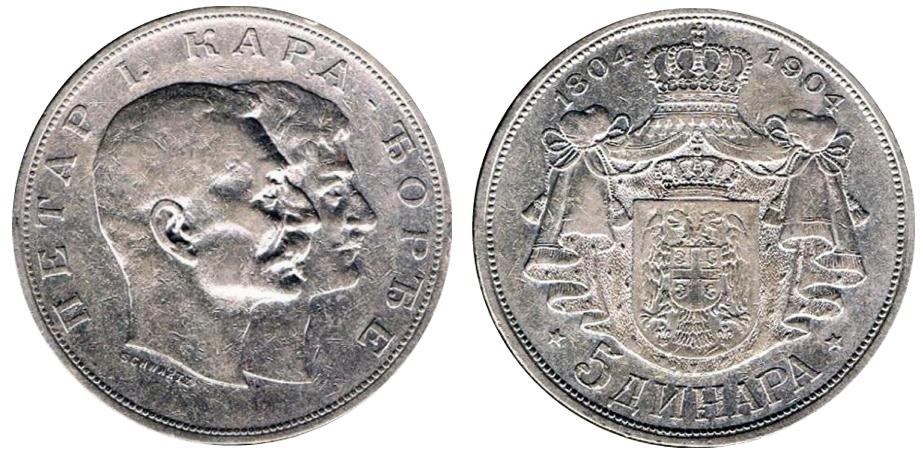
This is a 5 Dinara piece minted in 1904. The obverse has conjoined busts of Peter I and Karageorge to celebrate 100 years of the dynasty. Weighs 25 grams of 0.835 fineness
SEYCHELLES
The Republic of Seychelles, an archipelago of 85 granite and coral islands situated in the Indian Ocean 600 miles (96km.) northeast of Madagascar. Among these islands are the Aldabra Islands, the Farquhar Group, and Ile Desroches, which the United Kingdom ceded to the Seychelles upon its independence. Although the Seychelles is marked on Portuguese charts of the early 16th century, the first recorded visit to the islands, by an English ship, occurred in 1609. The Seychelles were annexed to France by Captain Lazare Picault in 1743 and permanently settled in 1768, with the intention of establishing spice plantations to compete with the Dutch monopoly of the spice trade. British troops seized the islands in 1810, during the Napoleonic Wars; the Treaty of Paris, 1814, formally ceded them to Britain. The Seychelles was a dependency of Mauritius until 31 Aug 1903, when they became a separate British Crown Colony. The colony was granted limited internal self-government in 1970, and attained independence on 28 June 1976, becoming Britain’s last African possession to do so. Seychelles is a member of the Commonwealth of Nations. The president is the Head of State and of Government.
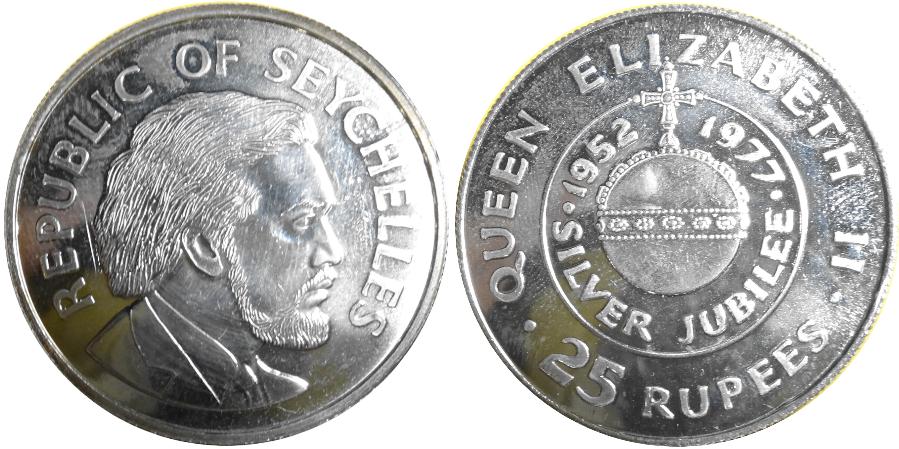
This is a 25 Rupees piece minted in 1977 to celebrate the silver anniversary of Queen Elizabeth II. The obverse has the president James Manchen. Weighs 28.28 grams of 0.925 fineness
SOUTH AFRICAN REPUBLIC (BOER)
Portuguese navigator Bartholomew Diaz became the first European to sight the region of South Africa when he rounded the Cape of Good Hope in 1488, but throughout the 16th century the only white men to come ashore were the survivors of ships wrecked while attempting the stormy Cape passage. Jan van Riebeeck of the Dutch East India Company established the first permanent settlement in 1652. In subsequent decades additional Dutch, German, and Huguenot refugees from France settled in the Cape area to form the Afrikaner segment of today's population.
Great Britain captured the Cape colony in 1795, and again in 1806, receiving permanent title in 1814. To escape British political rule and cultural dominance, many Afrikaner farmers (Boers) migrated northward (the Great Trek) beginning in 1836, and established the independent Boer Republics of the Transvaal (the South African Republic, Zuid Afrikaansche Republic) in 1852, and the Orange Free State in 1854. British political intrigues against the two republics, coupled with the discovery of diamonds and gold in the Boer-settled regions, led to the bitter Boer Wars (1880-81, 1899-1902) and the incorporation of the Boer republics into the British Empire. On 31 May 1910, the two former Boer Republics (Transvaal and Orange Free State) were joined with the British colonies of Cape of Good Hope and Natal to form the Union of South Africa, a dominion of the British Empire. In 1934 the Union achieved status as a sovereign state within the British Empire.
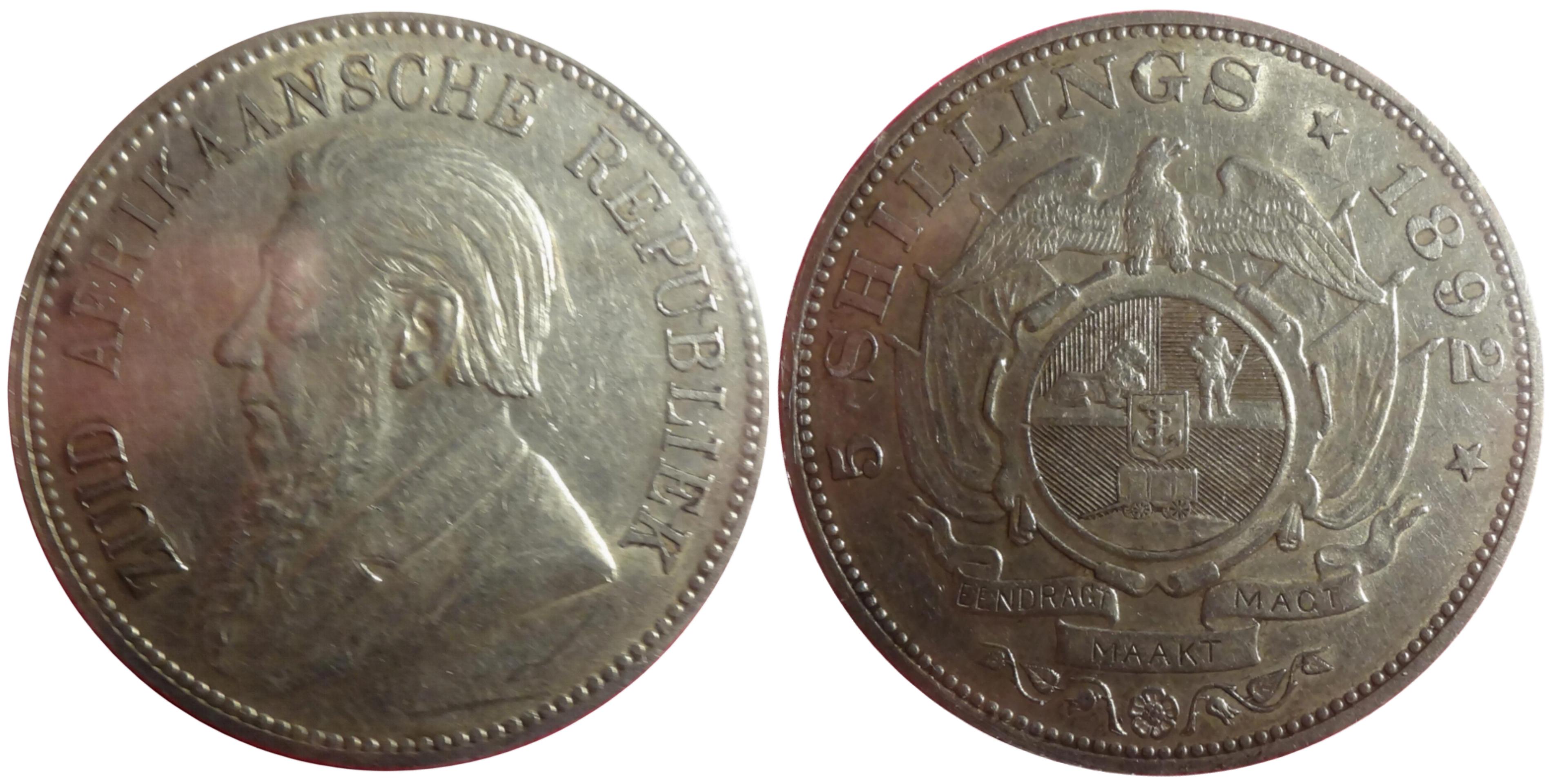
This is a 5 shilling coin single shaft type minted in Berlin in 1892. There are two versions. The first erroneously pictured a Boer wagon on the coat-of-arms with a single shaft. The second issue pictures the correct double shaft. Weighs 28 grams of 0.925 fineness
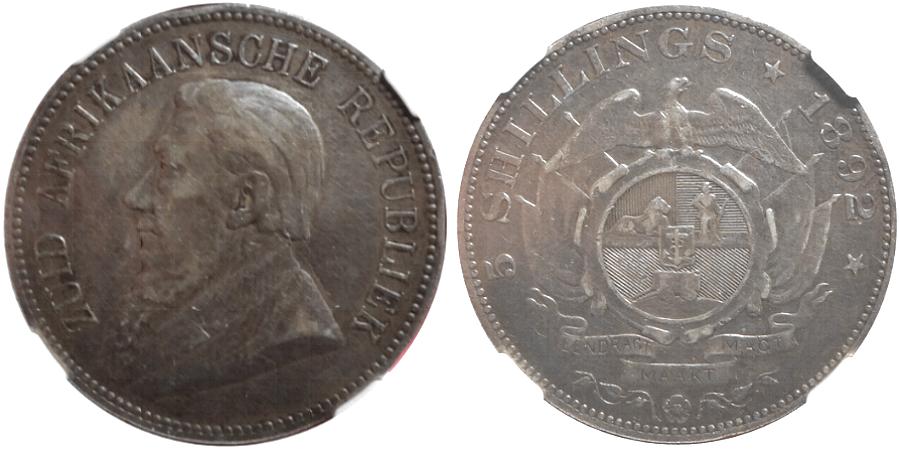
This is a 5 shilling coin dual shaft type minted in Berlin in 1892. There are two versions. The first erroneously pictured a Boer wagon on the coat-of-arms with a single shaft. The second issue pictures the correct double shaft. Weighs 28 grams of 0.925 fineness
UNION OF SOUTH AFRICA
On 31 May 1910, the two former Boer Republics (Transvaal and Orange Free State) were forcibly joined with the British colonies of Cape of Good Hope and Natal to form the Union of South Africa, a dominion of the British Empire. In 1934 the Union achieved status as a sovereign state within the British Empire. A republic was initiated in May 1961 and it withdrew from the Commonwealth. In 1994 the old orderly republic was abolished and a new order was installed. The republic has declined perceptibly since. The Rand has depreciated from US$1.40 to US$0.07, a reflection on the mismanagement.
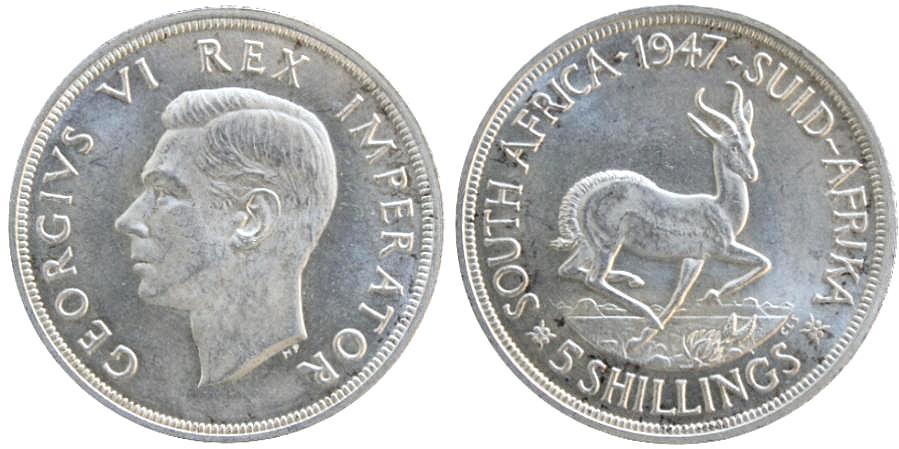
This is a 5 shilling coin issued in 1947 to commemorate the royal visit. The obverse has King George VI. The reverse has a springbok. Weighs 28.28 grams of 0.800 fineness
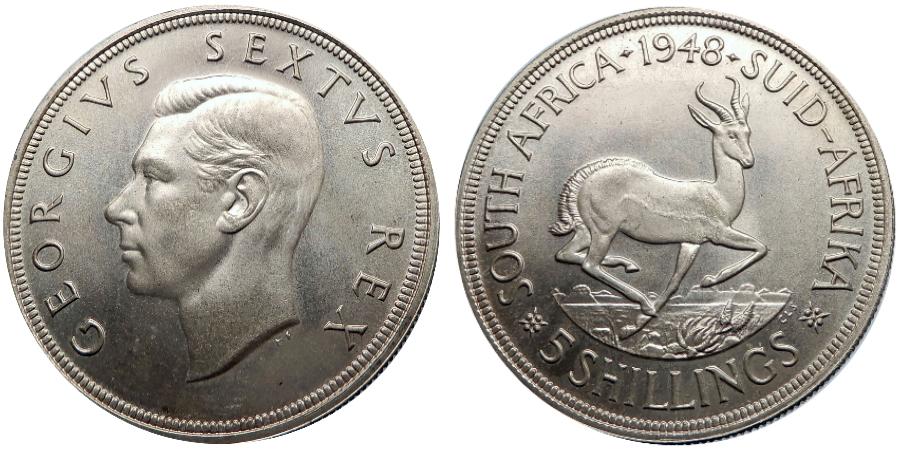
This is a 5 shilling coin issued in 1948. The obverse has King George VI. The reverse has a springbok. Weighs 28.28 grams of 0.800 fineness
SOUTHERN RHODESIA
Colonization of Rhodesia began in 1890 when settlers forcibly acquired Shona lands and then Ndebele lands in 1893. It was named as Rhodesia, after Cecil Rhodes who led the buildup of the Colony. Rhodesia became a self-governing colony under the name of Southern Rhodesia in 1923. Consequent upon later political difficulties and disagreement with the British authorities over common emancipation of the people, a unilateral declaration of Independence (UDI) was declared on 11 November 1965. Following United Nations sanctions against the country, various renamings as Rhodesia and Rhodesia-Zimbabwe, and elections in February 1980, the country became independent on 18 April 1980, as the Republic of Zimbabwe as a member of the Commonwealth of Nations. The country has become a basket case under the presidency of Robert Mugabe who violated the protections afforded the white farmers upon independence. As could be expected the agricultural economy perished and the breadbasket of Africa became a devastated country.
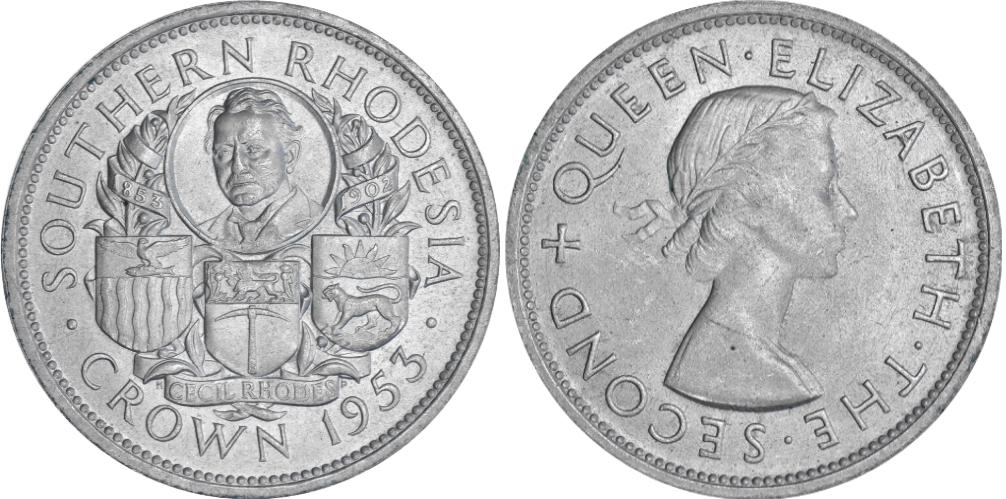
This is a five Shillings coin minted in 1953 to celebrate the 100th anniversary of the birth of Cecil Rhodes. Weighs 28 grams of 0.500 fineness
SOVEREIGN MILITARY ORDER OF MALTA
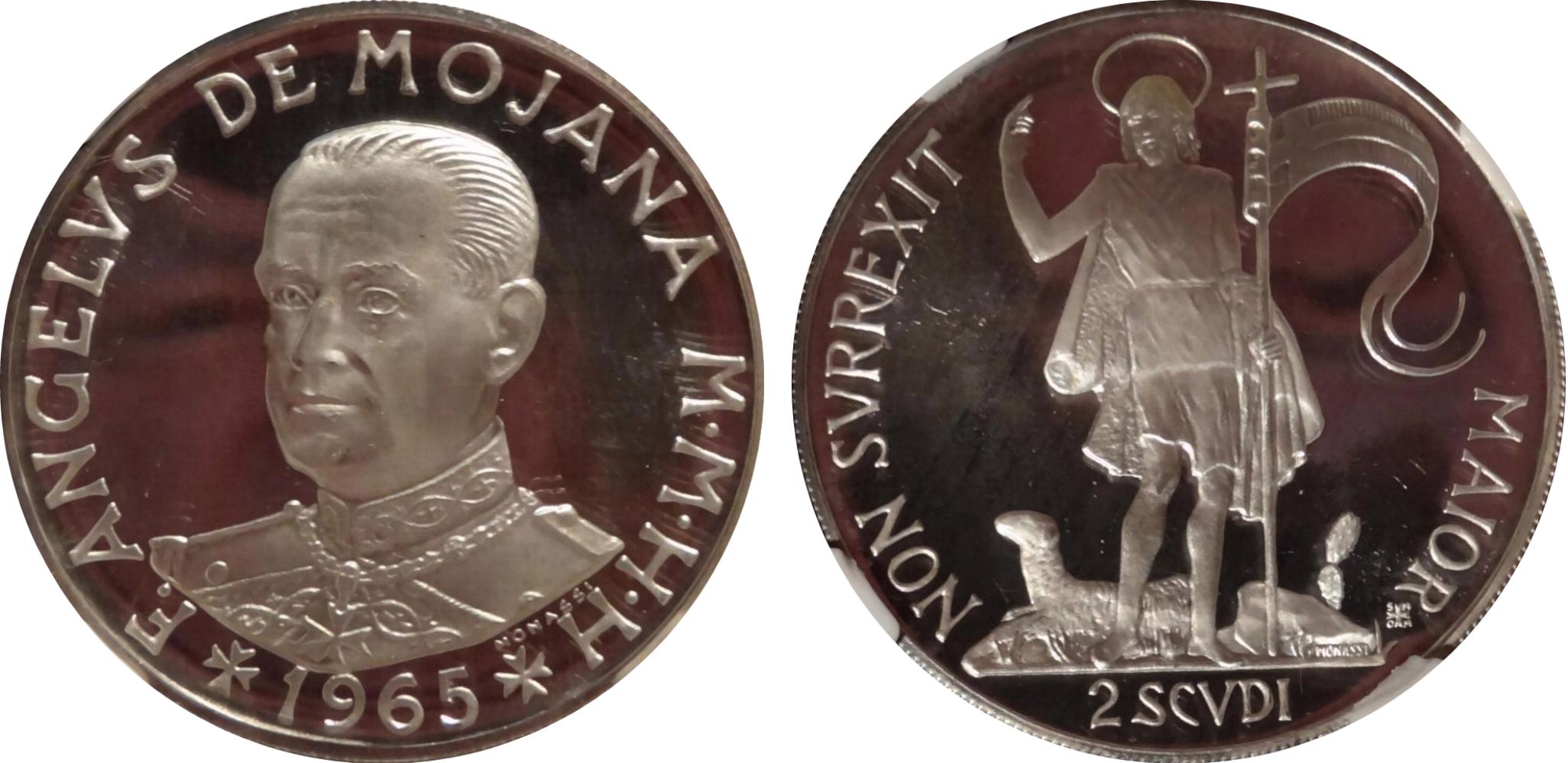
This is a two Scudi piece minted in 1965. Weighs 24 grams of 0.986 fineness
SPAIN
The Spanish State forms the greater part of the Iberian Peninsula of southwest Europe and includes the Balearic and the Canary Islands. It isn't known when man first came to the Iberian Peninsula - the Altamira caves off the Cantabrian coast approximately 50 miles west of Santander were fashioned in Paleolithic times. Spain was a battleground for centuries before it became a united nation, fought for by Phoenicians, Carthaginians, Greeks, Celts, Romans, Vandals, Visigoths, and Moors. Ferdinand and Isabella destroyed the last Moorish stronghold in 1492, freeing the national energy and resources for the era of discovery and colonization that would make Spain the most powerful country in Europe during the 16th century. Alter the destruction of the Spanish Armada, 1588, Spain never again played a major role In European politics. Forcing Ferdinand to give up his throne and placing him under military guard at Valencia in 1808, Napoleonic France ruled Spain until 1814. When the monarchy was restored in 1814 it continued, only interrupted by the short-lived republic of 1873-74, until the exile of Alfonso XIII In 1931 when the Second Republic was established.
Discontent against the mother country increased after 1808 as colonists faced new imperialist policies from Napoleon or Spanish liberals. The revolutionary movement was established which resulted in the eventual independence of the Vice-royalties of New Spain, New Granada, and Rio de la Plata within 2 decades. The doomed republic was trapped in a tug-of-war between the right and left wing forces inevitably resulting in the Spanish Civil War of 1936-38. The leftist Republicans were supported by the U.S.S.R. and the International Brigade, which consisted of mainly communist volunteers from all over the western world. The right wing Nationalists were supported by the Fascist governments of Italy and Germany. Under the leadership of Gen. Francisco Franco, the Nationalists emerged victorious and immediately embarked on a program of reconstruction and neutrality as dictated by the new "Caudillo" (leader) Franco.
The monarchy was reconstituted in 1947 under the regency of General Francisco Franco; the king designate to be crowned after Franco's death. Franco died on Nov. 20, 1975. Two days alter his passing, Juan Carlos de Borbon, the grandson of Alfonso XIII, was proclaimed King of Spain.
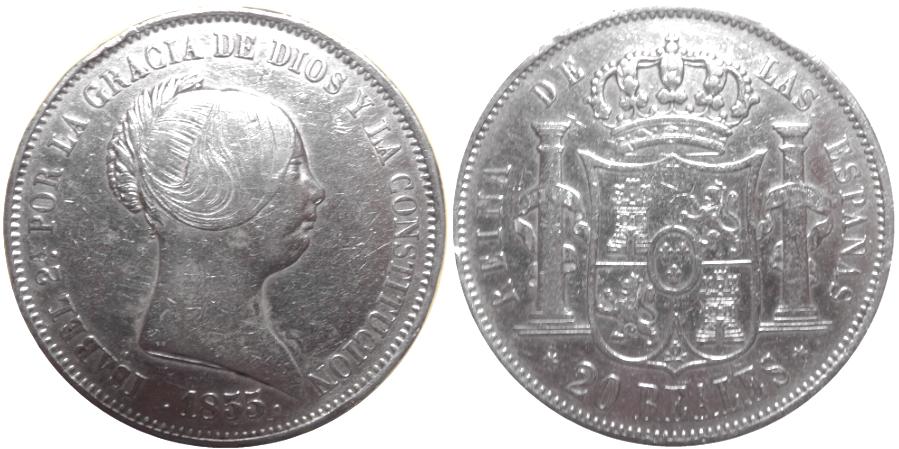
This is a 20 reales coin minted in 1855 in Madrid. The obverse has Queen Isabel II with the legend ISABEL 2ª POR LA GRACIA DE DIOS Y LA CONSTITUCION. The reverse has the Spanish arms. Weighs 26.29 grams of 0.900 fineness
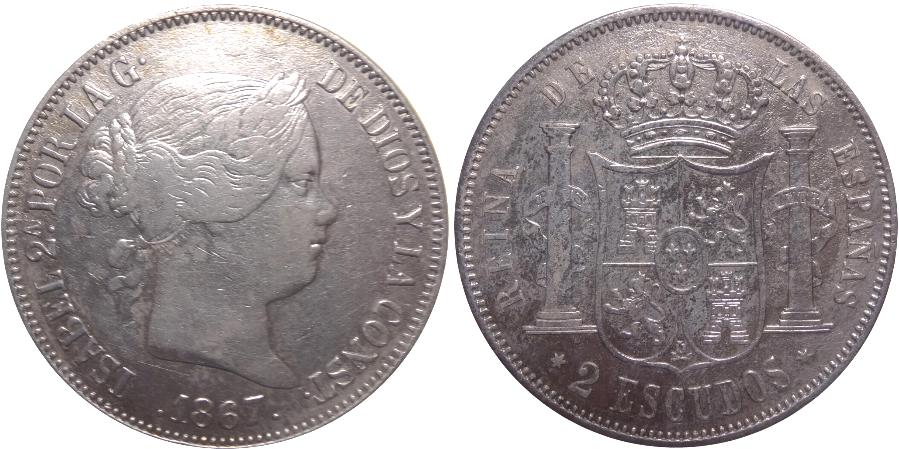
This is a two escudos coin minted in 1867. The obverse has Queen Isabel II. The reverse has the Spanish arms. Weighs 25.96 grams of 0.900 fineness
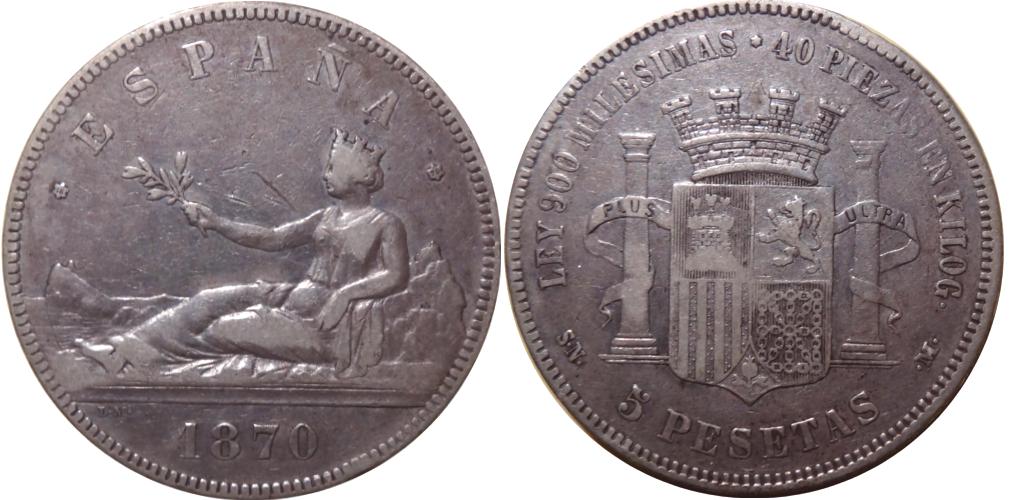
This is a five Peseta coin minted in 1870 by the Provisional Government. Weighs 25 grams of 0.900 fineness
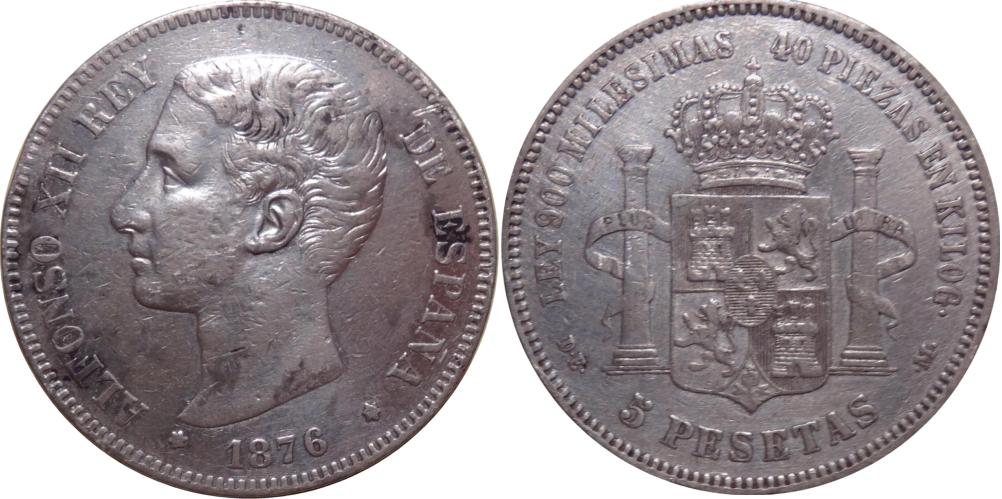
This is a five Peseta piece minted in 1879 picturing King Alfonso XII. Weighs 25 grams of 0.900 fineness
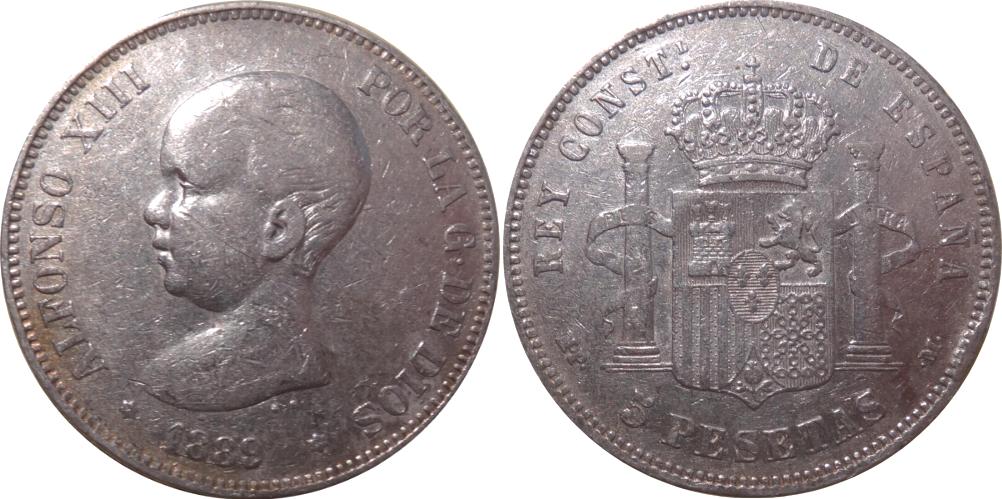
This is a five Pesetas piece minted in 1889 picturing King Alfonso XIII as a baby. Later versions were minted with a toddler's head and a youth's head. He ascended the throne upon his birth as his father had died in late 1885. Until his 16th birthday in 1902, his mother, Maria Christina of Austria, served as his regent, Weighs 25 grams of 0.900 fineness
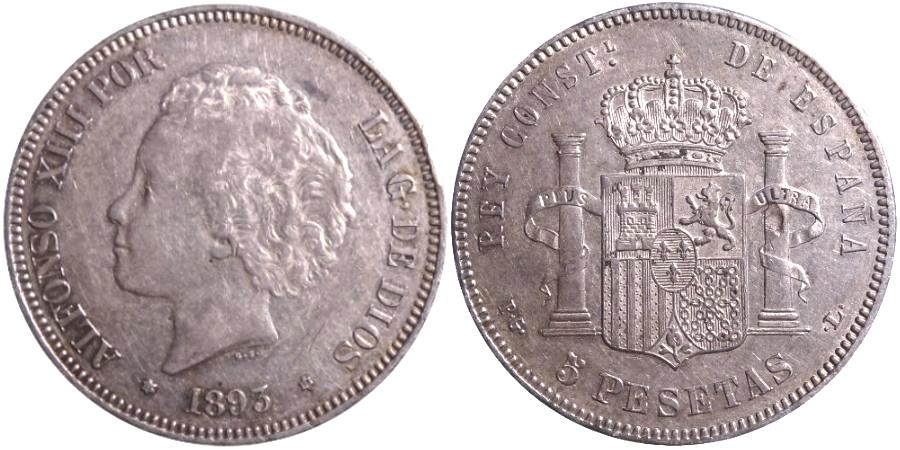
This is a five Pesetas piece minted in 1893 picturing King Alfonso XIII as a toddler. Weighs 25 grams of 0.900 fineness
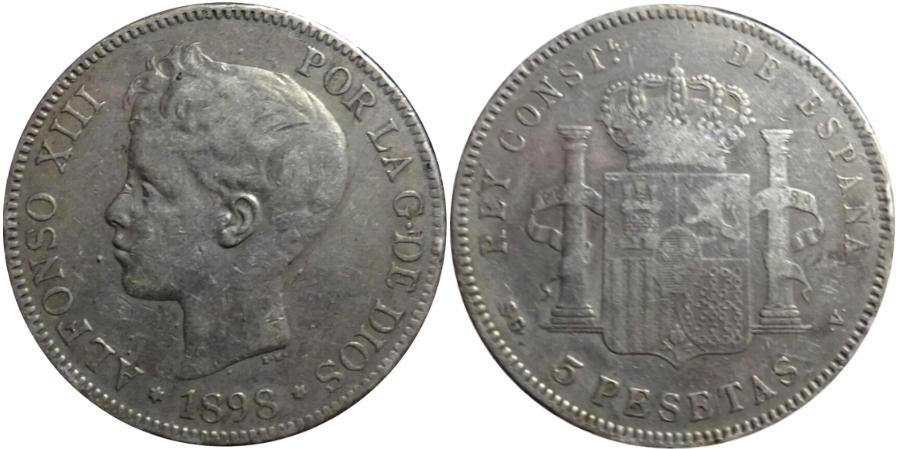
This is a five Pesetas piece minted in 1898 picturing King Alfonso XIII as a youth. Weighs 25 grams of 0.900 fineness
STRAITS SETTLEMENTS
Straits Settlements, a former British crown colony situated on the Malay Peninsula of Asia, was formed in 1826 by combining the territories of Singapore, Penang and Malacca. The colony was administered by the East India Company until its abolition in 1858. Straits Settlements was a part of British India from 1858 to 1867 at which time it became a Crown Colony. The Straits Settlements were dissolved in 1946, while the coinage continued to circulate until demonetized at the end of 1952.
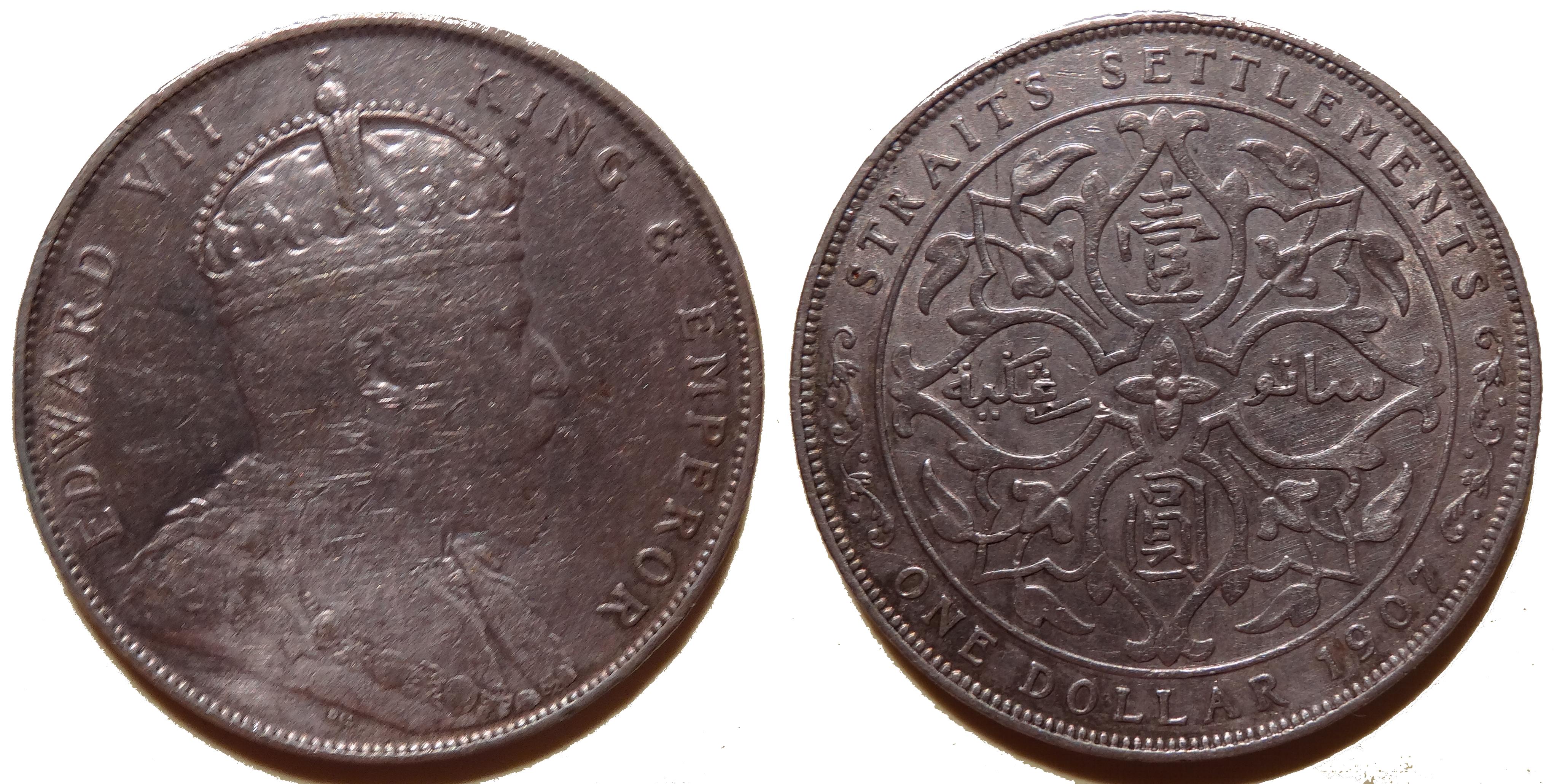
This is 1 Dollar coin minted for the Straits Settlements in 1907. Weighs 20 grams of 0.900 fineness
SUDAN
The Democratic Republic of the Sudan is located
in northeast Africa on the Red Sea between Egypt and Ethiopia. The Sudan, site of
the powerful Nubian kingdom of Roman times, was a collection of small independent
states from the 14th century until 1820-22 when it was conquered and united by Mohammed
Ali, Pasha of Egypt. Egyptian forces were driven from the area during the Mahdist
revolt, 1881-98, but the
Sudan was retaken by Anglo-Egyptian expeditions, 1896-98, and established as an
Anglo-Egyptian condominium in 1899. Britain supplied the administrative apparatus
and personnel, but the appearance of joint Anglo-Egyptian administration was continued
until 9 Jan. 1954, when the first Sudanese self government parliament was
inaugurated. The Sudan achieved independence on Jan. 1, 1956 with the consent of
the British and Egyptian government.
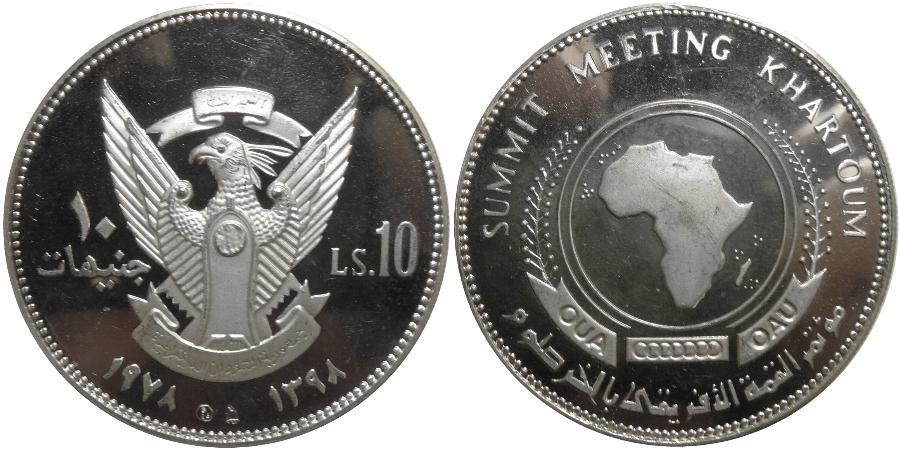
This is a ten pounds coin issued in 1978 to commemorate the Organization of African Unity meeting in Khartoum. Weighs 35 grams of 0.925 fineness.
SWEDEN
The Kingdom of Sweden is a limited constitutional monarchy located in northern Europe between Norway and Finland. Olaf Skottkonung founded Sweden as a Christian stronghold late in the 10th century. After conquering Finland late in the 13th century, Sweden, together with Norway, came under the rule of Denmark, 1397-1523, in an association known as the Union of Kalmar. Modern Sweden had its beginning in 1523 when Gustaf Vasa drove the Danes out of Sweden and was himself chosen King. Under Gustaf Adolphus II and Charles XII, Sweden was one of the great powers of 17th century Europe - until Charles invaded Russia in 1708, and was defeated at the Battle of Pultowa in June, 1709. Early in the 18th century, a coalition of Russia, Poland, and Denmark took away Sweden's Baltic empire and in 1809 Sweden was forced to cede Finland to Russia. The Treaty of Kiel ceded Norway to Sweden in January 1814. The Norwegians resisted for a time but later signed the Act of Union at the Convention of Moss in August 1814. The Union was dissolved in 1905 and Norway became independent. A new constitution that took effect on Jan. 1, 1975, restricts the function of the king largely to a ceremonial role.
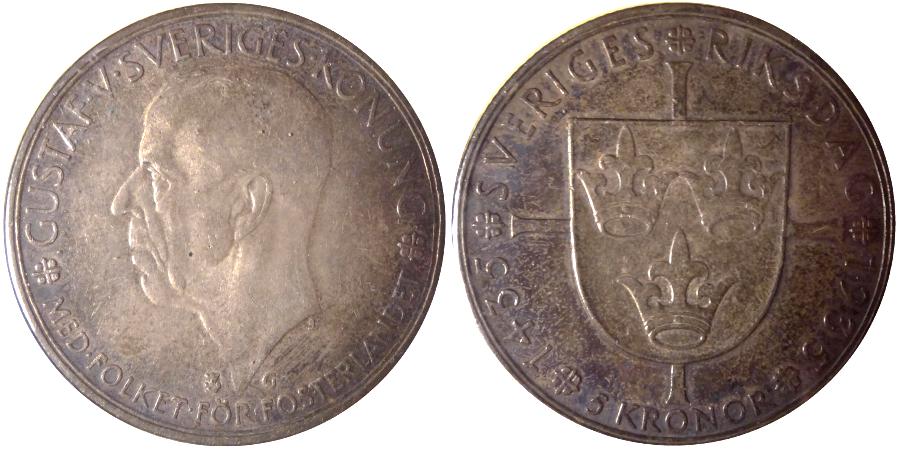
This is a five Kronor coin issued in 1935 to commemorate the 500th anniversary of the Swedish Riksdag (Parliament). The obverse has a bust of Gustav V Swedish King. The reverse has the three crowns arms of Sweden. Weighs 25 grams of 0.900 fineness
SWISS CANTONS
In Switzerland, canton is the name given to each
of the 23 states comprising the Swiss Federation. The origin of the cantons is
rooted in the liberty-loving instincts of the peasants
of Helvetia. After the Romans departed Switzerland to defend Rome against the
barbarians, Switzerland became, in the Middle Ages, a federation of fi efs of
the Holy Roman Empire. In 888 it was again united by Rudolf of Burgundy, a minor
despot, and for 150 years Switzerland had a king. Upon the death of the last
Burgundian king, the kingdom crumbled into a loose collection of feudal fiefs
ruled by bishops and ducal families who made their own laws and levied their own
taxes. Eventually this division of rule by arbitrary despots became more than
the freedom-loving and resourceful peasants could bear. The citizens living in
the remote valleys of Uri, Schwyz (from which Switzerland received its name) and
Unterwalden decided to liberate themselves from all feudal obligations and
become free. On 1 Aug. 1291, the elders of these three small states met on a
tiny heath known as the Rutli on the shores of the Lake
of Lucerne and negotiated an eternal pact which recognized their right to local
self-government, and pledged one another assistance against any encroachment
upon these rights. The
pact was the beginning of the Everlasting League and the foundation of the Swiss
Confederation.
ST. GALLEN
St. Gallen or traditionally St Gall, in German sometimes Sankt Gallen (Sankt Gallen is a Swiss town and the capital of the canton of St. Gallen. It evolved from the hermitage of Saint Gall, founded in the 7th century. The main tourist attraction is the Abbey of Saint Gall, a UNESCO World Heritage Site. The Abbey's renowned library contains books from the 9th century. The official language of St. Gallen is (the Swiss variety of Standard) German, but the main spoken language is the local variant of the Alemannic Swiss German dialect.
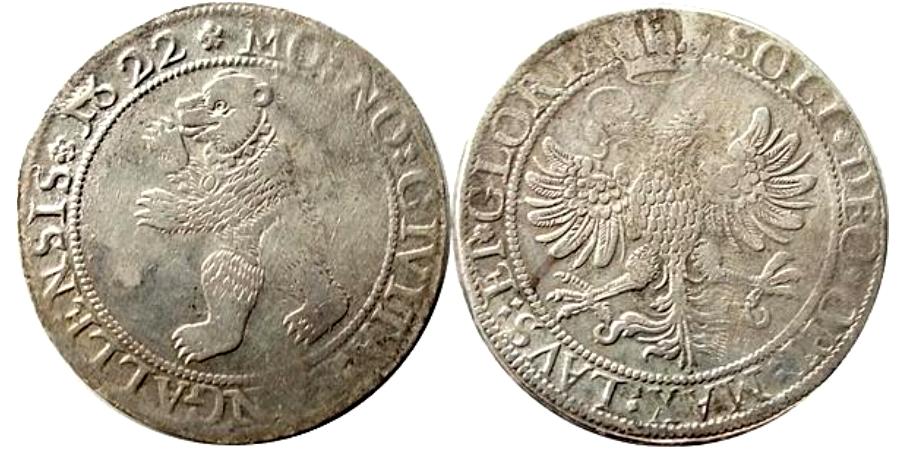
This is an one thaler coin minted in 1622 by the city of St. Gallen. The obverse features a bear encircled by the Latin legend MO: NO: CIVITA: SANGALLENSIS *1622*. The reverse has a crowned double eagle encircled by the Latin legend SOLI*DEO*OPT:MAX:LAVS:ET*GLORIA . Weighs 28.17 grams of unknown fineness.
SWITZERLAND
The Swiss Confederation is located in central Europe north of Italy and south of Germany. Switzerland, the habitat of lake dwellers in prehistoric times, was peopled by the Celtic Helvetians when Julius Caesar made it a part of the Roman Empire in 58 BC. After the decline of Rome, Switzerland was invaded by Teutonic tribes, who established small temporal holdings which in the Middle Ages, became a federation of fiefs of the Holy Roman Empire. As a nation, Switzerland originated in 1291 when the districts of Nidwalden, Schwyz and Uri united to defeat Austria and attain independence as the Swiss Confederation. After acquiring new cantons in the 14th century, Switzerland was made independent from the Holy Roman Empire by the 1648 Treaty of Westphalia. The revolutionary armies of Napoleonic France occupied Switzerland and set up the Helvetian Republic, 1798-1803. After the fall of Napoleon, the Congress of Vienna, 1815, recognized the independence of Switzerland and guaranteed its neutrality. The Swiss Constitutions of 1848 and 1874 established a union modeled upon that of the United States.
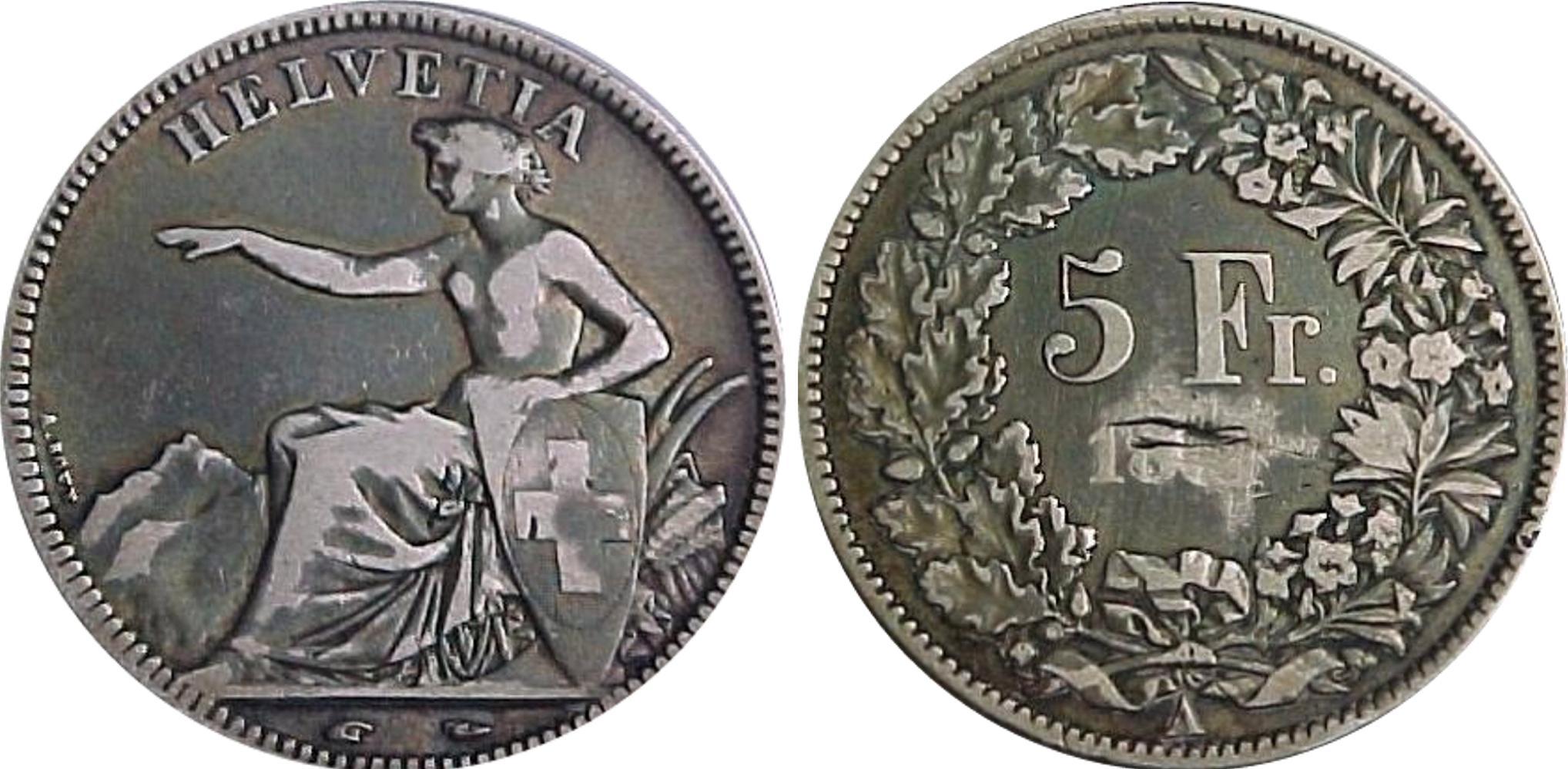
This is a five Francs Swiss coin minted in 1851 in Paris (mintmark A). Unfortunately, the coin was damaged on the reverse at the date. This is the second year of the first type of Swiss 5 Francs pieces. Weighs 25 grams of 0.900 fineness
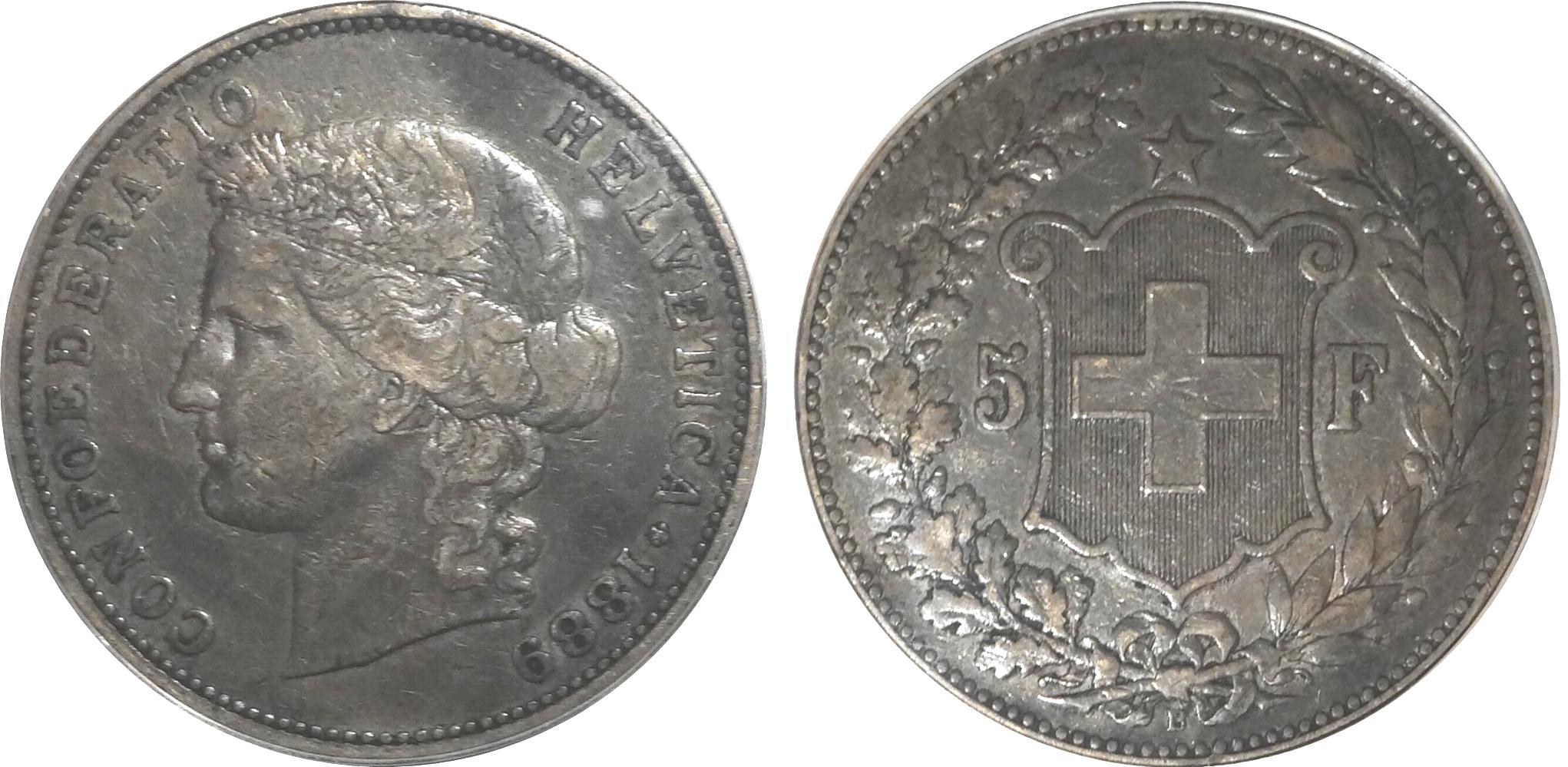
This is a five Francs piece minted at Bern (mintmark B) in 1889. This is the second type of Swiss five Francs coins for general circulation. Weighs 25 grams of 0.900 fineness
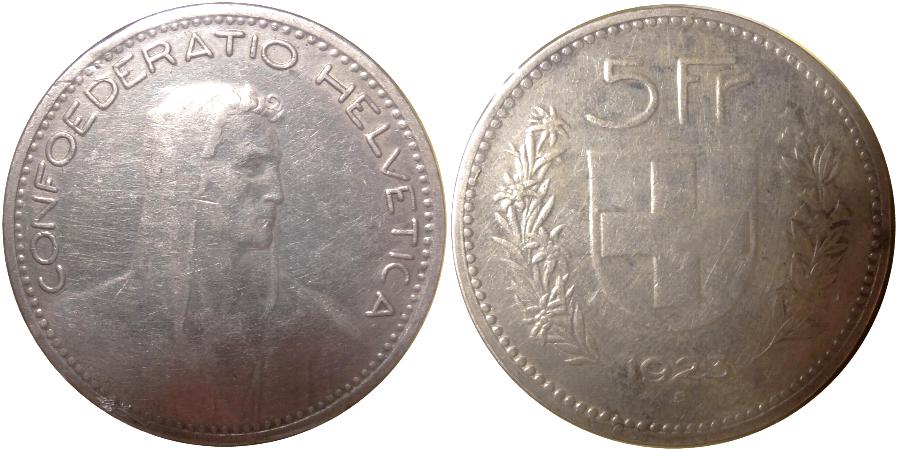
This is a five Francs piece minted at Bern (mintmark B) in 1923. This is the third type of Swiss five Francs coins for general circulation. The obverse has Wilhelm Tell. The reverse has the denomination (5 Fr.), the confederacy's arms, and the date. Weighs 25 grams of 0.900 fineness
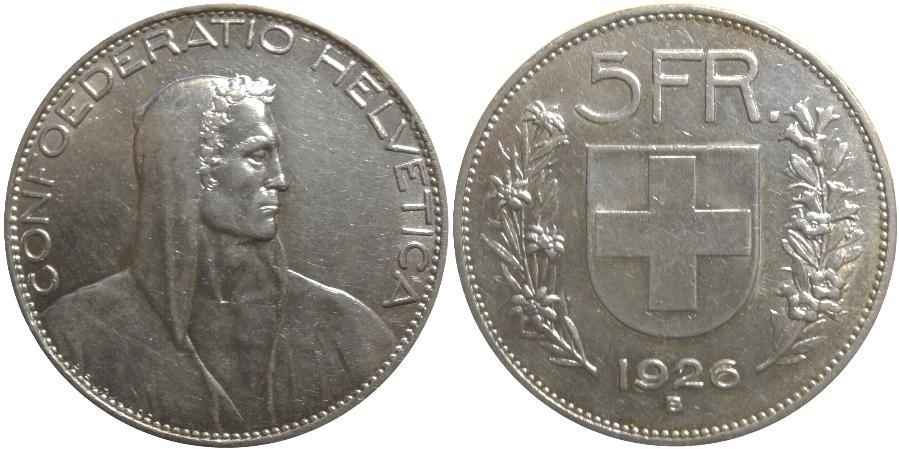
This is a five Francs piece minted at Bern (mintmark B) in 1923. The obverse has Wilhelm Tell. The reverse has the denomination (5 FR), the confederacy's arms, and the date. This type in 1931 had the size and silver content decreased to 15.5 grams. In 1968, silver was eliminated and the coin has been coined in copper nickel since to date (except 1969 was issued in the silver content). Weighs 25 grams of 0.900 fineness
SHOOTING THALERS
Swiss citizens value their right, in fact duty, to own firearms as they had no standing army. In essence the citizenry made up the militia to protect their confederacy, canton, and local. The cantons held Shooting Festivals that were fundraisers to aid the widows and orphans of the soldiers who had fallen in defense of their country (Schützenfest, Tir Fédérale, Tiro Federal). For each shooting festival, a commemorative medal was struck and were the equivalent in size and metal content to their five Francs legal tender counterpart. Even though they were issued for the festival, they did circulate outside as five Francs coins. These coins were issued in low mintages and were always highly ornate.
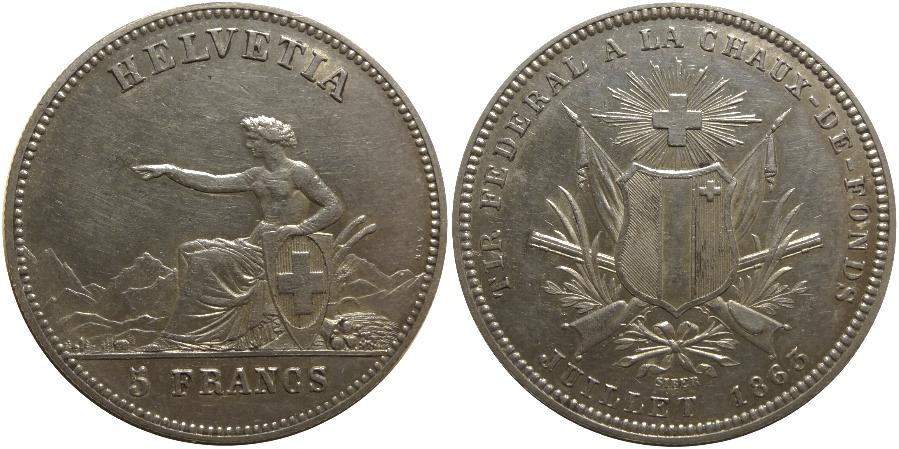
This is the one issued in 1863 for the Neuchatel shooting match. The obverse has a seated Helvetia with the legend HELVETIA above and the denomination 5 FRANCS below. The reverse has a stylized cantonal arms encircled by the legend TIR FEDERAL A LA CHAUX-DE-FONDS with the date JUILLET 1863 below. Weighs 25 grams of 0.835 fineness
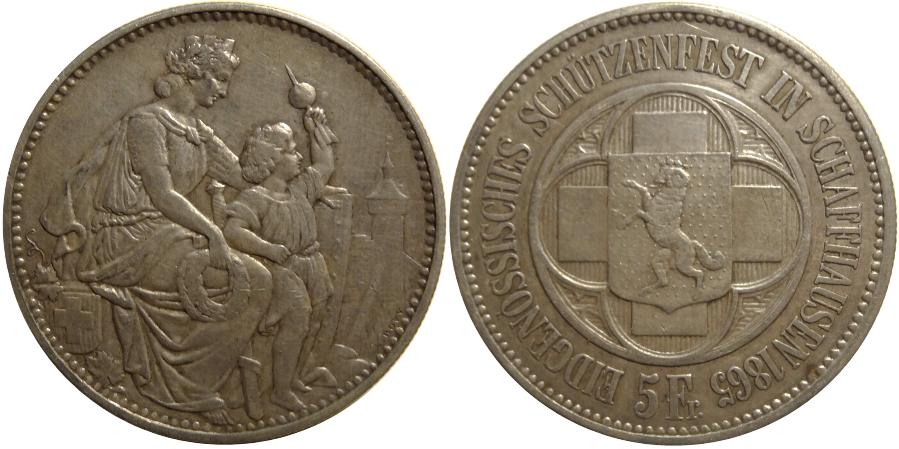
This is the one issued in 1865 for the Schaffhausen shooting match. The obverse has Helvetia and Wilhelm Tell's son holding the arrow with the apple that Tell shot off the child's head. The reverse has an allegorical image encircled by the legend EIDGENÖSSISCHES SCHÜTZENFEST IN SCHAFFHAUSEN 1865 with the denomination 5 Fr below. Weighs 25 grams of 0.835 fineness
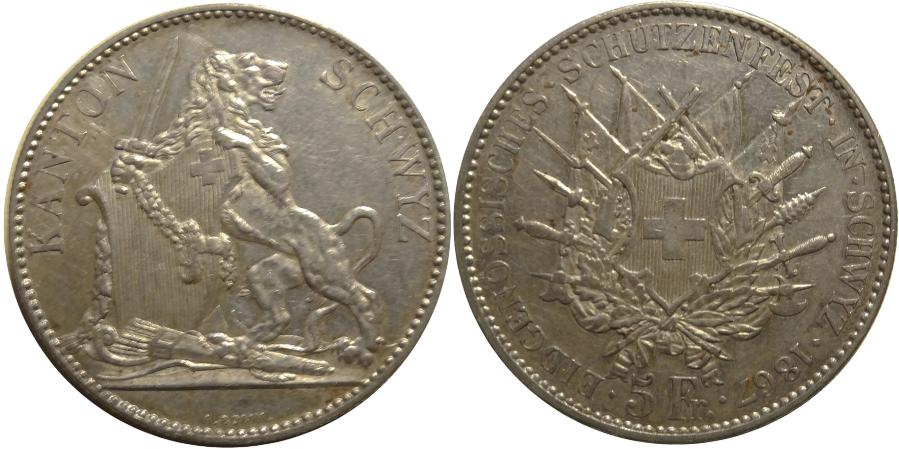
This is the one issued in 1867 for the Schwyz shooting match. The obverse has the cantonal arms encircled by the legend KANTON SCHWYZ. The reverse has an allegorical image encircled by the legend EIDGEN OSSISCHES · SCHUTZENFEST · IN · SCHWYZ · 1867 with the denomination 5 Fr. below. Weighs 25 grams of 0.835 fineness
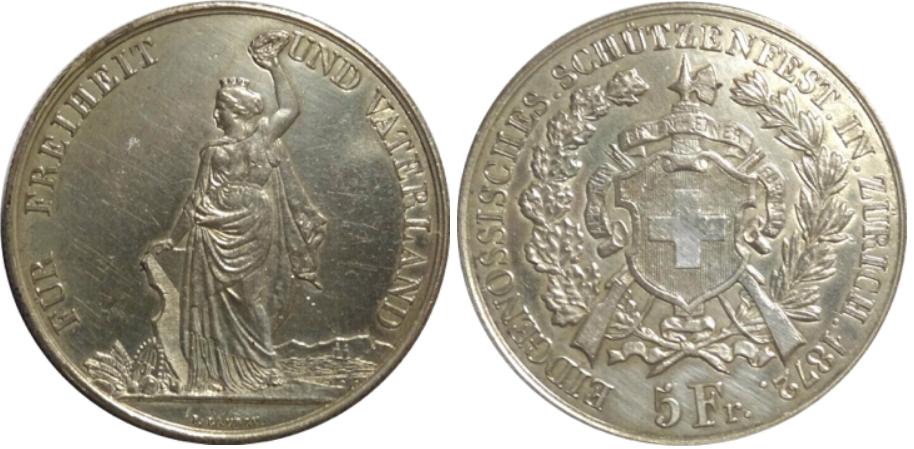
This is the one issued in 1872 for the Zurich shooting match. The obverse has the cantonal arms encircled by the legend FÜR FREIHEIT UND VATERLAND wit the denomination 5 Fr. below. The reverse has an allegorical figure of Helvetia encircled by the legend EIDGENÖSSISCHES.SCHÜTZENFEST.IN.ZÜRICH.1872. Weighs 25 grams of 0.835 fineness
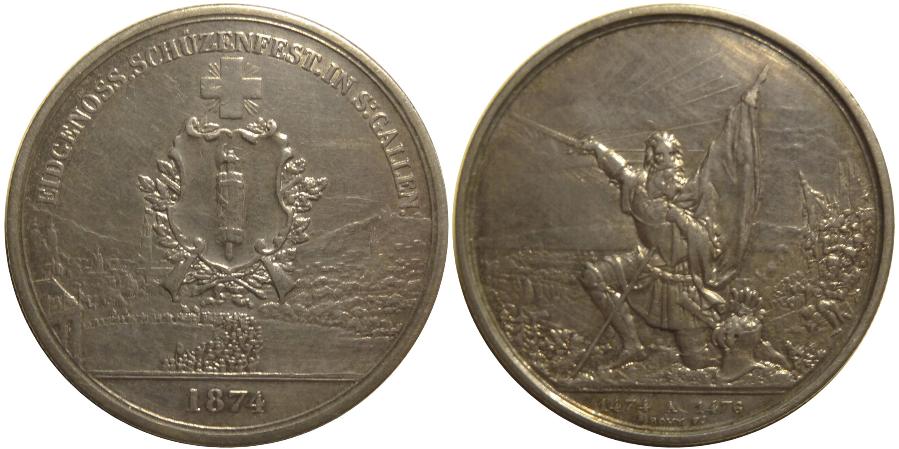
This is the one issued in 1874 for the St. Gallen shooting match. The obverse has the cantonal arms encircled by the legend EIDGENÖSS.SCHÜZENFEST.IN.ST.GALLEN with the date 1874 below. The reverse has an allegorical image wit the dates 1474-1874 below. Weighs 25 grams of 0.835 fineness
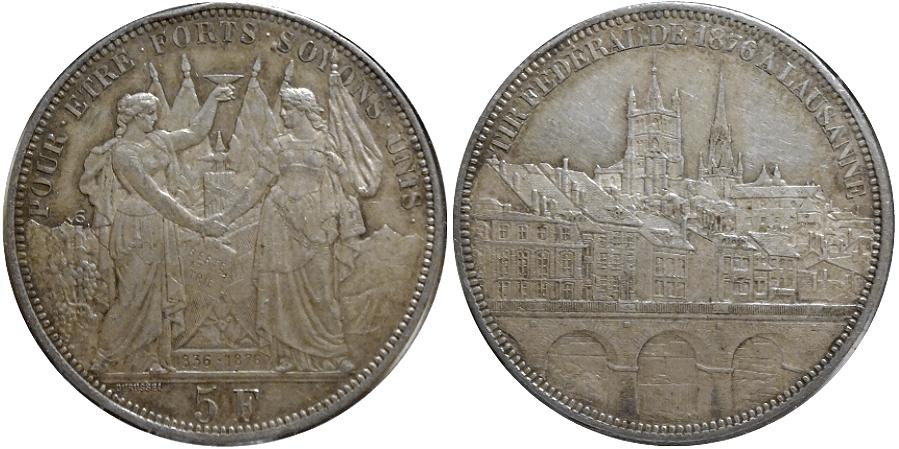
This is the one issued in 1876 for the Lausanne shooting match. The obverse has allegorical image with the dates 1835-1876 with the legend POUR · ETRE · FORTS · SOYONS · UNIS .The reverse has a city view with the legend TIR FÉDÉRAL DE 1876 A LAUSANNE. Weighs 25 grams of 0.835 fineness
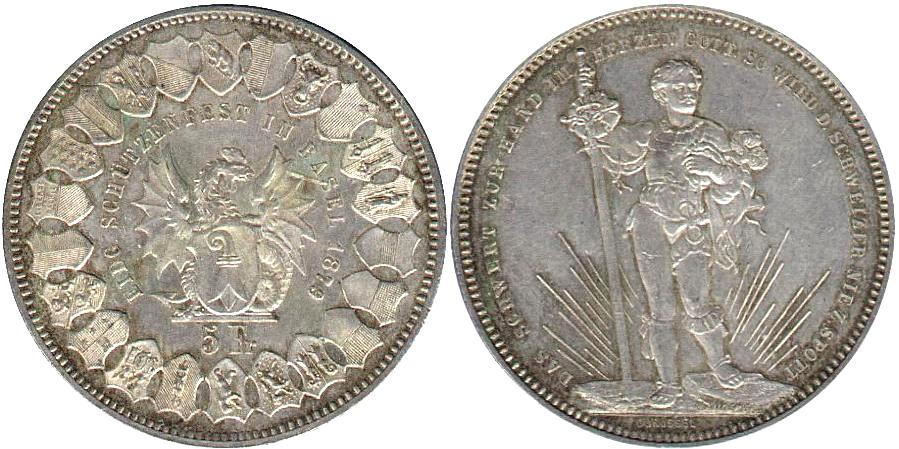
This is the one issued in 1879 for the Basel shooting match. The obverse has the cantonal arms encircled by the legend EIDG. SCHÜTZENFEST IN BASEL 1879 with the denomination 5 Fr. below, all encircled by all the cantonal arms. The reverse has an allegorical image encircled by the legend DAS SCHWERT ZUR HAND IN HERZEN GOTT. SO WIRD D. SCHWEIZER NIE Z. SPOTT. Weighs 25 grams of 0.835 fineness
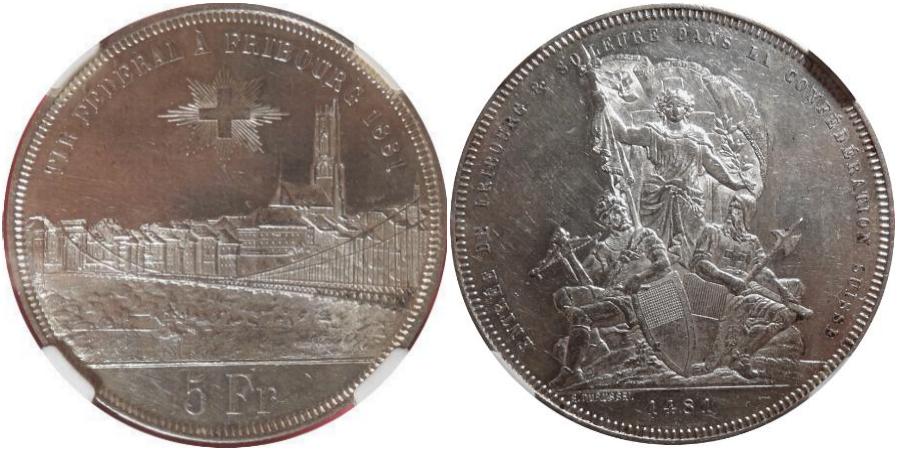
This is the one issued in 1881 for the Fribourg shooting match. The obverse has a city view encircled by the legend TIR FÉDÉRAL A FRIBOURG 1881 with the denomination 5 Fr below. The reverse has an allegorical image encircled by the legend ENTRÉE DE FRIBOURG ET SOLEURE DANS LA CONFÉDÉRATION SUISSE 1481.Weighs 25 grams of 0.835 fineness
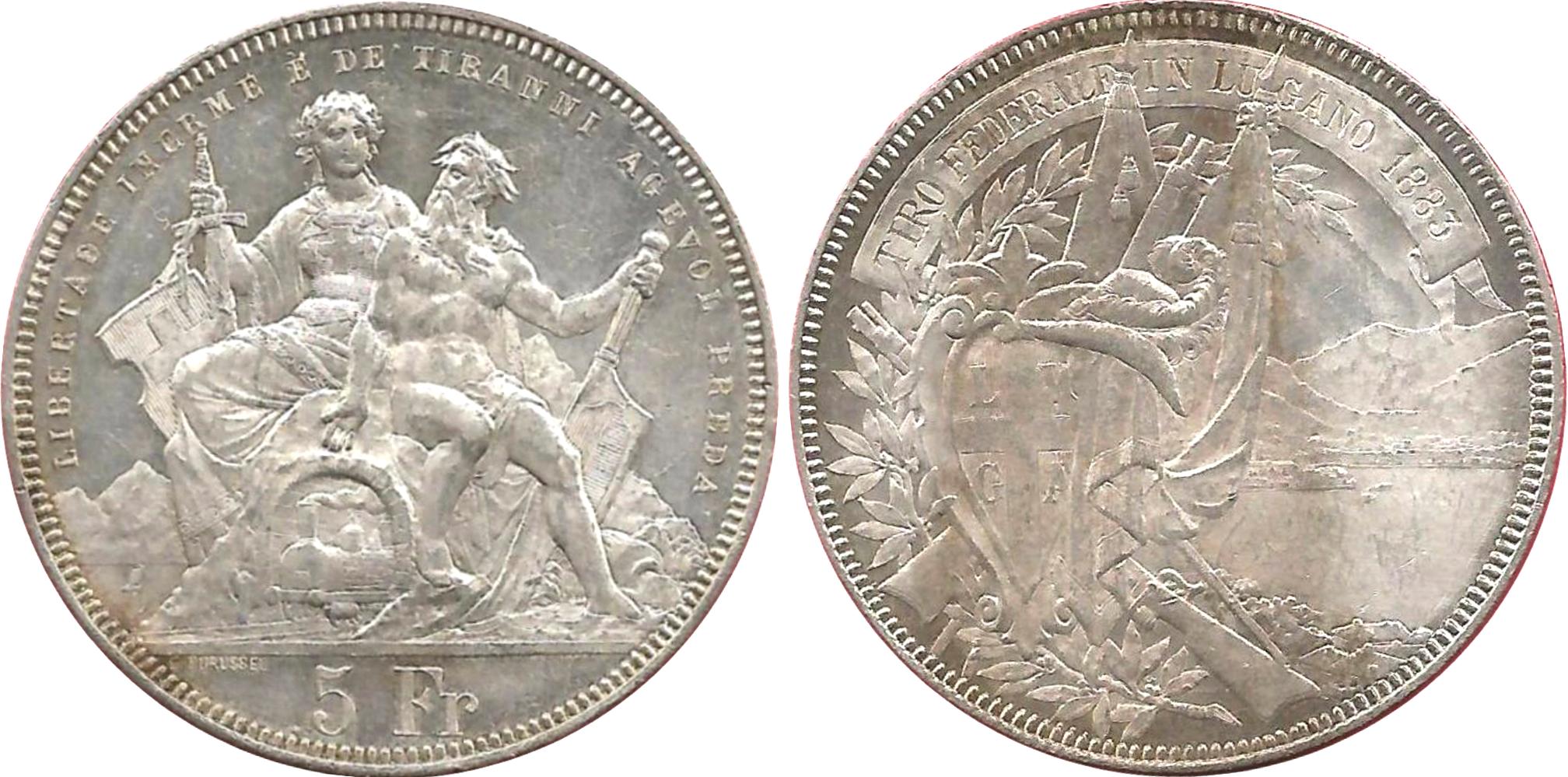
This is the one issued in 1883 for the Lugano shooting match. The obverse has a stylized cantonal arms encircled by the legend TIRO FEDERALE IN LUGANO 1883. The reverse has an allegorical image encircled by the legend LIBERTADE INERME È DE' TIRANNI AGEVOL PREDA with the denomination 5 Fr below. Weighs 25 grams of 0.835 fineness
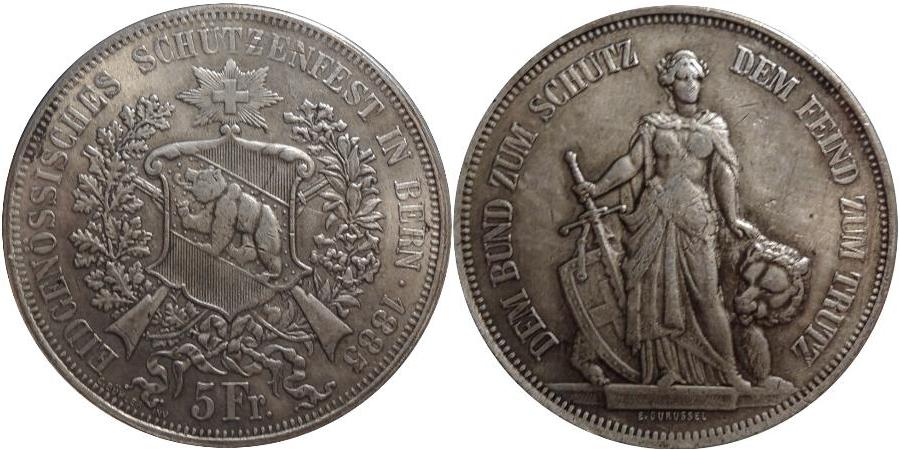
This is the one issued in 1885 for the Bern shooting match. The obverse has a stylized cantonal arms encircled by the legend EIDGENÖSSISCHES SCHÜTZENFEST IN BERN · 1885 with the denomination 5 Fr. at the bottom. The reverse has a standing female holding a sword in her right hand with the Swiss shield behind and a bear's head (symbol of Bern) in her left hand. encircled by the legend DEM BUND ZUM SCHUTZ DEM FEIND ZUM TRUTZ. Weighs 25 grams of 0.835 fineness
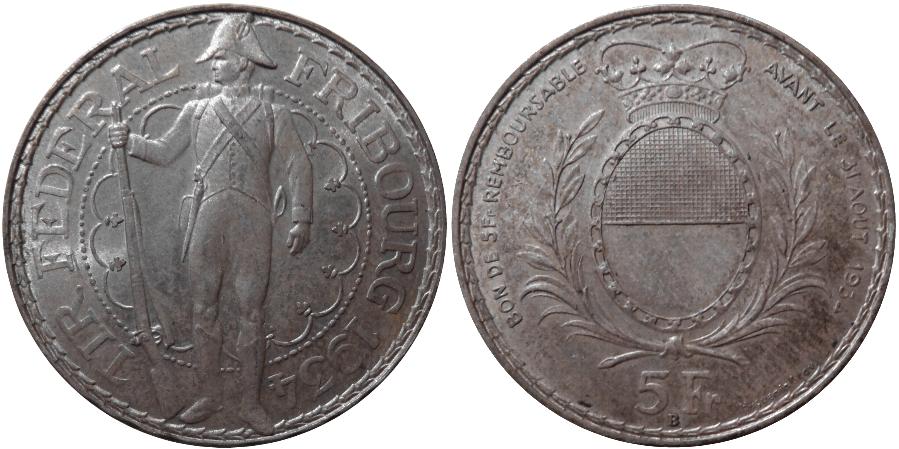
This is the one issued in 1934 for the Fribourg shooting match. The obverse has an armed patriot encircled by the legend TIR FEDERAL FRIBOURG 1934. The reverse has the cantonal arms encircled by the legend BON DE 5 Fr REMBOURSABLE AVANT LE 31 AOUT 1934 with the denomination 5 Fr below. Weighs 15 grams of 0.835 fineness (this was the first issued in the reduced size and weight of the circulation 5 Francs in introduced in 1931).
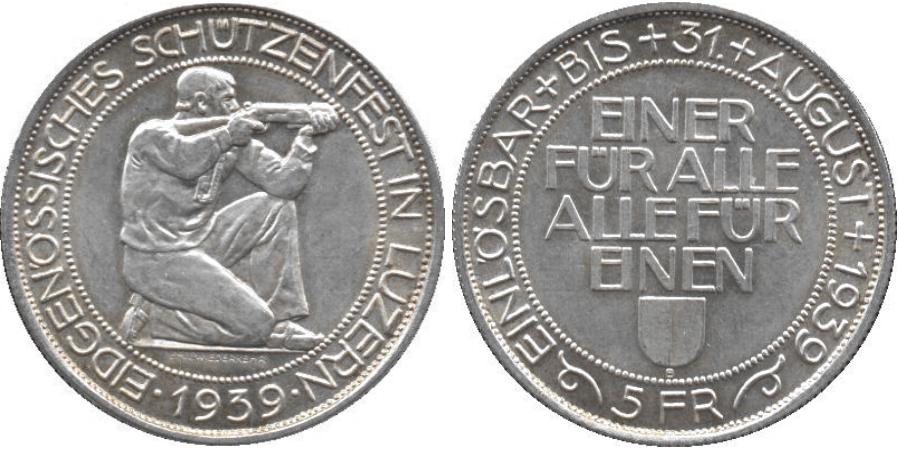
This is the one issued in 1938 for the Lucerne shooting match. The obverse has a citizen firing a rifle encircled by the legend EIDGENÖSSISCHES SCHÜTZENFEST IN LUZERN EMIL WIEDERKEHR. The reverse has the patriotic legend EINER FÜR ALLE ALLE FÜR EINEN ("one for all, all for one") encircled by the legend EINLÖSBAR+BIS+31.+AUGUST+1939. with the denomination 5 FR below. Weighs 25 grams of 0.835 fineness
TRINIDAD & TOBAGO
The Republic of Trinidad and Tobago is situated 7 miles (11 km.) off the coast of Venezuela. Columbus discovered Trinidad and Tobago in 1498. Trinidad remained under Spanish rule from the time of its settlement in 1592 until its capture by the British in 1797. It was ceded to the British in 1802. Tobago was occupied at various times by the French, Dutch, and English before being ceded to Britain in 1814. Trinidad and Tobago were merged into a single colony in 1888. The colony was part of the Federation of the West Indies until 31 Aug. 31, when it became independent. A new constitution establishing a republican form of government was adopted on 1 Aug. 1976. Trinidad and Tobago is a member of the Commonwealth of Nations. The President is Chief of State. The Prime Minister is Head of Government.
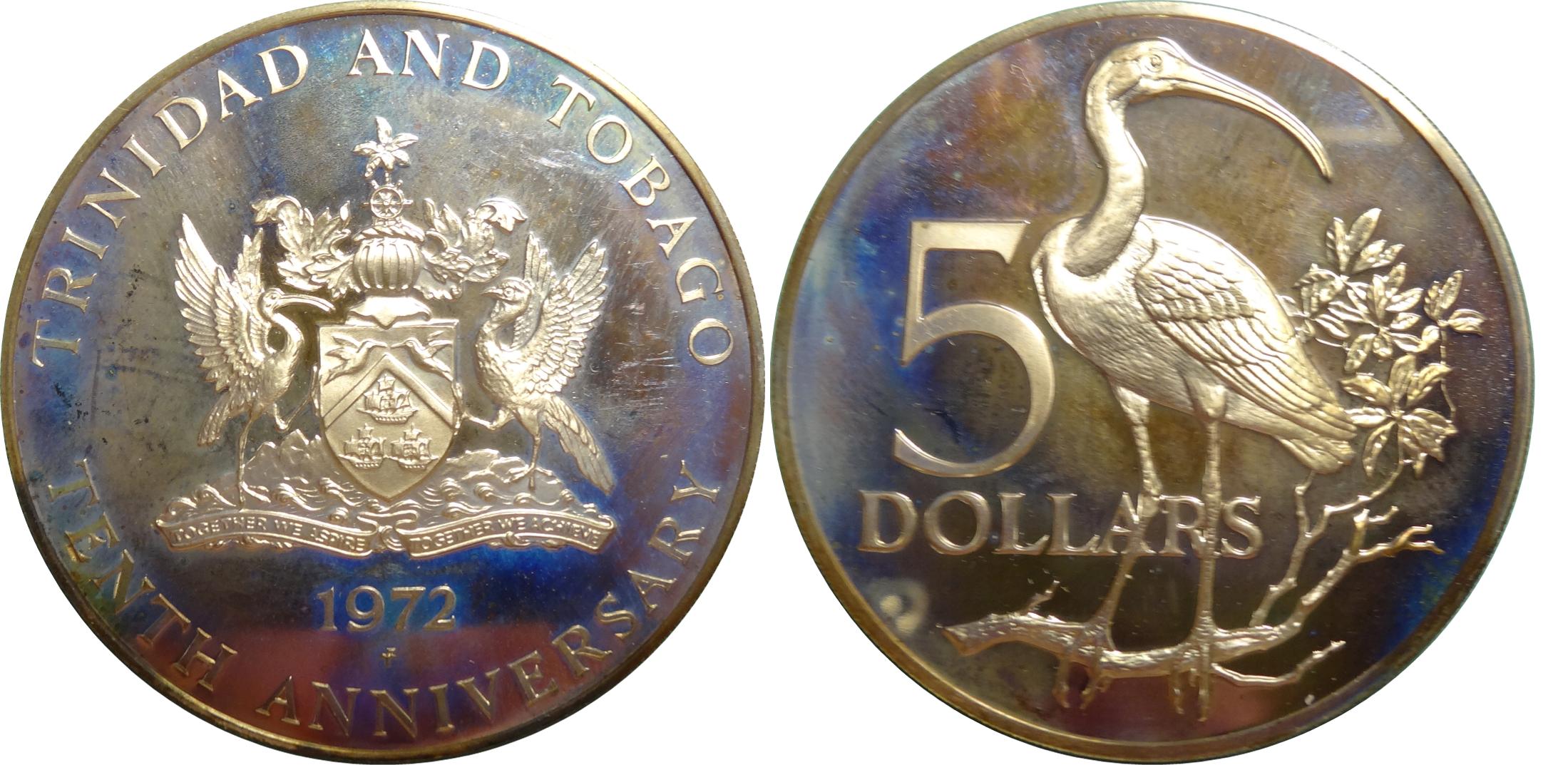
This a five dollar coin minted by the Franklin Mint in 1972. The obverse has the country's arms. The reverse has a scarlet ibis. Weighs 29.7 grams of 0.935 fineness.
TUNISIA
The Republic of Tunisia is located on the northern
coast of Africa between Algeria and Libya. Tunisia, settled by the Phoenicians in
the 12th century BC was the center of the seafaring Carthaginian Empire. After
the total destruction of Carthage, Tunisia became part of Rome's African province.
It remained a part of the Roman Empire (except for the 439-533 interval of Vandal
conquest) until taken by the Arabs, 648, who administered it until the Turkish invasion
of 1570. Under Turkish control, the public revenue was heavily dependent upon the
piracy of Mediterranean shipping, an endeavor that wasn't abandoned until 1819 when
a coalition of powers threatened appropriate reprisal. Deprived of its major source
of income, Tunisia underwent a financial regression that ended in bankruptcy, enabling
France to establish a protectorate over the country in 1881. National agitation
and guerrilla fighting forced France to grant Tunisia internal autonomy in 1955
and to recognize Tunisian Independence on 20 March 1956. Tunisia abolished the
monarchy and established a republic on 25 July 1957.
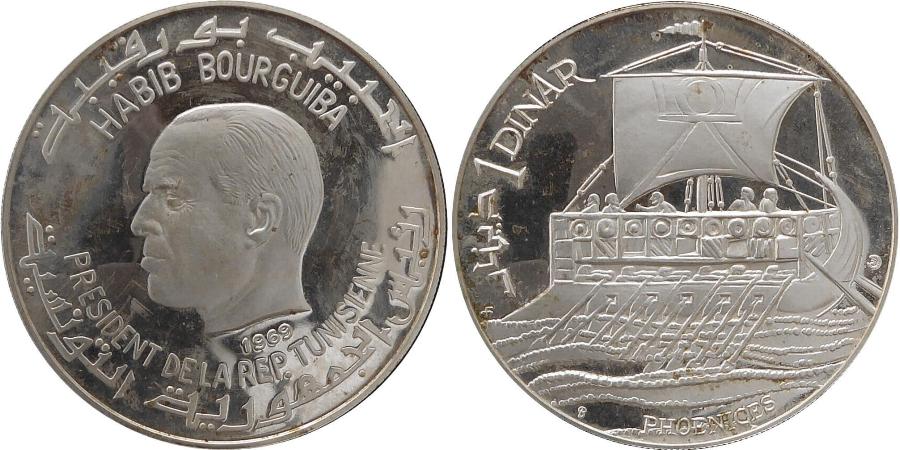
This is a one Dinar coin dated 1969 that was part of a 10 piece proof set honoring Tunisia's ancient history. The obverse has President Habib Bourguiba. The reverse has a Phoenician galley. Weighs 20 grams of 0.925 fineness
TURKEY
The Republic of Turkey is a parliamentary democracy of the Near East located partially in Europe and partially in Asia between the Black and the Mediterranean Seas. The Ottoman Turks, a tribe from Central Asia, first appeared In the early 13th century, and by the 17th century had established the Ottoman Empire which stretched from the Persian Gulf to the southern frontier of Poland, and from the Caspian Sea to the Algerian plateau. The defeat of the Turkish navy by the Holy League in 1571, and of the Turkish forces besieging Vienna in 1683, began the steady decline of the Ottoman Empire which, accelerated by the rise of nationalism, contracted its European border, and by the end of World War I deprived it of its Arab lands. The present Turkish boundaries were largely fixed by the meaty of Lausanne in 1923. The sultanate and caliphate, the political and spiritual ruling institutions of the old empire, were separated and the sultanate abolished in 1922. On 29 Oct. 1923, Turkey formally became a republic under the leadership of Kemal Ataturk. He modernized Turkey, adopting the western alphabet and abandoning Arabic script and secularized the country.
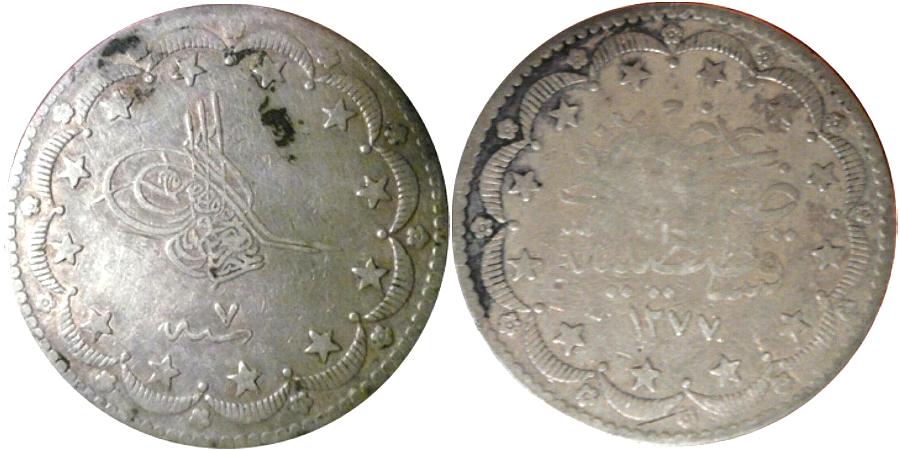
This is a 20 Kurush piece minted in Constantinople in Year 7 of
1277AH (1868 AD). The obverse has the toughra of Abdul Aziz and the reverse has
the Turkish legend
عز نصره ضرب في سطنطينية (May he be victorious
Struck in Constantinople),
denomination, mint, and accession year. It weighs 24 grams of 0.830 fineness.
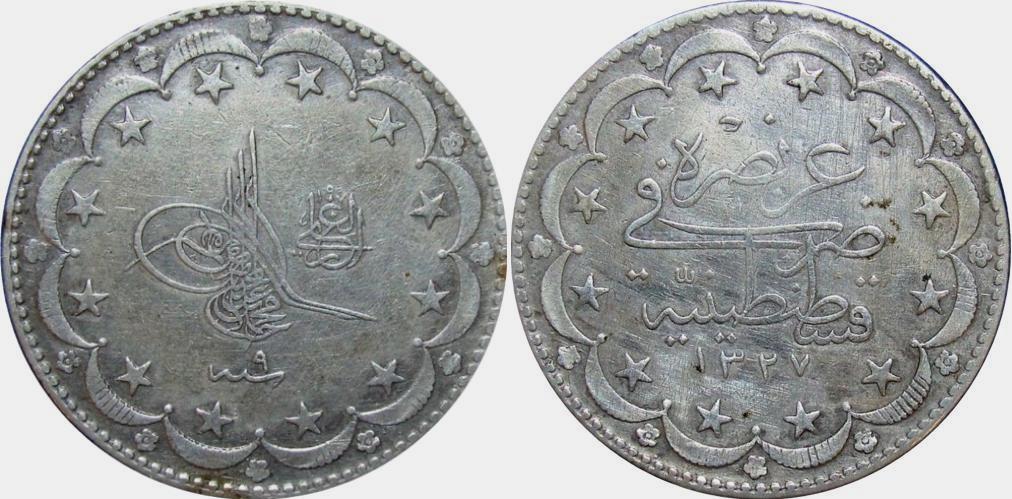
This is a 20 Kurush piece minted in Constantinople in Year 9 of 1327AH (1918 AD). The obverse has the toughra of Mohammed V and the reverse has the denomination, mint, and accession year. It weighs 24 grams of 0.830 fineness.
UNITED STATES OF AMERICA
This is one of the first USA one dollar coins that were minted in 1794 and 1795 called the Flowing Hair Small Eagle variety. Weighs 27 grams of 0.892 fineness
This example is dated 1797 of the Draped Bust Small Eagle dollar. Weighs 27 grams of 0.892 fineness
This is a 1798 example of the Draped Bust Heraldic Eagle variety. Weighs 27 grams of 0.892 fineness
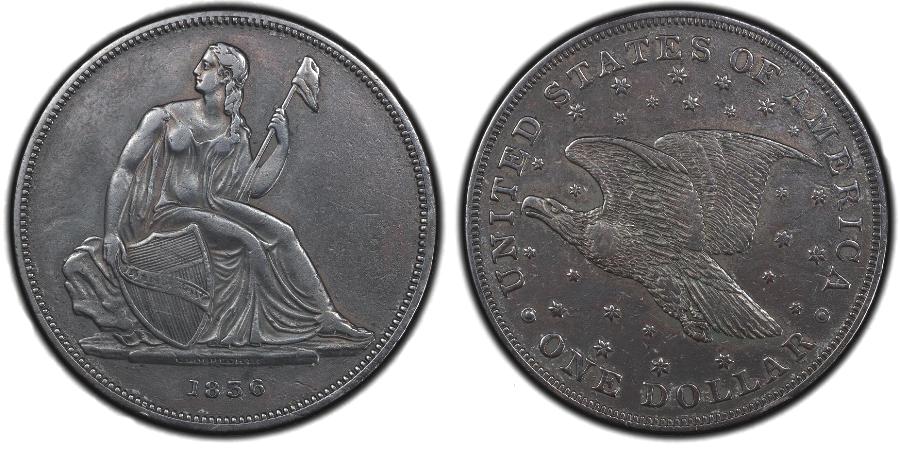
This is the third major type of USA dollars, the Gobrecht series. This example is the first year of issue 1836. The series concluded in 1839. Weighs 27 grams of 0.900 fineness
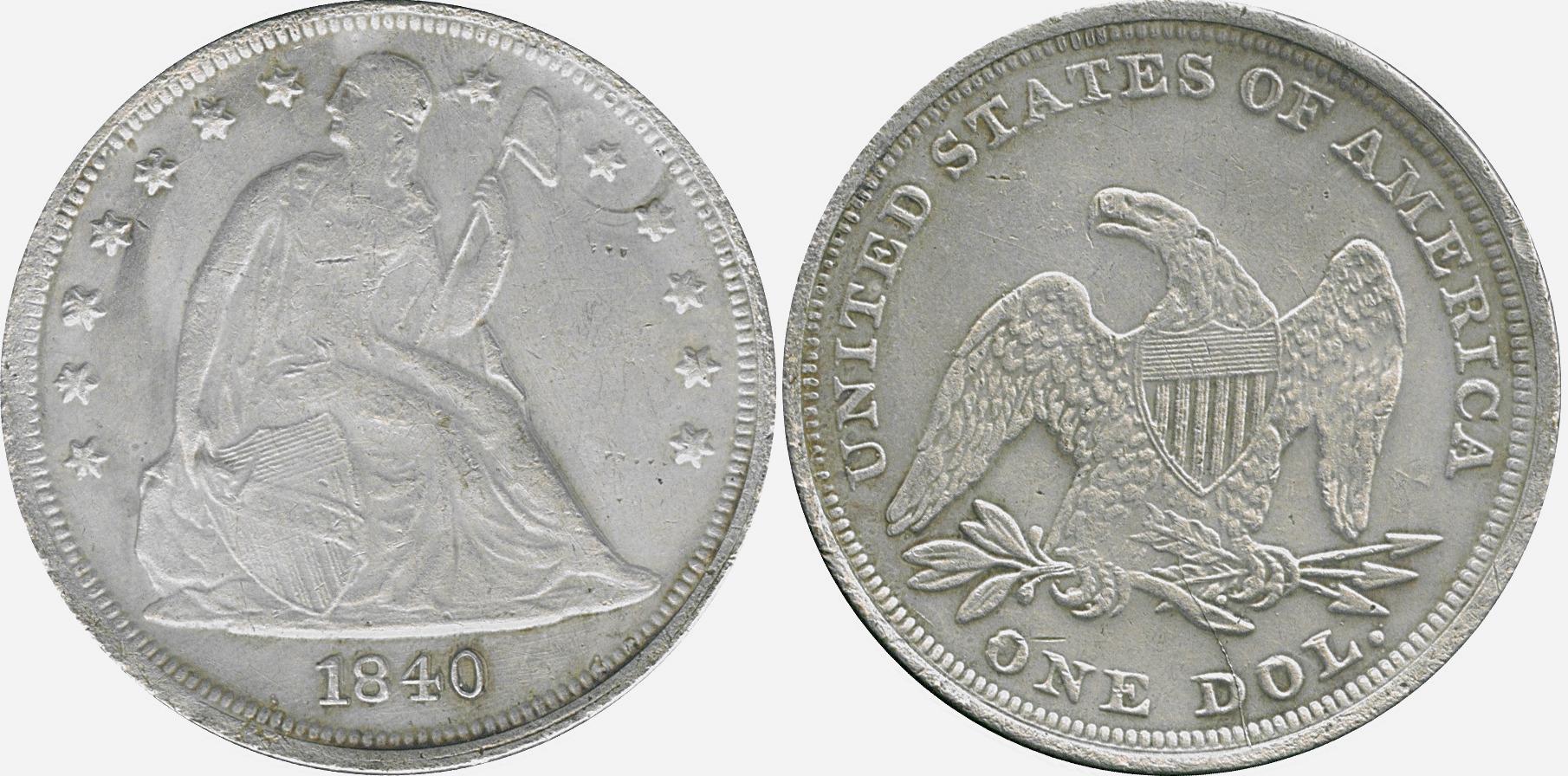
This is the fourth major type of USA dollars, the Seated Liberty series. This example is the first year of issue 1840. The series concluded in 1875. Weighs 27 grams of 0.900 fineness
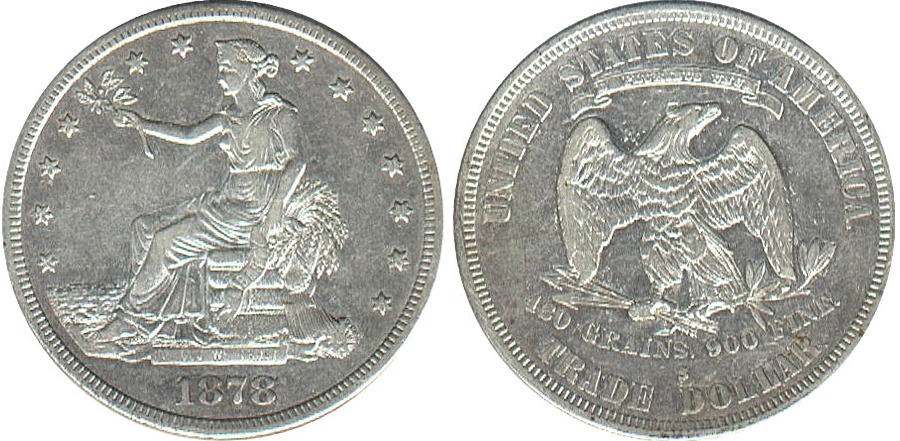
This was the USA's attempt to replace the Spanish 8 reales coin that was accepted in the Far East. These were minted from 1873 to 1878 for circulation. Proof versions continued through 1883. Weighs 27 grams of 0.892 fineness

This is the fifth major type of USA dollars, the Morgan series. This example is the second year of issue 1879. The series concluded in 1921. Weighs 27 grams of 0.900 fineness
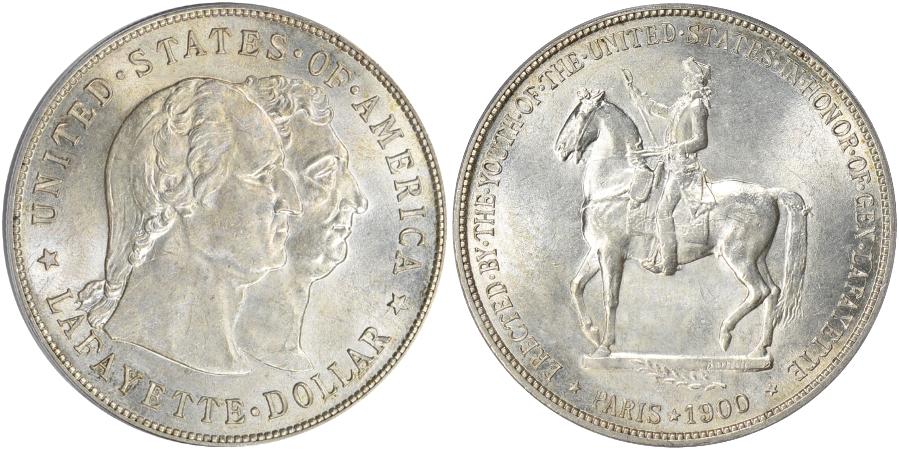
This is the first commemorative dollar which was issued in 1900 to commemorate Maj. Gen. Marie-Joseph Paul Yves Roch Gilbert du Motier, Marquis de Lafayette who served in the revolutionary army under Gen, Washington. The reverse has the mounted figure statue of Gen. Lafayette that the USA paid for on the Cours la Reine in Paris, France. Weighs 27 grams of 0.900 fineness

This is the sixth major type of USA circulating dollars, the Peace series. This example is the last year of issue 1935. The series started in 1921 and concluded in 1935. Weighs 27 grams of 0.900 fineness
URUGUAY
The Oriental Republic of Uruguay (so called because of its location on the east bank of the Uruguay River) is situated on the Atlantic coast of South America between Argentina and Brazil. Uruguay was discovered in 1516 by Juan Diaz de Soils, a Spaniard, but settled by the Portuguese who founded a colony in 1680. Spain contested Portuguese possession and, after a long struggle, gained control of the country in 1778. During the general South American struggle for independence, Uruguay's first attempt was led by Gaucho soldier Jose Gervasio Artigas leading the Banda Oriental. It was quelled by Spanish and Portuguese forces in 1811. The armistice was soon broken and Argentine force from Buenos Aires cast off the Spanish bond in the Plata region in 1814 only to be conquered again by the Portuguese from Brazil in the struggle of 1816-20. Revolt flared anew in 1825 and Independence was reasserted in 1828 with the help of Argentina. The Uruguayan Republic was established in 1830.
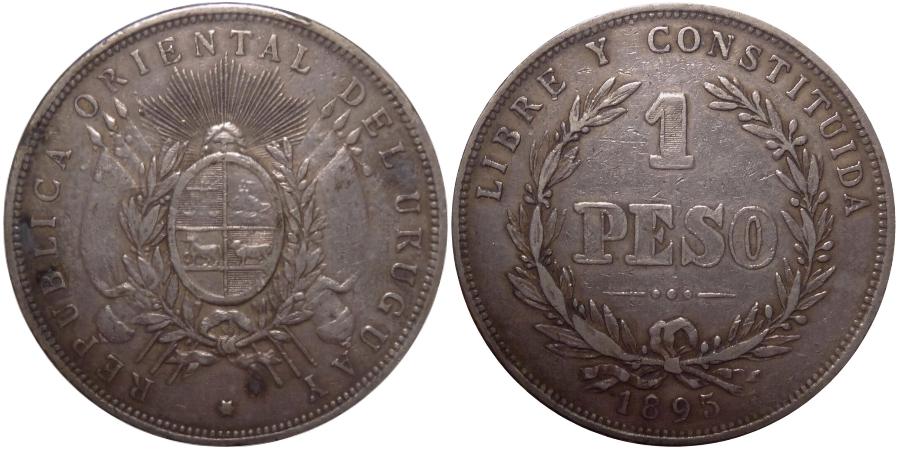
This is an one Peso coin minted in 1895. Weighs 25 grams of 0.900 fineness
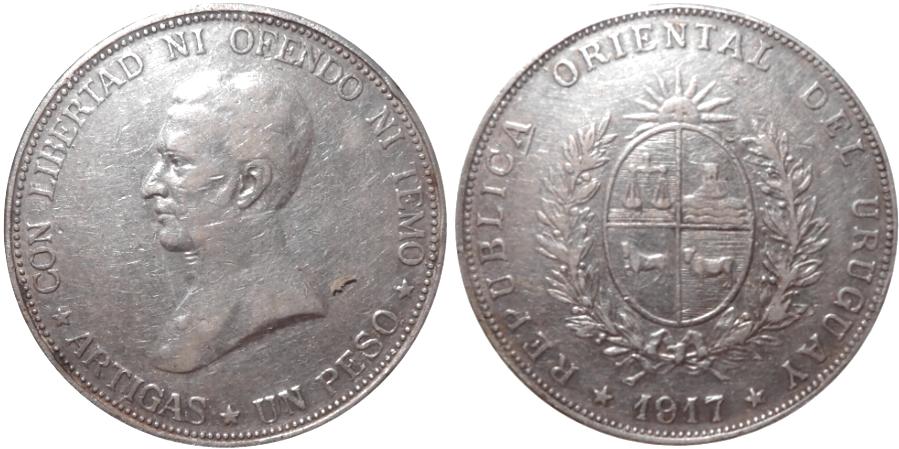
This is an one Peso coin minted in 1917. Reverse has a bust of José Artigas. Weighs 25 grams of 0.900 fineness
VENEZUELA
The Bolivarian Republic of Venezuela ("Little Venice") is located on the northern coast of South America between Colombia and Guyana. Columbus discovered Venezuela on his third voyage in 1498. Initial exploration did not reveal Venezuela to be a land of great wealth. An active pearl trade operated on the offshore Islands and slavers raided the interior in search of Indians to be sold into slavery, but no significant mainland settlements were made before 1567 when Caracas was founded. Venezuela, the home of Bolivar, was among the first South American colonies to rebel against Spain in 1810. The declaration of independence of Venezuela was signed by seven provinces which are represented by the seven stars of the Venezuelan flag. Coinage of Caracas and Margarita use the seven stars in their designs. These original provinces were: Barcelona, Barinas, Caracas, Cumana, Margarita, Merida, and Trujillo. The Provinces of Coro, Guyana and Maracaibo were added to Venezuela during the Independence War. Independence was attained in 1821 but not recognized by Spain until 1845. Together with Ecuador, Panama and Colombia, Venezuela was part of Gran Colombia" until 1830, when it became a sovereign and independent state.
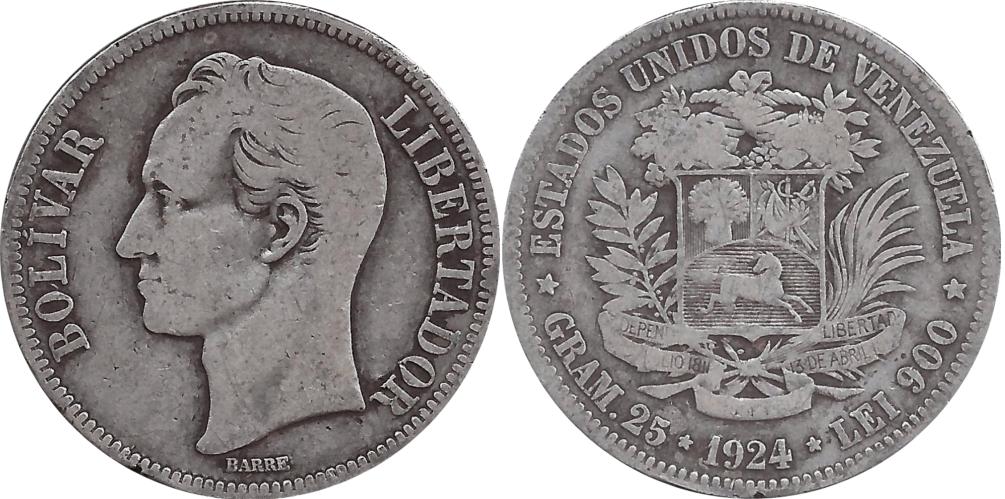
This is a 1924 five Bolivar piece, The obverse has Simon Bolivar, The reverse has Venezuela's arms. Weighs 25 grams of 0.900 fineness
WEST AFRICAN STATES
The West African States, a former federation of eight French colonial territories on the northwest coast of Africa, has an area of 1,831,079 sq. mi. (4,742,495 sq. km.) and a population of about 17 million. The constituent territories were Mauritania, Senegal, Dahomey, French Sudan, Ivory Coast, Upper Volta, Niger, and French Guinea. The members of the federation were overseas territories within the French Union until Sept. of 1958 when all but French Guinea approved the constitution of the Fifth French Republic, thereby electing to become autonomous members of the new French Community. French Guinea voted to become the fully independent Republic of Guinea. The other seven attained independence in 1960. The French West Africa territories were provided with a common currency, a practice which was continued as the monetary union of the West African States which provides a common currency to the autonomous republics of Dahomey (now Benin), Senegal, Upper Volta (now Burkina Faso), Ivory Coast, Mali, Togo, Niger, and Guinea-Bissau.
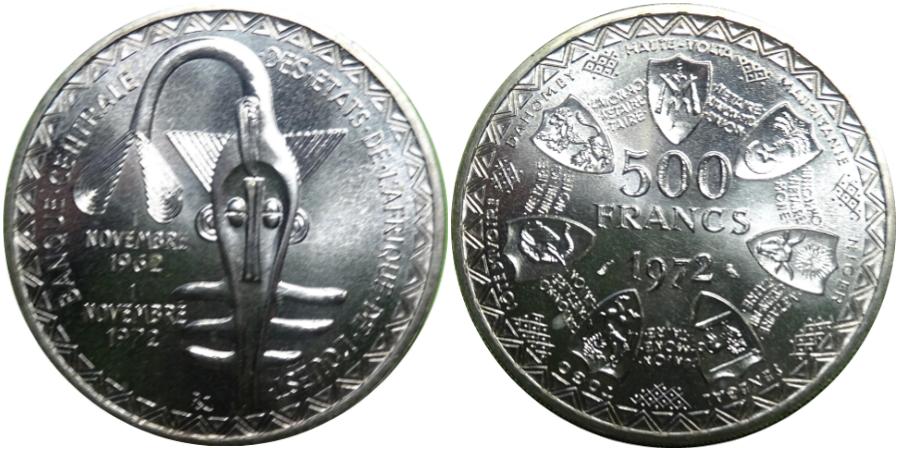
This five hundred francs coin was issued in 1972 to commemorate the 10th anniversary of the monetary union. Weighs 25 grams of 0.900 fineness
WESTERN SAMOA
Western Samoa (now the Independent State of Samoa is located in the Pacific Ocean 1,600 miles (2,574 km.) northeast of New Zealand,. The first European to sight the Samoan group of islands was the Dutch navigator Jacob Roggeveen in 1722. Great Britain, the United States and Germany established consular representation at Apia in 1847, 1853 and 1861 respectively. The conflicting interests of the three powers produced the Berlin agreement of 1889, which declared Samoa neutral and had the effect of establishing a tripartite protectorate over the islands. A further agreement, 1899, recognized the rights of the United States in those islands east of 171 deg. west longitude (American Samoa) and of Germany in the other islands (Western Samoa). New Zealand occupied Western Samoa at the start of World War I and administered it as a League of Nations mandate and U. N. trusteeship until 1 Jan. 1962, when it became an independent state. Samoa is a member of the Commonwealth of Nations. The Chief Executive is Chief of State. The prime minister is the Head of Government. The last Head of State, Malietoa Tanumafi li II, held his position for life. He also was called Susuga, was the Malietoa, the title of one of Samoa's four paramount chiefs, and the head of state, or O le Ao o le Malo, a position that he held for life, of Samoa from 1962 to 2007. He was co-chief of state in 1962 and became the sole head of state on 15 April 1963. At the time of his death in 2007, he was the oldest national leader in the world. It is a common mistake that the Malietoa title is a title equivalent to a king-ship. Malietoa is known as the first warrior title, and is respected not as a King but as a Tamaaiga or Ao Mamalu ole Malo. The Legislative Assembly elects future Heads of State for 5-year terms.
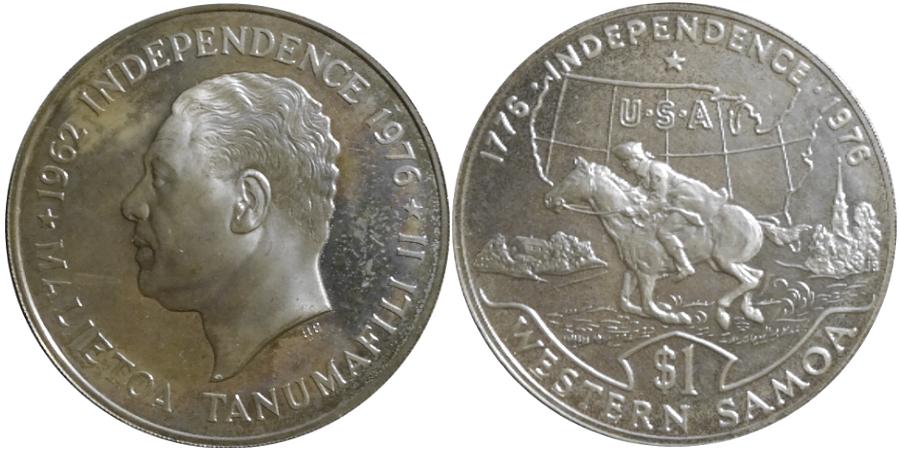
This one Tālā coin was issued in 1972 to commemorate the bicentenary of USA Independence. The obverse has Malietoa Tanumafili II with 1962 INDEPENDENCE 1976 and his title. The reverse has Paul Revere riding over a map of the USA with 1776 - INDEPENDENCE - 1976, the denomination, and the country's name. Weighs 30.4 grams of 0.925 fineness.
WÜRTTEMBERG
Located in South Germany, between Baden and Bavaria, Württemberg takes Its name from the ancestral castle of the ruling dynasty. The early countship was located in the old duchy of Swabia, most of which was given to Count Ulrich 11(1265-79) In 1268 by Conradin von Hohenstaufen. Ulrich's son, Eberhard II (1279-1325) moved the seat of his rule to Stuttgart. Württemberg obtained the mint right in 1374 and Joined the Swabian monetary union two years later. The countship was divided into the lines of Württemberg-Urach and Württemberg-Stuttgart in 1441 and the elder Urach branch was raised to the rank of duke in 1495. It became extinct in the following year and the younger line in Württemberg-Stuttgart inherited the lands and ducal title. A cadet line of the family had been established in Mümpelgard in 1473 and, when the Württemberg-Stuttgart line tell extinct in 1593, the primacy of the dynasty tell to Württemberg-Mümpelgard. The latter took the Stuttgart title and spun off several cadet branches In Neustadt, Neuenburg, and Weiltingen-Brenz. Meanwhile, the duke in Stuttgart succumbed to the French advances under Napoleon. Land west of the Rhine was exchanged with France for territories in and around Reutlingen, Heilbronn, and seven other towns in 1802. More territories were added in Swabia at the expense of Austria in 1805. Napoleon elevated the duke to the status of elector In 1803 and then to king in 1806. Even more land was given to Württemberg that year, doubling the kingdom's size, and it Joined the Confederation of the Rhine. At the close of the Napoleonic Wars (1792-1815), Württemberg Joined the German Confederation, but sided with Austria in Its war with Prussia In 1866. It sided with Prussia against France in 1870 and became a member of the German Empire In 1871. King Wilhelm I was forced to abdicate at the end of World War I In 1918.
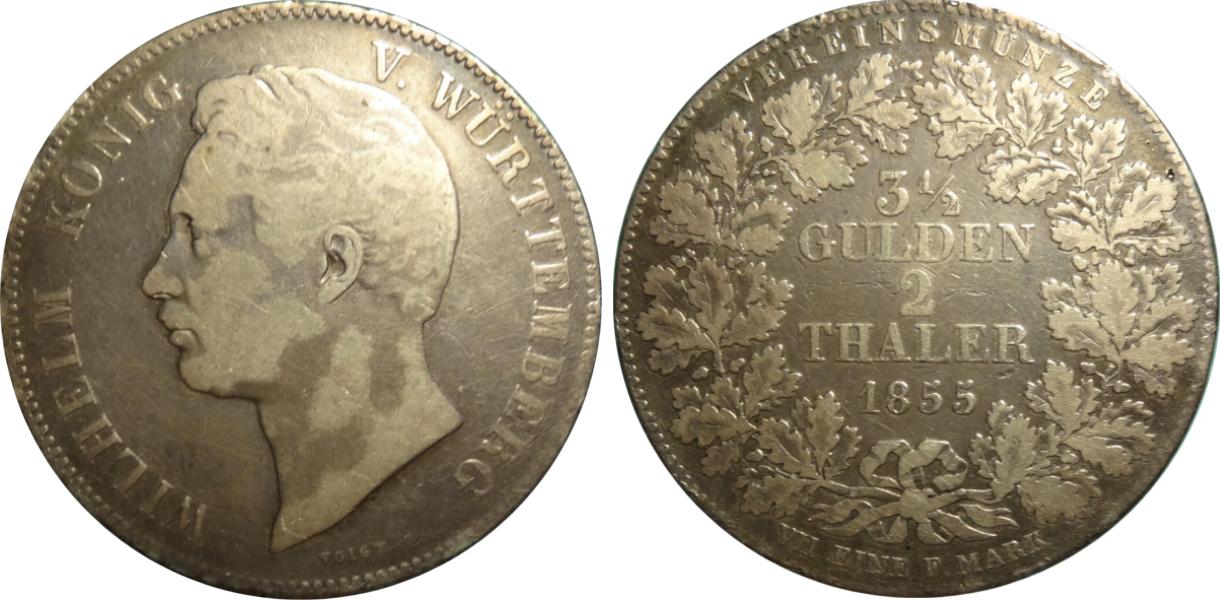
This is a two Thaler coin minted in 1855. The obverse has King Wilhelm. The reverse has the denomination stated as both 3½ Gulden and two thaler. Weighs 37.12 grams in 0.900 fineness.
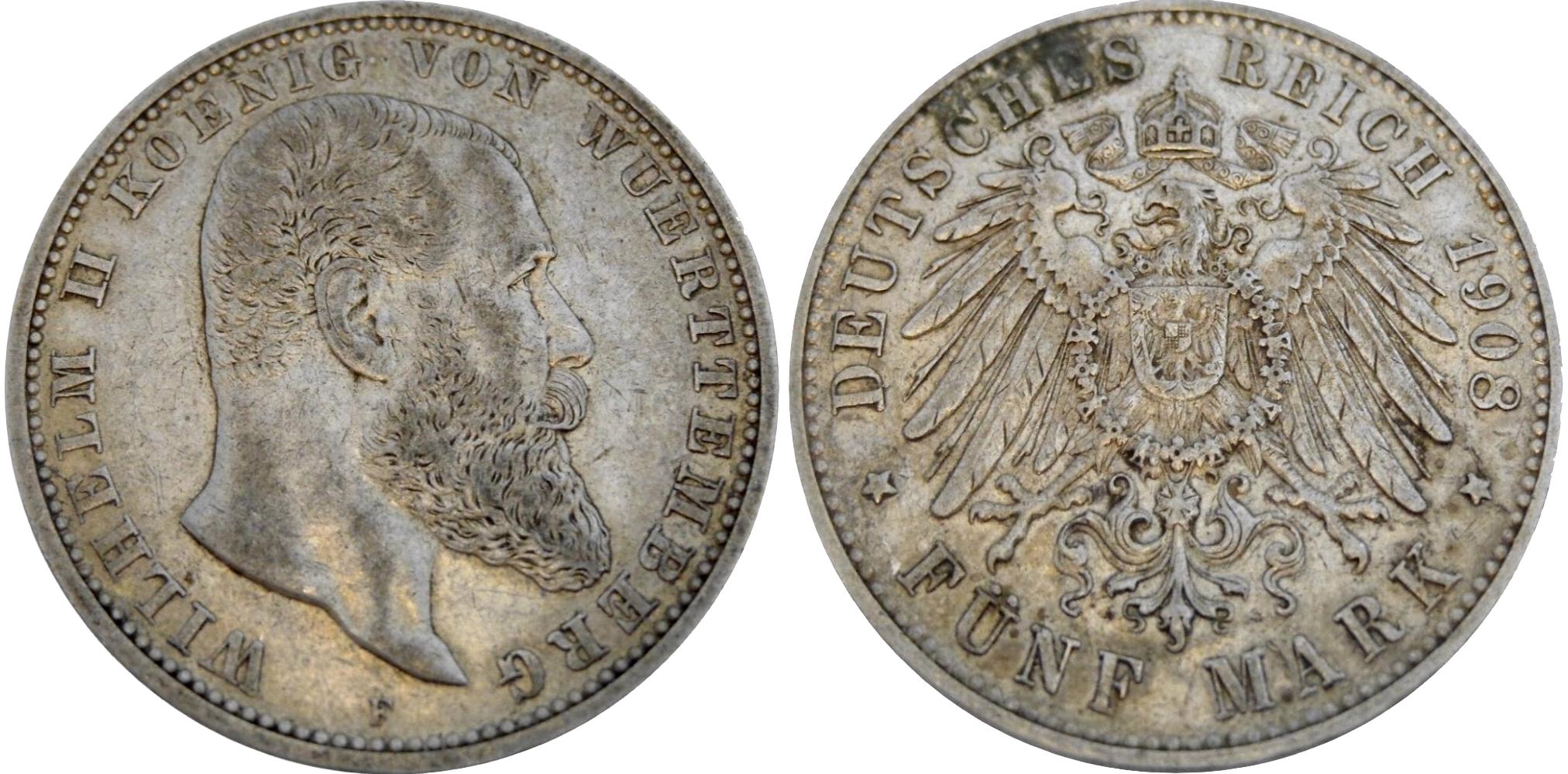
This is a five mark coin minted at the Freundenstadt Mint (mintmark F) in 1908. The obverse has Wilhelm II King of Württemberg. The reverse has the German arms. Weighs 27.8 grams of 0.900 fineness.
YEMEN
One of the oldest centers of civilization in the Middle East, Yemen was once part of the Minaean Kingdom and of the ancient Kingdom of Sheba, after which it was captured successively by Egyptians, Ethiopians, and Romans. It was converted to Islam in 628 AD and administered as a caliphate until 1538 when it came under Ottoman occupation in 1849. The second Ottoman occupation which began in 1872 was maintained until 1918 when autonomy was achieved through revolution. Formal boundaries were established in 1934 and a Republic was formed in 1962 leading to an eight year civil war between royalist imam and new republican forces.
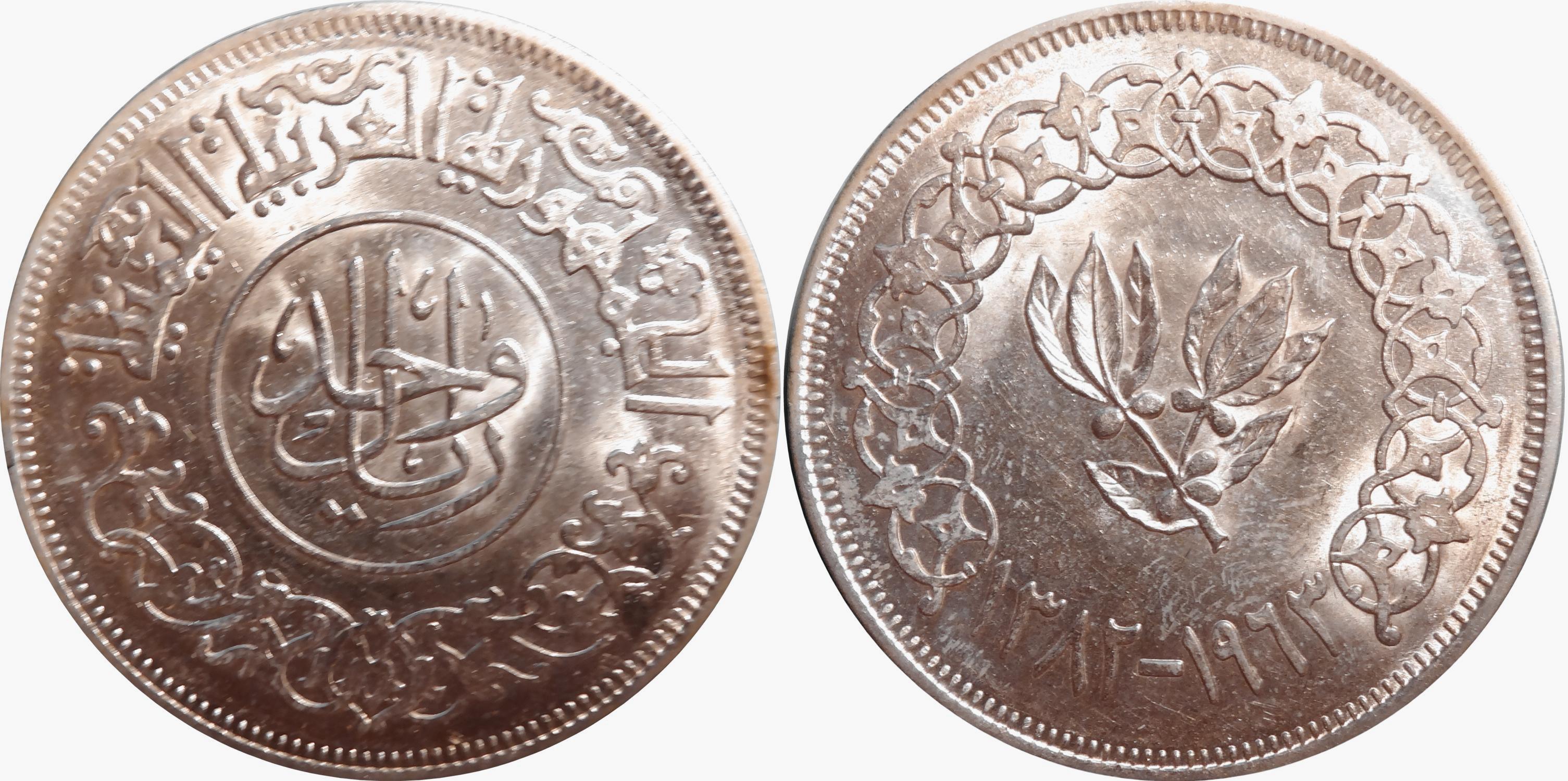
The is an one Rial coin minted in 1963 under the Yemen Arab Republic. The obverse has the Arabic legend الجمهورية العربية اليمنية ريال واحد. (Yemen Arab Republic One Rial). The reverse has a sprig of the coffee plant with the dates 1362-1963. Weighs 19.75 grams of 0.720 fineness.
YUGOSLAVIA
The Federal Republic of Yugoslavia, formerly the Kingdom of Croats, Serbs, and Slovenes, was a Balkan country located on the east shore of the Adriatic Sea. Yugoslavia was proclaimed on 1 Dec. 1918, after the union of the Kingdom of Serbia, Montenegro and the South Slav territories of Austria-Hungary; and changed its official name from the Kingdom of the Serbs, Croats and Slovenes to the Kingdom of Yugoslavia on 3 Oct. 1929. The republic was composed of six autonomous republics -Serbia, Croatia, Slovenia, Bosnia-Herzegovina, Macedonia and Montenegro - and two autonomous provinces within Serbia: Kosovo-Melohija and Vojvodina. The government of Yugoslavia attempted to remain neutral in World War II but, yielding to German pressure, aligned itself with the Axis powers in March of 1941; a few days later it was overthrown by revolutionary forces and its neutrality reasserted. The Nazis occupied the country on 6 April, and throughout the remaining war years were resisted by a number of guerrilla armies, notably that of Marshal Josip Broz Tito. Alter the defeat of the Axis powers, a leftist coalition headed by Tito abolished the monarchy and, on 31 Jan. 1946, established a People's Republic. The collapse of the Federal Republic during 1991-1992 has resulted in the autonomous republics of Croatia, Slovenia, Bosnia-Herzegovina and Macedonia declaring their respective independence. Bosnia-Herzegovina is under military contest with the Serbian, Croat and Muslim populace opposing each other. Besides the remainder of the older Serbian sectors, a Serbian enclave in Knin located in southern Croatia has emerged celled REPUBLIKE SRPSKEKRAJINE or Serbian Republic - Krajina whose capital is Knin and has also declared Its independence in 1992 when the former Republics of Serbia and Montenegro became the Federal Republic of Yugoslavia. Later Montenegro broke away as a separate republic. Later yet, the Clinton administration aided the majority Albanians to set up a republic of Kosovo. The name Yugoslavia appears on the coinage in letters of the Cyrillic alphabet alone until formation of the Federated Peoples Republic of Yugoslavia in 1953, after which both the Cyrillic and Latin alphabets are employed. From 1965, the coin denomination appeared in the 4 different languages of the federated republics in letters of both the Cyrillic and Latin alphabets (the Latin alphabet is used in Croatia and Slovenia).
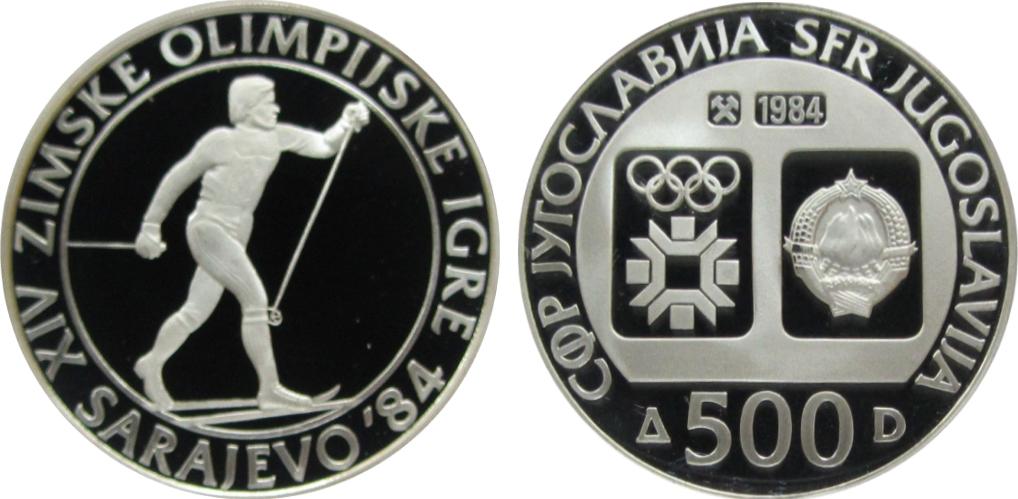
This is a 500 Dinar coin minted in 1984 to celebrate the Winter Olympic Games held in Sarajevo. Weighs 23 grams of 0.925 fineness.
ZANZIBAR
The British protectorate of Zanzibar and adjacent small islands, located in the Indian Ocean 22 miles (35 km.) off the coast of Tanganyika, comprised a portion of British East Africa. Zanzibar was also the name of a sultanate which included the Zanzibar and Kenya protectorates. Zanzibar has an area of 637 sq. mi. (1,651 sq. km.).
Zanzibar came under Portuguese control in 1503, was
conquered by the Omani Arabs in 1698, became independent of Oman in 1860, and (with
Pemba) came under British control in 1890. Britain granted the protectorate self-government
in 1961, and independence within the British Commonwealth on 19 Dec. 1963. On 26 April
26 1964, Tanganyika and Zanzibar (with Pemba) united to form the United Republic
of Tanganyika and Zanzibar. The name of the country, which remained within the British
Commonwealth, was changed to Tanzania on 29 Oct. 1964.
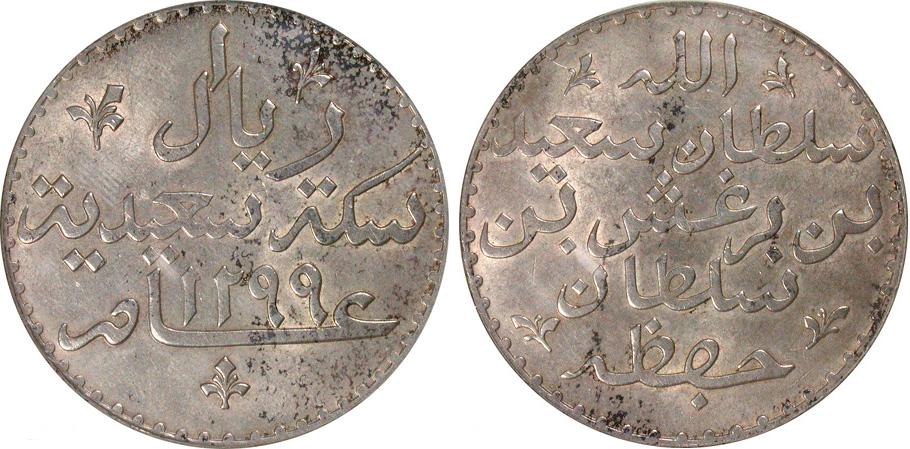
This is the single crown issued by Zanzibar. It is a 1 Riyal piece dated 1299 AH (1882 AD). The obverse has the Arabic legend اللة سلطان سعيد بن برغش بن سلطان حڢظی (Allah Sultan Sa'id bin Burgush bin Sultan Hafza). The reverse has the legend ١ ريال سكة سعيدية ١٢٩٩ . عام (Rial Sa'idian Coin year 1299). Weighs 27.16 grams of unknown fineness.